

Accommodation
Attractions.
- Destinations
- About New Zealand
No holiday memories are complete without experiencing one of our 50 spectacular Parks located throughout NZ.
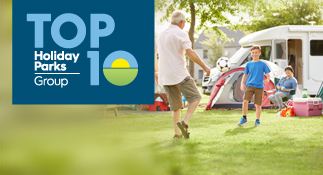
Kaikoura on the east coast of the South Island is a wildlife meca with whales, dolphins, seals and more...
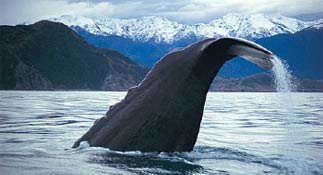
CamperCo offers the best value campers in New Zealand. We specialise in 2/3 berth campers with pick up drop off options...
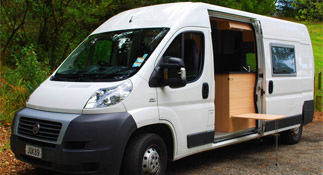
New Zealand skiing and snowboarding is world famous! Check out...
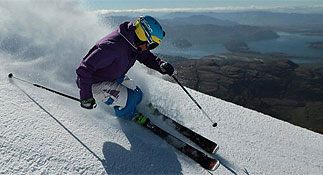
The real kiwi experience is what you get when staying at the best holiday parks.

Hiring a rental car is a great way to get to see New Zealand...
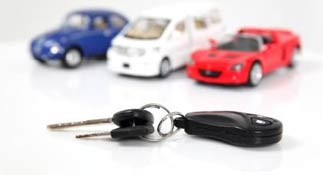
Join our exclusive hotel club for instant discounts. 100% NZ owned and operated...

Named in Conde Nast Traveler's "Hot List" as one of the 80 best accommodation resorts in the world, The Point Villas...
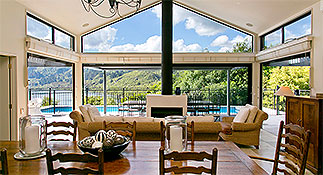
Kaikoura Fishing Tours for Crayfish and Fishing Charters with Captain Tomo. One hour to full day trips available with...
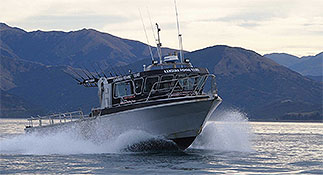
Choose your next destination and explore New Zealand
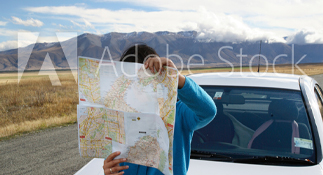
COVID-19 Update
We're here to help your business through these uncertain times. Check out Yellow's dedicated Covid-19 page here full of resources to help your business. Find out how we can assist if you're a business experiencing financial hardship as a result of Covid-19 here .
COVID-19 Information and Resources
For information, news, and updates about COVID-19 and New Zealand's response, please visit the links below:
- Unite against COVID-19 - The Official New Zealand Government Resource
- Official advice for New Zealanders living and travelling overseas
- Ministry of Business, Innovation & Employment: COVID-19 update for visitors and tourists in New Zealand
New Zealand Tourism Guide - Gateway to NZ Tourism, Travel and Holidays
New Zealand Tourism Guide is a comprehensive online directory for NZ tourism and travel. Every New Zealand accommodation , attractions , tours and transport business is listed (over 12,000) together with extensive visitor holiday and vacation information for both local and international travellers. Start planning your New Zealand holiday or travel now and enjoy one of the best countries on earth. Check out more than 101 things to see and do in New Zealand or plan a great kiwi road trip .
In a world changed by the global pandemic, New Zealand abounds in attractions and activities for those able to discover what the country has to offer. New Zealand Tourism Guide is a comprehensive online directory for NZ tourism and travel. We're proud to be the home to listings for accommodation , attractions , tours and transport businesses (over 12,000) together with extensive visitor holiday and vacation information for people travelling this beautiful country. If you're looking or where to start in planning your New Zealand trip this is the best place to start! Check out more than 101 things to see and do in New Zealand or plan a great kiwi road trip .
Prepare for your New Zealand Travel
Search for and book places to stay, ways to get around and things to do while in New Zealand.
Accommodation in New Zealand is diverse with places to stay to suit all preferences...
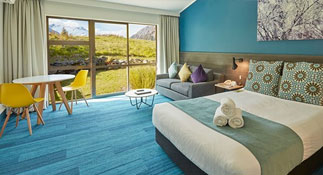
New Zealand is well known for its stunning outdoor attractions and adrenaline pumping activities...
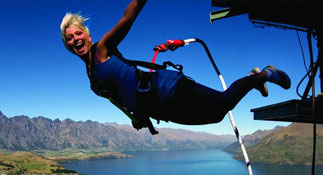
A tour is a great way to explore the best of New Zealand whether on or off the beaten track...
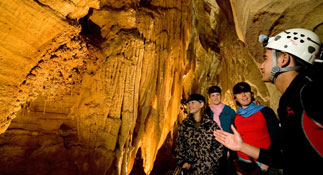
Hire a car, catch a public transport bus, book a flight, taxi or train...
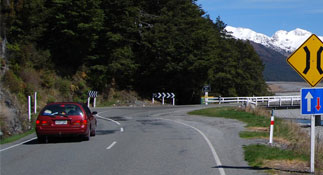
Book a venue, hire security, hire a photographer, or plan your perfect destination wedding...
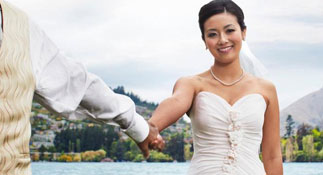
Event Planning
Book a restaurant for a delicious meal out, or grab the kiwi "fish and chips" for budget takeaway meals...
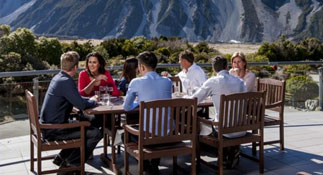
NZ Tourism Guide by Destination

North Island
- Bay of Islands
- Bay of Plenty
- Waiheke Island
South Island
- Christchurch
- Marlborough
- Milford Sound
- Stewart Island
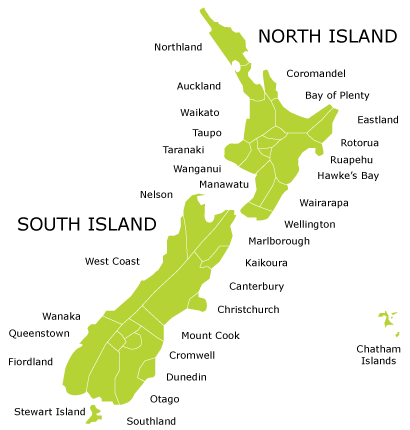
101 Things to Do in New Zealand
Travelling to New Zealand means a holiday of limitless options. Whatever your inspiration, taste or budget, New Zealand has an almost endless array of outdoor adventure, stunning places to visit and fun activities to do.
One of New Zealand's most popular holiday destinations, Aoraki/Mt Cook is the highest mountain in New Zealand. Climb the stepped trails for stunning vistas over glacial lakes and snow-capped mountains or take a scenic flight over the vast mountains. Further north in Waitomo, don your caving gear and crawl into labyrinths of caves, many covered with the mesmerizing lights of thousands of glowworms.
If guided tours are more your thing, join one of New Zealand's world class wine tasting tours for a day of taste delights. Or join a guided walking tour and hike into one of the beautiful forests around New Zealand.
Golf courses in New Zealand attract PGA pro golfers from around the world. The world-class ski fields also attract international skiiers.
For the adrenaline junky there is sky diving, bungy jumping, white water rafting and so much more!
Check out more than 101 things to see and do in New Zealand .
Whatever your inspiration, taste or budget, New Zealand has an almost endless array of outdoor adventure, stunning places to visit and fun activities to do.
Check out our list of 101 things to see and do in New Zealand , you’ll find an array of places and activities to fill your itinerary. As a country of dramatic landscapes, stunning beaches, gourmet food and wine, the discoveries are limitless!
Why Visit New Zealand
New Zealand is one of the top holiday countries in the world with its clean green natural image, scenery, adventure, culture, friendly people and value for money. See for yourself why New Zealand is often rated as one of the best tourist destinations.
NZ caters for all travellers so make a booking , send an eCard postcard , check out an audio visual , search for New Zealand maps and travel information or look for things to do, places to stay or ways to get around.
As a previous Tourism Award winner , this New Zealand travel guide also provides information on New Zealand history , nature , regional facts as well as useful NZ travel guides such as New Zealand driving routes .
9 of the best places to visit in New Zealand

Oct 9, 2023 • 7 min read
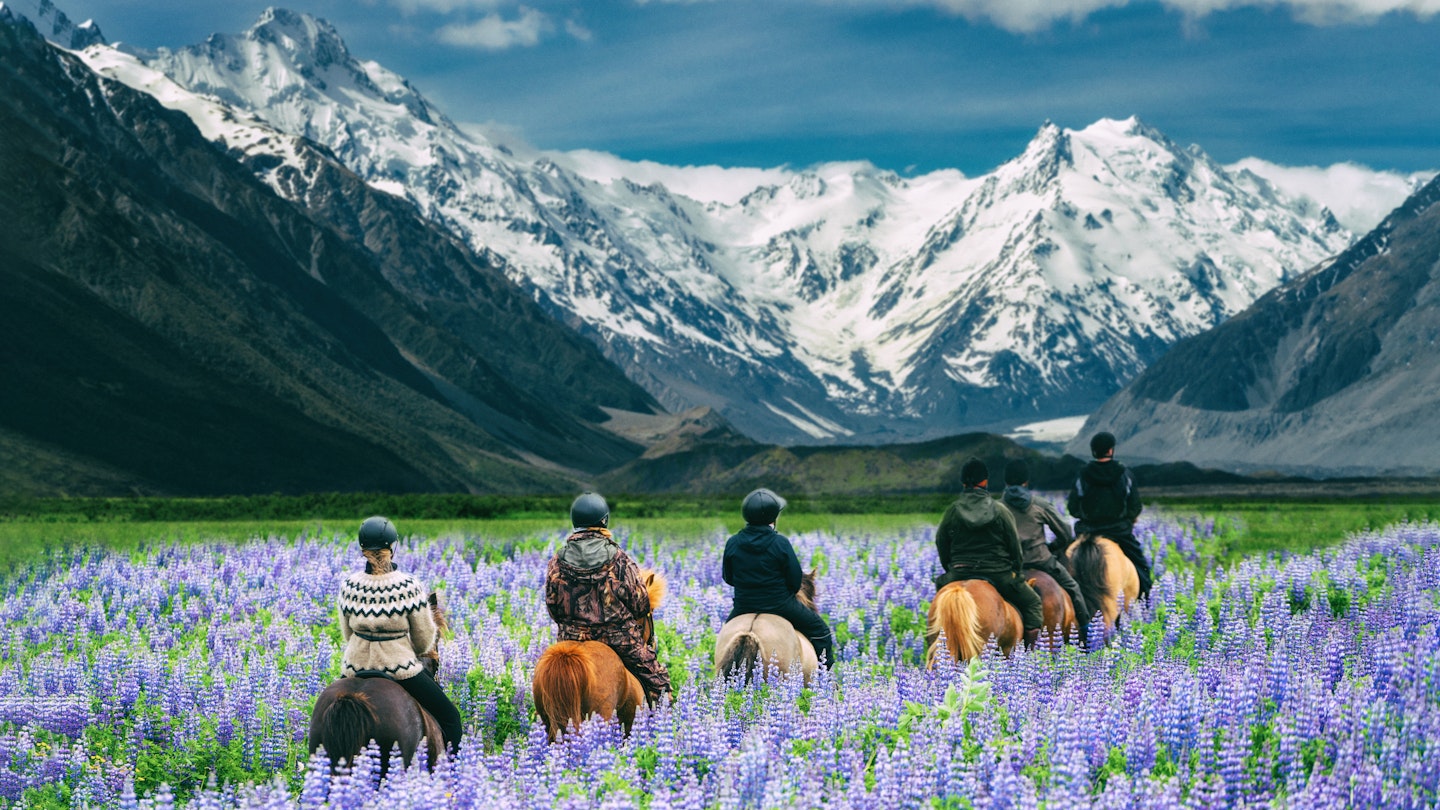
Experience the best of New Zealand with these top places to visit © Blue Planet Studio / Getty Images
New Zealand is famed for its natural beauty.
As you make your way around the country, you’ll see dramatic black-sand beaches, thermal springs, sandy coves, towering mountains and aquamarine lakes. City breaks include cosmopolitan Auckland , the cool capital of Wellington and ever-evolving Christchurch . However, many of the best places to visit in New Zealand involve leaving the city limits behind and immersing yourself in the great outdoors.
As you build your itinerary for Aotearoa (as New Zealand is known in the Māori language), here are nine spots that should top your list.

1. Queenstown
Best for adventure activities
New Zealand’s adventure capital is a favorite with visitors and for good reason. On the shores of Lake Wakatipu and surrounded by snow-capped mountains, Queenstown ’s location makes it one of the country’s most sought-after places to work and play. There are three good ski hills (called “ski fields”) and an equally enviable après-ski scene.
Queenstown's reputation for adventure is justified: from bungy jumping and zip lines, to paragliding and jet boating, there are plenty of ways to satisfy a taste for adrenaline. Rounding out its experiences, the summer months offer excellent hiking, cycling and water sports on the lake.
Detour: Make time to explore the valleys and settlements around Queenstown. Visit nearby Lake Hayes, the lakeside village of Glenorchy and historic Arrowtown . Then spend a day (or more) in Wānaka , known for its low-key vibes and Instagram-famous tree. The nearby Gibbston Valley has some of the best wineries in the country.
2. Coromandel
Best for beautiful beaches
If you’re after a beach holiday, head to the Coromandel Peninsula , on the east coast of the North Island. While the iconic Cathedral Cove area is currently more difficult to access due to damage from 2023’s storms (you’ll need to take a boat or kayak tour to get there), there are countless other stunning beaches in the region.
For example, you could swim in the calm waters of Cooks Beach or take a 30-minute walk through native bush to find the more remote (but still popular) New Chums Beach. Other fun activities in the region include cycling through Karangahake Gorge, hiking the Pinnacles Trail and kayaking to Whenuakura Wildlife Sanctuary (Donut Island); a pristine, natural environment you can only explore from the water.
Planning tip: Rent a bach (holiday house) in one of the seaside towns of Hahei, Pauanui or Whangamatā, and make that your base for exploring the region.
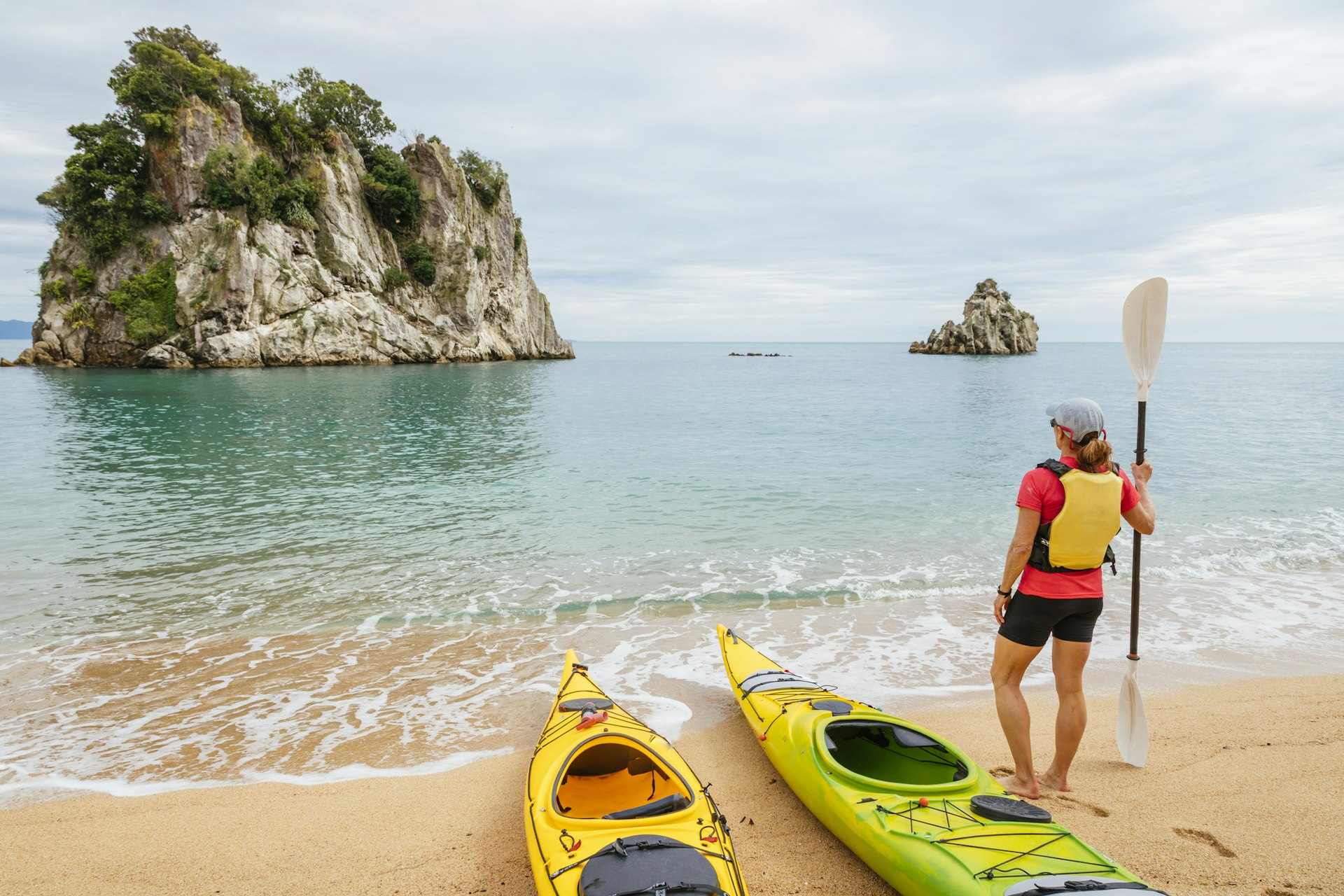
3. Abel Tasman National Park
Best for hiking and kayaking
The South Island’s Abel Tasman National Park is an unspoiled natural environment replete with native bush, crystal-clear bays and white sandy beaches. You can access it on a day trip from Nelson , but this is a destination that demands more time if you can afford it.
The Abel Tasman Coast Track , one of New Zealand's Great Walks, is a 60km (37-mile) walk along the coastline with lovely views of the beach. It usually takes three to five days to complete the full walk; otherwise, take on just a section as a day or afternoon hike using water taxis to return to your starting point. Alternatively, go kayaking to the national park’s seal colony, dive into the waters, or simply relax in tiny hidden coves and bays.
Planning tip: Cars are only able to drive as far as Tōtaranui on the north edge of the national park and Mārahau at the southern entrance, so visitors need to either walk to their preferred destination or take a water taxi.
4. Fiordland National Park
Best for epic landscapes
On the edge of the South Island, Fiordland National Park is home to one of New Zealand’s most famous attractions, the majestic Milford Sound/Piopiotahi , where visitors can see plunging waterfalls along the fiord and rare marine wildlife, including Fiordland crested penguins and Hector’s dolphins. There are also several hiking trails in the national park (including the country’s most famous multiday walk, the Milford Track ), which takes visitors past snow-capped mountains and ice-forged fiords, with even more views of lakes, valleys and waterfalls.
Planning tip: Nearby Doubtful Sound/Patea is also spectacular but less accessible – travelers need to visit with a guide and by boat.
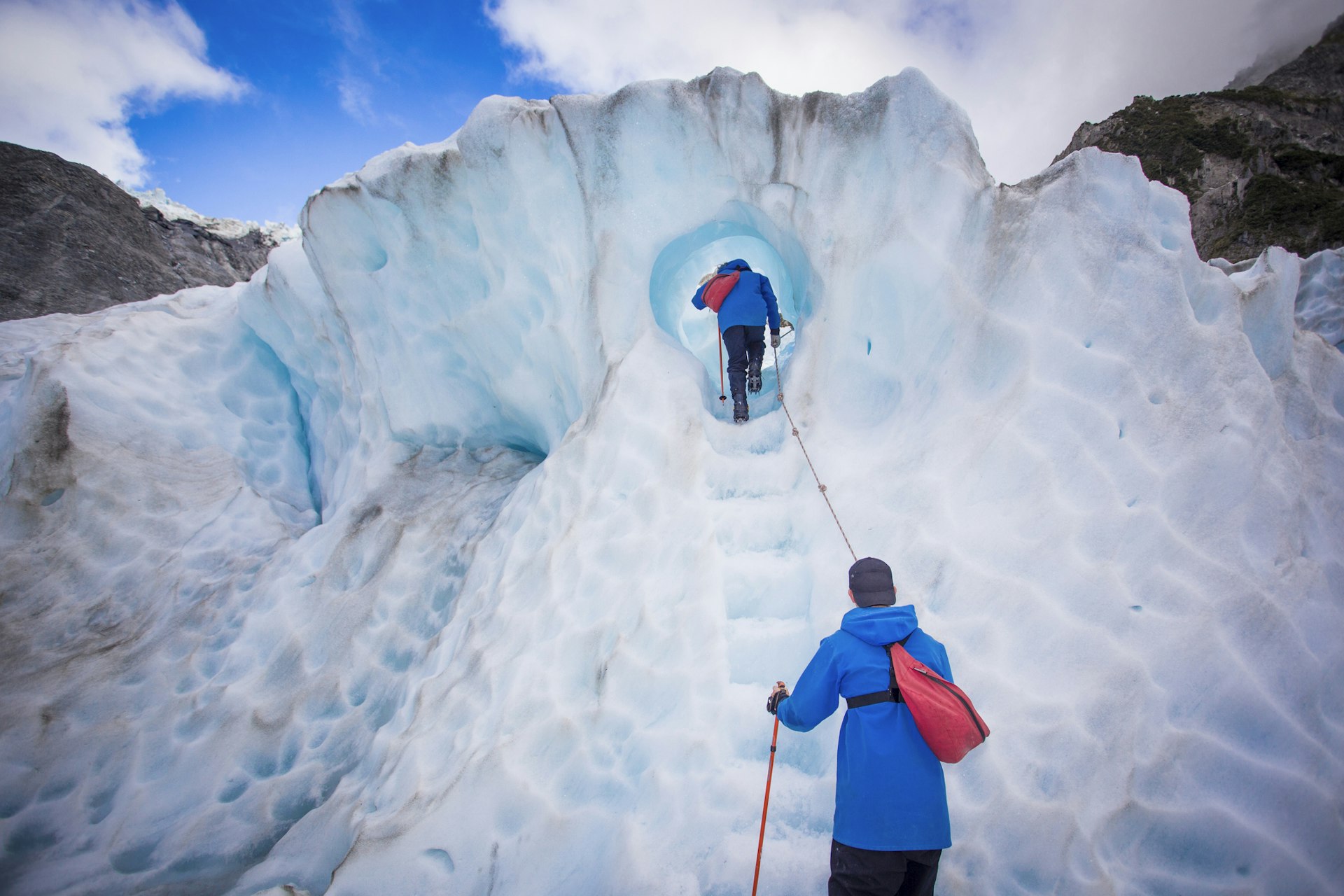
5. West Coast
Best for glaciers
The rugged western coastline of the South Island is a raw juxtaposition of dense rainforests, craggy rocks and ancient glaciers. The major drawcards of this wild and remote region are the majestic Fox and Franz Josef glaciers , offering visitors a unique chance to witness rivers of ice that flow almost to sea level.
Take guided glacier hikes, heli-hikes or scenic flights to admire the glaciers for themselves. Other attractions of note include Punakaiki's Pancake Rocks , the turquoise Hokitika Gorge and the serene, mirror-like waters of Lake Matheson .
Planning tip: The West Coast receives a high amount of rainfall annually. Unfortunately, helicopter tours are weather-dependent. If you have your heart set on landing on a glacier, ensure your itinerary is flexible enough to allow for a bad weather day.
6. Mackenzie Region
Best for stargazing
Around two hours’ drive from Christchurch is the Mackenzie Region, a peaceful place with some of the country’s loveliest scenery. The region is an International Dark Sky Reserve with minimal light pollution, so be sure to keep an eye on the forecast. When you have a clear night, head to the observatory to see the stars through a telescope, or simply look up.
The Mackenzie is also the home of Lake Tekapo and the Church of the Good Shepherd , a stone building that’s one of the country’s most photographed spots. Nearby, the small town of Twizel makes a convenient base to explore the region. From there, you can easily access the lakes and Aoraki/Mt Cook National Park , which has a range of walks from short trails to full-day hikes.
Planning tip: Book a Tātai Aroraki (Māori astronomy) tour at the Dark Sky Project to learn about the significance of the night sky to Māori. This isn’t weather dependent so it’s a great option for wet weather days.

Best for geothermal activity and Māori cultural experiences
At the heart of New Zealand’s geothermal action, Rotorua is the place to go to see bubbling mud pools, geysers and steaming rivers. Then, finish the day by taking a relaxing soak in a thermal mud bath.
Rotorua is just as renowned for its geological wonders as it is for its immersive cultural experiences. You can learn more about Māori culture and language with a visit to a traditional Māori marae (meeting grounds). At Te Puia geothermal park, for example, you'll see local Māori carvers at work at the New Zealand Māori Art and Crafts Institute. This attraction is also home to the southern hemisphere’s largest geyser. The nearby Whakarewarewa Forest (also known as the Redwoods) boasts some great cycling and hiking trails, and a treetop walk that is lit up beautifully at night.
Best for architecture
After a devastating earthquake in 1931, Napier was rebuilt almost completely, embracing the art deco style that was popular at the time. Today, it has one of the most extensive collections of art deco buildings in the southern hemisphere. Visitors who want to get their Great Gatsby on can immerse themselves in Napier’s history through guided walks, vintage car tours and the Art Deco Festival , which takes place each February.
Detour: Spend a day or two visiting the charming village of Havelock North and the Hawke’s Bay wineries, which produce award-winning syrahs, chardonnays and reds.

9. Bay of Islands
Best for Māori history
The Bay of Islands , with its shimmering waters and myriad islets, is as pretty as it is important to the culture and history of the country. The Waitangi Treaty Grounds mark the place where a foundational document was signed between Māori chiefs and British representatives, forming modern-day New Zealand.
If you visit between November and March, you can also experience traditional performances at the treaty grounds, as well as a hāngī feast, where food is cooked in the earth. Beyond Waitangi, you can get out on the water with a waka (traditional canoe) tour, where local Māori guides share stories about their seafaring ancestors and the sacred spots within the bay. In nearby Paihia, download the Ātea Nuku app to experience an augmented reality walking tour showing the history of the town.
Planning tip: On Waitangi Day (February 6), all the Treaty Ground buildings are closed for the public holiday. Instead, a massive festival takes place. You can take part in a dawn ceremony, eat from food stalls and watch cultural performances.
This article was first published June 2021 and updated October 2023
Explore related stories
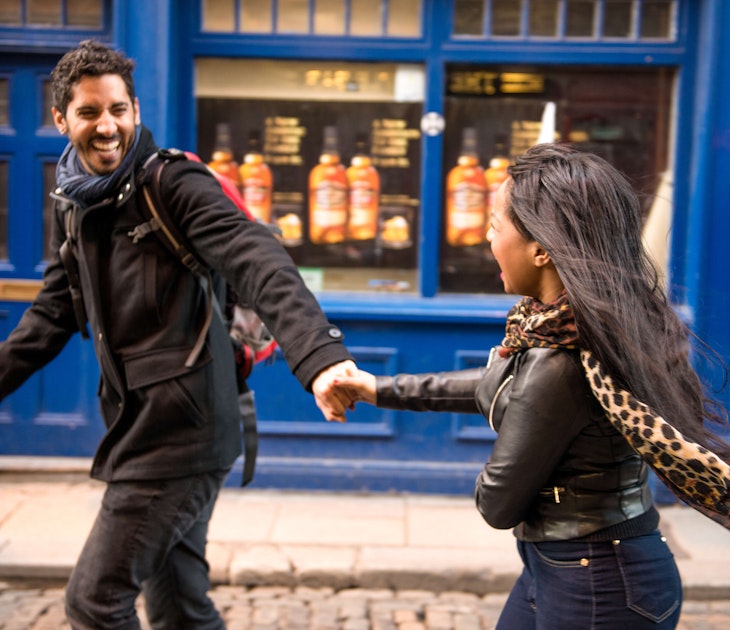
Destination Practicalities
Mar 30, 2024 • 4 min read
Who wouldn't jump at the chance to visit the Emerald Isle? Here’s how to check if you need a visa before setting off on your Irish adventure.
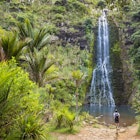
Mar 15, 2024 • 17 min read

Feb 27, 2024 • 6 min read
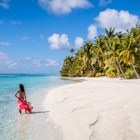
Jan 24, 2024 • 8 min read

Jan 17, 2024 • 8 min read

Jan 5, 2024 • 20 min read
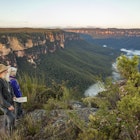
Nov 27, 2023 • 7 min read
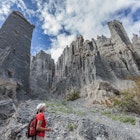
Nov 22, 2023 • 5 min read

Nov 17, 2023 • 10 min read

Oct 31, 2023 • 7 min read
Travel Guide New Zealand
Book your individual trip , stress-free with local travel experts
- roughguides.com
- Australasia
- New Zealand
- Travel guide
- Itineraries
- Local Experts
- Travel Advice
- Accommodation
Plan your tailor-made trip with a local expert
Book securely with money-back guarantee
Travel stress-free with local assistance and 24/7 support
Robert Digney
The trip was fantastic. Unparalleled Journeys was on point the whole way. The AXUS app was very useful for itinerary updates and communications with your t...
Kiwis – the people, not the emblematic flightless bird – can’t believe their luck at being born in what they call “Godzone” (God’s own country). Year after year, travellers list New Zealand in the top ten of places they’d like to visit – and you never meet anyone who has been and didn’t love the place. And what’s not to like?
Travel facts New Zealand
Where to go in new zealand, famous movie locations in new zealand.
- Introduction to New Zealand's culture and history
Working and living in New Zealand
Tailor-made travel itineraries for new zealand, created by local experts.

17 days / from 5400 USD
From North to South - Auckland to Christchurch Self Drive
Explore both the North and the South Island in this compact itinerary. Your own rental car allows you the freedom to go at your own pace and scenic rail journeys break up the driving times. Explore glaciers and cities, thermal springs and panoramic hiking trails.
_listing_1594826609732.jpeg)
14 days / from 3600 USD
Discover the South Island: a self drive trip from Christchurch and back
The larger of the two major island in New Zealand, South Island is best to be explored at your own pace in a rental car. From massive mountains to beaches, panoramic waterfalls to challenging hiking trails, this itinerary shows you the best of South Island.

9 days / from 2900 USD
North Island: A self drive trip from Auckland
Discover the beauty of North Island on a roundtrip from Auckland in your own vehicle. Visit thermal springs, enjoy delicious wine tastings, and explore remote beaches and hiking trails. North Island has plenty to offer travelers and a rental car makes for the perfect discovery.
Tailor-made trips for New Zealand
With craggy coastlines, sweeping beaches, primeval forests, snowcapped mountains and impressive geysers, the scenery is truly majestic. The forests come inhabited by strange birds that have evolved to fill evolutionary niches normally occupied by mammals, while penguins, whales and seals ring the coast. Maori have only been here for 800 years but retain distinct and fascinating customs overlaid by colonial European and increasingly Asian cultures that together create a vibrant, if understated, urban life.

A path through Hooker valley wit a view of Mount Cook, New Zealand / shutterstock
- At latitude 41° south, Wellington is the world’s southernmost capital city and shares the honour of being the most remote with Canberra, over 2000km away.
- Possums are the national pest. When seen on the road, these introduced marsupials turn normally mild-mannered folk into killers. Flattened examples are everywhere.
- Kiwis love foreign affirmation: Flight of the Conchords were turned down by domestic television and only became a local success after their HBO hit series.
- Maori ex-prostitute Georgina Beyer became the world’s first transsexual MP in 1999.
- There are no snakes in New Zealand, and only a few venomous spiders, rarely seen.
- The numerous Maori words that have crept into everyday conversation easily confound visitors: aroha is love; kia kaha means be strong; kia ora can be hi or might signify agreement; and koha is a donation or offering.
- New Zealand’s eels live to 80 years and only breed once, at the end of their life – and they swim all the way to Tonga to do it.
New Zealand packs a lot into a limited space, meaning you can visit many of the main sights in a couple of weeks, but allow at least a month (or preferably two) for a proper look around. The scenery is the big draw, and most people only pop into the big cities on arrival and departure (easily done with open-jaw air tickets, allowing you to fly into Auckland and out of Christchurch) or when travelling to Wellington from the South Island across the Cook Strait.

Sprawled around the sparkling Waitemata Harbour, go-ahead Auckland looks out over the island-studded Hauraki Gulf. Most people head south from here, missing out on Northland, the cradle of both Maori and Pakeha colonization, cloaked in wonderful subtropical forest that harbours New Zealand’s largest kauri trees.
East of Auckland the coast follows the isolated greenery and long, golden beaches of the Coromandel Peninsula , before running down to the beach towns of the Bay of Plenty. Immediately south your senses are assailed by the ever-present sulphurous whiff of Rotorua , with its spurting geysers and bubbling pools of mud, and the volcanic plateau centred on the trout-filled waters of Lake Taupo, overshadowed by three snowcapped volcanoes.
Cave fans will want to head west of Taupo for the eerie limestone caverns of Waitomo; alternatively it’s just a short hop from Taupo to the delights of canoeing the Whanganui River, a broad, emerald-green waterway banked by virtually impenetrable bush thrown into relief by the cone of Mount Taranaki, whose summit is accessible in a day.
East of Taupo lie ranges that form the North Island’s backbone, and beyond them the Hawke’s Bay wine country, centred on the Art Deco city of Napier. Further south, the wine region of Martinborough is just an hour or so from the capital, Wellington, its centre squeezed onto reclaimed harbourside, the suburbs slung across steep hills overlooking glistening bays. Politicians and bureaucrats give it a well-scrubbed and urbane sophistication, enlivened by an established café society and after-dark scene.
The South Island kicks off with the world-renowned wineries of Marlborough and appealing Nelson , a pretty and compact spot surrounded by lovely beaches and within easy reach of the hill country around the Nelson Lakes National Park and the fabulous sea kayaking of the Abel Tasman National Park .
From the top of the South Island you’ve a choice of nipping behind the 3000m summits of the Southern Alps and following the West Coast to the fabulous glaciers at Fox and Franz Josef, or sticking to the east, passing the whale-watching territory of Kaikoura en route to the South Island’s largest centre, Christchurch . Its English architectural heritage may have been ravaged by earthquakes – and its people still reeling from the upheaval – but signs of normality are returning, and, as the rebuilding process picks up pace, the city looks set to become the country’s most exciting.
From here you can head across country to the West Coast via Arthur’s Pass on one of the country’s most scenic train trips, or shoot southwest across the patchwork Canterbury Plains to the foothills of the Southern Alps and Aoraki/Mount Cook with its distinctive drooping-tent summit.
The patchwork-quilt fields of Canterbury run, via the grand architecture of Oamaru, to the unmistakably Scottish-influenced city of Dunedin, a base for exploring the wildlife of the Otago Peninsula, with its albatross, seal, sea lion and penguin colonies. In the middle of the nineteenth century, prospectors arrived here and rushed inland to gold strikes throughout central Otago and around stunningly set Queenstown , now a commercialized activity centre where bungy jumping, rafting, jetboating and skiing hold sway.
Just up the road is Glenorchy, a tramping heartland, from which the Routeburn Track sets out to rain-sodden Fiordland . Its neighbour, Te Anau, is the start of many of New Zealand’s most famous treks, including the Milford Track. Further south you’ll feel the bite of the Antarctic winds, which reach their peak on New Zealand’s third landmass, isolated Stewart Island, covered mostly by dense coastal rainforest that offers a great chance of spotting a kiwi in the wild.
Discover more places in New Zealand

- Dunedin to Stewart Island Travel Guide
- Fiordland Travel Guide
- Marlborough, Nelson and Kaikoura Travel Guide
- Northland Travel Guide
- Poverty Bay, Hawke’s Bay and the Wairarapa Travel Guide
- Wellington and around Travel Guide
- The West Coast Travel Guide
- Western North Island Travel Guide
- Auckland and around Travel Guide
- Christchurch and south to Otago Travel Guide
When Peter Jackson filmed his Lord of the Rings trilogy in New Zealand the country rejoiced, even appointing a special minister for the project. However, few could have anticipated how completely it would take over the country. For thousands of visitors, no stay in Aotearoa is complete without a hobbit hole visit to Hobbiton, a pilgrimage to Wellington’s Weta Workshop , where the prosthetics and miniatures were done, and a tour of film locations around Queenstown.
The next wave of scene-seeking tourists took Disney’s The Chronicles of Narnia: The Lion, the Witch and the Wardrobe as their inspiration, and there is a tsunami of tourists eager to stand where the hobbits of Peter Jackson’s two-part epic (based on J.R.R Tolkien’s The Hobbit ) planted their feet. Trips to location sites undoubtedly visit some magnificent scenery, but don’t expect scenes to look as they did in the films. Digital enhancement works wonders, but the landscape stands up just fine without CGI trickery.
Tribal costume is only worn on special occasions, facial tattoos are fairly rare and you’ll probably only see a haka performed at a rugby match or cultural show. In fact, Maori live very much in the modern world. But peel back the veneer of the song-dance-and- hangi performance and you’ll discover a parallel world that non-Maori are only dimly aware of.
Knowledge of whakapapa (tribal lineage) is central to Maori identity. Spirituality connects Maori to their traditional local mountain or river, while oratory , and the ability to produce a song at a moment’s notice, are both highly valued. All New Zealanders understand mana , a synthesis of prestige, charisma and influence, which is enhanced through brave or compassionate actions.
Sadly, the Maori community is riven by social problems: average incomes are lower than those of Pakeha; almost half of all prison inmates are Maori; and health statistics make appalling reading.
Hope for redress comes through a bicultural approach stressing equality and integration while allowing for parallel identities.
Introduction to New Zealand's culture and history
Given this stunning backdrop it’s not surprising that there are boundless diversions, ranging from strolls along moody windswept beaches and multi-day tramps over alpine passes to adrenaline-charged adventure activities such as bungy jumping, skiing, sea kayaking and whitewater rafting. Some visitors treat the country as a large-scale adventure playground, aiming to tackle as many challenges as possible in the time available.
Much of the scenic drama comes from tectonic or volcanic forces, as the people of Canterbury know only too well following the Christchurch earthquakes of September 4, 2010 and February 22, 2011. The quakes, along with several thousand aftershocks, collectively devastated the city, which is slowly recovering.
Thousands of residents have left Christchurch, but it remains the second-largest city after Auckland , just pushing the capital, Wellington , into third place. Elsewhere, you can travel many kilometres through stunning countryside without seeing a soul: there are spots so remote that, it’s reliably contended, no human has yet visited them.
Geologically, New Zealand split away from the super-continent of Gondwana early, developing a unique ecosystem in which birds adapted to fill the role of mammals, many becoming flightless because they had no predators. That all changed about 800 years ago, with the arrival of Polynesian navigators, when the land they called Aotearoa – “the land of the long white cloud” – became the last major landmass to be settled by humans.
On disembarking from their canoes, these Maori proceeded to unbalance the fragile ecosystem, dispatching forever the giant ostrich-sized moa, which formed a major part of their diet. The country once again settled into a fragile balance before the arrival of Pakeha – white Europeans, predominantly of British origin – who swarmed off their square-rigged ships full of colonial zeal in the mid-nineteenth century and altered the land forever.
An uneasy coexistence between Maori and European societies informs the current wrangles over cultural identity, land and resource rights. The British didn’t invade as such, and were to some degree reluctant to enter into the 1840 Treaty of Waitangi , New Zealand’s founding document, which effectively ceded New Zealand to the British Crown while guaranteeing Maori hegemony over their land and traditional gathering and fishing rights.
As time wore on and increasing numbers of settlers demanded ever larger parcels of land from Maori, antipathy surfaced and escalated into hostility. Once Maori were subdued, a policy of partial integration all but destroyed Maoritanga – the Maori way of doing things. Maori, however, were left well outside the new European order, where difference was perceived as tantamount to a betrayal of the emergent sense of nationhood. Although elements of this still exist and Presbyterian and Anglican values have proved hard to shake off, the Kiwi psyche has become infused with Maori generosity and hospitality, coupled with a colonial mateyness and the unerring belief that whatever happens, “she’ll be right”.
Only in the last forty years has New Zealand come of age and developed a true national self-confidence, something partly forced on it by Britain severing the colonial apron strings, and by the resurgence of Maori identity. Maori demands have been nurtured by a willingness on the part of most Pakeha to redress the wrongs perpetrated over the last 170 years, as long as it doesn’t impinge on their high standard of living or overall feeling of control.
More recently, integration has been replaced with a policy of biculturalism – the somewhat fraught notion of promoting two cultures alongside each other, but with maximum interaction. This policy has been somewhat weakened by relatively recent and extensive immigration from China, Korea and South Asia.
Despite having and achieving much to give them confidence, Kiwis (unlike their Australian neighbours) retain an underlying shyness that borders on an inferiority complex: you may well find yourself interrogated about your opinions on the country almost before you’ve even left the airport. Balancing this is an extraordinary enthusiasm for sports and culture , which generate a swelling pride in New Zealanders when they witness plucky Kiwis taking on and sometimes beating the world.
New Zealand is the sort of place people come for a short visit and end up wanting to stay (at least for a few months). Unless you have substantial financial backing, this will probably mean finding some work. And while your earning potential in New Zealand isn’t necessarily going to be great, you can at least supplement your budget for multiple bungy jumps, skydiving lessons and the like. Paid casual work is typically in tourism-linked service industries, or in orchard work.
For the last few years unemployment has remained relatively low and, providing you have the necessary paperwork, finding casual work shouldn’t be too difficult, while better-paid, short-term professional jobs are quite possible if you have the skills. Employment agencies are a good bet for this sort of work, or simply look at general job-search websites such as search4jobs.co.nz and the jobs section of trademe.co.nz . The minimum wage for all legally employed folk over the age of 16 (other than 16- and 17-year-old new entrants or trainees) is $13 an hour. If you’d rather not tackle the red tape you can simply reduce your travelling costs by working for your board (though technically the Immigration Department still considers this to be work).
Working for board and lodging
A popular way of getting around the country cheaply is to work for your board and lodging , typically toiling for 4–6 hours a day. FHiNZ (Farm Helpers in New Zealand; fhinz.co.nz ) organizes stays on farms, orchards and horticultural holdings for singles, couples and families; no experience is needed. Almost two hundred places are listed in its booklet ($25; sold online) and accommodation ranges from basic to quite luxurious.
The international WWOOF (Willing Workers on Organic Farms; wwoof.co.nz ) coordinates over a thousand properties (membership, for one or a couple, with online access $40 or printed booklet $50), mostly farms but also orchards, market gardens and self-sufficiency-orientated smallholdings, all using organic methods to a greater or lesser degree. They’ll expect a stay of around five nights, though much longer periods are common; you book direct (preferably a week or more in advance).
There have been occasional reports of taskmasters; make sure you discuss what’s expected before you commit yourself. Property managers are vetted but solo women may prefer placements with couples or families. Other organizations have fewer guarantees, though many are perfectly reputable.
A similar organization is the online Help Exchange ( helpx.net ), which supplies a regularly updated list of hosts on farms as well as at homestays, B&Bs, hostels and lodges, who need extra help in return for meals and accommodation; you register online and book direct.
Casual work
One of the main sources of casual work is fruit-picking or related orchard work such as packing or pruning and thinning. The main areas are Kerikeri in the Bay of Islands for citrus and kiwifruit, Hastings in Hawke’s Bay for apples, pears and peaches, Tauranga and Te Puke for kiwifruit, and Alexandra and Cromwell in Central Otago for stone fruit. Most work is available during the autumn picking season , which runs roughly from January to May, but you can often find something just as easily in the off season. In popular working areas, some hostels cater to short-term workers, and these are usually the best places to find out what’s going.
Picking can be hard-going, physical work and payment is usually by the quantity gathered, rather than by the hour. When you’re starting off, the poor returns can be frustrating, but with persistence and application you can soon find yourself grossing $100 or more in an eight-hour day. Rates vary considerably so it’s worth asking around, factoring in any transport, meals and accommodation, which are sometimes included. Indoor packing work tends to be paid hourly.
Particularly in popular tourist areas – Rotorua, Nelson, Queenstown – cafés , bars and hostels often need extra staff during peak periods. If you have no luck, try more out-of-the-way locales, where there’ll be fewer travellers clamouring for work. Bar and restaurant work pays minimum wage and upwards, depending on your level of experience, but tips are negligible. Generally you’ll need to commit to at least three months.
Ski resorts occasionally employ people during the June to October season, usually in catering roles. Hourly wages may be supplemented by a lift pass and subsidized food and drink, though finding affordable accommodation can be difficult and may offset a lot of what you gain. Hiring clinics for ski and snowboard instructors are usually held at the beginning of the season at a small cost, though if you’re experienced it’s better to apply directly to the resort beforehand.
In addition to local hostels and backpackers, handy resources include job.co.nz ; for fruit picking and the like, check out sites such as seasonalwork.co.nz, pickapicker.co.nz and picknz.co.nz.
Volunteering
A useful starting point is the online service from the UK-based The Gapyear Company ( gapyear.com ), which offers free membership plus heaps of information on volunteering, travel, contacts and living abroad. The Department of Conservation’s Conservation Volunteer Programme (search at doc.govt.nz ) provides an excellent way to spend time out in the New Zealand bush while putting something back into the environment. Often you’ll get into areas most visitors never see, and learn some skills while you’re at it. Projects include bat surveys, kiwi monitoring and nest protection, as well as more rugged tasks like track maintenance, tree planting and hut repair. You can muck in for just a day or up to a couple of weeks, and sometimes there is a fee (of around $50–200) to cover food and transport. Application forms are available on the website. Programmes are in high demand and often book up well in advance, so it’s worth applying before you reach New Zealand.
Visas, permits and red tape for working in New Zealand
Australians can work legally in New Zealand without any paperwork. Otherwise, if you’re aged 18–30, the easiest way to work legally is through the Working Holiday Scheme (WHS), which gives you a temporary work permit valid for twelve months. An unlimited number of Brits, Irish, Americans, Canadians, Japanese, Belgian, Danish, Finnish, French, German, Italian, Dutch, Norwegian and Swedish people in this age bracket are eligible each year, plus various annual quotas of Argentinians, Brazilians, Chilean, Chinese, Czech, Estonians, Hong Kong citizens, Koreans, Latvians, Polish, Singaporeans, Spanish, Malaysians, Maltese, Mexicans, Peruvians, Taiwanese, Thai, Turkish and Uruguayans on a first-come-first-served basis; apply as far in advance as you can.
You’ll need a passport, NZ$140 for the application, evidence of an onward ticket out of New Zealand (or the funds to pay for it), and a minimum of NZ$350 per month of your intended stay (or, depending on your country of origin, NZ$4200 in total) to show you can support yourself. Some nationals can (and in some instances must) apply online (using a Visa or MasterCard). Brits can apply for a 23-month stay, the last 11 months of which can be applied for in New Zealand as an extension.
Working holiday-makers who can show they’ve worked in the horticulture or viticulture industries for at least three months may be eligible to obtain an extra three-month stay in New Zealand with a Working Holidaymaker Extension (WHE) permit. Applications are made through Immigration New Zealand ( t 09 914 4100, w immigration.govt.nz ), which has details and downloadable forms on its website.
Some visitors are tempted to work illegally , something for which you could be fined or deported. However, there is a variety of other visa options, including the new Silver Fern visa for 20–35-year-olds, and visas for seasonal horticulture and viticulture seasonal work – contact the Immigration Service for details. The only other legal option is trying to gain resident status – not something to be tackled lightly.
Anyone working legally in New Zealand needs to obtain a tax number from the local Inland Revenue Department office ( w ird.govt.nz ); without this your employer will have trouble paying you. The process can take up to ten working days, though you can still work while the wheels of bureaucracy turn. Depending on your level of income, the tax department rakes in from 10.50 to 47.04 percent of your earnings and you probably won’t be able to reclaim any of it. Many companies will also only pay wages into a New Zealand bank account – opening one is easy (see Maps and GPS).
Travel advice for New Zealand
From travel safety to visa requirements, discover the best tips for traveling to New Zealand
- Eating and drinking in New Zealand
- Getting around New Zealand: Transportation Tips
- Outdoor activities
- Culture and Etiquette in New Zealand
- How to get to New Zealand
- Shopping tips for New Zealand
- Spectator sports
- Travel Tips New Zealand for planning and on the go
- Travelling with children in New Zealand
- Best time to visit New Zealand
The Rough Guides to New Zealand and related travel guides
In-depth, easy-to-use travel guides filled with expert advice.
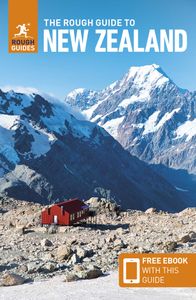
Find even more inspiration here

Planning your own trip? Prepare for your trip
Use Rough Guides' trusted partners for great rates
written by Rough Guides Editors
updated 01.09.2023
Ready to travel and discover New Zealand?
Get support from our local experts for stress-free planning & worry-free travels.
- Where to stay
- Travel advice

New Zealand Travel Guide
Your ultimate new zealand travel guide, with tips, ideas on things to do, and best things to see in new zealand. great for first-time and returning travelers..
New Zealand really does conjure up images of Middle Earth.
It is a land filled with breathtaking scenery , striking mountains, pristine beaches, lush forests and rolling hills.
The landscape is so diverse in such a small space.
One minute you can be walking on a glacier and the next you can be hiking beside a waterfall. It is simply an unforgettable journey.
This New Zealand travel guide will help you plan your next vacation.
Popular City Guides
- Top Things to do in New Zealand
- Christchurch
- Bunjee Jumping
Our Highlight
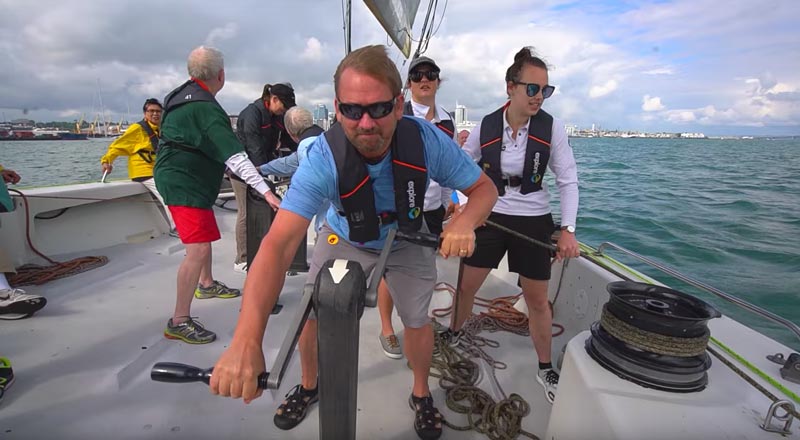
Table of contents
Table of Contents
Fast Facts about New Zealand
- New Zealand power voltage is 220 V 50Hz; Plug I
- The currency is the New Zealand Dollar and is around 1.20 NZD to 1.35 USD
- Internet can be slow and expensive, travelers can check out McDonalds and libraries for free Wi-Fi .
- Tipping is not customary in New Zealand, so you don’t need to leave anything extra unless the service was truly exemplary.
- You can get a local sim card from Vodaphone once you arrive in New Zealand. We recommend this for longer stays.
Things to See and Do in New Zealand
- Sky Dive Abel Tasman – enjoy the outstanding scenery as you jump from the 16,500 feet.
- Whitewater Raft Class 5 Rapids – go on the ultimate white water rafting experience through freezing glacial waters and the ultimate class 5 rapids.
- Swim with Dolphins – have a special and personal moment with a dolphin in the Bay of Islands.
- Paraglide in Queenstown – take a tandem jump and fly high in the sky overlooking the city, lake and mountains.
- Bungy Jump! – try a bungy jump (yes it’s spelled bungy, not bungee) in New Zealand, the land where it was invented.
- Take a Sailing Adventure – through Abel Tasman
- Tamaki Maori Village – Rotorua is renowned for its Maori culture experiences and the most well-known of them all is the Tamaki Maori Village Rotorua where travelers can experience a journey into the heart of the Maori culture.
- Visit the Boiling crater of Wai-O-Tapu – also known as the Campagne pool, this geothermal area is filled with thermal springs and geysers
- Trek the Fox Glacier – suit up with thick woolly socks and boots before embarking on a full day walk through this epic glacier.
- Discover the Glow-worm Caves – be dazzled by the sparkling display of bioluminescent lights in this cave.
- Check out the Sights of Middle Earth – take a tour with Luxmore Jet for a pinch of adrenaline with a heap of nature through Middle Earth.
New Zealand Travel Guides
- The Tongariro Alpine Crossing: New Zealand’s Best 1 Day Hike
- Best Things to do in Wanaka
- 21 Things to Do in Christchurch, New Zealand
Accommodation
Budget: New Zealand has a variety of hostels for about 15.5-30 New Zealand dollars per night. These hostels come with dorms, free Wi-Fi, shared kitchens, lounge areas, and great central locations.
Mid-Range: Mid-range hotels will cost around 86-150 New Zealand dollars per night. Amenities include private rooms with coffee makers and flat-screen TVs, a hotel restaurant and bar, a gym, and an indoor pool.
High-End: For five-star hotels, expect to pay around 156-400 New Zealand dollars per night. Take in the best with top-of-the-line hospitality, private rooms and suites with balconies and living rooms, fine dining options with live music, a spa and hot tub, a fitness center, in-room breakfast, and room service.
Check out our favorite booking platforms Booking.com , Tripadvisor and VRBO for the best deals on accommodation.
The cuisine in New Zealand favors seafood, roast lamb, fish and chips, wine, and cheese. Dinner is usually the main meal of the day. When out and about, look for hokey pokey ice cream (caramelized honeycomb) or pavlova (meringue, fruit, and whipped cream).
New Zealand has many street vendors, as well as restaurants, where you can try more of their cuisine. In total, expect to pay around 75 New Zealand dollars per day for food when dining at restaurants.
The Best Ways to Get Around New Zealand
Getting to new zealand:.
Flights: The main hubs to New Zealand are Auckland, Christchurch, Wellington, and Queenstown. Auckland Airport is the largest international airport in New Zealand and is located about 9.5 miles from downtown.
Other major airports include Christchurch International Airport (7.5 miles from the city) and Wellington International Airport (3.5 miles from the city). Air New Zealand flies from around the world with direct flights from cities such as Vancouver, San Francisco and Hong Kong.
You can check for the best flights to New Zealand on Skyscanner .
Transportation:
Buses : Buses are a good way to get around and one of the main ways that locals travel. Tickets start at 1.57 New Zealand Dollars. If you know you’ll use the bus a lot, consider getting a bus pass, with prices based on the number of trips you take. You can also look for bus tours that travel throughout the whole of New Zealand and include meals and places to sleep.
Taxis: Taxis are available in most cities in New Zealand and start at 3.50 New Zealand dollars in places like Auckland.
Campervans are an excellent way to get around New Zealand with several companies offering rentals and well-established campgrounds with full facilities. Read all about our experience here.
To rent a car, you must be at least 21 years old and have a driver’s license. Drivers under 25 will be subject to additional fees per day. For drivers 25 and over, prices start at 70 New Zealand dollars per day. Check for prices and availability here.
Uber: Uber is available throughout New Zealand.
When to go To New Zealand
New Zealand has a varied landscape with two distinct islands. The North Island is warmer than the South with a sub-tropical climate.
Snorkeling and swimming is more pleasant up here. But the South Island was made for adventure.
Dec-Feb is summer in New Zealand – this is high season with the most visitors. You’ll see a lot of campervans on the road and campgrounds fill up quickly. March – April – a great time to visit at just the start of autumn. There are still warm days and crowds start to thin out. But pack layers and a jacket. You’ll start to see the fall colours too! We travelled through New Zealand all of March and days were warm. Evenings were cool, but we still managed to snorkel, go sailing, skydive, bungy jump…we did everything you would do in New Zealand during the summer months. June – August is winter in New Zealand. If you are into skiing, you may want to check out New Zealand in the winter. The South Island can dip below -10 C – the North Island sees more rain in winter -Snowfalls happen in the Central Plateau on the North Island and the Southern Alps in the South. Sept- Nov – Good shoulder season for travel as things start to warm up and crowds haven’t arrived full swing.
Where to Stay in New Zealand
Sofitel Auckland – centrally located in Auckland at Viaduct Harbour, you can’t go wrong with a Sofitel. It is close enough to amenities, but quiet enough for a retreat.
ibis Wellington: Just a few minutes from the museum, city gallery, and library, there is plenty to do around this hotel in Wellington. Once you’re done exploring, come back to the hotel for flat-screen TVs and tea inside your room, a lobby bar, a fitness center, and a breakfast buffet.
BreakFree on Cashel : Just a short walk to Canterbury Museum, North Hagley Park, and Cathedral Square, stay in the heart of the central business center in Christchurch. The hotel comes with rooms with city views, family rooms with bunk beds, a restaurant and bar, room service, and an airport shuttle.
What to Pack for New Zealand
New Zealand has a diverse landscape with volcanoes, glaciers, breathtaking mountains, endless stretches of beaches and luscious forests. New Zealand’s climate varies depending on the area travelers intend to visit.
The weather in New Zealand can change in an instant , so travelers should always be prepared for anything!
- Layers – The general rule of thumb is to pack at least four layers: a base layer, long sleeve shirts, a fleece (mid-layer) and a top layer such as a windbreaker (waterproof!). Don’t forget a warm pair of gloves, thick scarf and a hat!
- Read our tips for layering and check out our ultimate list of travel gear.
- Thermal underwear – this is especially important if traveling to the South during the winter or hiking in the mountains.
- Sunscreen – The depleted ozone layer over the country means that the sun is incredibly strong. Along with sunscreen, pack a pair of sunglasses and a hat.
- Rain Gear – it tends to rain a lot in New Zealand even in the summer. However, avoid bringing along umbrellas as the rain is coupled with strong gusts of wind. Instead, invest in a good waterproof jacket that will keep you protected.
- Backpacks – a sturdy backpack or large bag is more appropriate for adventuring as they are easier to carry and you don’t have to roll them through the sand of New Zealand’s amazing beaches.
New Zealand Travel Guide: Best Booking Resources
Whenever we travel to we make sure to start with these companies. We have tried a lot of different ones over the years and all of these have consistently proven to be the best when it comes to offering great prices.
We have used every one of these personally and continue to do so.
- Booking.com : This is our go site to when comparing prices for accommodation. It usually has the cheapest prices, especially in Europe and we love their interface. Not to mention you get free cancellation and you are guaranteed the best price.
- Trip Advisor : What we like about Trip Advisor is that we can look at all the reviews and then book our accommodation. TripAdvisor is where we go when we want to compare prices with multiple accommodation providers.
- VRBO : is the main search engine we use when we are looking for a home or apartment rental. It can sometimes be cheaper than hotels and it is the best way to stay in areas that offer a more local feel.
- Hostelworld : With one of the largest databases of hostels in the world, Hostelworld is the go-to site when you are looking for budget accommodation.
- Skyscanner : This is the first place we check for flights. It consistently comes back with the cheapest and best options. It allows us to compare a lot of airlines to get the best price.
- Rome 2 Rio : If you want to see how to get somewhere by plane, train, bus, ferry or car Rome2Rio lays it all out for you as well as related costs.I love how they show it all to you on a Google Map and it works offline.
- Get Your Guide: For all your day trip and city guide needs, we use Get Your Guide. It has the world’s largest collection of things to do with more than 30,000 activities in 7500 destinations.
- World Nomads Insurance: When traveling to Italy you should always have travel insurance. We have found the best bang for your buck is by far World Nomads.
New Zealand Travel Guide: Related Articles
To browse all our articles and guides about New Zealand click here .
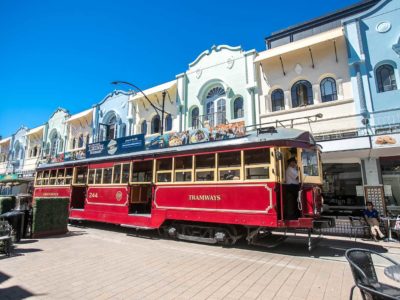
29 Things to Do in Christchurch, New Zealand in 2024
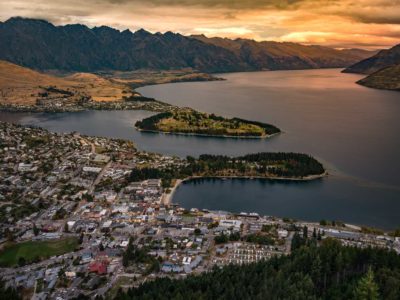
23 Amazing Things to do in Queenstown, New Zealand
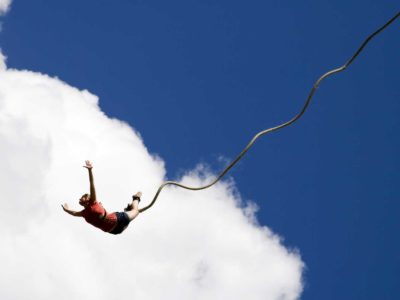
Where to Go Bungy Jumping in New Zealand

TRAVEL to NEW ZEALAND – Tips and Information Guide
New Zealand
Everything you need to know about travel to New Zealand in our comprehensive 2024 New Zealand travel guide.
New Zealand is truly the land of the Long White Cloud with a vast contrast between the epic coastlines of the Otago Peninsula to the summit of Aoraki Mount Cook.
Most people divide their travel in New Zealand between the North Island and South Island. South Island tends to be more popular with outdoor enthusiasts.
But regardless of which island you see, or whether you tour both, you won’t be let down.
Fancy a thermal river? Then head to the North Island’s Rotorua or if you prefer snowy mountains, Queenstown is the place to go!
If none of this fancies you then why not head to the Bay of Islands only a short drive from Auckland to take in some sunshine and fresh oysters? Follow this up with a trip you’ll not soon forget to the top of New Zealand, Cape Reinga.
New Zealand is probably the most surprising country you can visit as it is jam-packed full of adventure, landscapes and friendly locals. Do yourself a favour and get there ASAP!
Once you start planning to travel to New Zealand, you’re in for a great adventure!
Here’s our New Zealand travel guide to get you caught up on the basics of this amazing country.
TRAVELLING IN NEW ZEALAND: AT A GLANCE
Here are the basics about travel to New Zealand.
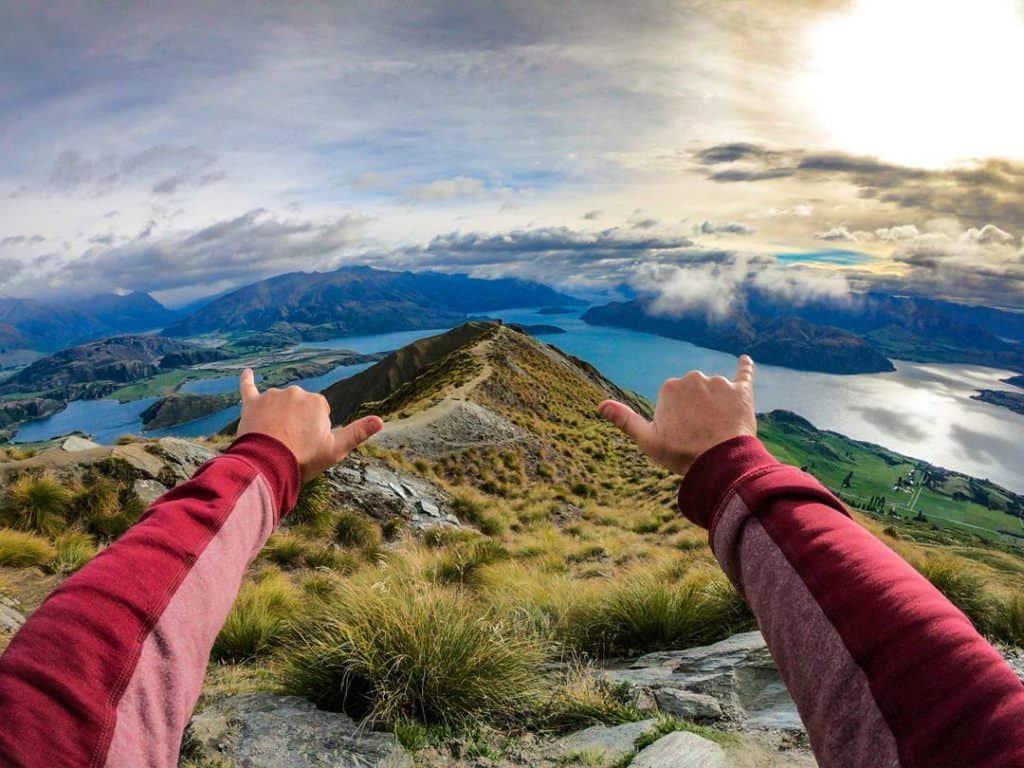
TOP 5 TRAVEL EXPERIENCES IN NEW ZEALAND
With so much to see and do in New Zealand, it really is hard to pick the top experiences.
However, we think that to truly appreciate New Zealand you need to plan to do these 5 activities during your visit.
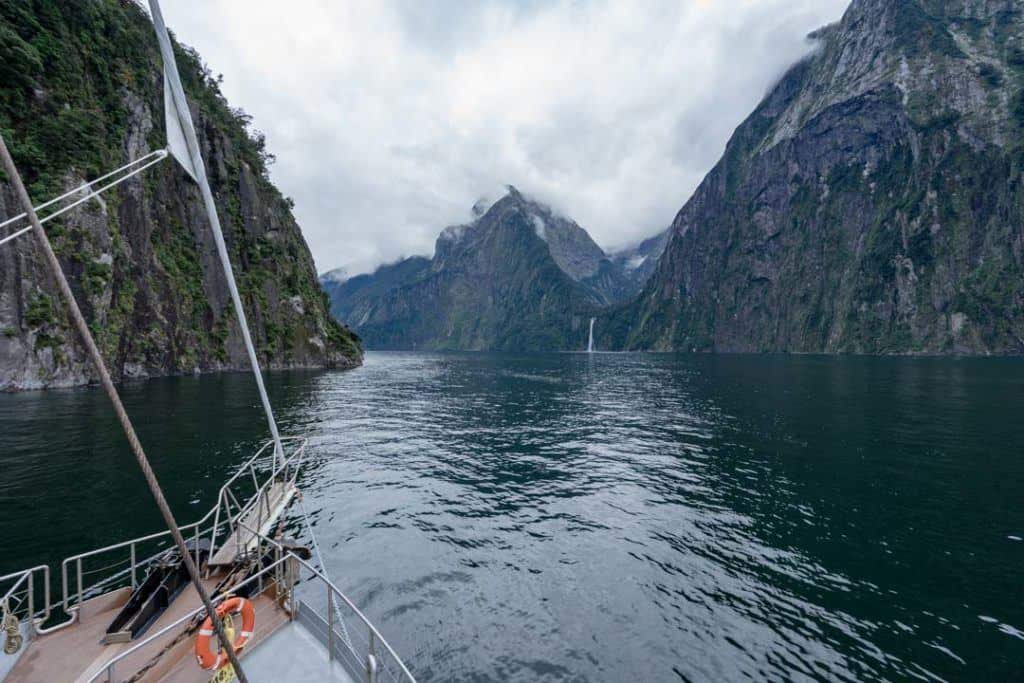
Cruising the Milford Sound
Cruising on a boat in the stunning Milford Sound is an absolute MUST! Kayak, cruise and cuisine your way through some of the most spectacular scenery in New Zealand!
Book a Milford Sound cruise and lunch today !
Walking Hooker Valley
The Hooker Valley walk at Aoraki National Park is basically like walking in a piece of paradise. To your left will be snowcapped peaks and to your left will be snowcapped peaks. At the end of the trail lays Hooker Valley Lake full of icebergs and epic views of Mount Cook.
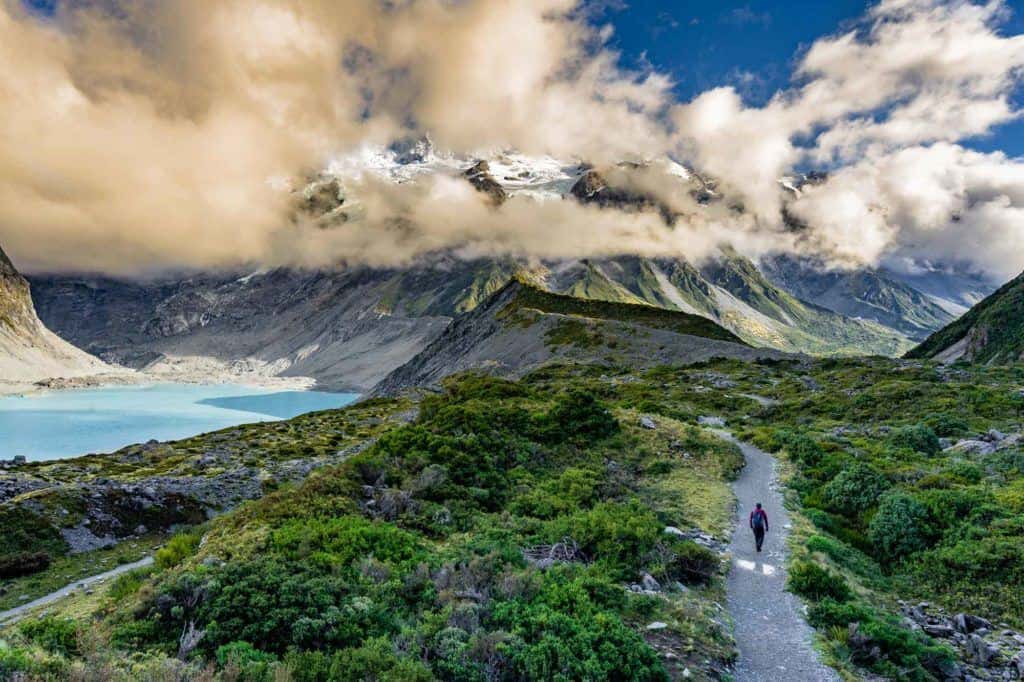
Stargazing at Lake Tekapo
Stargazing at Lake Tekapo is remarkable due to limited light pollution. Opt for a summer’s night out to enjoy the Southern Hemispheres spectacular stars!
Book a trip to Lake Tekapo here !
Snowboarding or Skiing the Remarkables
Snowboarding or skiing The Remarkables high above Queenstown is every snow enthusiasts dream! So get prepared to shred and smash some freshly fallen powder!
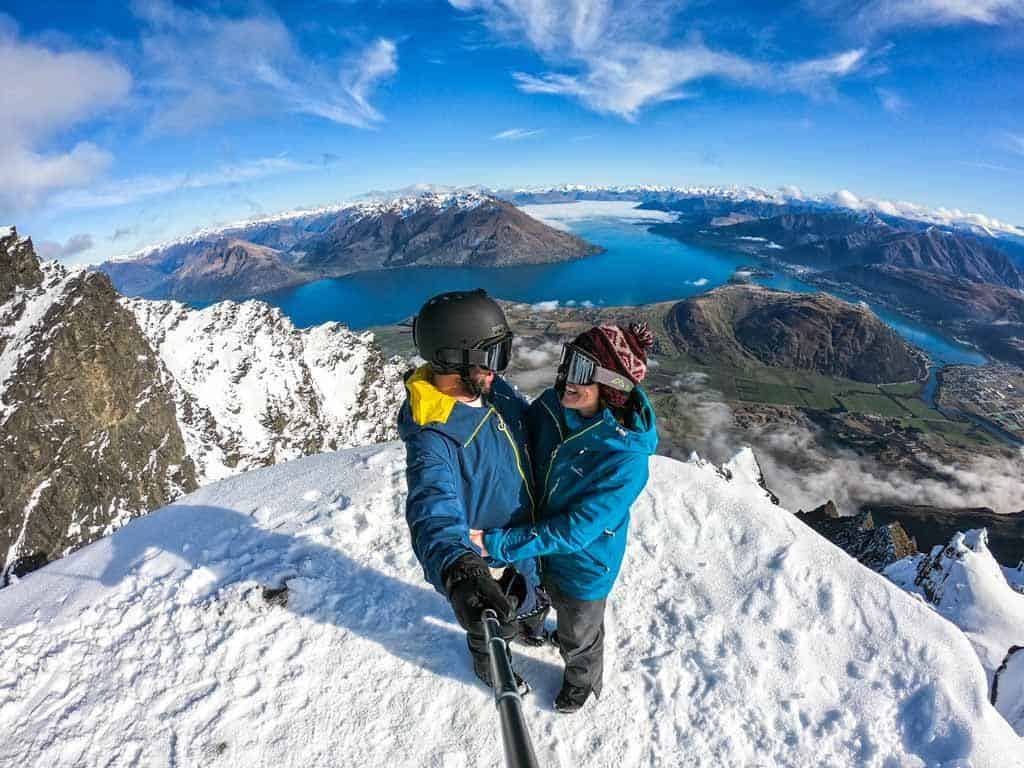
Wildlife Watching on the Otago Peninsula
Wildlife watching on the Otago Peninsula can be done at any time of the year where penguins, seals and albatrosses can be seen in their natural environment.
Other Things to do in New Zealand
There are plenty of great things to do in New Zealand. Most of them will keep you outside exploring the beautiful landscapes found throughout the country!
Splurge on a heli-skiing trip in Wanaka . See the mountainside like few people do as you shred your way through freshly fallen snow!
Go for a hike on any of the spectacular trails found throughout the country. Some favourites can be found in our guide to hiking New Zealand.
Visit Hobbiton and tour the set of Lord of the Rings . If you’re not a fan of the movies you will be once you check out where they were filmed !
Paddle a canoe on a multiday trip down the Whanganui River. Spend 3-5 days on a unique journey you are not bound to forget.
Kayak Doubtful Sound . You won’t get a more authentic and raw natural experience in New Zealand than getting out on the Doubtful Sound for a good paddle.
Take a zip-line canopy tour through Rotorua . Visit the thick forest from above and learn about its importance while getting the adrenaline moving !
Kayak Abel Tasman . Ok, so paddling Abel Tasman is pretty magical too. Be sure to add this to your list of things to do in New Zealand!
Kitesurf in Taranaki . The wind is epic and harnessing it in a kitesurfing sail is going to lead to one of the most adrenaline-pumping activities in New Zealand!
Go whitewater rafting down the Kaituna River . Paddle through 14 rapids , including a handful of epic class 5 rapids and the world’s highest rafted waterfall.
Bungee jump in Auckland or Queensland . Go weightless (momentarily) where bungee jumping first began with the most spectacular backdrop!
BEST PLACES TO VISIT IN NEW ZEALAND
There are plenty of amazing places to visit in New Zealand. Depending on your interests, trip duration and time of year you will find plenty of things to do during any length of stay.
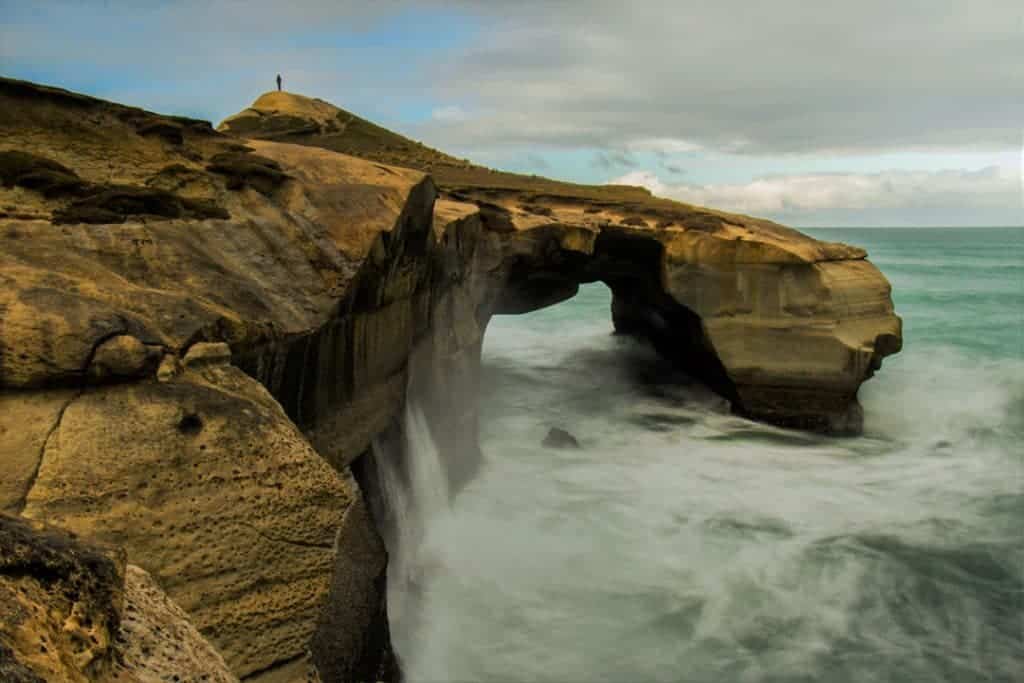
Rich in Maori history and culture, Auckland is the most populous city in New Zealand. Here you’ll find plenty of incredible things to do !
Known for its beautiful landscapes and wild outdoor activities (can you say bungee jumping?!) Queenstown will have your heart as soon as you arrive!
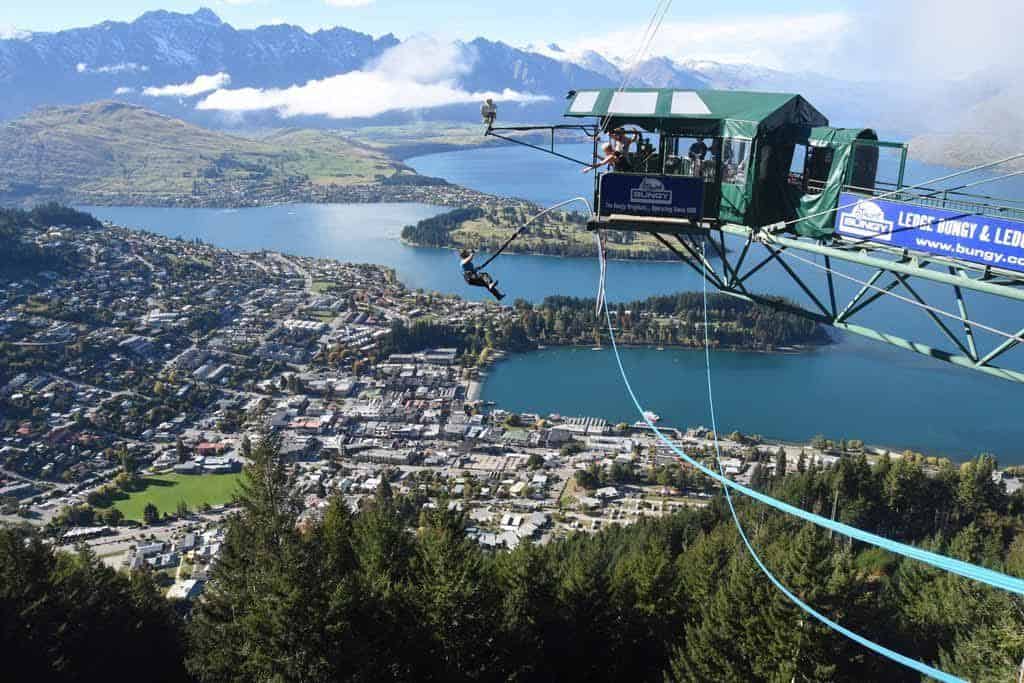
Aoraki National Park
Aoraki National Park is a place of dreams complete with New Zealand’s highest peak, Mount Cook soaring to over 3,700 metres.
Tongariro Crossing
Tongariro Crossing is one of the most popular day treks in the North Island where you see scenes from the famous Mordor and Mount Doom from the Lord of the Rings.
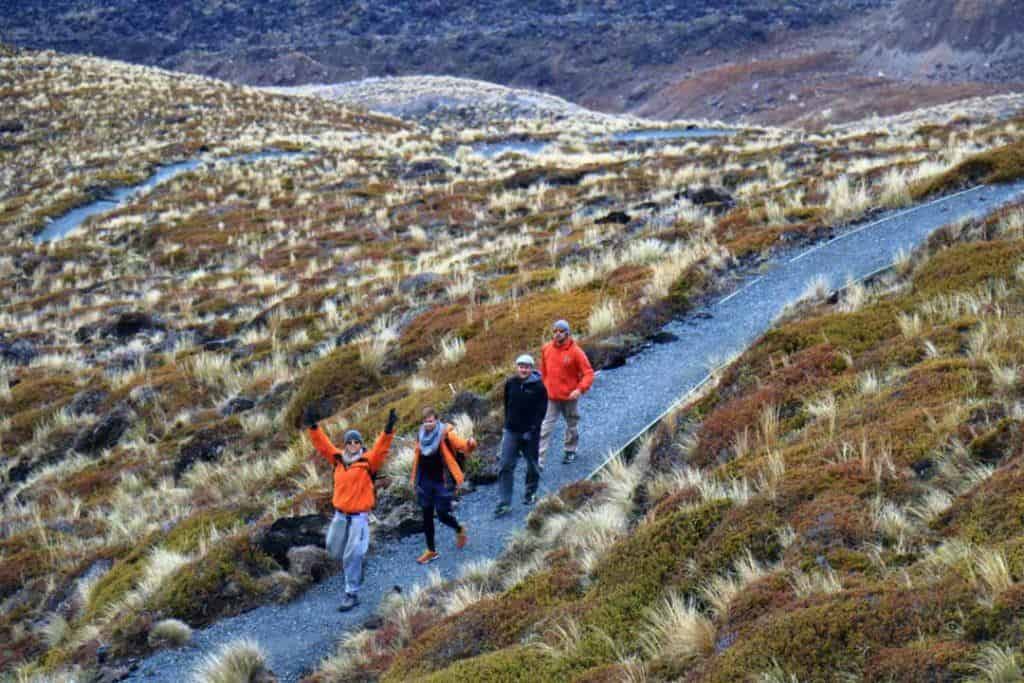
Mount Aspiring National Park
Mount Aspiring National Park is honestly the most beautiful place to sit back and just stare at mountains for hours on end. Options here include a hike to Rob Roy Glacier or further onto French’s Ridge hut for those adventurous souls.
For more information on specific things to do in the top places to visit in New Zealand, reference our following city travel guides:
BE SURE TO CHECK OUT THESE OTHER AWESOME PLACES TO VISIT IN NEW ZEALAND .
BEST NEW ZEALAND TRAVEL ITINERARY
Depending on whether you are starting from scratch or have a general idea of what kind of things you would like to see and do when travelling in New Zealand, we’ve put together a few itineraries that are sure to leave you wanting for nothing at the end of your visit.
There are so many amazing things to do in New Zealand that planning an itinerary for your travel can be a little overwhelming.
In this section, we’ll not only help you plan a 1-, 2-, or 3-week New Zealand itinerary but also give you an overview of many of the places you might want to consider visiting and things you may want to do.
Of course, no one-size-fits-all plan will suffice. But if we were to head back to New Zealand these are the top places and things that we would want to do!
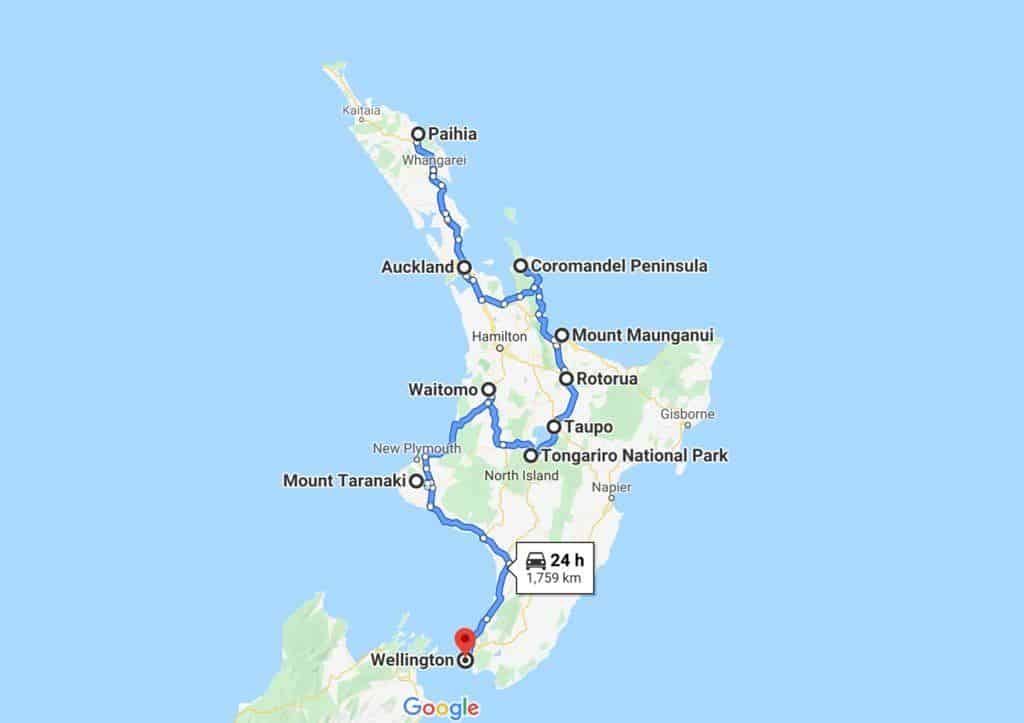
1-Week New Zealand North / South Island Travel Itinerary Highlights
If you only have 1 week to travel in New Zealand the best thing you can do is to pick either the North Island or the South Island to explore.
Here’s an overview of how we’d spend 1 week on either the North Island or South Island of New Zealand.
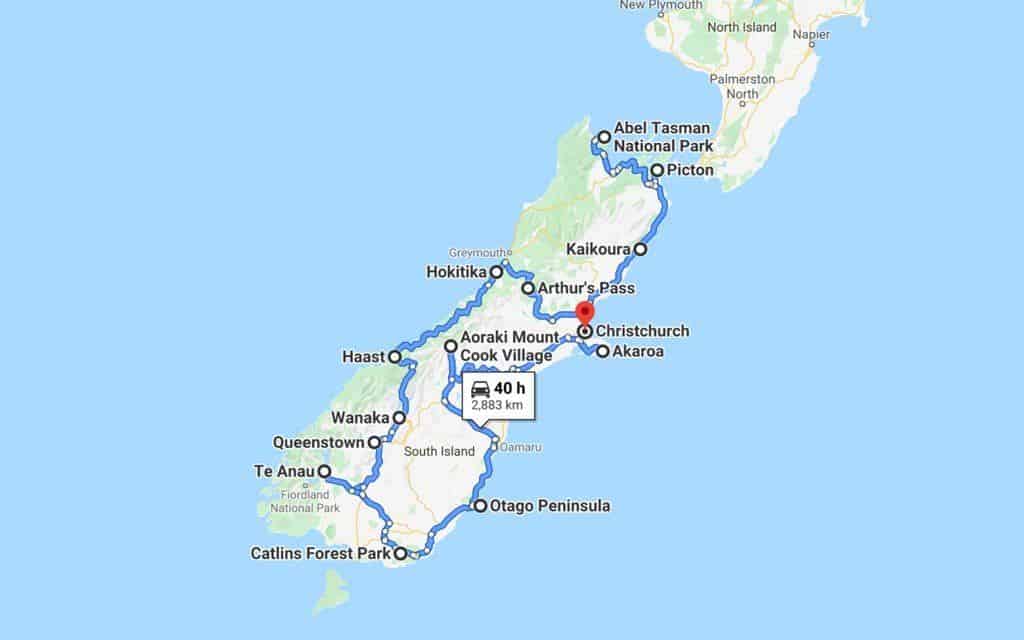
2-Week New Zealand Travel Itinerary Highlights
With 2 weeks in New Zealand, you can split your trip to cover both the North Island and the South Island. For this itinerary we recommend you fly into Auckland and out of Christchurch.
This is an idea of how we’d spend 2 weeks in New Zealand.
- Day 1 and 2 – Auckland
- Day 3 – Mount Maunganui
- Day 4 – Rotorua and drive to the Tongariro National Park
- Day 5 – Tongariro National Park
- Day 6 – Wellington
- Day 7 – Crossing the Cook Strait and driving to the Abel Tasman National Park.
- Day 8 – Hiking in the Abel Tasman National Park
- Day 9 – South Islands West Coast – Kaiteriteri to Hokitika
- Day 10 – South Island’s West Coast – Hokitika to Franz Josef or Fox Glacier and on to Wanaka
- Day 11 and 12 – Lake Wanaka
- Day 13 – Mount Cook
- Day 14 – Christchurch
3-Week New Zealand Travel Itinerary Highlights
Three weeks in New Zealand gives you a chance to see and do more. So if we had 3 weeks in New Zealand, this is how we’d spend it.
- Day 1 – Auckland
- Day 2 – Waitomo
- Day 3 – Tongariro National Park
- Day 4 – The Forgotten World Highway
- Day 5 – Wellington
- Day 6 – Crossing the Cook Strait to Picton and driving to Kaikoura
- Day 7 – Whale watching and dolphin swimming in Kaikoura
- Day 8 and 9 – Akaroa, the Banks Peninsula and driving to Mount Cook.
- Day 10 – Hiking around Mount Cook
- Day 11 and 12 – Wanaka
- Day 13 and 14 – Queenstown
- Day 15 and 16 – Doubtful Sound
- Day 17 and 18 – Caitlins National Park
- Day 19 and 20 – Dunedin and the Otago Peninsula
- Day 21 – Christchurch
READ MORE: Check out this post for more details on our New Zealand travel itinerary .
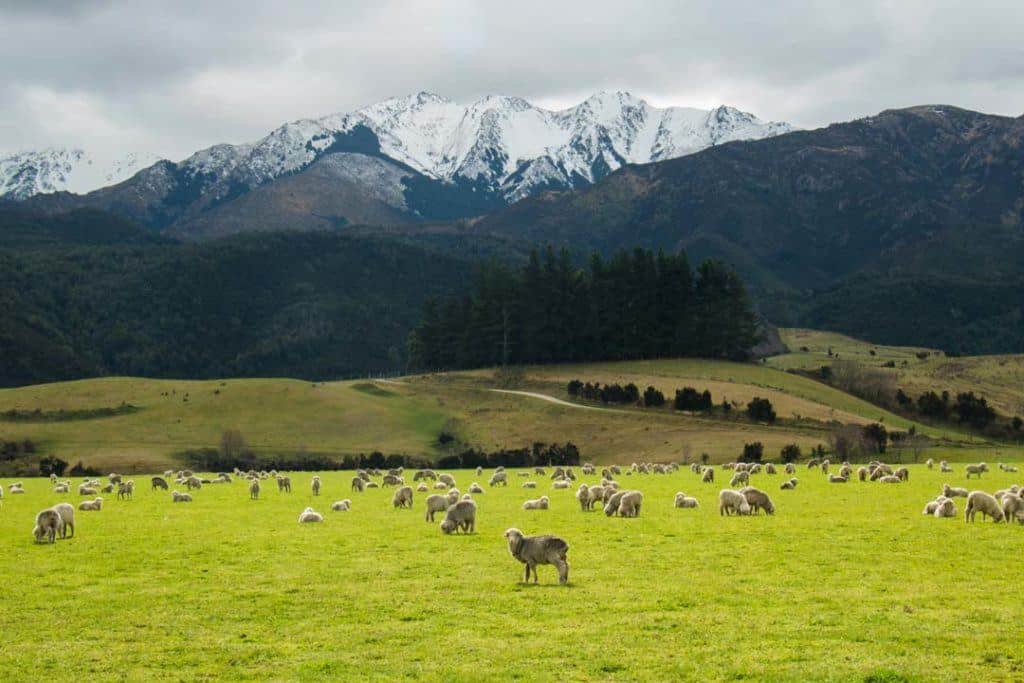
NEW ZEALAND TRIP PLANNING
Now we’re going to help you plan your ultimate trip to the Land of the Long White Cloud so you don’t make any mistakes! Here’s our best New Zealand travel tips based on almost a dozen trips!
BEST TIME TO VISIT NEW ZEALAND
These are the best times to travel to New Zealand:
- October – February for those perfect summer days.
- June – September for all things snow.
NEW ZEALAND TRAVEL BUDGET GUIDELINE
New Zealand is not the most affordable place to visit. However, you are sure to have a spectacular time well worth the expense.
You’ll find that taking a road trip is the best and most affordable way to see the country – especially if you plan to do some camping along the way.
Here’s an overview of what to expect when budgeting for travel to New Zealand:
Here are a few things you should know about the different budgets at which you can choose to travel.
Note: Budgets shown as Single Traveller / Couples per day.
Budget Traveller ($90 Single / $140 Couples)
If you’re here on a strict budget you are more likely to be getting around by car or basic camper van relying on DOC sites for your accommodation needs with the occasional splurge at a holiday park.
Basic camper vans will be small 2 berth campers that are often old Mazda vans, or people carriers converted into a home on wheels.
These budget-friendly camper vans are not self-contained, therefore you will not be allowed to freedom camp.
Make use of supermarkets and accommodation facilities to cook and limit eating out to an absolute minimum to keep the costs down.
Make sure to check the discounted aisles as quite often meat is marked down significantly if it is soon the pass its expiration date.
Adrenaline sports and other activities in New Zealand do not come cheap. If you are on a budget you will need to limit there.
So work out what you can realistically afford and do your research before you go, as the same activity may be cheaper in other parts of the country.
Mid-Range Traveller ($140 Single / $280 Couple)
If you’re on a mid-range budget then you are more likely to be travelling in a self-contained pop-top camper van and staying in a few more holiday parks than DOC sites.
Although eating out is expensive you may be able to afford the odd restaurant visit. But you will still be utilising supermarkets and holiday park facilities for the majority of your meals.
In terms of activities, you will be able to do more than if you were on a budget.
However, you will still need to watch the pennies, as the costs of these can rack up very quickly.
Luxury Traveller ($200+ Single / $300+ Couple)
If money is no object then you will be travelling in a rental car and staying in Airbnb, hotels or guesthouses, or you will be in a large multi-berth camper van.
As well a being fitted with the latest mod cons, the larger camper van will also be self-contained. If you’re taking the camper van option then you will be spending the majority of your time in holiday parks.
You will have the option to eat out more often, and whether you choose to is up to you.
In addition, you will also be able to splash out on some fancy purchases from the supermarket.
For activities, go wild! You’ve got the money so splash out and do as much as you want. New Zealand is full of great adventures and opportunities to have an amazing time!
New Zealand Budgeting Tips:
We have some great tips on how to make the most of your budget when you travel to New Zealand.
Top 10 Cards
Top 10 is the largest holiday park chain in New Zealand. They offer high-quality facilities at a reasonable price.
Purchasing a Top 10 card for $49 will save you 10% at all of their holiday parks. There are other additional discounts all over the country, including the ferry crossing from Wellington to Picton and on various activities including trips to Milford and Doubtful Sound.
Whenever you’re booking an activity, check if they have a top 10 discount. It saved us quite a lot when we were out there.
Take advantage of supermarket deals
Unless you have an almost unlimited budget you are going to be cooking a lot of your own food. New Zealand’s main supermarkets are Four Square, Pak n’Save, New World, Countdown and Fresh Choice.
Each supermarket will have various deals and multi saver options and some will have fuel discounts as well.
Early Bookings
If you’re visiting in Spring or Summer then it pays to book early to both ensure your space in a holiday park (especially around the Tongariro National Park) or on various activities.
Occasionally booking early will get you significant discounts.
Scour Travel Magazines
Any travel magazine, including ones you will pick up with your rental vehicle or at the airport, are loaded with discount coupons, for a variety of things potentially saving you quite a bit of money.
These generally can’t be combined with a top 10 discount card though.
Free BBQ’s
At various locations across New Zealand, you can expect to find free BBQs for public use. Make sure you have cleaning materials to ensure it’s clean for others to use afterward.
Plan Where You Are Going To Fill Up
Prices of petrol can vary in New Zealand. Therefore it pays to plan where to fill up.
For example, if you are taking a trip down to the tiny town of Manapouri to take a trip to Doubtful Sound, make sure you have a full tank before heading off as petrol is expensive there.
As a general rule of thumb, the smaller and more isolated a place is, the higher the petrol price is likely to be. A small difference here or there can help you to save if you’re here for a significant period of time.
Keep this in mind when travelling in New Zealand.
Check Your Fuel Consumption
When choosing which campervan you want to rent, check the fuel consumption. Often a lot of older and cheaper models consume a lot more fuel than some more expensive models.
Therefore it may be worth paying more to rent, as it could be cheaper when fuel costs are taken into account.
Limit Your Eating Out
If you are on a budget then this is one of the easiest ways to save money. Whilst being delicious, eating out in New Zealand is expensive and as such is an easy way to limit your outgoings.
Consider Travelling in New Zealand in The Winter
The cost of activities and vehicle rental is much cheaper in the winter than in the spring and summer.
Naturally, the weather won’t be as good and there will be some activities that are not running and some hiking trails that may not be accessible.
However, it has the potential to save you quite a bit of money.
Hire Returns
If you are planning on visiting New Zealand for a long time then this could be worth considering. Many camper van rental companies need vehicles moving to various places around the country.
The cost of renting campervans for these journeys is insanely cheap, sometimes as little as a few dollars a day.
The downside is that you have a limited time to get from point A to point B and it can be hard to follow a route, as you may be going here there and everywhere.
However, if time is on your side then this could be well worth it!
Buying A Vehicle
If you are going to be visiting New Zealand for an extended period of time then renting is not a sensible financial decision.
Buying your own vehicles has a number of advantages
- Your trip is a long as you want it to be.
- You could potentially sell the vehicle for the same or a similar price to what you paid for it, limiting your travel costs.
However, you won’t be able to rely on a hire company if something goes wrong.
You will need to add a few weeks on either side of your trip to buy and sell your vehicle.
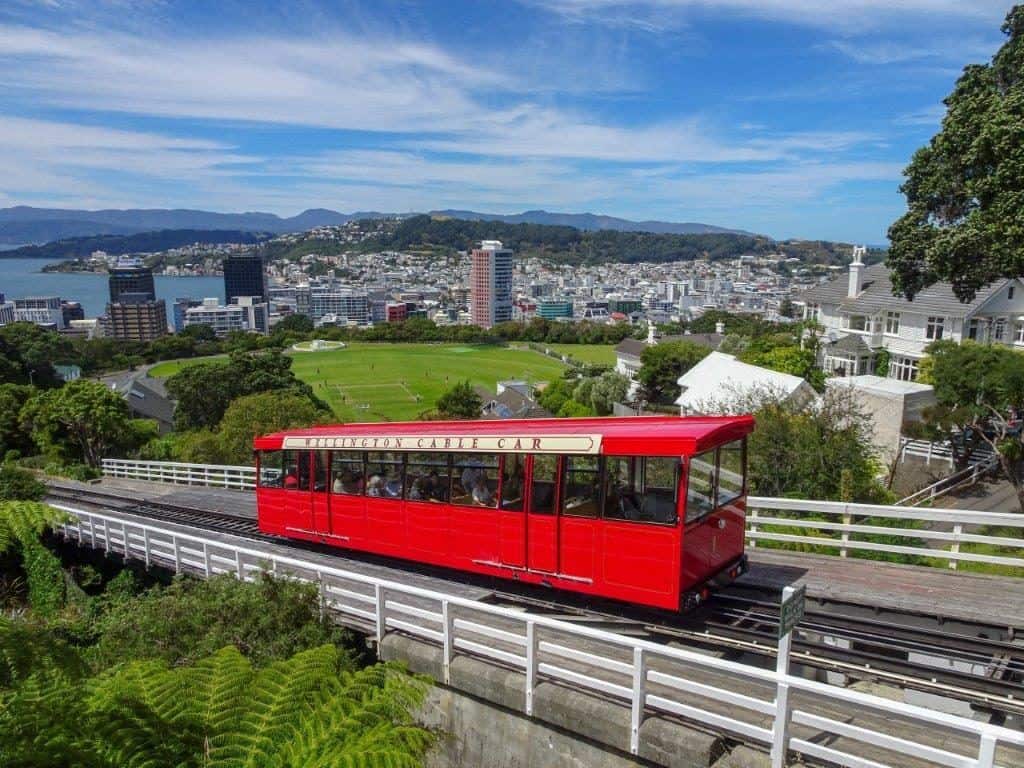
GETTING TO AND AROUND NEW ZEALAND
New Zealand is an island nation and thus the most reasonable, cost-efficient and common way to travel to New Zealand is by air.
Entry Requirements
It is relatively easy to travel to New Zealand. Australians can enter and stay visa-free.
UK citizens can enter for free with a 6-month stay.
Other nationalities may qualify for a visa waiver.
For information about which countries are granted visa-free waivers click here
Getting Around New Zealand
Hiring a vehicle is the best way to get around New Zealand and experience the stunning scenery that New Zealand has to offer.
Whilst there are public transport options available, there are natural limitations on the areas you can visit.
Travelling by Air
This is not a common option for many travellers. However if your time here for a shorter period of time then they can be an excellent option to cover larger distances.
You can then pick up a hire car at each destination and utilise short term rentals. This may be beneficial, for example, in flying between the North and South Islands to/from Auckland and Christchurch.
It’s not uncommon to find discounts, especially when booking early.
Travelling by Car
Generally much cheaper than renting a campervan, both in terms of rental fees and fuel consumption. If you’re here on a short visit then renting a car may be a better option than renting a campervan.
This can be a particularly budget-friendly option if you plan on camping as opposed to staying in Airbnb’s and guesthouses.
This is the way most travellers get around. Many have wonderful memories of pulling up in their campervans on edge of a lake, a deserted beach, or just stopping on a quiet road to admire the view.
It gives you more freedom and flexibility than a car. However it is more expensive and uses more fuel.
But if you are visiting for a longer period of time it can actually work out being quite similar, once you take the cost of accommodation into account. Holiday parks and DOC sites are much cheaper than guesthouses and Airbnb’s.
Many travellers rent large campervans, despite have little experience of driving a vehicle of such size.
When combining this lack of experience with New Zealand’s narrow and winding roads it can be a rather stressful experience. So think carefully about what you really need.
READ MORE: Check out our epic New Zealand road trip itinerary !
Travelling by Bus
If you don’t drive then this is the best option. The two most well known bus companies are the Kiwi Experience , which is aimed primarily at those aged between 18 and 25, and the intercity network .
Both companies offer flexible hop on hop off passes where you buy a certain number of hours in which you can then top up as you see fit. You can also change your plans if necessary.
Additionally you can purchase pre-arranged passes which can work out to be good value for money.
Although bus networks in New Zealand are well connected, it is harder to get away from the towns and into the middle of nowhere – which is one of the highlights of any visit.
Additionally, it will be harder to access hiking trails since you will not have a car and thusly will be reliant on public transport.
Travelling by Boat/Ferry
The countries major ferry route is between Picton and Wellington connecting the North and South Islands.
In high season it is recommended to book ahead.
Travelling by Train
The most famous train journey in New Zealand is the Trans-Alpine route that crosses the South Island between Christchurch and Greymouth via the Arthus Pass National Park.
Aside from this there a number of other train routes offering stunning scenery.
That being said, this isn’t the most convenient way to travel and you will have to combine it with bus travel or vehicle hire to be able to get around the country.
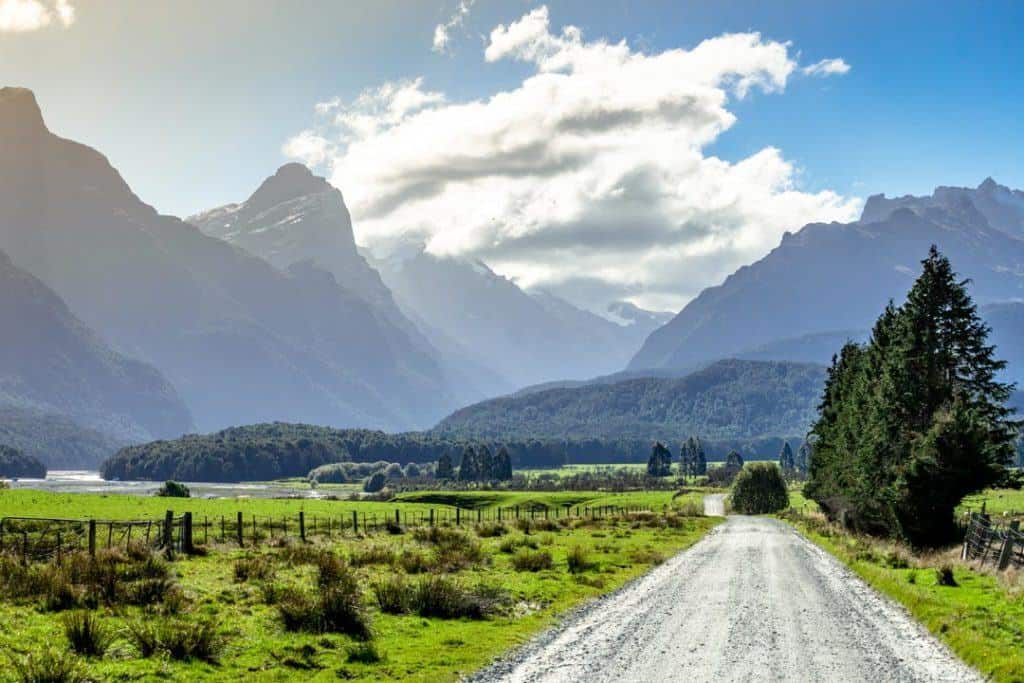
APPS AND TECHNOLOGY
Mobile apps and technology will make your trip safer, more affordable and overall more enjoyable.
Here are a few we think you should definitely acquaint yourself with prior to your travels:
- Google Maps – The tried and true navigation app that will help you find virtually any place in New Zealand and help you with directions on how to get there
- XE Currency – Transfer, monitor and calculate currency as the need arises. This app may not be totally necessary as you are typically tied into rates the banks charge for services. But it is handy to have around.
- Express VPN – This will protect your sensitive information wherever you travel – not just in New Zealand. Be sure to have this to keep your online information secure as you travel.
- CamperMate – Since you will most likely find yourself camping at some, if not all, of your travel to New Zealand, use this app to find camping spots all around the country
BEST THINGS TO EAT IN NEW ZEALAND
New Zealand has some pretty tasty food. You should definitely give the following foods a try when visiting!
- Lamb – A staple in Kiwi meals and found at almost every restaurant. Lamb is traditionally prepared with rosemary and garlic.
- Spaghetti on toast – Yes, as simple as it sounds this is a delicious New Zealand staple
- Marmite – The equivalent of Australian Vegemite, made from yeast extract and herbs. Spread it thin over crackers or bread.
- L&P – Lemon and Paeroa is mineral water tinted with lemon that could easily be the countries national drink
- Hangi – A traditional Maori method of steaming meats and vegetables where the food is wrapped in leaves and buried to cook on heated stones in holes in the ground.
- Kumara – A form of sweet potato that is prepared a variety of ways such as chips and wedges
- Fish And Chips – A classic dish with deep-fried battered fish and potato fries served with tomato sauce
- Pavlova – A meringue dessert that has caused much dispute over whether it was originally created in Australia or New Zealand.
- Hokey Pokey Ice Cream – Vanilla ice cream with caramelized sugar. Enough said!
- Manuka Honey – Produced by bees that collect the pollen of Manuka trees, this honey is thick and uniquely sweetened in flavor
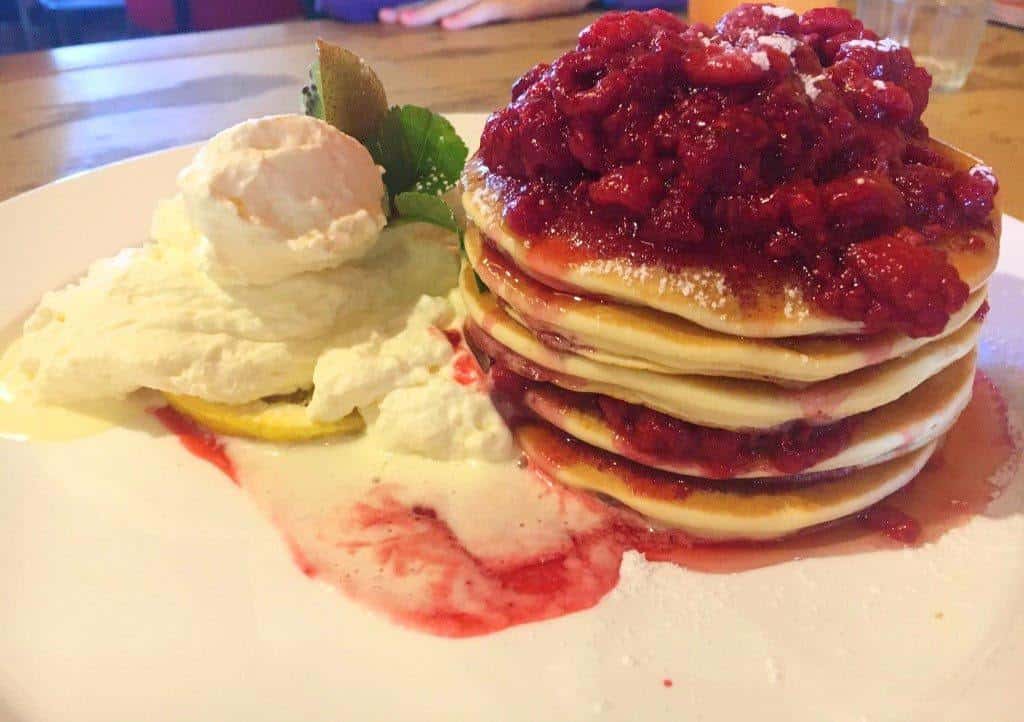
PLACES TO STAY IN NEW ZEALAND
New Zealand is chock full of great accommodation options. Whether you’re on a budget and need to stay at a hostel or have enough room in your budget to splurge on a hotel or unique Airbnb you’ll be pleased with your stay.
Of course, if you are looking to camp in beautiful landscapes then your options become even more wide open.
Holiday Parks and Campsites
Probably one of the most popular accommodation options for travellers visiting New Zealand. The predominantly cater to campervans and campers. However, some do have small chalets on site.
The vast majority will come with large kitchens and communal bathrooms. However, not all kitchens are equipped, meaning they do not have cooking utensils and cutlery.
In addition, holiday parks will offer both powered and non-powered sites. Naturally, non-powered sites are cheaper, so this could be a good way to save a few pennies here and there.
Rankers and Campermate are two useful apps that can help you locate holiday parks and campsites, see what facilities they have and check out reviews from other travellers.
Campmate allows you to book in advance and check out various things to do in the local area amongst other things.
There will be some campsites and holiday parks that only allow self-contained vehicles.
Your vehicle is self-contained if:
- You have a toilet fixed or portable that can be used even when the beds are down
- You have a fresh and wastewater tank
- An evacuation hose
- A rubbish bin with a lid
- Self-contained campervans can also be identified by a blue sticker.
DOC (Department of Conservation Sites) are generally cheaper and more rustic than holiday parks. Expect a bathroom and maybe a small unequipped kitchen.
However, they often located in stunning locations, with the White Horse Campground close to Mount Cook being a prime example.
There are 6 different categories of DOC site . They are a great budget option and are often surrounded by some stunning scenery.
Freedom Camping
There are some spots where you are allowed to freedom camp. In the past, you used to be able to freedom camp almost anywhere.
However, a large increase in tourists and the waste they left behind has put paid to that. You can now only freedom camp if you are in a self-contained vehicle.
Freedom camping is a wonderful thing. However for it to carry on working effectively, everyone needs to follow the rules and clear up after themselves.
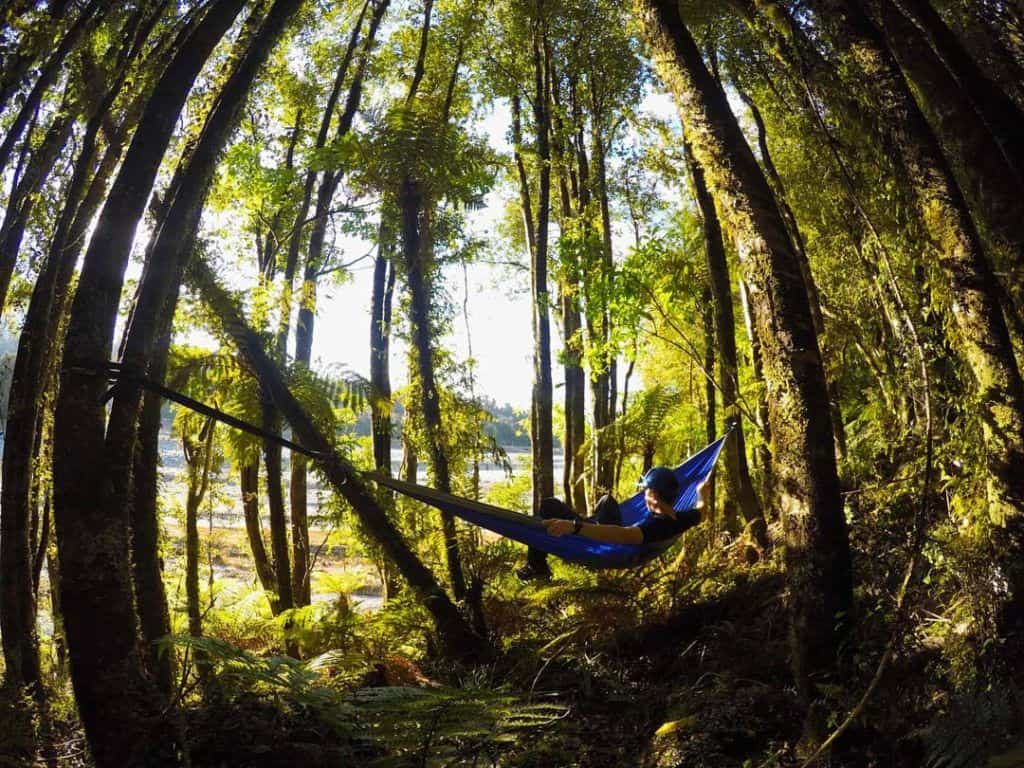
New Zealand is jam-packed with plenty of awesome hostels that connect travellers and are phenomenal resources of tips and information.
Incidentally, they are great places to buy and sell vehicles. So if you land in Christchurch or Auckland and are planning on buying camper van for your road trip, then your hostel is the perfect place to start.
Hostels predominantly focus on dorms as opposed to private rooms, which brings to cost down significantly.
If you are travelling by car, then hostels are a great alternative to camping, although they are naturally more expensive. Make sure they have parking!
Hotels in New Zealand are not cheap, so if you are on a budget this is something you may want to avoid.
However, there are spectacular hotels and guesthouses throughout the country that are a great excuse to splash some cash.
Generally, hotels rank from simple motel-style options up the swanky 5-star options with plenty in between.
Another good option in recent years for accommodation in New Zealand is AirBnB. And there are more and more amazing places popping up to stay for very affordable prices every day.
As is typical in many destinations where Airbnb accommodations are popping up, you’ll likely find great value and a little more personal space with an Airbnb stay.
NEW ZEALAND TRAVEL TIPS
Here are the best travel tips for New Zealand to help you have the safest, most affordable and enjoyable trip possible.
GENERAL NEW ZEALAND TRAVEL TIPS
While there are many basic travel tips we suggest you use when travelling to New Zealand, there are also plenty of New Zealand-specific tips that will make your visit the best it can be.
Here are a few we recommend you consider as you plan your trip to visit New Zealand:
1. Make Sure You Have a Credit Card
New Zealand is not densely populated. It’s the size of the UK with a population of around 4.5 million (for reference the UK population is over 65 million).
This means there are a rather large number of unmanned petrol stations that are pay at the pump.
When we visited we had problems with debit cards being accepted at these machines. However, we experience no issues with credit cards.
2. Avoid The Summer Holidays If Possible
Late December and January are particularly busy in New Zealand as this is the nation’s summer holiday. This means that there will be large numbers of both international and domestic tourists.
November and early December bring great weather and smaller fewer people.
3. Don’t Follow Penguins
If you are in Omaru, and you’re walking back to your accommodation and you catch sight of a penguin, stop and do not follow them.
If you don’t stop then the penguins may be too scared to return to their nests.
4. Check For Weather Warnings
The weather can change quickly in New Zealand. During the winter months, large areas of New Zealand can experience heavy snowfall which can lead to road closures amongst other things.
Make sure to check weather warnings and road closure notices to ensure you can make appropriate plans.
5. Be Prepared For 4 Seasons in a Day
New Zealand is the absolute definition of 4 seasons in a day. Therefore whenever you’re heading out on a hike make sure you bring the appropriate clothing just in case the weather changes.
6. Hayfever Issues
New Zealand has a large amount of indigenous flora and fauna, particularly on the South Island. If you have hay fever then you may have quite a serious allergic reaction.
If you experience this then you’ll need to go to a doctor and get some prescription-strength hay fever medication.
7. Always Assume Journeys Will Take Longer Than Google Maps Says
New Zealand’s roads offer breathtaking views as you wind your way across the country.
Occasionally roads can be steep, narrow and extremely twisty.
If you are not used to driving such roads then it’s a safe bet that journeys will take longer than what google maps says.
8. Book Ahead If You Can
This is especially advisable for campsites and holiday parks. In Autumn and Winter, there is a good chance you can turn up and there will be space.
However in late Spring, early Summer this is not always a guarantee. Naturally, this is more likely in busier, more popular spots.
Additionally, you are likely to be arriving somewhere after 6 pm it’s worth calling the holiday park/campsite and booking a spot as very often desks close at 6 pm.
If you are planning on taking on any of New Zealand’s great walks and are planning in staying on the huts en route, then this is another situation where it is advisable to book ahead.
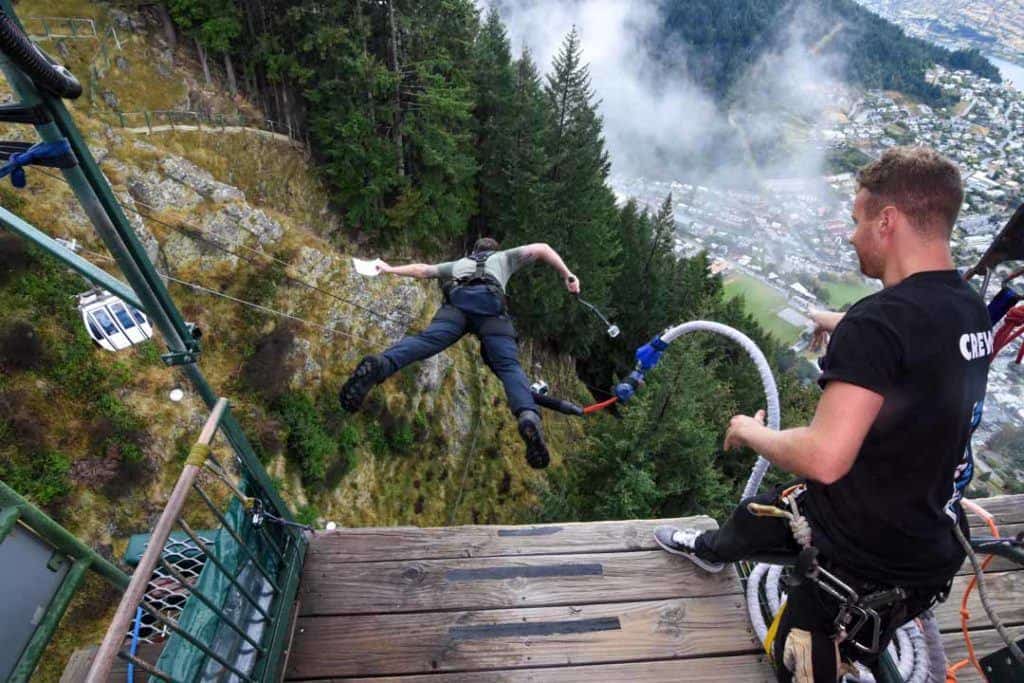
NEW ZEALAND PACKING LIST
We always travel with a core packing list wherever we go. And when it comes to New Zealand, many factors will affect what else you need to bring along with you.
Check out our travel essentials and be sure to add any of the other additional items listed below.
STAYING SAFE IN NEW ZEALAND
Generally speaking, New Zealand is very safe. That being said, you still need to take sensible precautions to keep yourself safe as you would do in your home country.
If you are heading out on multi-day hikes make sure you inform somebody. You’re best off informing you accommodation, however, they may directly ask you to register elsewhere.
This will differ depending on the hike and the region of the country you’re in.
Generally driving is very safe. The majority of road users are courteous and follow the rules of the road.
However, as mentioned earlier, New Zealand’s road criss-cross a variety of environments meaning that roads can be very narrow, steep and winding along the contours of the landscape.
Therefore make sure you are driving at a speed that you are comfortable with and follow the rules of the road.
New Zealand is blessed with many stunning beaches. However, make sure you pay attention to any beaches that are advising against swimming due to currents.
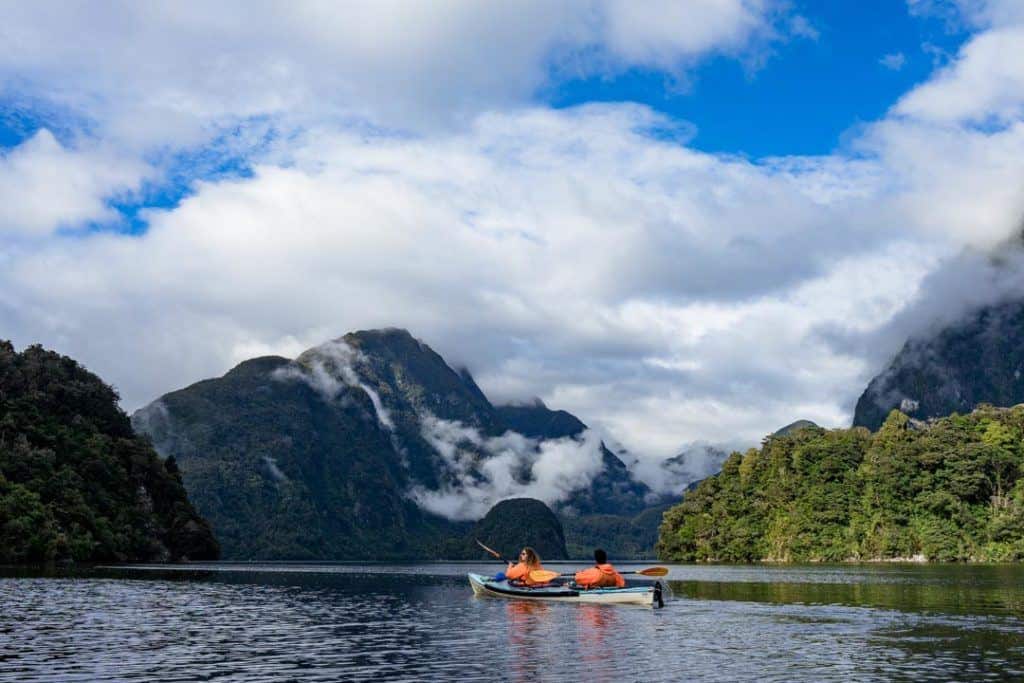
STAYING CONNECTED IN NEW ZEALAND
Staying connected in New Zealand can be challenging. But it has never easier as the country becomes more and more popular for travellers.
We feel like your money will go a lot further if you consider a few other options.
Purchase a SIM Card
Travel sims can be picked up anywhere in New Zealand. There are usually a variety of deals on offer. However, don’t expect the same kind of data packages you get in Europe, the Far East or the US.
With some companies, you can get free data when in the vicinity of one of their phone boxes.
Access Free WiFI
The vast majority of holiday parks and campsites have wifi. However, outside of major towns and cities, there is often a limit on the amount of data that you can use, as little 250 MB in some cases.
Unsurprisingly wifi connections can be patchy in more rural locations, with the South Island having a noticeable poorer wifi service in comparison to the North Island.
Hotels and guesthouses don’t suffer the same wifi issues and don’t have limits of the amount of data you can use. Generally, the speed is reasonable, much faster than what is available in holiday parks.
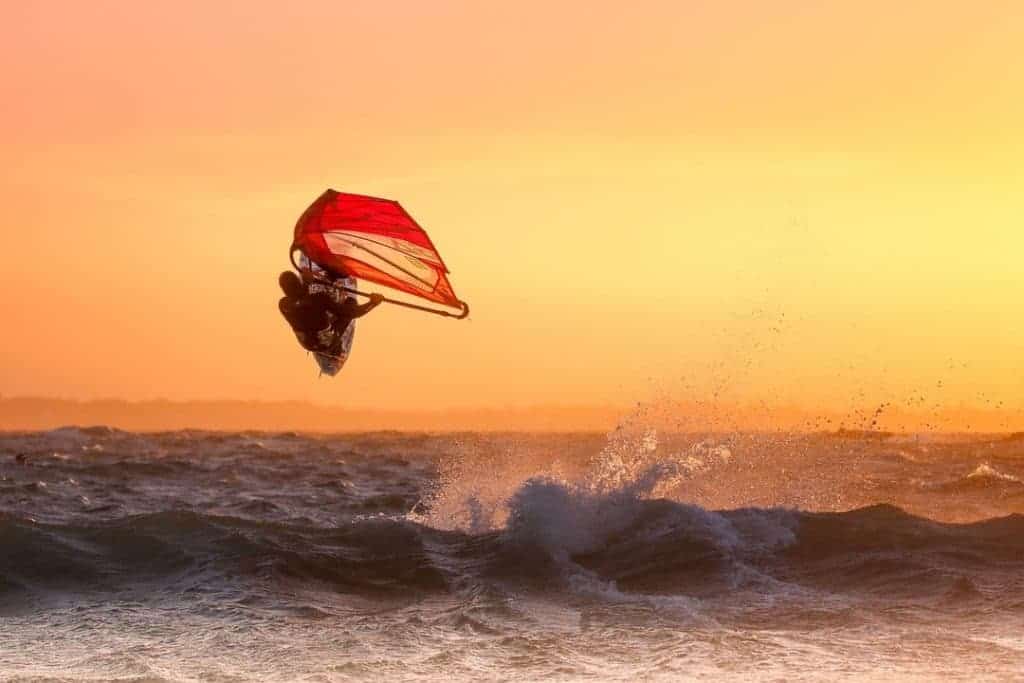
BE A RESPONSIBLE TRAVELER IN NEW ZEALAND
In recent years tourism numbers to New Zealand have surged. Whilst this has brought economic opportunity up and down the country, it has also lead to a number of challenges.
The first of these is freedom camping. In years gone by you could freedom camp almost anywhere with the expectations that people would follow basic rules such as cleaning up after yourself.
Sadly, however, these rules have been changed and you can now only freedom camp in designated spots and only if you have a self-contained vehicle in many cases.
Being a responsible traveller means following the rules with regards to freedom camping.
New Zealand is pristine. A large part of this is due to the lack of trash bins. You are expected to leave nothing but footprints.
It’s a simple and easy rule to follow. Make sure you keep New Zealand beautiful for everyone else that has the pleasure of visiting.
New Zealand is also home to a wide variety of wildlife with strict rules on interacting with them.
For example, a few of the basics are not feeding kea’s (the worlds only alpine parrot), staying a safe distance from seals whilst they are on land and not following the little blue penguins in Omaru.
Many roads in New Zealand are single lane and are particularly windy and can be challenging if you are driving a large campervan.
Be sure to observe all road rules and drive sensibly.
BOOKS TO READ ABOUT NEW ZEALAND
Maybe you already know everything about New Zealand. Chances are you don’t!
But even if you are well-read, here are a few suggestions that might be worth your time while you’re on the plane to New Zealand.
Pounamu Pounamu (Witi Ihimaera) – A look at what it is like to be a New Zealander from the Maori perspective from one of New Zealand’s first and most respected writers of Maori culture, tradition and storytelling. Buy it online here .
The Penguin History of New Zealand (Michael King) – The well-rounded historical story of the settling and advancement of New Zealand from one of New Zealand’s leading historians. You can find it here .
Squashed Possums: Off the Beaten Path in New Zealand (Jonathan Tindale) – An fun story of vagabond life in New Zealand from a man who lived in a wandering caravan and had some of the most peculiar encounters across the country. Check prices on Amazon .
Straying From the Flock: Travels in New Zealand (Alexander Elder) – The memoir of a New Zealand traveller as told through 50 chapters, each reflecting one day of adventure in the wild country. Buy it online .
CHECK OUT ALL OF OUR NEW ZEALAND BLOG POSTS
Whanganui journey in new zealand – the ultimate guide [2024], the ultimate guide to new zealand’s south island in winter, 5 best adventure activities in taranaki, new zealand, 17 awesome things to do in wanaka (epic 2024 guide), 22 cool things to do in wellington, new zealand (2024 edition), 18 awesome things to do in christchurch (2024 guide), the ultimate guide to hiking in new zealand (2024), 13 amazing things to do in franz josef (2024 guide), 3 days kayaking in abel tasman (everything you need to know), 8 amazing things to do in rotorua, new zealand, the most epic 1, 2 or 3 week new zealand itinerary (2024), the best new zealand road trip itinerary in 2024.
- Search Please fill out this field.
- Manage Your Subscription
- Give a Gift Subscription
- Sweepstakes
- New Zealand Travel Guide Overview: New Zealand Travel Guide
- This Country Is Made Up of 2 Stunning Islands Full of Pristine Beaches and Otherworldly Landscapes
- This New Zealand Town Is an All-season Destination With Epic Skiing, Hiking, and Wineries
- 10 Mistakes to Avoid on Your Trip to New Zealand, According to a Local
- New Zealand Travel Guide This Country Is Made Up of 2 Stunning Islands Full of Pristine Beaches and Otherworldly Landscapes This New Zealand Town Is an All-season Destination With Epic Skiing, Hiking, and Wineries 10 Mistakes to Avoid on Your Trip to New Zealand, According to a Local CLOSE Part of New Zealand Travel Guide
How to Plan the Perfect Trip to New Zealand
See the best places to stay, dine, and experience the beauty of New Zealand, according to a local.
Amy Louise Bailey is a freelance content creator and media specialist. Her work has been published in Vogue , Harper’s Bazaar , Elle , Condé Nast Traveler, Bloomberg Pursuits , and Robb Report .
Bay of Islands
Christchurch, best times to visit new zealand, how to get there, transportation.
Tessa Desjardins/Travel + Leisure
When people learn I’m from New Zealand , I often hear that it’s at the top of their bucket list — or, if they’ve been, that it’s their favorite country in the world. I may be biased, but I am not surprised. The stunning natural beauty, thriving culinary scene, and unique outdoor activities would charm even the most seasoned traveler.
Everywhere you look, there’s a picture-perfect backdrop filled with greenery and crystal-clear waters. And although it has a lot of untouched land, it boasts the same highlights you would find in any major global city, with art galleries, shopping districts, nightlife, and luxury hotels. Plus, it’s politically stable and very safe, which are increasingly appealing traits.
Geographically, the country is divided into two islands with distinct characteristics: the North Island is full of beaches and is home to the main cities, and the South Island is an alpine wonderland, defined by majestic mountain landscapes, rugged coasts, and world-class ski slopes. There has been a lot of development over the past few years, and travelers have more places to eat, stay, and play than ever before. Below, see Travel + Leisure ’s essential guide to making the most of this magical South Pacific destination, according to a local.
Angelina Pilarinos/Travel + Leisure
North Island
The North Island is lined with beautiful beaches and islands surrounding the narrow coasts. It’s also where the capital, Wellington, is located, along with the country’s largest and most cosmopolitan city, Auckland , which is an essential destination on any New Zealand itinerary (and the gateway for most international flights). As Annie Dundas, head of the visitor economy for Auckland Unlimited notes, Auckland is “an urban oasis — the perfect fusion of a busy, modern city that looks out to mesmerizing landscapes and islands — all within easy reach and laden with wineries and leisurely places for long lunches.” It is worth spending at least four days in Auckland, but the North Island has many unique areas to explore, and below, we’ve charted the key destinations to prioritize.
Things to Do
Waiheke Island
Waiheke Island is a popular day trip for locals and is accessible by boat, ferry, or helicopter from downtown Auckland. It’s filled with boutique wineries, restaurants, and beautiful beaches, and is especially popular in the summer months, when music festivals and jazz concerts are hosted in sprawling vineyards. There’s also a contemporary art sculpture trail, Sculpture on the Gulf , hosted each summer, enticing many Aucklanders across the harbor for a cultured day out. Pop over for the day, tour the wineries, get a scoop of ice cream at Island Gelato Company , and wander around the artisan boutiques. If you’d like to spend the night, there are high-end rentals available on Waiheke Unlimited and Vrbo , or for a hotel, go for Delamore Lodge .
Visit the Auckland Museum and the Auckland Art Gallery
For a close-up view of New Zealand’s culture and history, visit the stately Auckland Museum , where you’ll find a collection of national artifacts along with a rotation of exhibitions. It’s set at the top of the city’s main park and is within walking distance of Auckland CBD, where the Auckland Art Gallery is located. Here you’ll find some of the country’s most valuable artworks along with various international collections. Both are worthwhile attractions that can be ticked off in half a day.
Explore Commercial Bay and Britomart
Downtown Auckland has been transformed over the past decade and has become the city’s most vibrant shopping and dining hub. It’s bustling from day to night and is especially packed on Friday nights for after-work drinks and dinner. You can find some of the city’s best restaurants and cocktail bars within a small vicinity, and it’s a fashion mecca, with storefronts from major brands and local fashion designers (be sure to check out Karen Walker , Kate Sylvester , and Zambesi ).
Courtesy of Park Hyatt Auckland
Park Hyatt Auckland
Since opening in 2020, the Park Hyatt has become the crème de la crème of the Auckland hotel scene. It has a prime location, excellent views, amenities, restaurants, and spacious rooms with freestanding bathtubs and terraces overlooking the Viaduct Harbor — ideal for room service with some atmosphere. It’s within walking distance of the best bars, restaurants, and shops, but it feels like a serene enclave where you can manage to get a good night’s sleep, despite being right by the action.
The Hotel Britomart
As the name suggests, this chic hotel is located right in the heart of Britomart, surrounded by some of Auckland’s best shopping and dining. Rooms are sleek and modern yet very small, so are suitable for solo travelers and couples. If you’re seeking something more spacious, the suites are some of the finest in the city (with price tags to match). And the restaurant, Kingi, is also excellent.
Sofitel Auckland Viaduct Harbor
Located between the Viaduct and Wynyard Quarter, the Sofitel has long been a go-to for celebrities and diplomats visiting New Zealand. It boasts the high standards that you would expect from the French hotel brand, with a fine-dining restaurant, elegant interiors, and an impressive spa and wellness center.
Restaurants
For a fun atmosphere and Italian-inspired fare, head to Bivacco in the Viaduct. The menu has sharable classics like pizza, antipasto, pasta, and oysters, and on any given day, you’ll find yourself surrounded by well-heeled locals socializing over bottles of rosé and cocktails.
Soul is a restaurant that has stood the test of time, and for over 20 years, it has been a go-to venue for some of the city’s most stylish soirees. Like Bivacco, it’s also a lively spot in the heart of the Viaduct, where people go for the food as well as the scene. After dinner, there’s a dance floor that attracts a mature crowd, and on the menus you’ll find fresh seafood and bistro classics alongside an extensive wine and Champagne list.
While it’s not the newest or the sceniest place, Prego has been a solid option along Ponsonby Road for years and is just as popular with families as it is for birthday celebrations and dinners preceding big nights out at the bars along the strip. Go for the pizza or the chicken saltimbocca — everything on the menu is great as are the cocktails. Always a reliable destination for a good atmosphere and delicious food.
Museum of New Zealand Te Papa Tongarewa
Known locally as Te Papa , the country’s largest museum is an essential on any Wellington itinerary. It contains over 800,000 artworks and objects, and it has a rotation of exhibitions including dinosaur skeletons and ancient artifacts that you would expect to find at the American Museum of Natural History. It’s an interesting experience for children and adults alike.
Ride the Wellington Cable Car
For panoramic views of the city, jump on the historic Wellington Cable Car , which boards in the heart of the Lambton Quay shopping district and travels up the hillside of Kelburn. Here you will find a scenic lookout, botanic gardens, and the Cable Car Museum .
Wander Hannahs Laneway
Also known as Leeds Street, Hannah’s Laneway is a foodie’s paradise, lined with street food vendors, contemporary art, and cool cafes. You can pick up a variety of distinctly "Kiwi" specialties, from black forest toast to pies and creamy hot chocolates. Just be sure to skip breakfast so you have room to sample everything.
QT Wellington
This centrally located hotel could be equated to the likes of The Standard and Edition Hotels, with quirky, ultramodern design and a lively food and beverage scene. It’s right across from the Te Papa Museum in the center of town and is popular with both business and leisure travelers. There are 65 hotel rooms with either city or harbor views, and it also has 98 apartments.
Wharekauhau Country Estate
Although it’s a 90-minute drive from Wellington, this luxury lodge is a popular stop on any Wellington itinerary. It’s set on a 5,000-acre estate overlooking the coast and has welcomed the royal family and many international diplomats visiting the capital. Everything is designed so that you don’t need to leave: food is included and sourced from the farm, it has a spa and fitness center, and a variety of outdoor activities from ATV quad biking to tennis.
You will need to book a month in advance to secure a table at this intimate prix-fixe restaurant. The menu is seasonal and it changes every day, so there’s always something new. A typical night might feature lamb manti, panfried snapper, and crisp meringue — delicious renditions of local New Zealand cuisine.
Located on the nightlife-centric Cuba Street, Loretta is a place to enjoy crowd-pleasing classics in a fun environment. It’s renowned for its sourdough pizzas and vanilla cheesecakes and is a great place to go with friends before a night out or for brunch on a Sunday.
Ortega Fish Shack
This nautical-themed restaurant has some of the best seafood around, from Yellowtail Kingfish ceviche to smoked Moki rillettes and green lipped mussels. It’s a charming and eclectic place that perfectly represents the hip, creative vibe of Wellington.
Sculptureum
Sculptureum is a lovely and cultured place to spend an afternoon, with six art galleries, three sculpture gardens, a vineyard, and a restaurant appropriately named Rothko. Whether you’re staying in the area or doing a day trip up from Auckland, it’s an essential for contemporary art lovers and is especially great to visit in the summer months.
Matakana Village Farmers Market
Every weekend, Matakana Village comes alive with rustic markets featuring a variety of artisan food stands and fresh local produce. You’ll find delicious local cheese, honey, baked goods, chocolate, and award-winning flat whites. It’s set up right next to the boutiques in the charming village, where you’ll find everything from quaint homeware stores to shoe shops, and there’s also a cinema and a restaurant within the main village complex.
Omaha Beach
The Rodney District has some of the most stunning beaches on the North Island, and one of the most popular among them is Omaha — a white sand beach that attracts swimmers, surfers, and families setting up for the day. It’s only a 10-minute drive from Matakana Village, and it has ample parking, a café, a boutique with swim essentials, and a playground. For bigger waves, surfers head to Tawharanui Beach , which is also located within the Matakana region.
Takatu Lodge
This gorgeous boutique lodge is located on a serene hilltop overlooking the Hauraki Gulf. It has only four suites with luxurious furnishings, underfloor heating, and views overlooking the gardens and the vineyards. Meals are provided in the dining spaces and tailored to guests’ preferences. Also, picnics are on offer for those wanting to set up at the nearby beaches for the day.
Courtesy of Brick Bay
Brick Bay is a similar concept to Sculptureum, with a restaurant, wine tastings, and a contemporary sculpture trail positioned around a pond and throughout a native bush. It’s been around for a long time and is very popular with both locals and Aucklanders, so it’s worth booking in advance, even if it’s just to sample their wine varietals over a cheese platter after the lunchtime rush.
Cruise the Islands
The Bay of Islands has 144 subtropical islands, and there are many ways to explore them, be it by chartering a yacht, going on a scheduled group boat tour, hiring a kayak, or embarking of a snorkeling expedition. You can see an abundance of enchanting sea life, too, including dolphins, penguins, and whales.
Visit the Waitangi Treaty grounds
The Waitangi Treaty Grounds is New Zealand’s most important historic site, where the country’s founding document was signed back in 1840. Today, it contains two museums with interactive displays, guided tours to learn about the country’s history, and traditional Maori cultural performances that are staged in the meeting house.
Kauri Cliffs
Kauri Cliffs was recently added to the Rosewood portfolio, which is testament to its high standards. It’s one of New Zealand’s most iconic luxury lodges, with a golf course that is ranked 37th on Golf Digest ’s Top 100 Greatest Golf Courses in the World, an excellent restaurant, and a fabulous spa nestled into a tranquil forest full of native birdlife.
Eagle’s Nest
Positioned on a private 75-acre peninsula overlooking the Bay of Islands, Eagle’s Nest is one of New Zealand’s most luxurious boutique retreats. It is an intimate enclave, with only five villas that are beautifully designed. One thing to note is that there is no restaurant, however breakfast provisions are provided and there are on-call chefs available for private dining.
Duke of Marlborough
The Duke of Marlborough is New Zealand’s first pub, and since opening in 1827 (before the Treaty of Waitangi was signed nearby), it has undergone various reincarnations. Visit today and you’ll find a refined version of a classic pub, with décor that feels fresh while honoring its history. Menus feature locally sourced, seasonal fare with popular items like paua risotto, clam fritters, pork belly, and of course, a solid burger.
Taylor McIntyre/Travel + Leisure
South Island
The South Island is renowned for its spectacular natural scenery from the golden beaches of the Abel Tasman to the fiords and mountains in the Southern Alps. The vibe is generally more casual, and it’s where many of the country’s best adventure activities can be experienced. In Wanaka and Queenstown , you’ll find pristine ski slopes, dramatic mountain landscapes, and an array of sprawling wineries. It’s also home to many of New Zealand’s Great Walks and multi-day hikes. There are many beautiful places to explore, and as Sarah Handley, Tourism New Zealand's general manager for the Americas and Europe notes, “New Zealand's connection to the U.S. has never been stronger, and Americans can now fly non-stop to Christchurch, in the South Island, with United's direct service from SFO [starting Dec. 8].”
Americans can now fly non-stop to Christchurch, on New Zealand's South Island, with United Airlines' direct service from San Francisco (SFO) starting Dec. 8.
Over the Top Helicopter Tour
For a true bucket list experience, take a helicopter ride and tour through the Southern Alps and the Milford Sound. It’s the most magical way to see everything, and experience areas that are usually inaccessible, like the secluded Madagascar Beach and snow-capped, sky-high peaks. The "eurocopters" are state of the art, with maximum visibility from any vantage point. They can be booked privately or as part of scheduled group tours.
JensenChua/Getty Images
TSS Earnslaw Cruise
Renowned as "the Lady of the Lake," the Earnslaw is a 110-year-old steamboat that tours Lake Wakatipu from Queenstown down to Glenorchy. It’s one of the best ways to observe the natural grandeur of the Remarkables and Cecil Peak and is a particularly popular activity for families. The cruise itself take 90 minutes, but there are various experiences that can be added on arrival at Walter Peak High Country Farm, including horse treks, cycling, or barbecues.
Arrowtown is a historic gold-mining town that looks like a village out of a fairy tale. Everything has been lovingly preserved and it is lined with quaint artisan boutiques, galleries, cafes, and restaurants. It’s only a 20-minute drive from Queenstown, and on the way, you could stop at Millbrook Resort for a round of golf or a spa session (just outside of the main village). Be sure to stop at The Remarkable Sweet Shop for the crème brulee fudge.
Eichardt’s Private Hotel
Eichardt’s an iconic Queenstown establishment and one of the most beloved boutique hotels in the country. It has an exceptional cocktail bar, restaurant, and a spa, along with a $20,000-per-night penthouse located above the Louis Vuitton boutique next door. The location could not be better, positioned right on the shores of Lake Wakatipu in the center of the action. Inside the rooms, the interiors are ultra-luxurious and suited to the alpine theme of the town — think crackling fireplaces, marble bathrooms with underfloor heating, and plush beds with fur throws.
Matakauri Lodge
Matakauri Lodge is another property that was recently added to Rosewood’s portfolio (along with Kauri Cliffs and Cape Kidnappers in the Hawkes Bay) and is a key destination on New Zealand’s luxury circuit, hosting the British royal family and many celebrities over the years. The intimate lakeside retreat has only 13 spacious accommodations and it boasts stunning views of the Remarkables and Lake Wakatipu. Cocktail hour is a social affair, and the food and wine offerings are world class.
The Carlin is new, but it’s already garnered international acclaim, winning Best New Hotel at the Boutique Hotel Awards in 2022. It’s a place that would have "Palace" distinction if it were in France, with ultra-luxe amenities that surpass the typical five-star standard. Guests have access to private jets and Michelin-star dining, and it is home to the largest penthouse in the Southern Hemisphere.
Located just a 15-minute drive from the city center, Amisfield is the most popular winery and restaurant in the region and is an essential daytime excursion for any Queenstown itinerary. Wine tastings are available, and there are excellent Pinot Noirs produced on site. But to make the most of it, do an al fresco lunch in the beautifully manicured courtyard and take in the views of the postcard-worthy mountains.
Botswana Butchery
This lively lakefront bistro is one to book in advance, particularly if you’re visiting on a weekend. It has a charming atmosphere and some of the best representations of hearty New Zealand cuisine sourced from the surrounding farms and waters. It also has an excellent wine list with varietals from vineyards in the area.
You will need to time your visit to Fergburger well, as the lines can often exceed an hour in the evenings, but it has the best burgers in Queenstown (and anywhere, really) and is worth factoring in. There is a long menu of options to suit everyone including vegetarian options, beef, lamb, pork, fish, chicken, and also breakfast burgers. The same operators also opened Fergbaker next door where you can pick up a classic meat pie — both delicious options, especially on a cold and snowy day.
Blanket Bay
Glenorchy is very remote, and what to do, where to stay, and where to dine all fall under the same category if you want to do it well. The place to go? Blanket Bay, where apocalypse-weary billionaires are known to escape. It is one of the country’s finest luxury lodges and is the best way to experience all the area has to offer, with an excellent restaurant, bar, spa and wellness center, and a variety of outdoor activities from horse riding to heliskiing and jet boating. Accommodations are split between rooms in the main house and luxuriously decorated standalone villas.
Aoraki Mackenzie International Dark Sky Reserve
Located in the Mt. Cook National Park, the Aoraki Mackenzie International Dark Sky Reserve has some of the clearest and darkest skies for star-spotting. It was the first Dark Sky Reserve to be established in New Zealand, and is a magical way to experience the country’s untouched natural beauty by night.
Explore the City’s Art Galleries
Christchurch has a thriving art scene and many galleries in the central city that are worth checking out. The main ones to prioritize are the Centre of Contemporary Art (CoCa) , Christchurch Art Gallery Te Puna o Waiwhetu , and the Christchurch Art Centre .
The Mayfair
Since opening in 2022, The Mayfair has been a welcome addition to the city’s luxury hotel scene. It’s a boutique hotel with minimal, contemporary décor, and sophisticated dining options from high tea to an all-day café and cocktail bar and bistro. The central location makes it popular for both leisure and business travelers.
The Observatory Hotel
The Observatory is a chic, design-forward boutique hotel that also opened in Christchurch in 2022. It has rich interiors that give the sense of eternal night, with vivid colors and ambient lighting. Rooms are very photogenic, and there are multiple dining options from the Drawing Room to all-day eatery Bunsen, and more casual options within the broader complex, from food trucks to sushi and dumplings.
Inati is a stylish fine dining establishment helmed by the former head chef of Gordon Ramsay’s The Warrington. If there’s one place to book in advance in Christchurch, this is it. The menu is filled with sharing plates and is divided into earth, land, and sea categories. Guests can park up at elegant stools overlooking the open kitchen and observe their food being artfully crafted.
If you want to experience the great outdoors (which is the primary drawcard), the best time to visit is over the summer, between December and the beginning of April. During this period, temperatures are balmy and you’re more likely to encounter solid blocks of sunshine. It’s also when the cities come alive, with many music festivals and cultural events, and is the best time to explore the beaches, wineries, and stunning walking tracks. That said, New Zealand is a great place to visit year-round, and it is also a world-renowned ski destination with ski resorts throughout the North and South Island. If you’re looking to ski, the months to consider would be between June and October, when the fields are open.
Fiona Goodall/Getty Images
The best way to get to New Zealand is to fly into Auckland Airport, which is the country’s primary gateway. Air New Zealand has multiple routes available, including a direct flight from New York City, which takes 17 hours but is surprisingly manageable, given it flies overnight (and the airline is renowned for its excellent cuisine and high standard overall). United Airlines is launching a direct flight from San Francisco's SFO in December, and Qantas also has a route from New York to Auckland.
Once you arrive at the airport, there are taxis and rideshare services available, including Uber, but given everything is quite spread out, it is definitely worth renting a car. That will allow you to easily explore all of the different areas (some of which don’t have regular public transport options available). Driving is also a great way to visit some of the more remote beaches and destinations off the beaten path. If you’re planning on staying in the city centers, there are buses available, trains (albeit with limited routes), and ferries.
New Zealand Travel Guide
Nomadic Matt's Travel Site
Travel Better, Cheaper, Longer
New Zealand Travel Guide
Last Updated: April 1, 2024
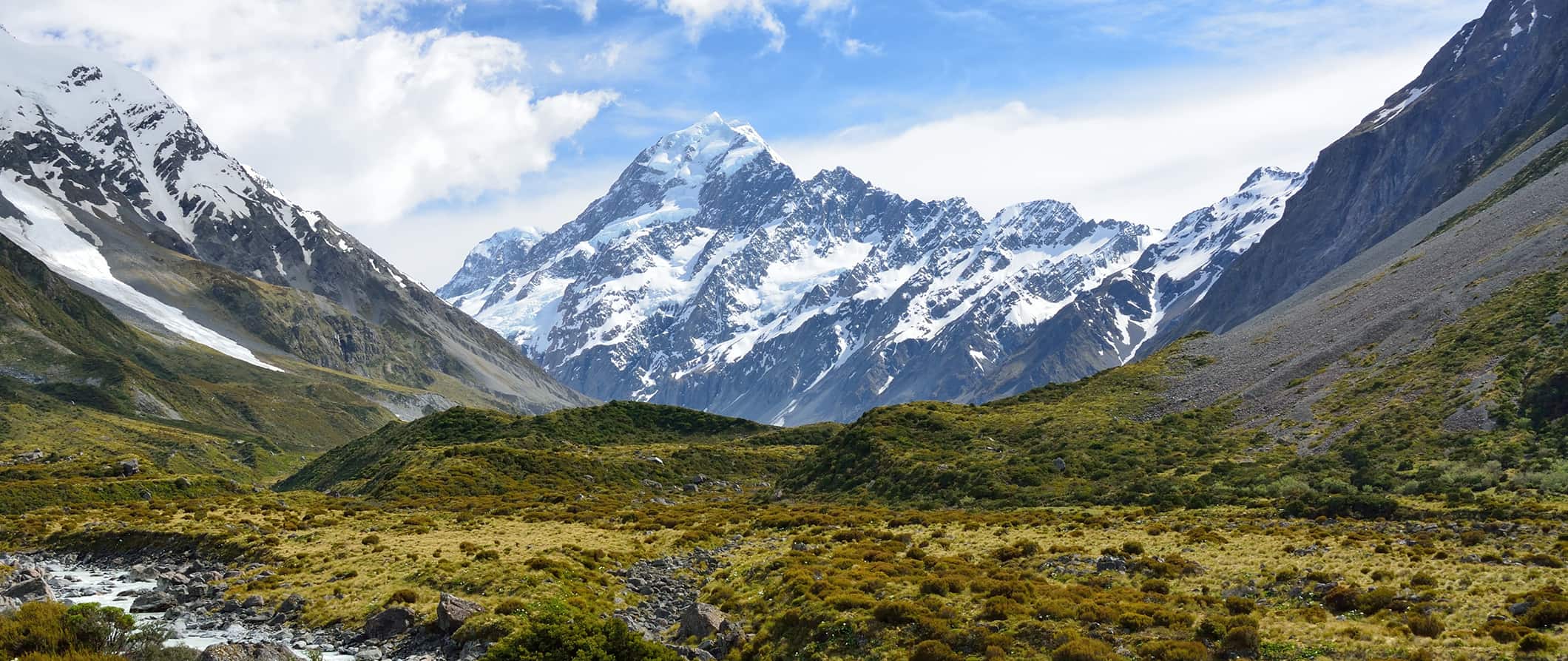
Backpacking through New Zealand is one of the most popular activities in the world, with thousands of people making their way there on their round-the-world trip (backpackers sweep up those working holiday visas!).
Whether you’re a backpacker, budget traveler, or want to splurge a bit more, New Zealand won’t let you down. I’ve loved all my visits to New Zealand. The people are friendly, the country is beyond beautiful, the wine is cheap, the people are friendly, and you meet a lot of travelers. It’s one of the best countries in the world. I’ve never heard anyone not love their time in the country. You will leave here wanting to come back.
And, fortunately, as the land of backpackers, budget travel in New Zealand is easy to do if you know a few tips and tricks on how to save money. It won’t be dirt cheap, but it doesn’t have to break the bank either.
Use this New Zealand travel guide to plan your trip, save money, and make the most of your time in this incredible destination.
Table of Contents
- Things to See and Do
- Typical Costs
- Suggested Budget
- Money-Saving Tips
- Where to Stay
- How to Get Around
- How to Stay Safe
- Best Places to Book Your Trip
- Related Blogs on New Zealand
Click Here for City Guides
Top 5 things to see and do in new zealand.
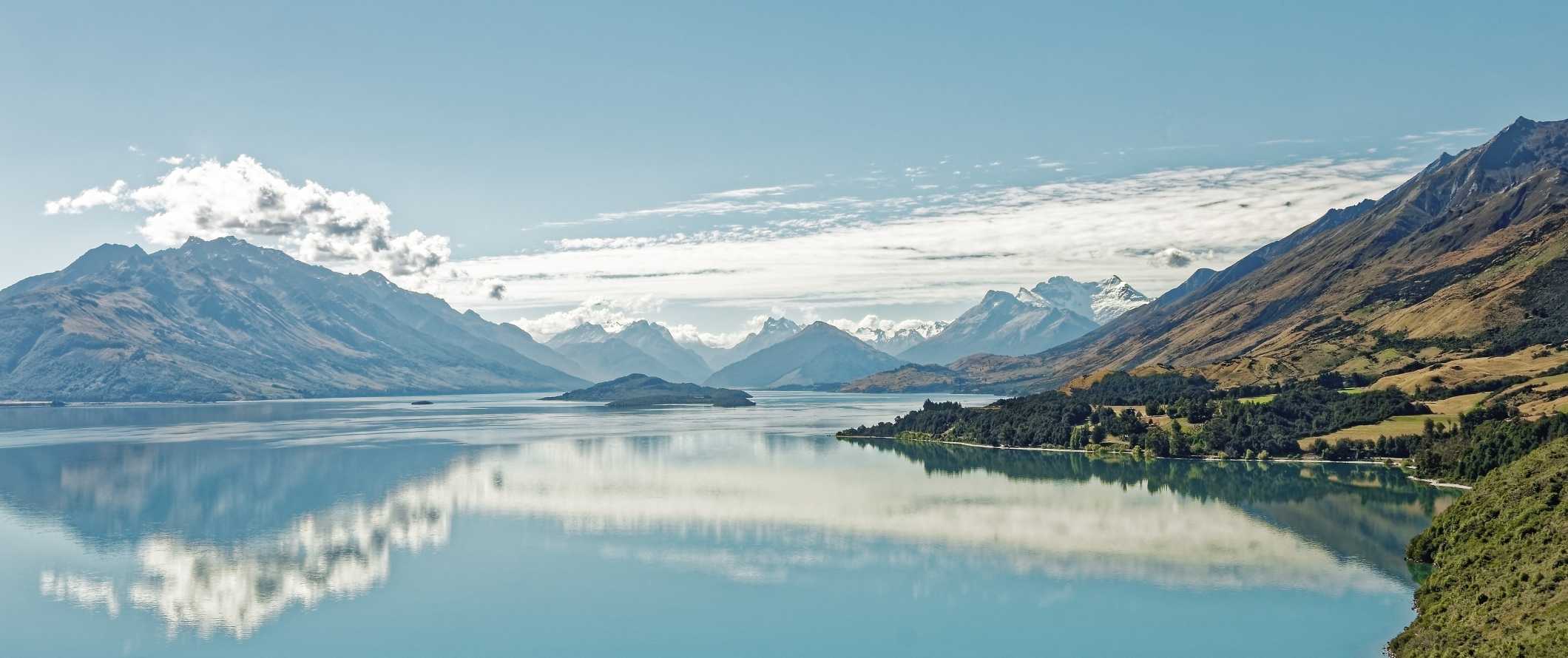
1. Explore Fiordland
Fiordland National Park , located in the southwest of New Zealand’s South Island, is home to Doubtful Sound and Milford Sound. You can walk the forest trail along the sandy Milford shore for perfect views of Mitre Peak, or take the Chasm Walk on the Cleddau River to get close to powerful waterfalls. The are also several multi-day hikes here, including the 4-5 day Milford Track, as well as all kinds of scenic flights and cruises. A wilderness cruise of Doubtful Sound costs 199 NZD.
2. Heli-hike Franz Josef Glacier
Heli-hiking this glacier is amazing. With a heli-hike, you take a scenic helicopter flight over the glacier and then land in remote areas where you can explore on foot. Although the 2-3 hour hike is grueling, many tour providers also throw in a complimentary soak in the Hot Pools at the end. Expect to pay around 485 NZD for a heli-hike. It’s not cheap, but I personally thought it was completely worth the cost. You can also just do a scenic flight with Glacier Helicopters for 360 NZD.
3. Relax in the Bay of Islands
North of Auckland, this area has some of the best opportunities for dolphin and whale watching, relaxing on the beach, swimming, boating, and eating seafood. The area is very low-key and is a popular summer and weekend getaway destination for Aucklanders. The Waitangi Treaty Grounds, one of the most important historical sites in the country, is also located here. It’s where the British and Maori signed what is considered the founding document of modern New Zealand. Today, there are two interactive and interesting museums here as well as Maori cultural performances you can attend.
4. See the Waitomo Glowworm Caves
Explore these incredible caves in sheer darkness with nothing but the glow of glowworms to guide your way. It’s an exciting activity as you float down rivers and jump over waterfalls and watch the “starry sky” in the cave. You can also tube and abseil (rappel) through the caves, too. Expect to pay around 55 NZD for the classic 45-minute cave tour and 265 for five-hour tours with abseiling. You can save money overall by purchasing combo tickets (if you want to visit multiple caves or do various tours), or by going on weekdays when you get 20% off.
5. Hike the Tongariro Alpine Crossing
Other things to see and do in new zealand, 1. try bungy jumping.
A.J. Hackett, a Kiwi, popularized the modern activity of bungy jumping when he (illegally) jumped off the Eiffel Tower in 1987. Today, bungy jumping is hugely popular around the world, but especially in its country of origin. Any adrenaline seeker worth their salt will do the 134-meter (440-foot) Nevis Bungy Jump outside of Queenstown. If that’s too high, there are smaller ones in Auckland and Queenstown. The price of adventure isn’t cheap, however, with a single jump at Nevis costing 275 NZD.
2. Go skydiving
Another popular adventure activity in New Zealand is skydiving. The best place for this is over Lake Taupo . It provides a stunning backdrop as you plunge to Earth from high above. Taupo Tandem Skydiving offers jumps from 12,000-18,000 feet starting at 279 NZD. You can also take a full-day course to learn how to skydive on your own for 499 NZD. Franz Josef and Lake Wanaka are also popular spots for skydiving as well.
3. Visit Abel Tasman National Park
Located on the South Island, this national park looks like something you’d find in Asia, with its turquoise blue water, dense jungles, and warm temperatures. There are many multi-day hiking trails and beautiful sea kayaking throughout the park. It’s also home to one of the 9 Great Walks of New Zealand, the 60-kilometer (37-mile) Abel Tasman Coastal Wal. Entry is free, though you need to pay 16-24 NZD for a campsite if you plan on staying overnight. Huts are also available for 26-52 NZD per night. Accommodation prices vary depending on the time of year. You can also take a scenic cruise around the park with Abel Tasman Sea Shuttles for 79 NZD.
4. Hang out in Wellington
I found New Zealand’s capital to be the most “artsy” city in New Zealand. There’s great architecture, character, fantastic nightlife, restaurants, and cultural activities. Tour the Beehive (where Parliament meets), ride the cable car for epic views over the city, visit the award-winning Wellington Museum and Museum of New Zealand Te Papa Tongarewa, or learn how to make movie-quality armor at Weta Workshop (the special effects studio behind Lord of the Rings , District 9 , Avatar , and many others). You can also leave the city for a wine tour of the Martinborough wine region (149 NZD). There are so many cultural activities to do here so don’t be like other travelers and rush through — it’s worth a few days!
5. Go dolphin and whale watching
Whether you go from the Bay of Islands, Auckland, or somewhere on the South Island, the country is within the migratory route for many of these creatures and you’re bound to see lots of them no matter when you go (though October-March is the best time). Sperm whales, orcas, and humpback whales all call the region home. Boat tours last around 4 hours and cost 135-160 NZD per person.
6. Hit the slopes
During the winter months, the South Island (especially the area around Queenstown and Wanaka) has snow-covered mountains that offer some of the best skiing in the southern hemisphere. Prices vary depending on where you go, how you get there, what equipment you rent, and how long you go for, but expect to pay around 105-140 NZD for a lift pass.
7. Unwind in Rotorua
Located on the North Island, Rotorua is famous for its Maori cultural shows and for its sulfur smell (which comes from the geothermal activity in the area). All around the city are sulfur mud pits that give the city a unique odor. But the upside is that there are a ton of thermal spas in the area to relax in! Also, don’t miss the New Zealand Maori Arts and Crafts Institute which has all kinds of traditional Maori arts and crafts.
8. Get outdoors in Kaikoura
This is a coastal town several miles north of Christchurch . It is set on a peninsula, which makes it an awesome place to enjoy the mountain scenery while searching for whales and dolphins. Whale Watch Kaikoura is the best company to go whale-watching with here. They are a Maori-owned tour company that guarantees you see at least one whale on your trip (otherwise they refund you 80% of the cost). Additionally, there is an interesting museum, a handful of historical sights, and the Maori Leap limestone cave to see while you’re here.
9. Explore Wellington Botanic Gardens
Of all the beautiful gardens throughout the country, this is perhaps the most popular. There is a vast native forest, an international plant collection, a rose garden, and a landscaped area — complete with a duck pond, sculptures, a playground, and a cafe. Created in 1868, the park spans a massive 25 hectares (60 acres) and makes for a great place to stroll or relax with a book. Admission is free.
10. Ride the Christchurch gondola
If you are in Christchurch, take the gondola ride up Mount Vaendish. The ride is 10 minutes and offers the best views of the city. There is a restaurant at the top if you want to grab a bite to eat while you enjoy the scenery too. Most people walk back down (you can also walk up if you don’t mind the exercise; it takes around 45 minutes). Tickets are 35 NZD (round trip). Wellington and Queenstown also have gondolas for views over these cities as well.
11. Enjoy Queenstown
The action capital of the country, Queenstown is one of the most fun cities I’ve ever visited. There are a lot of outdoor activities and sports (bungy jumping is the most popular) to do in the area, amazing restaurants, and the best nightlife in New Zealand. Everyone who comes ends up staying longer than planned. Don’t skip Fergburger either — they have the best burgers in the country!
12. Watch a Maori cultural show
The Maori are the indigenous people who came to New Zealand from Polynesia in the 14th century. Getting to know Maori culture is important to understanding life in this country. Maori make up about 16% of the country’s population and you’ll see Maori symbols and words throughout the country as you travel. See a Maori cultural show while you are here to get a better understanding of their culture and history. The most popular shows are in Rotorua and cost 150-245 NZD per person (most are 3-4 hours and include a meal).
13. Explore Milford Sound
Milford Sound is such an amazing fjord it deserves its own mention. Located in Fiordland, Milford Sound is best known for the towering Mitre Peak and its surrounding rainforest environments. Waterfalls like Stirling Falls and Bowen Falls cascade down the mountainsides, and the fjord itself is home to seal and penguin colonies. You can often see pods of dolphins frolicking in the waters too. Explore by boat, and check out the Milford Discovery Centre and Underwater Observatory to see rare black coral and other underwater life. Cruises start from 59 NZD.
14. Visit Wanaka
Wanaka is a ski and summer resort town on New Zealand’s South Island, set on Wanaka Lake and framed by snowcapped mountains. From here you can explore the Southern Alps’ Mount Aspiring National Park, with its many glaciers, beech forests, and alpine lakes. Wanaka Lake itself is perfect for boating enthusiasts, including jet boaters, sailors, and kayakers. If you’re a skier or snowboarder, you’ll want to check out the Treble Cone and Cardrona ski resorts nearby. For some quirky fun, go to Puzzling World just outside town. It’s an outdoor maze and sculpture gallery that’s good for a laugh!
15. Travel to Hobbiton
Journey to Middle Earth with a visit to the Hobbiton movie set featured in The Lord of the Rings and The Hobbit movies. This is easily one of New Zealand’s most famous activities, so you can expect crowds. To see Hobbiton, you’ll have to take a tour. It starts with a drive through the owner’s 505-hectare (1,250-acre) sheep farm with some epic views over the Kaimai Ranges. From here, you can explore Bag End, wander around the hobbit holes, and visit the Green Dragon Inn. If you’re a LOTR fan, you can’t pass this up. Tours start at 89 NZD.
16. Visit Stewart Island
Stewart Island is located 30 kilometers (19 miles) south of the South Island. Over 85% of the island is National Park (Rakiura National Park to be exact), and most people come here for hiking and birdwatching. The island has just 28 kilometers (17 miles) of road, but 280 kilometers (175 miles) of walking tracks suited to short walks, day hikes, and multi-day excursions. Walk the three-day Rakiura Track for the full experience of Stewart Island’s natural beauty. Offshore, on Ulva Island, you’ll find a predator-free bird sanctuary with dozens of native species. Getting to Stewart Island means you’ll need to take a ferry or flight. Ferries take one hour and cost 89 NZD while flights from Invercargill take 15 minutes and cost 230 NZD return.
17. Relax on a scenic rail journey
New Zealand’s challenging landscapes demanded some remarkable feats of early railway engineers. While their rail network isn’t vast, thanks to their skill and determination, there are some incredible rail journeys on offer. Travel through remote national parks, along beautiful coastlines, and over rugged volcanic landscapes. The routes are the Northern Explorer, Coastal Pacific, and TranzAlpine. I took the TransAlpine and loved every minute of it. You pass rivers, mountains, cross gorges, and vibrant green farmland. It was the highlight of my trip to New Zealand and one of the most peaceful experiences I had. I can’t recommend it enough. Tickets vary between 169-219 NZD (one-way) depending on the route and how far you go.
18. Take one of the Great Walks
New Zealand has thousands of miles of hiking trails but sitting above them all are the ten Great Walks that journey through the country’s most magnificent places and iconic locations. On the North Island, the Lake Waikaremoana Track takes 3-4 days, leading you through prehistoric rainforests and beautiful wildlife areas. The famous Tongariro Northern Circuit is a challenging 3-4 day excursion where you’ll see active volcanoes, emerald lakes, and epic waterfalls. The South Island has its own unique routes, as well, including the Milford Track, which winds its way through the fjords of Milford Sound. Keep in mind that due to their popularity, Great Walks must be booked in advance (and they can sometimes fill up months ahead of time).
19. Explore wine country
New Zealand’s wine regions extend 1,600 kilometers (1,000 miles) from sub-tropical Northland down to Central Otago, home to the world’s most southerly vineyards. Hawke’s Bay, Martinborough, Marlborough, and Central Otago are signature New Zealand wine regions and home to a number of different vineyards. Smaller wine-producing areas include Auckland, Gisborne, and Waipara. If you’re keen on seeing the best of what Kiwi vineyards have to offer, check out the Classic New Zealand Wine Trail — a wine-tasting adventure through the heart of New Zealand’s grape-growing regions. If you don’t have your own vehicle, there are plenty of bus (and even bicycle) tours available. Half-day small group wine tours generally cost 120-170 NZD, while full-day tours start at 200 NZD.
20. Visit Mount Cook National Park
Aoraki Mount Cook National Park is home to some of the highest mountains and the longest glaciers. Here you’ll find sky-scraping peaks, sweeping glaciers, and permanent snowfields. Although it encompasses 23 peaks over 3,000 meters (9,800 feet) high, this park is very accessible. State Highway 80 leads to Aoraki/Mount Cook Village, which is situated beside the scenic Lake Pukaki. Far from city lights, the stargazing here is magnificent — Aoraki Mount Cook National Park forms the majority of New Zealand’s only International Dark Sky Reserve. Mountaineers regard the area to be the best climbing region in Australasia, while less skilled adventurers will find plenty of enjoyable hikes with stunning views of the area. Admission is free.
For more information on specific destinations in the country, check out these guides:
- Auckland Travel Guide
- Bay of Islands Travel Guide
- Christchurch Travel Guide
- Franz Josef Travel Guide
- Nelson Travel Guide
- Queenstown Travel Guide
- Rotorua Travel Guide
- Taupo Travel Guide
- Waitomo Travel Guide
- Wanaka Travel Guide
- Wellington Travel Guide
New Zealand Travel Costs
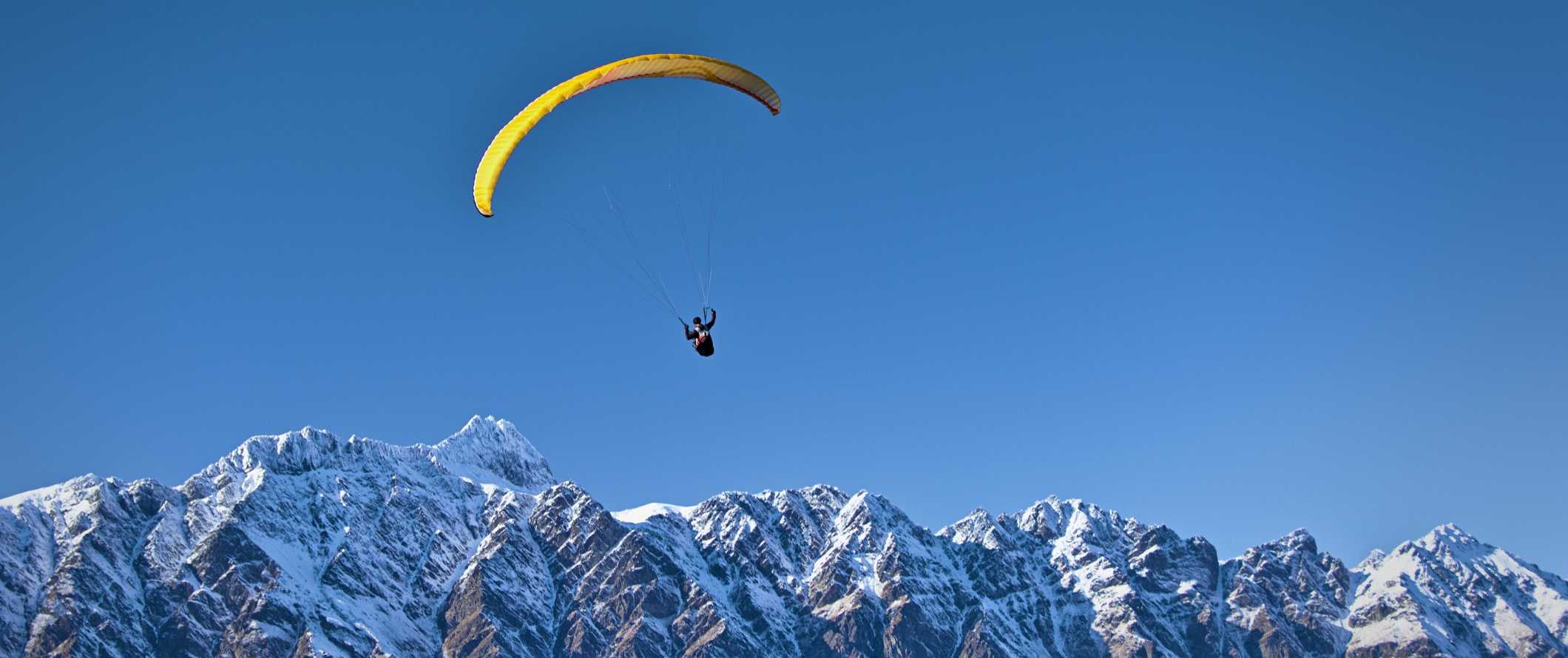
Accommodation – Hostel dorms cost between 25-40 NZD per night for a bed in a dorm with 4-8 beds. Private rooms begin at 75 NZD though most are closer to 100 NZD. Free Wi-Fi is common, though very few hostels include free breakfast. Most hostels have self-catering facilities, so be sure to check before you book if having a kitchen is a priority.
Budget hotels begin around 75 NZD per night. You can often find cheaper hotels and motels, however, they are usually far from the city center or don’t include a private bathroom.
Airbnb is widely available with private rooms starting around 65-85 NZD per night and entire homes/apartments costing at least 120-150 NZD per night. Expect to pay double if you don’t book in advance.
There are also a ton of campgrounds throughout the country with rates starting at around 15 NZD per night. Most Department of Conversation campsites need to be booked in advance online (in the summer they fill up months in advance). Couchsurfing is huge here, too.
Food – New Zealand cuisine consists mostly of seafood, fish and chips, meat pies, and specialties like Maori hangi (meat and vegetables cooked underground). Expect to indulge in things like roast lamb, muscles, scallops, oysters, and snapper. However, the country is overall very veg-friendly, and vegans and vegetarians will find plant-based dishes on restaurant menus throughout the country.
A meal at an inexpensive restaurant serving typical cuisine costs around 20-25 NZD while a nice meal with a drink costs about 50-60 NZD.
A fast-food combo meal (think McDonald’s) costs around 14 NZD. Chinese, Thai, and Indian can be found for 15-20 NZD while takeaway pizzas cost around 10-15 NZD. A takeaway meal of fish and chips is 10-15 NZD.
For drinks, a beer costs 9-10 NZD, a glass of wine is 12-15 NZD, a cocktail is 13-18 NZD, a latte/cappuccino costs 5 NZD, and bottled water is around 3 NZD.
If you choose to cook your food, plan to spend around 60-80 NZD per week on basic foodstuffs like rice, pasta, vegetables, and some meat or fish. PaknSave, mainly located in big cities, is typically the cheapest supermarket.
Backpacking New Zealand Suggested Budgets
On a backpacker budget, prepare to spend at least 75-85 NZD per day. On this budget, you can stay in a hostel dorm, take public transportation to get around, limit your drinking, do free hikes, visit the odd paid site (like museums), and cook your own meals. You’ll need to budget more if you plan to do bigger activities like bungy jumping. You can also lower this by Couchsurfing, camping, and cutting out drinking altogether.
For a more mid-range budget, expect to spend around 150-225 NZD per day. On this budget, you can stay in a private room in a hostel or Airbnb, take the occasional taxi or Uber to get around, do some larger activities like bungy jumping or whale watching, eat out for most meals at casual restaurants, and enjoy a few drinks.
A “luxury” budget of around 315-395 NZD per day or more gets you a hotel, any activities you want, wine tours, delicious meals out, and the best the country has to offer. You can also rent a car or take a scenic train journey. This is just the ground floor for luxury — the sky is the limit!
You can use the chart below to get some idea of how much you need to budget daily, depending on your travel style. Keep in mind these are daily averages — some days you’ll spend more, some days you’ll spend less (you might spend less every day). We just want to give you a general idea of how to make your budget. Prices are in NZD.
New Zealand Travel Guide: Money-Saving Tips
Costs in New Zealand can skyrocket quickly if you aren’t careful. Eating out here is expensive and all those adventure activities can really add up. In New Zealand, you have to pick and choose your battles. That said there’s a ton of ways to save here and it’s very easy to travel here on a budget without impacting your experience. Here are ways you can save money in New Zealand:
- Learn to cook – I know this is going to sound crazy but: the food scene in New Zealand isn’t that mind-blowing. Yes, there are nice cafes, some hip gastronomy, and really delicious meals but nothing blew my mind. There’s good food but there’s not great food. At least not great enough when you are trying to save money. If you want to really save, cook your own food. When it comes to buying groceries, the cheaper supermarkets are Pakn’Save or Countdown.
- Choose wisely – Tours cost a lot of money in New Zealand. A few of these are enough to bust any budget and send you home before you had planned. Pick the ones you really want to do and save the rest for another trip.
- Hit happy hour – The backpacker bars have cheap happy hours. Hit them up and drink for cheap.
- WWOOF it – WWOOFing is a great way to work for your accommodation and food. In return for working on a farm or B&B, you get free room and board. It’s a popular activity with travelers because it lets you stay in a place cheaper and longer. You can do it for a few days or a few months. Keep in mind that most farms require you to have some experience, as too many inexperienced workers have caused trouble in the past.
- Get a temporary job – If you’re running low on money and still have plenty of time left in New Zealand, check Backpackerboard.co.nz for temporary paying gigs.
- Clean in exchange for your room – Many hostels let you trade a few hours of cleaning and making beds for free accommodation. Ask when you check in if this is possible — it might just save you some money!
- Ride share – Ride shares are a popular transportation option for travelers looking to lower costs — all you need to do is chip in for gas. You can find rides on websites like Craigslist and CarpoolWorld. Additionally, you’ll see people asking for rides on hostel bulletin boards.
- Transport vehicles – Campervan and car relocation services will provide you with a free vehicle and gas if you drive it from one destination to another for them. This can be a great way to save a lot of money if you’re flexible with timing. Check Transfercar.co.nz to see what’s available.
- Stay with a local – While there are not a ton of Couchsurfing options available in the country, there are hosts in all of the major cities. If you don’t mind sleeping on a couch or floor, this is a great way to save some money and meet locals who can share their insider tips and advice.
- Hitchhike – Hitchhiking is easy in New Zealand and it’s one of the main ways to get around. There are plenty of people who will pick you up. Additionally, you can just ask around at any hostel and find a ride. Everyone is doing the same circuit. I got from Wanaka to Queenstown to Fiordland that way. Check out HitchWiki for tips.
- Take a free walking tour – There are a few free walking tours in New Zealand, such as Auckland Free Walking Tour in Auckland, that offer visitors insights into each city. If you want to get beneath the surface of New Zealand then walking tours are a great place to start. Just be sure to tip your guide at the end!
- Get a campervan – Campervans litter New Zealand, especially on the nature-heavy South Island where people hike and camp because they serve as accommodation and transportation all wrapped up in one. For budget-conscious travelers, that’s a win. Be sure to download the awesome Campermates app, which lets you find nearby campsites, gas stations, and dump stations.
- Find cheap activities – The bookme.co.nz website provides last-minute discounts on activities (and pub crawls) throughout the country. Most of the activities are last minute, but if you’re flexible in when you want to do things, you can save up to 60% off attractions! I can’t recommend it enough.
- Skip the backpacker buses – While fun, buses like the Kiwi Experience, Stray, or Haka are expensive so it’s best to avoid them if you are on a tight budget. If your budget isn’t so tight and you do want to check them out, be sure to sign up for their mailing lists. There is always a sale on them.
- Enjoy nature – Remember that nature is free! New Zealand, home to the great walks of the world, has tons of free outdoor activities. While the adventure sports, wine tours, glacier treks, and boat cruises can eat into your budget, there are plenty of free hiking trails and walks to keep you busy!
- Bring a water bottle – The tap water in New Zealand is safe to drink so bring a water bottle with you to save money. LifeStraw makes a reusable bottle with a built-in filter so you can always be sure your water is clean and safe!
Where to Stay in New Zealand
The hostel scene in the country has vastly improved since I first came here in 2010. There’s much more variety and higher quality now. Here are some of my suggested places to stay:
- Haka Lodge (Auckland)
- Waiheke Backpackers Hostel (Auckland)
- Nomads (Queenstown)
- Haka Lodge (Queenstown)
- Kiwi Paka (Waitomo)
- Urbanz (Christchurch)
- Trek Global (Wellington)
- Mountain View Backpackers (Wanaka)
How to Get Around New Zealand
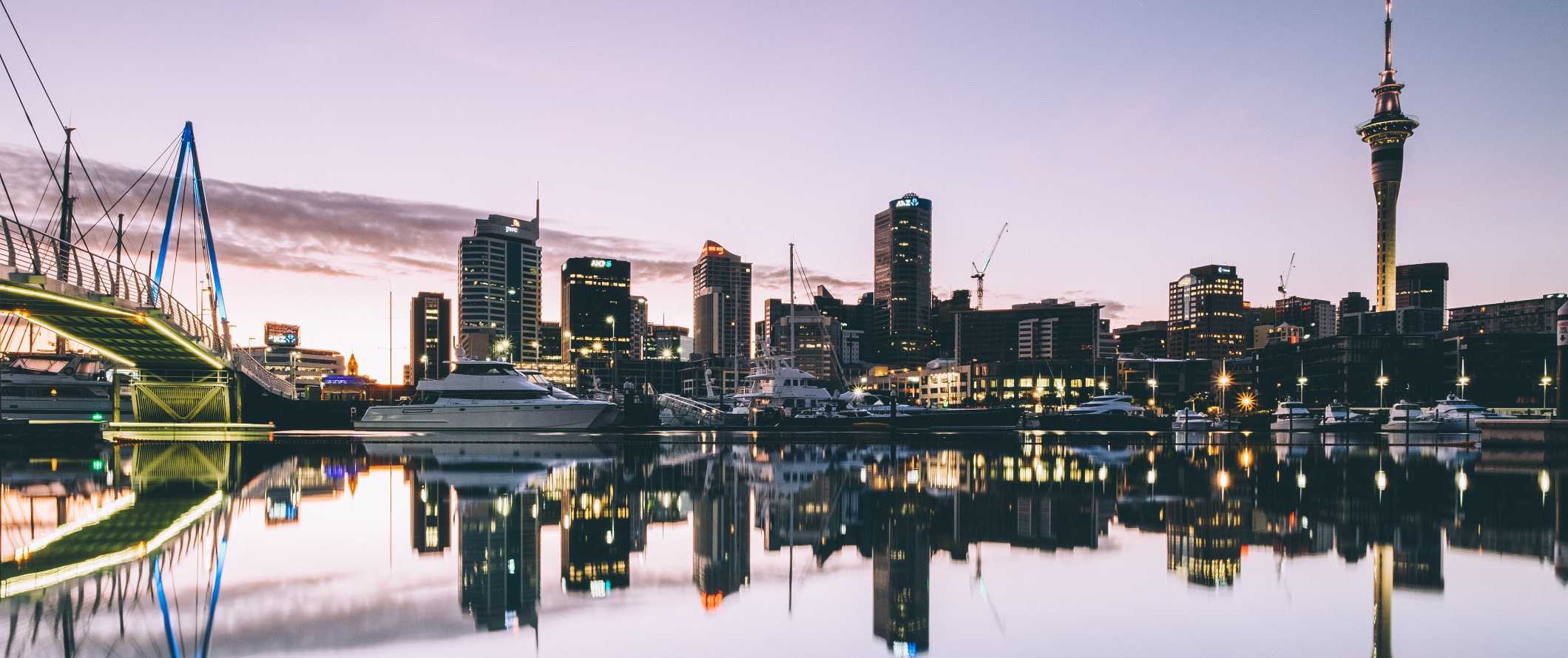
Public transportation – Most towns and cities in New Zealand have buses, and Auckland and Wellington both have rail services. One-way fares start around 2-3 NZD and increase depending on what zone you’re traveling to (most cities and towns in New Zealand are sprawling). Check to see if there are transit cards available. For example, Wellington has a Snapper card which will save you nearly half your fare, and the same goes for Auckland’s AT HOP card.
Backpacker bus – One of the most popular ways travelers get across New Zealand is by backpacker bus. These buses offer a hop-on/hop-off service that allows travelers both the flexibility to go at their own pace and the convenience of having activities and accommodation organized for them. New Zealand has two major hop-on/hop-off buses:
- The Kiwi Experience
- Stray Travel
Kiwi Experience tours range from 2-28 days and cost between 85-1,499 NZD while Stray Tours range from 8-18 days and cost between 2,140-4,999 NZD.
Trains – New Zealand has three train lines: Northern Explorer, Coastal Pacific, and TranzAlpine. These are scenic train rides complete with viewing platforms, audio commentary, information packets, and big windows for taking photos. However, they’re not the most convenient for getting around as they have quite limited schedules. They are meant to be scenic rides than transportation. Tickets range from 99-219 NZD depending on the route.
Buses – Buses are the best and cheapest way to get around New Zealand. Buses stop in every town, and there are frequent departures from even the smallest cities. Visit InterCity for fares and routes. The earlier you book in advance, the cheaper your ticket will be. Avoid last-minute bookings if possible.
Flying – Flying in New Zealand isn’t that cheap, as there are only two companies that dominate the entire market: Air New Zealand and Jetstar — and on most routes, it’s just Air New Zealand. While you can find some cheap fares on shorter routes or by booking a few months in advance, unless you are really pressed for time or traveling from island to island, I’d skip flying.
One-way routes from Auckland to Queenstown cost 60-130 NZD (a two-hour flight), Queenstown to Christchurch is usually 50-140 NZD (a one-hour flight), and Auckland to Christchurch from 45-125 NZD (a 1.5-hour flight).
Campervans and Car Rentals – This is a popular way to travel in New Zealand, especially on the nature-heavy South Island, where people hike and camp. There are five main rental agencies:
- Travellers Autobarn
- Wicked Campers
Daily rates change depending on where you pick the vehicle up, if you are dropping it off at a different place, how long you are renting it for, how far in advance you book, and when you book. (Going during the high season? Prices seem to double!). Check out this post for more information and price comparisons .
When to Go to New Zealand
New Zealand is in the Southern Hemisphere, meaning when most North Americans are dealing with snow and freezing temperatures, Kiwis are enjoying their beaches. Overall, the climate here is temperate. Summer is from December-February and is the most popular time to visit. Kiwis also take their holidays during this time, so things get busy! Days are long and sunny, nights are mild. The average daytime temperature is 20-25°C (68-77°F).
Fall is from March-May and it’s one of the best times to visit. The crowds have dispersed, prices are lower, and the weather is pleasant. Some areas still have very warm temperatures, like Auckland.
Winter is from June-August, and it’s a great time to visit if you’re into snow sports. Queenstown and the Central Plateau are winter playgrounds during this time, but especially in June and July! Temperatures on the South Island can drop as low as 0°C (30°F).
Spring (September-November) is also a nice time to visit, especially on the South Island. In short, there’s really no bad time to visit, depending on the sort of things you’d like to do.
That said, since New Zealand is so expensive, the shoulder season is one of the best times to visit if you’re on a budget.
How to Stay Safe in New Zealand
New Zealand is a safe place to backpack and travel around. Violent crime and petty theft are both incredibly rare here. That said, it never hurts to always keep your valuables safe and secure just in case. Don’t leave valuables in your car or van overnight as break ins sometimes do happen.
Solo female travelers should generally feel safe here. However, the standard precautions apply (never leave your drink unattended at the bar, never walk home alone intoxicated, etc.).
You can read about common travel scams to avoid here but there aren’t many in New Zealand though. People here are generally friendly and nice. In all my years traveling here, I’ve never felt unsafe.
If you’re doing any hiking or other adventure sports, always check the weather in advance and bring water and sunscreen.
As earthquakes and tsunamis do occur in New Zealand, consider downloading the Hazard App from the Red Cross. It has all kinds of advice and tips for natural disasters and also sends out warnings and notifications should a disaster occur.
If you do experience an emergency, dial 111 for assistance.
The most important piece of advice I can offer is to purchase good travel insurance. Travel insurance will protect you against illness, injury, theft, and cancellations. It’s comprehensive protection in case anything goes wrong. I never go on a trip without it as I’ve had to use it many times in the past. You can use the widget below to find the policy right for you:
New Zealand Travel Guide: The Best Booking Resources
These are my favorite companies to use when I travel. They consistently have the best deals, offer world-class customer service and great value, and overall, are better than their competitors. They are the companies I use the most and are always the starting point in my search for travel deals.
- Skyscanner – Skyscanner is my favorite flight search engine. They search small websites and budget airlines that larger search sites tend to miss. They are hands down the number one place to start.
- Hostelworld – This is the best hostel accommodation site out there with the largest inventory, best search interface, and widest availability.
- Booking.com – The best all around booking site that constantly provides the cheapest and lowest rates. They have the widest selection of budget accommodation. In all my tests, they’ve always had the cheapest rates out of all the booking websites.
- Get Your Guide – Get Your Guide is a huge online marketplace for tours and excursions. They have tons of tour options available in cities all around the world, including everything from cooking classes, walking tours, street art lessons, and more!
- EatWith – This website allows you to eat home cooked meal with locals. Locals post listings for dinner parties and specialty meals that you can sign up for. There is a fee (everyone sets their own price) but this is a great way to do something different, pick a local’s brain, and make a new friend.
- bookme.co.nz – You’ll get some really good last minute deals and discounts on this website! Just select what area you’re traveling in, and see what activities are on sale.
- treatme.co.nz – The locals use this website to find discount hotels, restaurants, and tours. You can save up to 50% off things like catamaran sailing lessons or three-course dinners.
- SafetyWing – Safety Wing offers convenient and affordable plans tailored to digital nomads and long-term travelers. They have cheap monthly plans, great customer service, and an easy-to-use claims process that makes it perfect for those on the road.
- LifeStraw – My go-to company for reusable water bottles with built-in filters so you can ensure your drinking water is always clean and safe.
- Unbound Merino – They make lightweight, durable, easy-to-clean travel clothing.
- Top Travel Credit Cards – Points are the best way to cut down travel expenses. Here’s my favorite point earning credit cards so you can get free travel!
New Zealand Travel Guide: Related Articles
Want more info? Check out all the articles I’ve written on New Zealand travel and continue planning your trip:
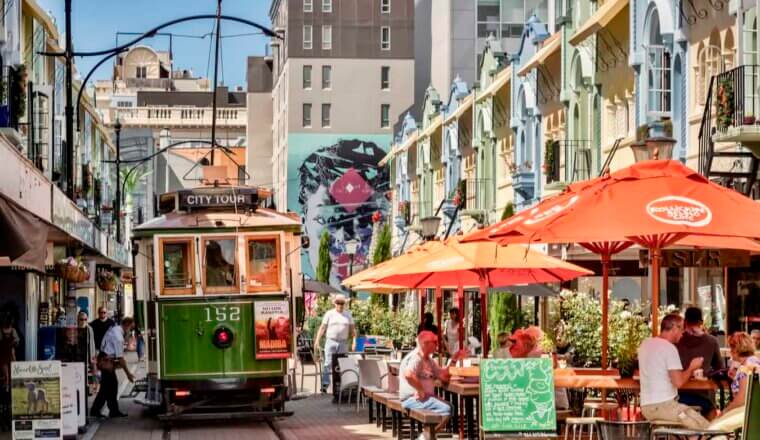
The 6 Best Hotels in Christchurch
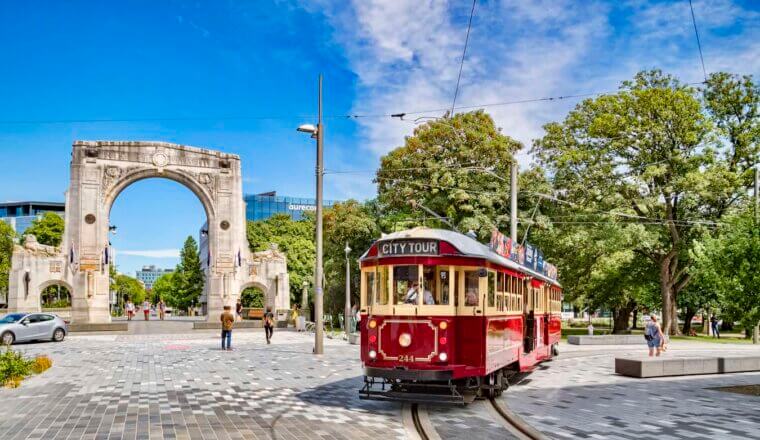
Where to Stay in Christchurch: The Best Neighborhoods for Your Visit
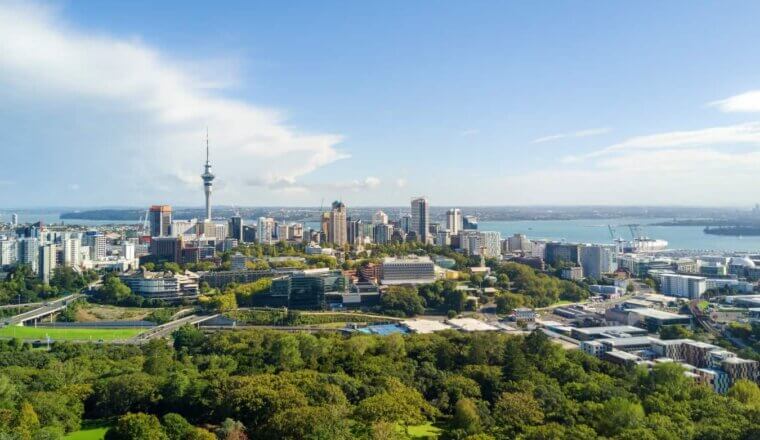
The 6 Best Hotels in Auckland
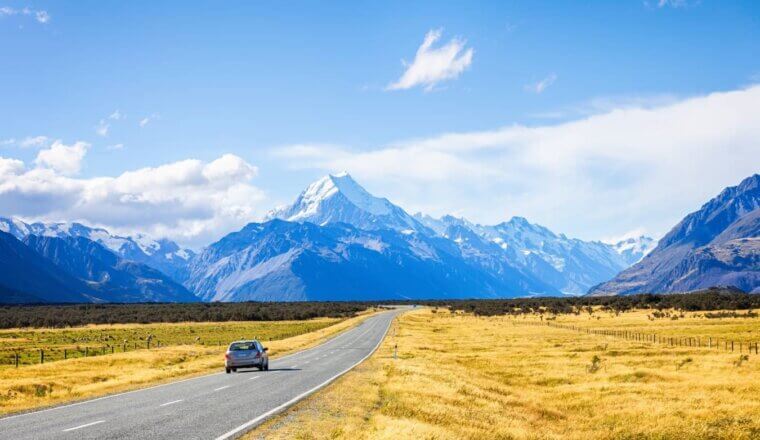
The Ultimate New Zealand Road Trip Itinerary
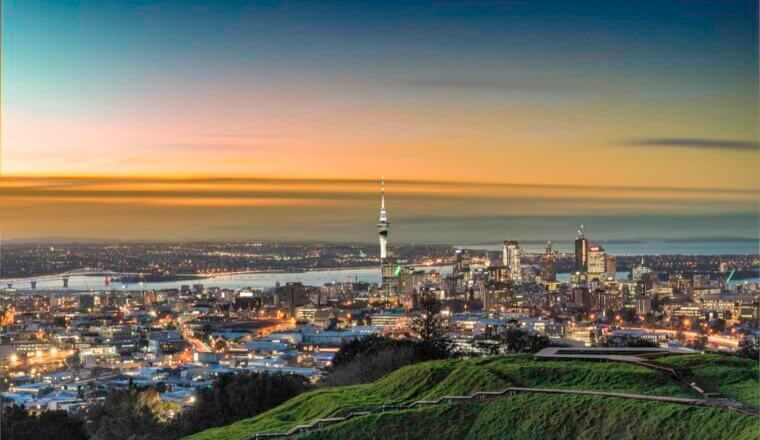
Where to Stay in Auckland: The Best Neighborhoods for Your Visit
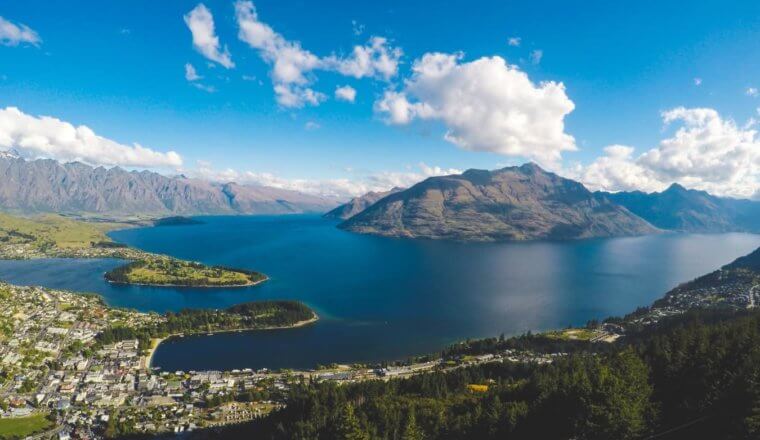
The 6 Best Hostels in Queenstown
Get my best stuff sent straight to you, pin it on pinterest.
- Where To Stay
- Transportation
- Booking Resources
- Related Blogs

The Ultimate New Zealand Travel Guide
B lack sand beaches, white snow capped mountains, still lakes, thunderous waves, creaking glaciers and smoking volcanoes. And, of course, hobbits . New Zealand is at times almost impossibly beautiful. It’s a picturesque paradise at the bottom of the world, 4,000 kilometres away from its biggest neighbour, Australia. It’s also my home.
After spending the last three years traveling through Europe and China, I’ve returned home to put my ‘local knowledge’ to the test. The result is this article: the Ultimate Guide to Traveling to New Zealand on the cheap.
(Note: all prices below are in New Zealand Dollars)
In this guide I’ve used New Zealand Dollars (NZD) for rough prices on accommodation, transport, food and activities. At the time of writing, $1 USD will buy you $1.42 NZD, $1 CAD will buy you $1.06 NZD, $1 AUD will buy you $1.08 NZD, and £1 GBP will buy you $1.83 NZD. These fluctuate but will give you a fair idea of what things cost.
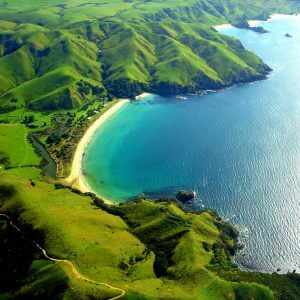
- 1 How Much Does a Trip to New Zealand Cost?
- 2 Transportation
- 3 Food & Wine
- 4 Accommodation
- 5 Activities
- 6 The Thrifty Gist
How Much Does a Trip to New Zealand Cost?
Let’s get the bad news out of the way quickly: New Zealand is not a natural budget destination. Its remote location, rugged landscape, and reasonably wealthy economy mean that prices for food, transport and lodging are at least as high here as Western Europe or the United States. But that doesn’t mean that budget travelers should forget about this country.
If you’re willing to crash on a few couches, cook most of your own meals, and find creative ways of getting from A to B then you can absolutely conquer New Zealand on a budget.
The biggest expense you’ll most likely face is getting here . New Zealand is far away from even its closed neighbour, Australia. If you’re flying from Europe, expect to pay around $1000 and spend a few days recovering from the 24 hour journey. Flights from Australia are much easier and can be as low as $100 if you’re flexible with dates. Most travelers fly into Auckland, the biggest city. You can find the best flight prices on Skyscanner , and by reading our guide How to Book the Cheapest Flight Possible to Anywhere .
If you’re coming purely to travel, then you’d be wise to budget at least $100 per day to make the most out of your trip, including outdoor activities, accommodation, food, transport and, of course, wine. And even with this budget, you’re going to have to be pretty switched on with how you spend your cash. Let’s drill down into the details.
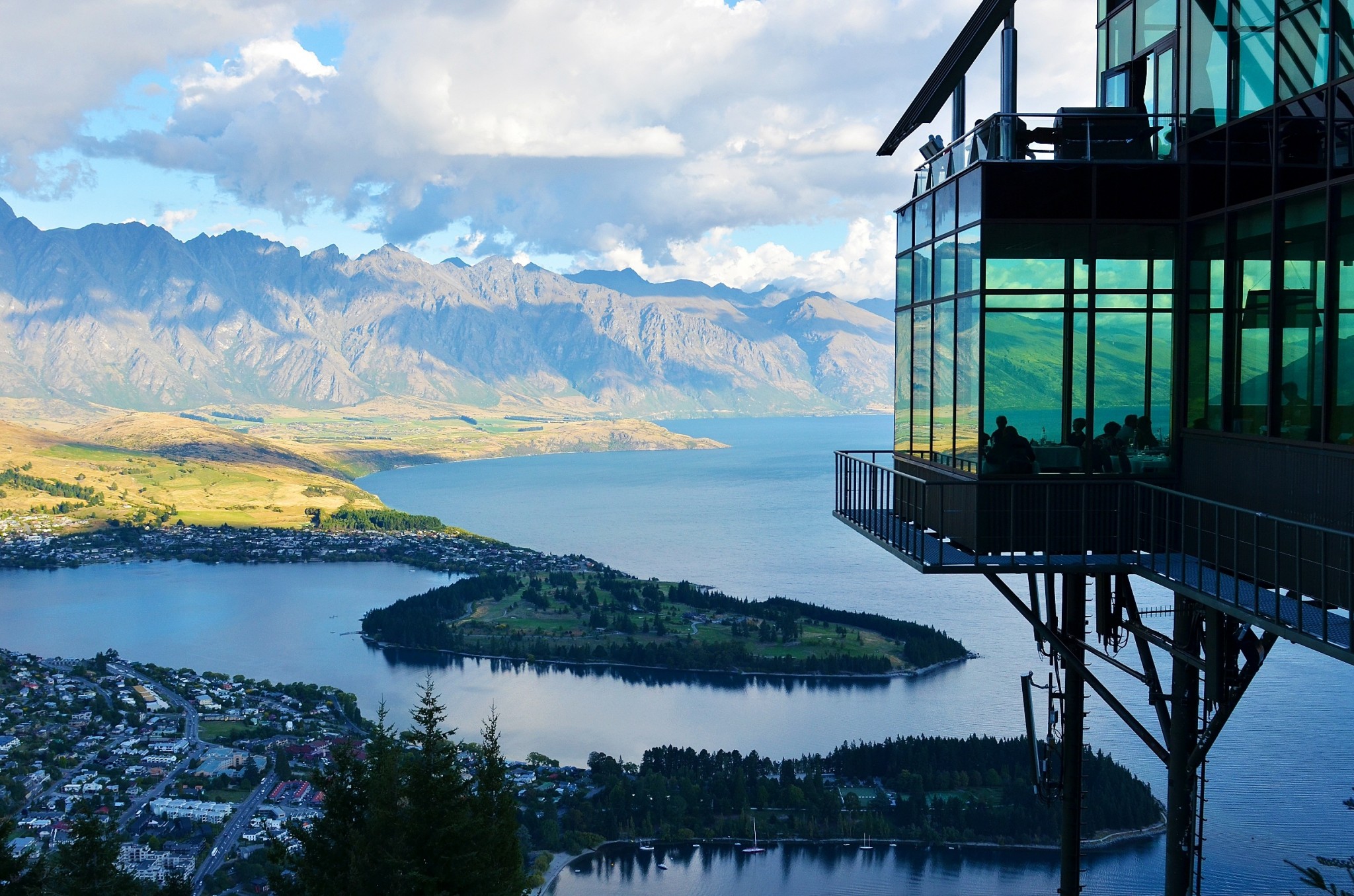
Transportation
Hire a car or campervan.
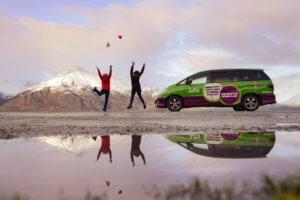
Rental prices in New Zealand are typically around $50 a day. Caravan rental options tailoring to budget travelers can even be cheaper than cars at as low as $40 / day. Jucy is quite popular (and easily recognizable with its bright green vehicles), though many other companies exist. RV relocations are also very popular here, landing you a one-way RV/campervan rental for as low as $1 per day. Just remember, we drive on the left here!
Hitchhiking
Except in small communities like Great Barrier Island, locals seldom hitchhike, but it remains a popular option for European tourists. Normal common sense rules apply, and solo female travelers should of course be particularly cautious – don’t hesitate to turn down a lift if the driver seems a little too friendly (check our solo female travel tips here ). Drivers who pick up hitchhikers will typically only accept payment in the form of conversation – some will want to hear your story, most will want to tell your theirs.
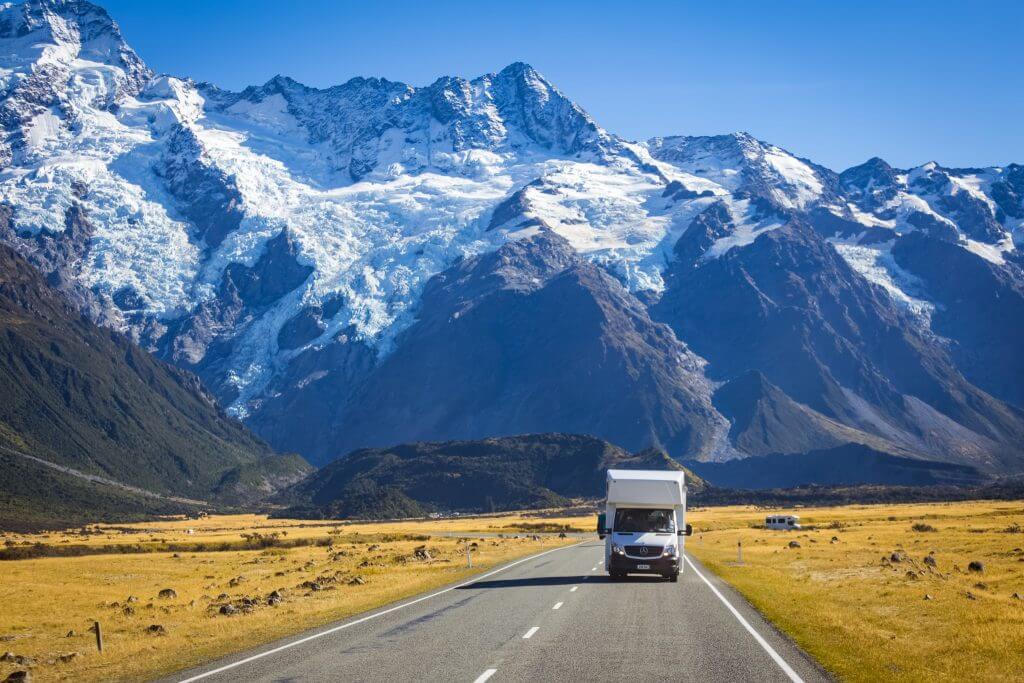
If you don’t want to be tied to a car and dislike the idea of hitchhiking, then long distance buses are a pretty solid option. InterCity and NakedBus are the major players, check online for the best fares. They advertise fares for as little as $1, but budget closer to $40 for between major destinations – the 5 hour Dunedin to Queenstown journey, for example, will set you back $38 with InterCity .
Pro-tip: If you’re flexible with time, showing up at the departure point without a ticket and asking for standby fares can result in big savings, but of course you run the risk of not getting anywhere!
New Zealand has a good network of domestic flights between most major cities. Timing is everything here – prices skyrocket at the start of each university semester (February and June) as students cram the planes to fly back from their parents houses.
Air New Zealand is the most comfortable airline but the Australian competitor Jetstar can have some great deals. An average domestic flight in New Zealand will set you back $100, with luck it can be as low as $40. You can search across all available airlines using a broad flight search engine like Skyscanner . For general travel hacks on booking flights, check our other tips here .
Feeling fit? Cycling is a massively popular, accessible and budget friendly way of getting around. Some people cycle the whole country – the roads often have cycle lanes and drivers are – in general – tolerant and considerate. It’s also a great way of getting around cities.
Buying a new bike here will cost you a fortune, but check TradeMe , our E-Bay equivalent, for secondhand deals. Some cities even have workshops where you can pick up a used bike for free for the duration of your stay, the catch is you have to mend it yourself! If you’re heading south, check out the Crooked Spoke in Dunedin.
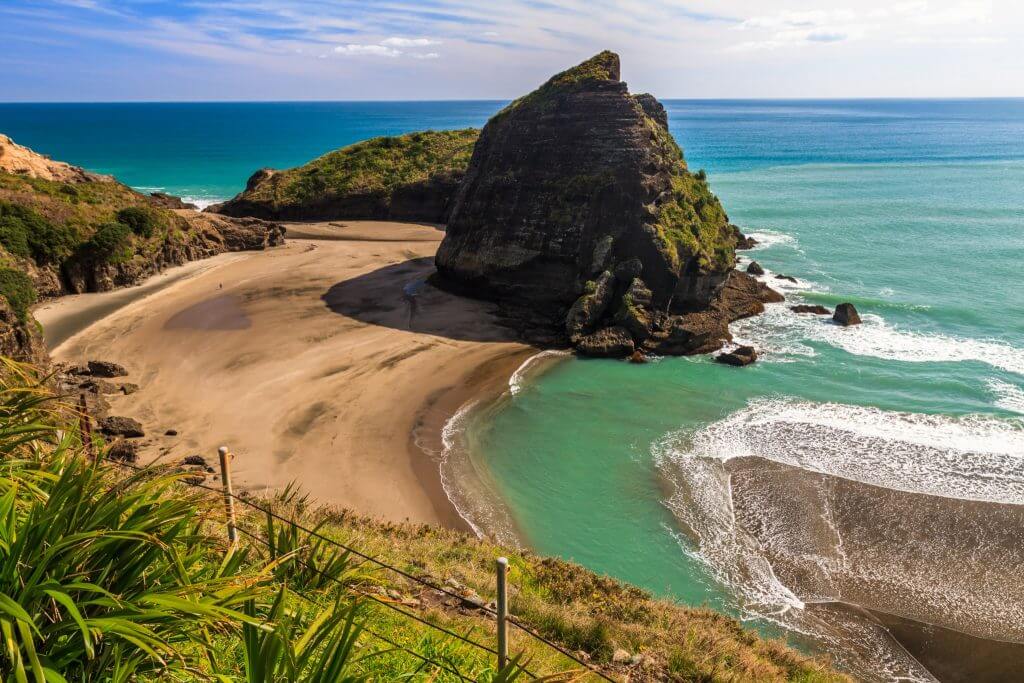
Taxis are monstrously expensive in this country and are to be used for emergencies only. (Yes, it’s 3am, you’re a little drunk, and you don’t feel like walking certainly counts!) Uber is a much cheaper option in the big cities like Auckland and Wellington, but has remarkably poor coverage elsewhere in the country. I was shocked to find Dunedin, a vibrant student town and our sixth biggest city, doesn’t even support the app. You can get a discount off your first Uber ride with the promo code uberthriftynomads
Food & Wine
New Zealand has an abundance of fresh ingredients straight from farms, fields and fisheries, as well as many exceptional restaurants. Add to that some of the world’s finest wineries and a thriving craft beer culture, and you’re in a for a never ending feast… if you can afford it.
Eating out can really burn a hole in your pocket, so the majority of this section will focus on self catering which is how most budget travelers get by.
Supermarkets
A meal in a cafe, mid-range restaurant or gastropub will set you back $30-50 per person, but a meal you cook for yourself will cost you as little as $5. Major supermarket chains include Countdown, New World and Pak’NSave, with the latter generally considered the cheapest. In smaller towns look out for the local Foursquare.
The major corner stores chains like 7-11 haven’t yet made it to NZ, and our homegrown convenience stores tend to be very pricey even by local standards. Unless you’re desperate, avoid the ubiquitous independent corner stores which we call dairies because the mark-ups on groceries are generally ridiculous.
The usual self catering options you’d expect to find in the USA or Europe apply here – dried pasta, mincemeat, rice, diced tomatoes if you’re really pinching the pennies. Look out for ‘Homebrand,’ ‘Budget’ or ‘Signature Range’ items which tend to be much cheaper than the name brands.
Farmer’s Markets
Most towns have their own farmers markets once a week where you can get fresh produce directly from the maker. Incredible local cheeses, meats, fish, baking, honey, wine. Google ‘farmer's market: city’ to see what’s happening near you. Expect to pay $5-$10 per takeaway item.
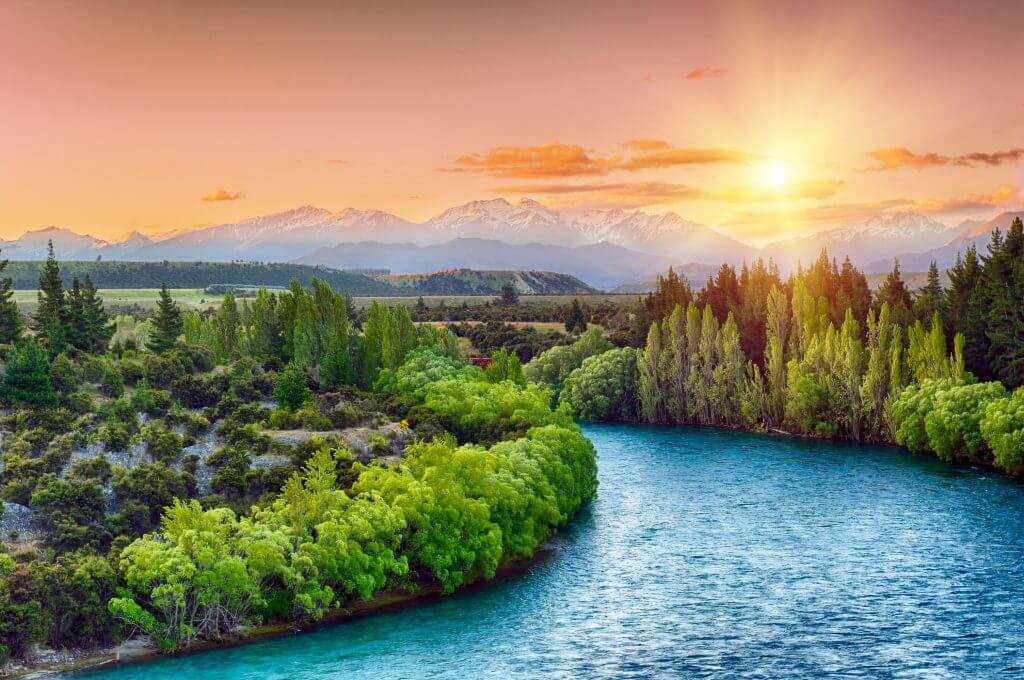
Craving a Restaurant Meal? Go Asian
We may be an English speaking nation with the Union Jack proudly in the corner of our flag and an unhealthy obsession with Will & Kate, but when you look at the map, you’ll see that it’s Asia and the Pacific where our home truly lies.
There are hundreds of budget Asian restaurants in this country who will do you a good meal for as little as $10. The ones to look out for tend to be BYO, meaning you can bring in your own bottle of fine Cab Sav from the supermarket and avoid the hefty markups restaurants tend to charge for booze. You’ll find them on the main streets of most New Zealand cities. If in Auckland, look at the upper end of Queen Street and on Dominion Road.
Up for a Drink? Opt for Wine
New Zealand wine is justifiably famous the world over. It’s also one of the most budget friendly ways to unwind after a hard day’s sightseeing. Tax breaks given to the local wine industry mean that it’s generally the cheapest option at the liquor store. A pint of beer can easily cost as much as $10 in your average pub. For the same amount, you can buy a perfectly respectable bottle of local wine at any of the major supermarket chains mentioned above. Look out for the specials! Options vary significantly but you can normally be sure of a good meal for $10 a person – less if you shop and plan well.
Accommodation
Kill 2 birds with 1 stone and cover both transport and accommodation with a Jucy campervan . Park where you please (as long as there are no restrictions) and wake up to beautiful mountains and beaches at your doorstep.
Youth Hostels
If you’re hitting the tourist hotspots like Queenstown, Rotorua or Taupo, then youth hostels are a safe bet for cheap, sociable and comfortable accommodation. The YHA has a strong presence here, and joining as a member can result in some serious savings. As with most other travel spots, HostelWorld is a solid booking option. Jucy Snooze is a new hostel chain that offers dorm rooms and reasonable room rates for privates in comparison to hotels. You can find all your options by searching on HotelsCombined , which will search across all major hotel and hostel websites.
Even for dorm rooms, prices throughout New Zealand will be on par with European capitals like Paris and London – prepare to pay $30 – $70 per night.
AirBNB in New Zealand seems to dominated by luxurious lakeside cottages, which is no doubt awesome, but not budget by any stretch of the imagination. However, if you wind the price filter way down to the left, some amusing options come available. Fancy staying in a powerless cabin in Central Otago? Hey, if you’re feeling adventurous, go for it! Even for the wackier options, you’ll be looking at $50 a night minimum. Use our referral code for a $25 sign up credit.
Book a Bach
In additional to the international websites, we have some proudly kiwi accommodation booking resources that are worth checking if you’re traveling in a group. Use Bookabach.co.nz (part of HomeAway ) for seaside rentals (‘bach’ is kiwi for small house near the beach), and HolidayHouses.co.nz for AirBNB style homes. Outside of Easter and Christmas/New Years, you can expect to find good options on these sites for $120-200, well worth it if you’re in a large group.
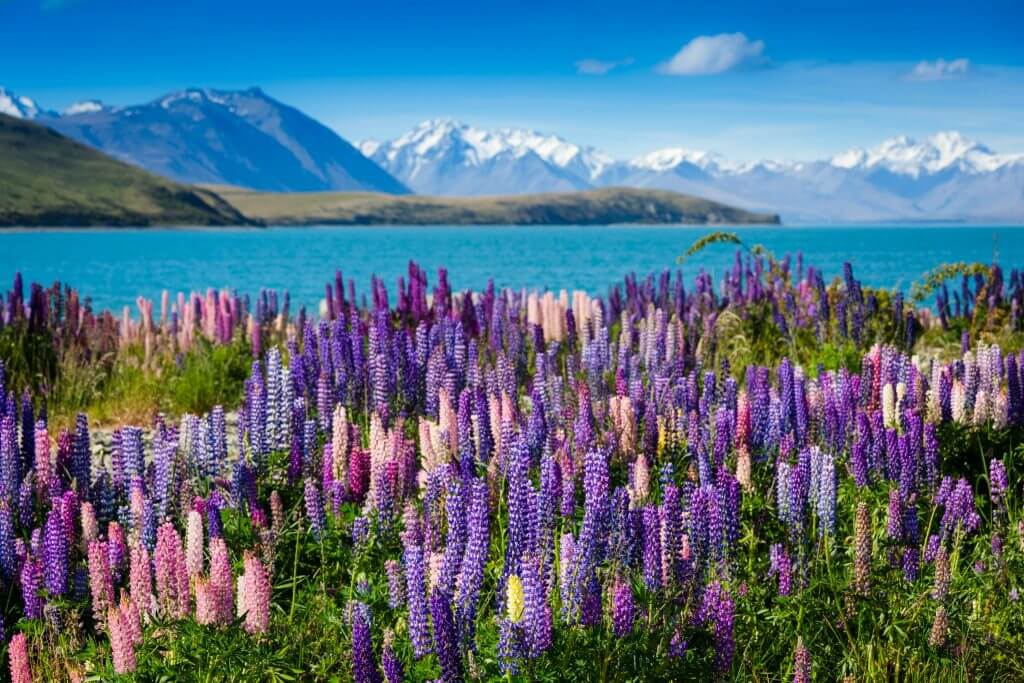
Free camping is permitted at designated spots around the country, maintained by the Department of Conservation (known locally as the DOC), their website is a useful source of information on all things rural in New Zealand. They also maintain a network of huts on remote hiking trails which can be booked in advanced.
Paid holiday parks provide a bit more in terms of facilities, and are often in more accessible locations. Top 10 is a solid option with prices from around $40 / night.
Couch Surfing
Want to meet locals and stay for free? Consider Couch Surfing . It’s a popular option in New Zealand and definitely worth giving a go. I’ve not used the service in this country myself, but have spoken to people from Europe who’ve ‘surfed’ across the country and had positive experiences.
Longer term options: WWOOFing & House Sitting
Considering staying in New Zealand for the long haul? Good on ya! This gives you some interesting options for ‘earning your keep’ as you travel. If you don’t mind getting your hands dirty and are keen for an authentic taste of rural life, WWOOF can arrange for you to live on an organic farm and work some hours a week in exchange for room and board.
An even cosier option is house sitting – you stay in someone’s home for free while their away, and look after the place while you see the sites. Websites like Trusted Housesitters and Kiwi House Sitters charge wannabe sitters a small (in this case $65) annual fee in exchange for access to their listings of available homes. A nice gig if you can get it – be sure to check our housesitting how-to guide here .
Unless you’re working for board, Couch Surfing or free camping, you’d be wise to budget about $50 per night for accommodation at hostels and ‘out of the way’ AirBNB finds.
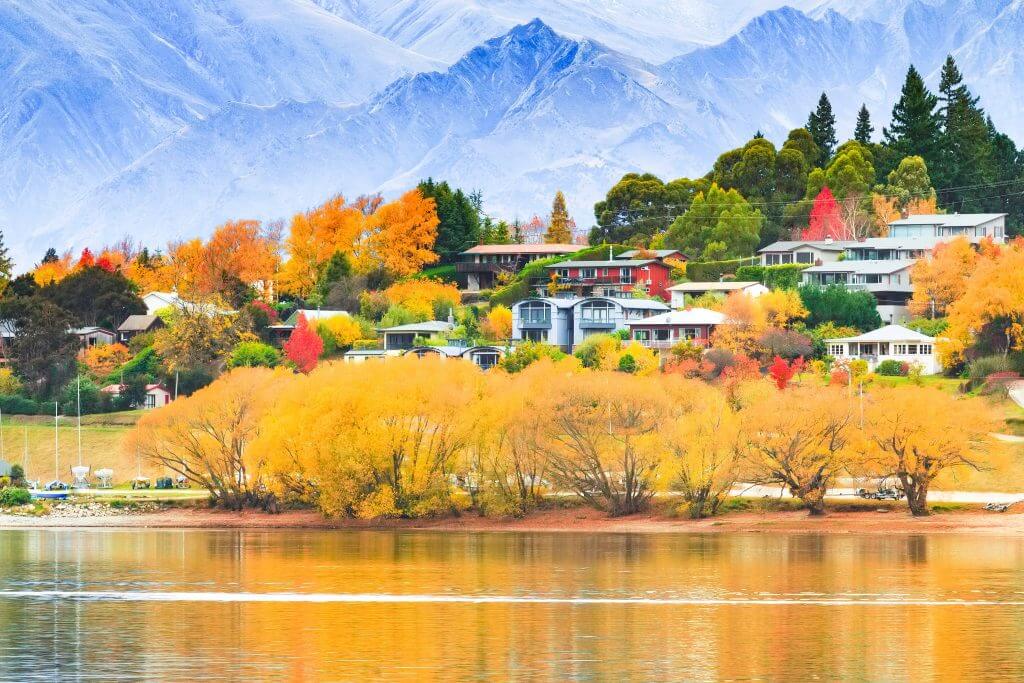
Activities in New Zealand veer towards the outdoors. The cities are worth a few days, but really what brings people to this country are the ‘Lord of the Rings’ views (and tours !) that will leave you breathless even before the hikes begin! So, strap on your boots and let’s get to it.
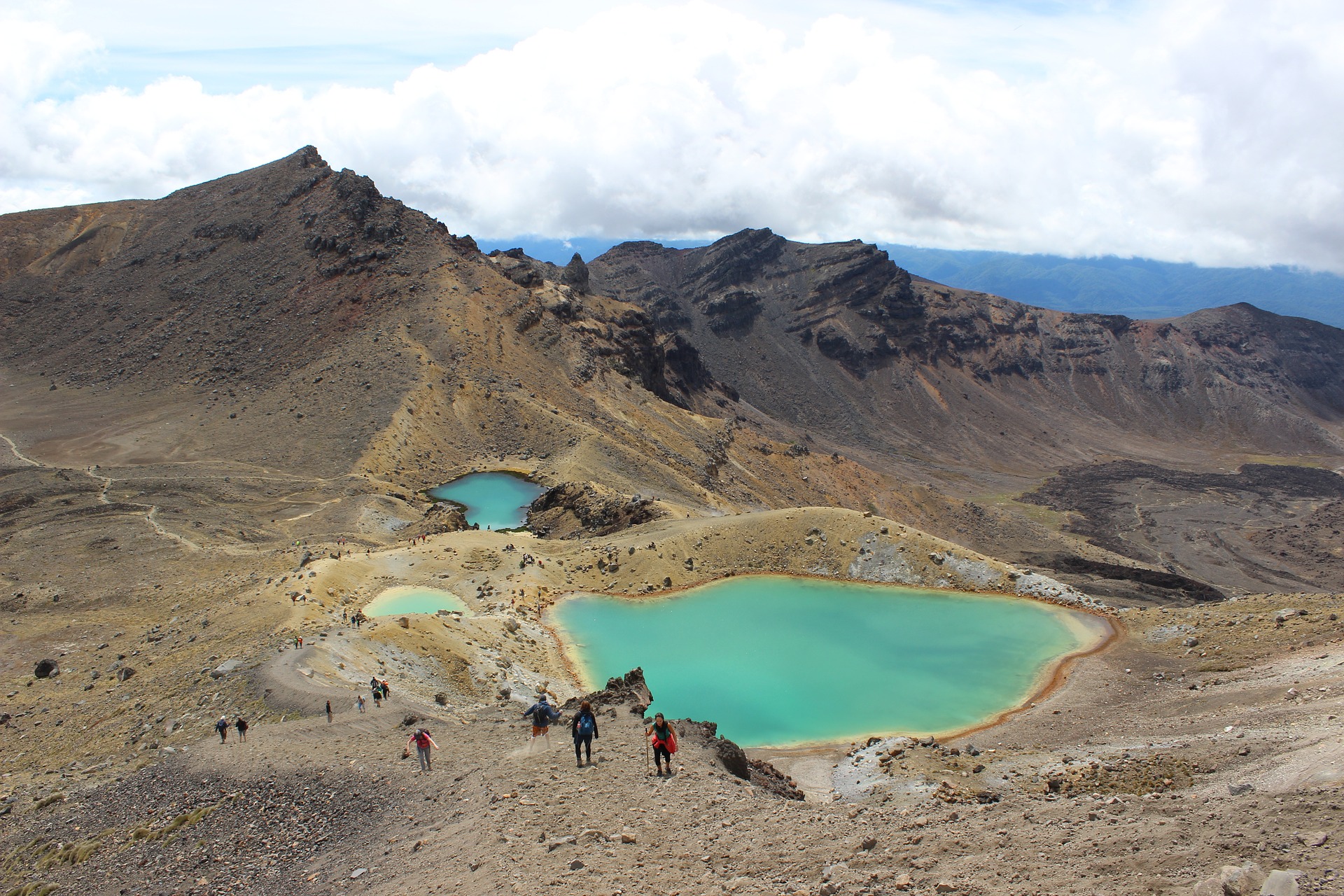
Walking and Hiking
Perhaps the most spectacular options is also one of the cheapest: hiking. Books have been written about the world of hiking options available, from lush native forest to gargantuan mountains. In fact, get out of the cities and there’s very little that isn’t photo worthy, just go for a walk along your nearest beach or scamper up a volcano – the country is full of them!
Some of the more remote and spectacular hikes require a small fee to be paid to the Department of Conservation (which may include accommodation in one of the backcountry huts). Adult prices are normally around $32 per day.
Strapping on a couple of flimsy pieces of metal and hurling yourself at high speed down a mountain sound like a good time? Then New Zealand has an avalanche (get it) of options to serve you. The most popular ski spots like The Remarkables and Coronet Peak will set you back about $100 per day for lift access.
Swimming & Surfing
The wild beaches of the West Coast of the North Island, particularly Piha, Kerikeri and Muriwai, are famous not only for their waves, but also for their iron rich black sand. Beaches are all free to access and, compared to Europe or nearby Sydney, seldom noticeably crowded.
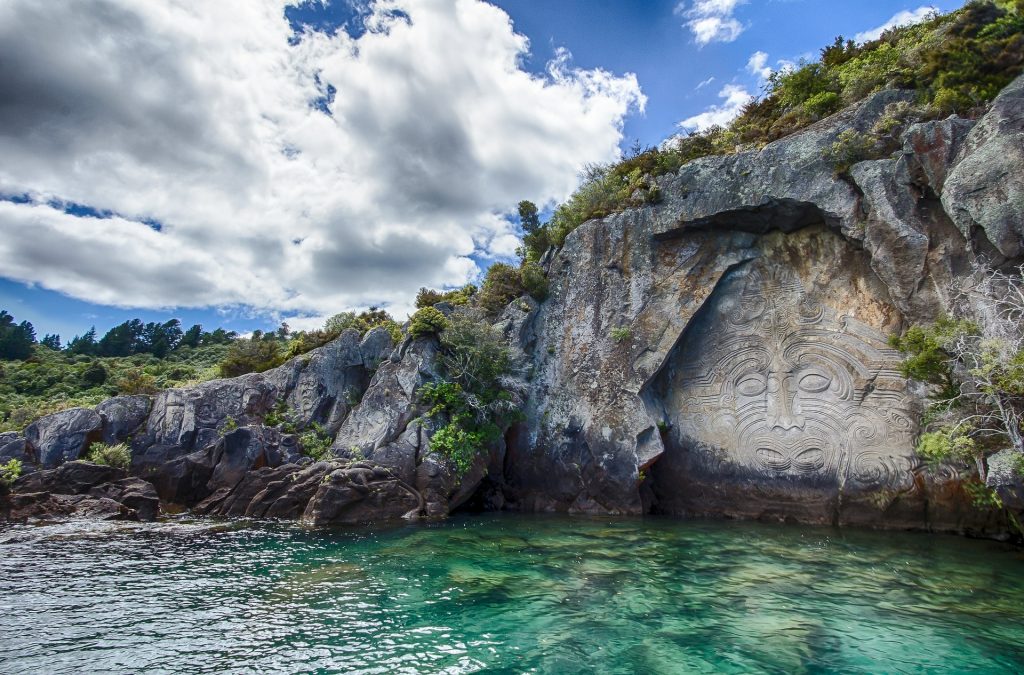
Bungee Jumping and Parachuting
Beyond skiing, New Zealand is rightly known as the ‘Adventure Capital of the World’ – just don’t tell Switzerland. This is the country that invented bungee jumping, for goodness sake, so if you’re going to try it anywhere, here’s the place. In general, throwing yourself off things with a cord or parachute is expensive, around $150 for bungee jumping and as much as twice this for parachuting. You can find all the activities you could want and even book them online using GetYourGuide and Viator .
We talked about how to get hold of cheap or even free bikes in the ‘Transport’ section above. Like hiking, cycling is a cheap, healthy and picturesque way of exploring New Zealand. Established routes like the Rail Trail in Central Otago connect you with a series of inns / bed and breakfasts which offer accommodation (and a well needed pint) if you’re willing to shell out.
New Zealand is home to some of the world’s most unique and breathtaking tourist experiences. Due to the fragility of some of the most spectacular nature hot spots, a tour is sometimes essential for particular destinations. Here’s a few incredible experiences that no visitor to New Zealand should miss.
Milford Sound
Go to Milford Sound, a fiord in the south island, and enjoy a tranquil boat cruise while surrounded by breathtaking mountains, waterfalls, and wildlife such as fur seals, penguins, and dolphins. This is easy to see as a day tour from Queenstown , which makes a few picture perfect stops in the Fiordland National Park on the way. Or if driving yourself, you can purchase a cruise ticket only , and even consider doing some hikes in the area with the extra time.
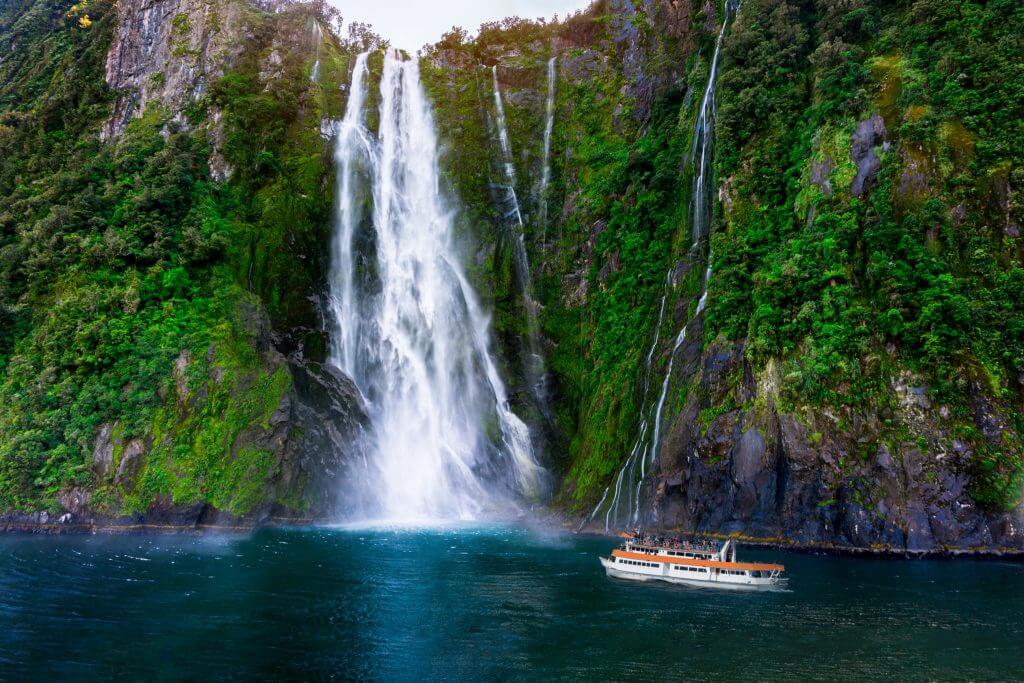
Franz Joseph Glacier
It’s not often you get the opportunity to hike on a glacier, so take advantage while you’re here. A heli hike tour first takes you on a scenic helicopter flight with birds-eye views of the glacier. After landing on the glacier, grab your ice axe and hike through this dramatic landscape full of ice caves and pinnacles, then finish off by rejuvenating yourself at the Glacier Hot Pools. You can easily book your tickets ahead on Viator .
Waitomo Caves
The Waitomo Caves are famous for their glowworms, a creature unique to New Zealand and only accessible with a tour. After exploring the caves by foot, take a peaceful boat ride and witness thousands of glowworms above you illuminating the darkness. The sight is so incredible that the caves were even featured on BBC’s Planet Earth. Viator offers a number of day trips to the caves from Auckland and Rotorua, often combined with visits to the Hobbiton movie set (more on that below), or just drive there yourself and get a ticket for the tour only .
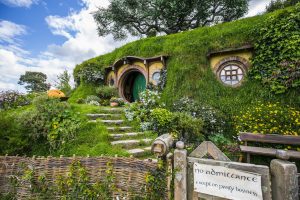
Fans of Lord of the Rings can visit the original movie set of Hobbiton, home to Frodo and Bilbo Baggins, which has seen recent additions and re-touches thanks to the release of The Hobbit films. You can book a variety of day tours to Hobbiton from Auckland on Viator or GetYourGuide , many including stops to the Waitomo glowworm caves, or simply book directly on their website and drive to the set yourself.
Excluding high cost, high adrenaline activities like skiing and bungee jumping, New Zealand’s spectacular wilderness is open for the exploring mostly for free, but budget $35 per day in fees for the more exquisite hikes.
The Thrifty Gist
- Hire a car (check BookingBuddy , or get a campervan from Jucy ) or get hold of a second hand bike to see New Zealand under your own steam, or use buses and flights between cities
- Self cater by stocking up on supplies at supermarkets, not corner stores. Eat out at BYO Asian / Pacific restaurants, and drink the delicious local wine
- Stay in youth hostels (find on HostelWorld ) or get creative with free camping or WWOOFing and house sitting if you’re here long term. For groups, use New Zealand websites like Bookabach to rent holiday homes
- Most of New Zealand's forests, beaches and countryside is ready for you to explore for little or no fee. Adventure activities are fun but come with a high price tag. Certain ‘Great Walks’ incur a conservation fee, normally $32 per day
- facebook-official
- youtube-play
- pinterest-circled

The Complete Travel Guide to Auckland 🏙️ [2024]
Nz pocket guide is 10 years old. thank you for trusting us with your trip for over a decade, how to plan the best trip to auckland, new zealand.
For many travellers visiting New Zealand, it all starts in Auckland . New Zealand’s largest city covers a vast area well beyond its famous city skyline defined with the Southern Hemisphere’s tallest building, the Sky Tower . The region encompasses around 26 regional parks with lush forest, rolling farmland and sandy beaches. Just off the coast is the Hauraki Gulf , famous for its volcanic islands each with its own unique features. So whether you’re an urbanite or a country bumkin, there are experiences and accommodations to suit a huge range of travellers in Auckland.
We’ll go through our top travel tips, activities and hotels for several travel styles in this complete travel guide to Auckland.
Common Questions About Auckland
We’re not messing around with this travel guide to Auckland; here are the most common questions travellers have about visiting.
What is Auckland Well Known For?
Auckland is known for being the most populated city and region in New Zealand with around 1.7 million people, notably more than the entire South Island. The city is also known as “The City of Sails” due to its access to both the Hauraki Gulf and Tasman Sea and its abundance of sailing yachts and marinas.
Where is Auckland Located?
Auckland is the second northernmost region of the North Island , New Zealand.
What is the Weather Usually Like in Auckland?
Auckland has a mild climate with its fair share of sunny and rainy spells. The daily average temperature is 15.2°C /59.36 ° F, while the yearly average rainfall is 1,284mm /50.6″. Find out more in What is the Weather Like in Auckland?
When is the Best Time to Visit Auckland?
There’s never a bad time to visit, but if you’re looking for desirable weather or specific festivals/events, check out The Best Time to Visit Auckland .
How Do You Get to Auckland?
Auckland is home to New Zealand’s largest international airport. Find out more about connecting flights to Auckland in A Beginner’s Guide to Getting to New Zealand . The city has a vast public transport network as well as vehicle rentals. Find out more in Public Transport in Auckland and The Best Car Rental Companies in Auckland . Auckland is on New Zealand’s main highway, State Highway 1, and also has train connections with Hamilton and Wellington .
Is Auckland a Beautiful City?
Auckland’s beauty is in its natural features, such as turquoise harbour waters, volcanoes and islands. Its architecture is relatively modern with the occasional example of innovation. As a relatively new city, it lacks historical charm.
What to Do in Auckland
Everything about Auckland is huge, from its iconic Sky Tower piercing the sky to the sprawling landmass making it the largest city in the country. Add to that the list the fact that there’s so much to do in Auckland and you can start to feel a little overwhelmed.
The Top Experiences in Auckland
If your Auckland visit means staying in the city centre, then follow our One Day in Auckland: City Walking Tour Itinerary . That way, you can see highlights such as the Sky Tower , Auckland Domain , Mt Eden , the Auckland Museum and Auckland Art Gallery all in one day.
But some of the top experiences in the city centre and region include:
- Climb through lava caves on Rangitoto Island
- Get the best views of the city from Mt Eden
- Snorkel or clear kayak at the Goat Island Marine Reserve
- Take a trip to the waterfalls and black sand beaches of the Waitakere Ranges .
Find out more about these experiences and others in the 20 Best Things to Do in Auckland . Or do something a little different by doing the 10 Alternative Things to Do in Auckland .
If you have more time in Auckland to explore the exciting region surrounding the city, then let us guide you to our Auckland activity articles:
- 10 Best Art Galleries & Museums
- 10 Best Walks
- 5 Best Places for Shopping
- Top 10 Natural Attractions
- 8 Best Cultural Experiences
- 9 Best Adrenaline Activities
- Top 20 Golf Courses
- Mountain Biking Guide
- 20 Parks You Can’t Miss
- The 10 Best Islands to Visit
- The Best Day Trips .
Rainy Day Activities
It’s no secret that it rains in Auckland. If you find your trip coinciding with too much liquid pouring from the sky, then try these wet weather activities:
- Learn about New Zealand’s connection with the ocean at the New Zealand Maritime Museum
- Hit the indoor ski slope, Snow Planet
- Have an ice cream masterpiece at Giapo …
… And much more that we mention in the 20 Things to Do on a Rainy Day in Auckland .
Things to Do at Night
At dusk, the Auckland night scene is just getting started:
- Hit the clubs and bars, such as those listed in The Guide to Auckland Nightlife
- Do sunset kayaking to Rangitoto with Auckland Sea Kayaks (more info on Viator and Klook )
- Go to an Auckland Night Market …
…, As well as all of the 10 Things to Do in Auckland at Night .
Where to Stay in Auckland
Aside from our top recommendations listed beside this complete travel guide to Auckland (or below, if you’re on mobile), we’ve compiled the best accommodations based on price, suitability for families or couples, as well as more premium offerings. What’s more, each article is written by real people rather than robots!
- The 50 Best Accommodations
- 20 Best Hotels
- 20 Best Budget Accommodations
- 20 Best Luxury Hotels
- 20 Best Boutique Accommodations
- 30 Best Backpacker Hostels
- 10 Best Family Accommodations
- 21 Most Romantic Accommodations
- 10 Best Self-Catering Accommodations
- Where to Camp and 10 Free Camping Spots
- Auckland City : A Guide to Cheap Long-Term Accommodation
- Auckland Region : A Guide to Cheap Long-Term Accommodation
Stay at the President Hotel Auckland
For one of the best-value stays in the city, set your sights on the President Hotel Auckland . The three-star hotel offers affordable yet appealing rooms, suites and units, some complete with kitchen facilities – all in the heart of Auckland Central. Enjoy complimentary WiFi and even a cooked breakfast if booked directly! Check out deals on the President Hotel Auckland at cpghotels.com .
Where to Eat in Auckland
Auckland represents a huge array of cultures and, therefore cuisines. The food scene is so vast that it’s almost dizzying, so take a look at The Food Guide to Auckland: Places to Eat & Food Tours to check out some of the highlights. To incorporate foodie experiences into your trip, discover more about the Auckland wine-making region, indulge in fine dining experiences, check out creative markets and much more.
The Best Restaurants in Auckland
- One Tree Grill (9 Pah Road, Epsom)
- Kazuya (193 Symonds Street, Eden Terrace)
- Harbourside (Ferry Building Level 1/99 Quay Street, Auckland CBD)
- Cotto (375 Karangahape Road, Auckland CBD)
- Teed St Larder (7 Teed Street, Newmarket).
Learn more about these eateries and more in The Food Guide to Auckland .
Things to Do for Foodies
- Tour wineries and vineyards of Waiheke Island
- Browse Auckland’s vibrant farmers’ markets
- Join a culinary tour of Auckland CBD with The Big Foody
- Do a craft beer tour with Bush & Beach
- Combine sailing and sustenance on the Auckland Harbour Dinner Cruise .
Find out more about each activity and more in our 10 Best Foodie Experiences in Auckland .
Auckland for Budget Travellers
New Zealand’s largest city might not have a reputation for being a budget-friendly city, but with plenty of cheap accommodations and inexpensive activities for those in the know, you can still have an amazing experience in Auckland without breaking the bank.
The city has a range of natural features and parks to discover for free between the huge Auckland Domain and the volcanic cones peppering the city. In fact, there’s so much to discover across the region that we have multiple guides for budget travellers. Check out Auckland City Centre – Guide for Backpackers and Auckland – Guide for Backpackers . Additionally, check out The Guide to Auckland on a Budget .
Things to Do on a Budget
- See Auckland from the top of the Sky Tower (more info and book tickets on Viator and Klook )
- Watch a free movie at Silo Park (in summer )
- Climb Mt Eden for amazing views
- Take a cheap ferry to Devonport
- Walk in the forest… in Auckland Domain .
Find out more about each activity and much more in 20 Free & Cheap Things to Do in Auckland .
Where to Stay on a Budget
Auckland is a city of motels, cheap hotels and backpacker hostels. Check out some of our top recommendations in 20 Best Budget Accommodations and 30 Best Backpacker Hostels .
Auckland for Luxury Travellers
Fine dining, luxury brand shopping, winery-hopping, golf course sampling and scenic flights… It’s all part of the luxury experience in Auckland. Whether you’re in Auckland to celebrate a special occasion or simply prefer to travel in style, you’ll find everything you need to organise a luxurious getaway to Auckland in The Luxury Guide to Auckland .
Luxury Experiences
- See the city from spectacular heights on a seaplane tour
- Rejuvenate with an indulgent spa treatment
- Hit the water for a lunch cruise or on an America’s Cup Yacht (on Viator and Klook )
- Try your luck at the vibrant SkyCity Casino
- Discover historical and cultural sites on a Maori culture tour (on Viator and Klook ) .
Find out more about each experience in our 10 Best Luxury Experiences in Auckland .
Luxury Accommodation
Make the most of your stay in Auckland, as it is the only city in New Zealand offering a variety of five-star hotels. Find out more in our 20 Best Luxury Hotels in Auckland .
Auckland for Families
Taking the little ones to the big city can always be a daunting experience, but with fantastic museums, family attractions and numerous day trips, your family is sure to have a blast. Whatever the weather, there’s always something to do in Auckland. Get inspired by The Family Guide to Auckland .
Things to Do with Kids
- Wise up about the world of technology at the kid-friendly MOTAT museum
- Learn about the Kiwi farming lifestyle at Sheepworld in Warkworth
- See the wild and wonderful birds of New Zealand on Tiritiri Matangi Island
- Watch a Maori cultural performance at the Auckland Museum (available on Klook and KKday )
- Take a family road trip to one of Auckland’s regional parks .
Find out more about each experience in our 20 Things to Do in Auckland with Kids .
Family-Friendly Accommodation
Family rooms are easy enough to come by in Auckland, with options to suit a range of styles and budgets. Check out our top picks in our 10 Best Family Accommodations in Auckland .
Auckland for Couples
Auckland often represents the start or the end of a honeymoon in New Zealand, so make the most of your time here with some of the city’s most romantic activities. Spend the day exploring one of the islands in the Hauraki Gulf , treat yourself to a romantic cruise seeing marine mammals, or enjoy a quiet dinner with panoramic views atop the Sky Tower . Get more inspiration for your romantic getaway with The Honeymoon & Romantic Getaway Guide to Auckland .
Romantic Things to Do
- Take a ferry to one of Auckland’s nearby islands
- SkyWalk and/or dine in a revolving restaurant at the top of the Sky Tower
- Discover Auckland’s breathtaking beaches
- Experience a whale and dolphin cruise (more info on Viator and Klook )
- Learn something new at Auckland’s museums .
Sounds like you? Check out the complete list in our 10 Most Romantic Things to Do in Auckland .
Where to Stay for a Honeymoon or Romantic Getaway
From luxurious hotels to boutique hotels to attractive budget hotels, Auckland provides plenty of romantic accommodations for couples. Check out some of our top picks in the 20 Best Romantic Hotels in Auckland .
Auckland Accommodation
- President Hotel Auckland
- Ohtel Auckland
- SkyCity Hotel Auckland
- Ponsonby Manor Guest House
- The Sebel Auckland
- Pullman Auckland
- Eden Park Bed and Breakfast Inn
- Nesuto St Martins Apartment Hotel
- Empire Apartments
- Hotel DeBrett
- ibis Budget Auckland Airport
- ibis budget Auckland Central
- Terry & Cindy’s Bed & Breakfast
- Grand Millenium Auckland
- VR Auckland City
- YMCA Auckland
- Kiwi International Hotel
- Auckland City Hotel
- Cordis, Auckland
- Stamford Plaza Hotel
- The Grand by SkyCity
- Spencer on Byron Hotel
- Parkside Hotel & Apartments Auckland
- The Shakespeare Hotel
- Novotel Auckland Airport
- Crowne Plaza Auckland
- Sofitel Auckland
- Jet Park Airport Hotel
- Barclay Suites
- Auckland Harbour Residences
- Attic Backpackers
- Verandahs Parkside Lodge
Find out more about our top picks in The 50 Best Accommodations in Auckland .
More About Auckland
That’s it for our complete travel guide to Auckland but by no means the end of our Auckland travel tips! Check out the following guides for more advice on what to do in the region:
- The Best Day Trips from Auckland
- 10 Best Things to Do in Orewa
- 10 Best Things to Do in Warkworth
- 5 Best Things to Do at Goat Island Marine Reserve
- 10 Best Things to Do on the Matakana Coast
- 10 Best Things to Do in Leigh
- 10 Best Things to Do in Waiuku
- 5 Best Things to Do in Piha
- 5 Best Things to Do in Wellsford
- 5 Best Things to Do in Pukekohe
- 5 Best Things to Do in Muriwai
- 5 Best Things to Do in Howick & Half Moon Bay
Finally, plan more of your North Island trip using the North Island in Two Weeks: Road Trip Itinerary or North Island in One Week: Road Trip Itinerary . You’ll also find more advice for planning an epic NZ trip in The Best Travel Guide to New Zealand .
The information in this guide has been compiled from our extensive research, travel and experiences across New Zealand and the South Pacific, accumulated over more than a decade of numerous visits to each destination. Additional sources for this guide include the following:
- Tourism New Zealand (General travel advice - Updated [2024])
- Department of Conservation (Tracks, hikes, campsites and more - Updated [2024])
- AdventureSmart (Know before you go - Update [2024])
- Tiaki Promise (Care for people place and culture - Updated [2024])
- NZ Māori Tourism (Official Māori Tourism platform - Updated [2024])
- Waka Kotahi NZ Transport Agency (Road and transport tips - Updated [2024])
- DriveSafe (Road safety - Updated [2024])
- Council websites and freedom camping maps (Local travel advice region by region - Updated [2024])
- Safe Travel (NZ travel advisories - Updated [2024])
- Tourism Export Council New Zealand (Tourism trade association - Updated [2024])
- TIA (Independent tourism association - Updated [2024])
- Discover Auckland (Regional tourism website)
- Auckland Council (Local council website)
- Hauraki District Council (Local council website)
Our editorial standards : At NZ Pocket Guide, we uphold strict editorial standards to ensure accurate and quality content.
About The Author
This article has been reviewed and published by Laura, the editor-in-chief and co-founder of NZ Pocket Guide. Laura is a first-class honours journalism graduate and a travel journalist with expertise in New Zealand and South Pacific tourism for over 10 years. She also runs travel guides for five of the top destinations in the South Pacific and is the co-host of over 250 episodes of the NZ Travel Show on YouTube.
Was this article useful?
Related posts, 6 best things to do in wellsford, 10 ways to enjoy summer in auckland, the best time to visit auckland, the luxury travel guide to auckland, 10 romantic activities in auckland for couples, great barrier island – guide for backpackers, recommended for you, 5 best backpacker hostels in hokitika 🎒 [2024], south island budget & backpacking itinerary: 2 weeks / 14 days, north island budget & backpacking itinerary: 2 weeks / 14 days, destinations, travel tips, connect with us, accommodation.
Welcome/Kia Ora By using this website you agree to our Privacy Policy and terms of use within it which includes sponsored posts and affiliate links.
Connect with us
Welcome/Kia Ora! By using this website you agree to our Privacy Policy and the terms of use within it.
© 2024 NZ Pocket Guide. Contact – Disclaimer – About Us – Our Standards
If You Seek
Across our incredible country, you can find everything from untamed wilderness to rich culture. There's more to find in Aotearoa New Zealand.

North Island destinations | South Island destinations
Must do New Zealand experiences
See all things to do in New Zealand >
Find things to do
Start planning your new zealand holiday, travel advice and safety, covid-19 travel safety information long-arrow-right.
Find out more about New Zealand's COVID-19 travel safety and information.
Flights to New Zealand long-arrow-right
Find more information on finding flights to New Zealand.
Visas and entry requirements long-arrow-right
Learn more about the available visa options and entry requirements into New Zealand.
Travelling around New Zealand
Driving long-arrow-right.
Get familiar with driving in New Zealand.
Public transport long-arrow-right
Find out how to get around without hiring a vehicle.
Accommodation long-arrow-right
Explore different accommodation options.
Domestic flights long-arrow-right
Flights are easy to catch and are no longer than two hours.
- Share on Facebook
- Share by email

New Zealand Travel Guide
Looking for an in-depth New Zealand travel guide ?
Then you’re in the right place!
A trip to New Zealand holds a top spot on the bucket lists of many travelers around the world. From incredible views to outdoor adventures to vibrant cultural offerings, New Zealand makes for a once-in-a-lifetime trip that you won’t soon forget.
With about 600 islands to explore, there are tons of ways to experience New Zealand and thousands of different itineraries you can take, whether you’re setting out on a road trip of the North and South Islands or cruising through the archipelago.
Not sure where to start? We’ve got you covered!
Getting out in nature is one of the top activities for travelers to New Zealand and the country is home to tons of national parks where you can explore the great outdoors.
Looking for some of the country’s most gorgeous beaches? Head to Abel Tasman National Park on the South Island coast, where you’ll find golden shores, towering waterfalls, and tons of great trails — including some of the best New Zealand hikes out there!
The park is also a top spot for mountain biking with trails like the Gibbs Hill Track.
At Fiordland National Park , you can explore a series of gorgeous alpine lakes and forests by water, land, or air. The Milford Track in particular is considered one of the best hikes in the world with tons of great sights from waterfalls to glowworms.
And fans of Lord of the Rings will want to check out Tongariro National Park on the North Island. The park is home to Mt. Ngauruhoe, a 7,516 ft. high stratovolcano that was used as the infamous Mount Doom in the film trilogy.
For more incredible mountain views, head to Aoraki / Mount Cook National Park, home of the highest peak in the country. The mountain itself may not be for the faint of heart but there are tons of hiking trails around the park that cater to all skill levels.
While visiting New Zealand, you’ll definitely want to learn more about the culture of these storied islands. You’ll find tons of opportunities to engage with the native Maori culture throughout the islands, from museums to artisinal boutiques to cultural demonstrations.
Looking for day trips from Rotorua? Consider visiting the Ohinemutu Maori Village, a historic town with traditional Maori architecture, hot pools, and impressive ships.
You can also join in on a traditional hangi feast in several places throughout the country. Here, you’ll enjoy a classic meal of fish, kumara (sweet potato), and other local foods cooked in a pit dug in the ground for a delicious, smoky flavor.
These feasts also usually feature cultural performances of Maori music and dance. This is one expereince you won’t want to miss!
Keep reading to dive into resources that will help you with planning a trip to New Zealand in Oceania .
Note: This ultimate guide to New Zealand travel contains affiliate links to trusted partners!

New Zealand Map
Use this New Zealand travel map to begin planning your trip to this incredible country!
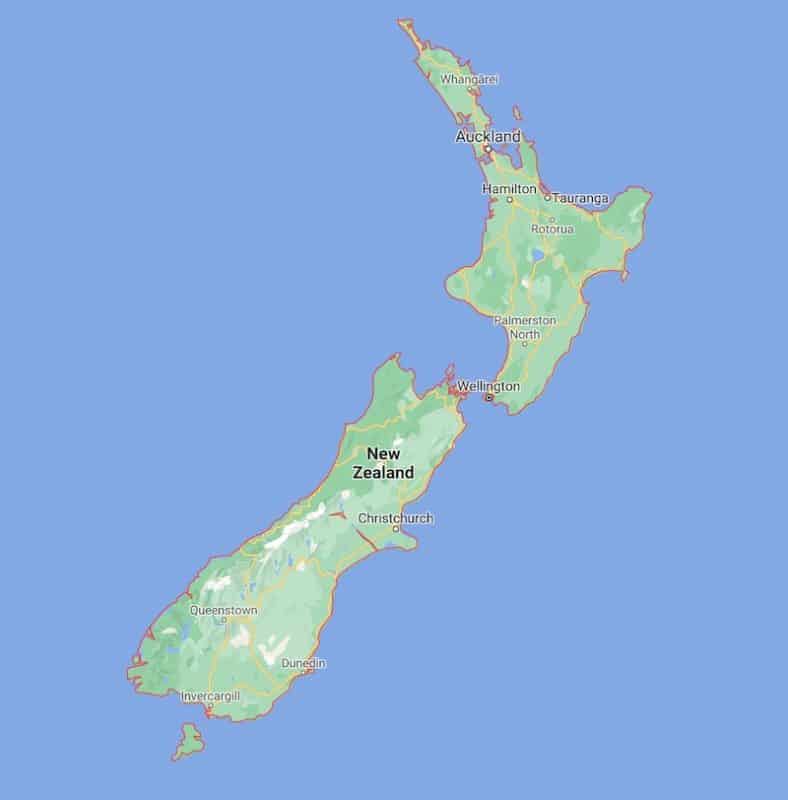
Click here for an interactive Google Map version of the above graphic.
New Zealand Adventure Travel
Looking for a New Zealand hiking guide or adventure travel tips? These posts can help!
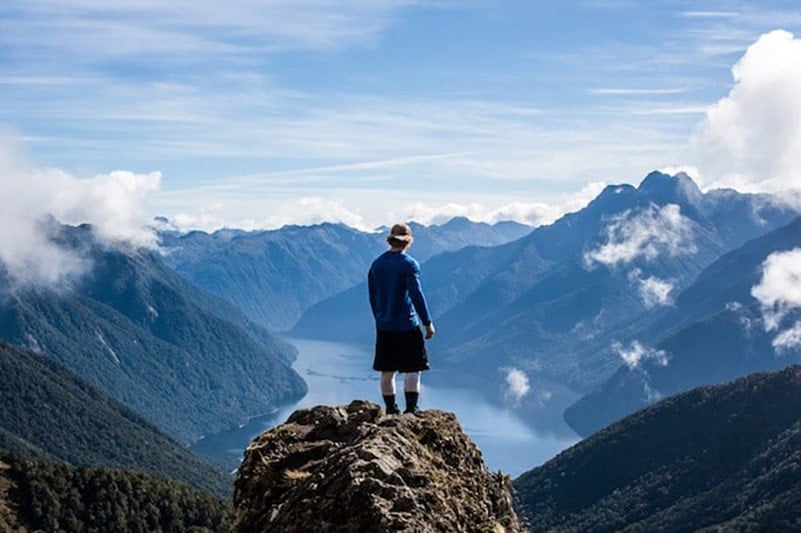
12 Best Hikes In New Zealand You Shouldn’t Miss
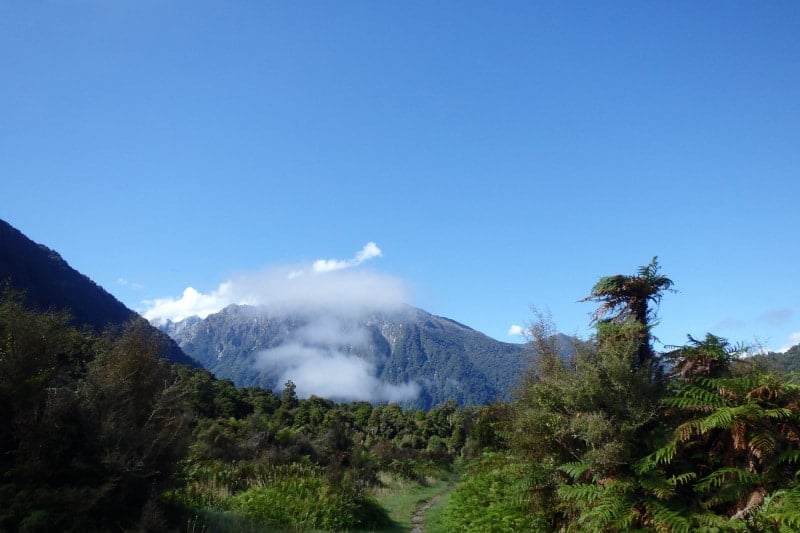
How to Hike New Zealand’s Copland Track to Welcome Flat Hut
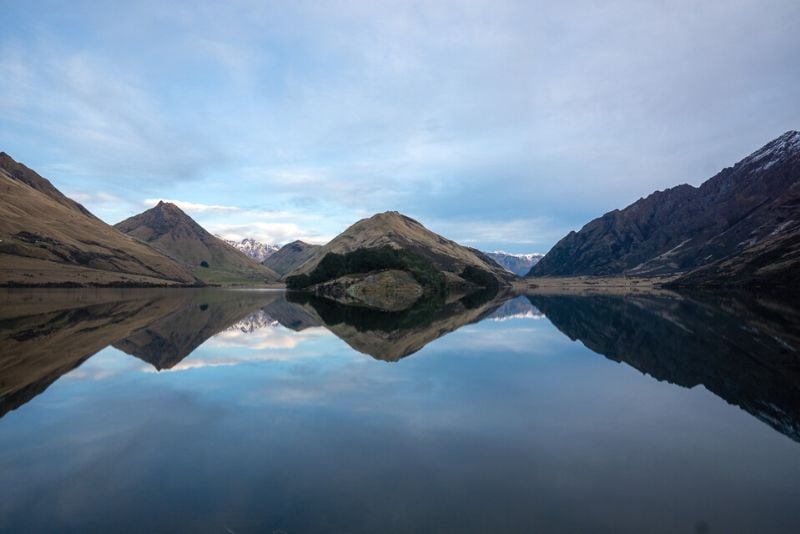
16 Best South Island New Zealand Hiking Trails
Solo Travel In New Zealand
Traveling alone in New Zealand is an amazing experience!
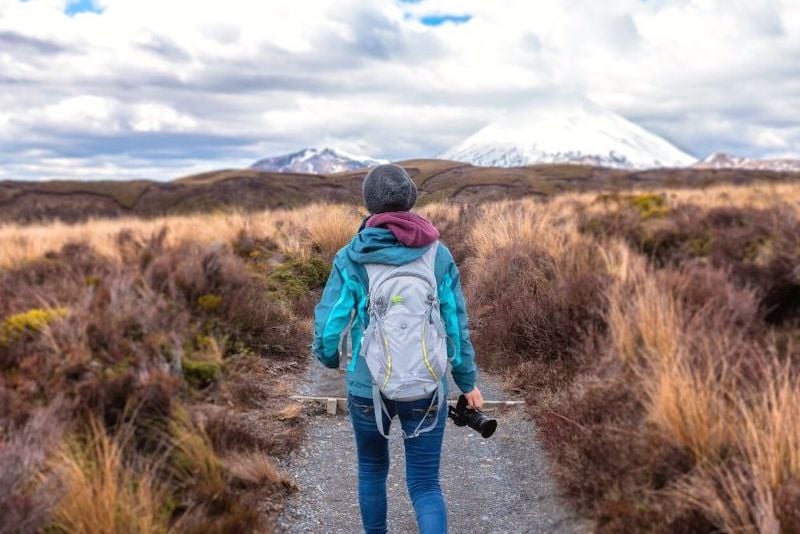
How To Plan A Solo Trip To New Zealand (Ultimate Guide!)
Best Tours In New Zealand
Explore local culture with a New Zealand tour guide through these unique excursions:
- Doubtful Sound Wilderness Day Cruise from Manapouri
- Auckland Dolphin and Whale Watching Eco-Safari Cruise
- Milford Sound Sightseeing Cruise with Scenic Round-Trip Flight from Queenstown
- Franz Josef Heli Hiking Guided Tour
- Lake Wakatipu Scenic Catamaran Cruise from Queenstown
Renting A Car In New Zealand
The best way to travel around New Zealand is undoubtedly by car!
Need a rental car for your New Zealand trip?
Use Discover Cars to quickly compare your car rental options.
New Zealand Hotels
Click here to browse the best New Zealand travel hotels!
Prefer self-contained stays?
Click here to check out unique local rentals!
You can also use this map to search for local stays:
New Zealand Travel Insurance
It doesn’t matter if you’re traveling solo or with a group on a New Zealand tour. When visiting New Zealand — or any other country in the world — make sure to get travel insurance to protect your health and safety.
In my opinion, the best travel medical insurance for travelers is SafetyWing as they’ve got a large network and offer both short-term and long-term coverage — including coverage if you’re traveling for months as well as limited coverage in your home country).
Additionally, SafetyWing is budget-friendly and offers $250,000 worth of coverage with just one low overall deductible of $250.
With coverage, you’ll have peace of mind as you embark on your New Zealand travel itinerary.
Click my referral link here to price out travel insurance for your trip in just a few clicks .
New Zealand Travel Guide FAQ
Okay, now let’s answer some common Oceania travel questions that specifically pertain to traveling in New Zealand .
Q: What are the best things to do in New Zealand?
A trip to New Zealand is all about taking in Mother Nature’s beauty. The country is full of opportunities for outdoor adventures , from white water rafting to bungy jumping to hiking some of the most beautiful trails in the world. You’ll absolutely want to have a few New Zealand hikes on your itinerary — like the epic Copland Track to Welcome Flat Hut !
Hiking enthusiasts will definitely want to visit Queenstown , known as the “adventure capital of the world”. Trek famous South Island hiking trails like the Queenstown Hill Walking Track, the Moonlight Track, or Jack’s Point. Whatever your level of hiking skill, there’s a trail for you.
On Milford Sound , you’ll find some of the most gorgeous fjords in the Southern Hemisphere. Explore the Sound and the surrounding mountains by kayak, boat cruise, or even a scenic flight.
In Northland , you can enjoy gorgeous subtropical beaches and seaside towns. Check out some of the local marine life on a dive or just catch some rays and watch the surfers do their thing at spots like 90 Mile Beach.
You also can’t pass up any opportunity to experience the culture of New Zealand during your trip.
In Rotorua , you can learn more about the Indigenous Maori culture while soaking up the health benefits of the local hot springs. Take in a cultural demonstration at the Tamaki Maori Village , featuring traditional dances and customs (like the famous Haka) and enjoy a hangi feast. You can even stay overnight in a traditional wharemoe (sleeping house) for a truly immersive experience.
The country is also home to tons of great museums that tell New Zealand’s story. The Auckland Museum in Auckland features tons of Aboriginal art as well as artifacts from the country’s long history.
Of course, any Lord of the Rings fan will want to visit some of the locations featured in the famous film trilogy.
The Hobbiton Movie Set in Waikato is probably one of the most popular LOTR attractions, featuring a 1,250-acre re-creation of The Shire, home to Bilbo and Frodo Baggins. See if you can fit in one of the tiny Hobbit homes and enjoy a pint at the Green Dragon Inn.
You can also visit the Weta Cave Workshop in Wellington , where props, costumes, and creatures from films like Lord of the Rings , Avatar, and District 9 are created by some of the most talented creators in the world. You can even take a special effects makeup class and try your hand (pun intended!) at creating realistic-looking wounds for the camera.
Q: What is the best month to visit New Zealand?
New Zealand’s summer season (running December through March) is widely considered the best time to visit. The weather is perfect for outdoor activities during this time, with warm temperatures and sunny days.
You can expect temperatures in the 50s and 60s Fahrenheit throughout the rest of the year, making New Zealand a great place to visit year-round.
The South Island does see some snow in the winter months (June through September), making it perfect for skiers.
Q: How much should I budget for a trip to New Zealand?
The average traveler spends about $129 USD per day in New Zealand on accommodations, transportation, food, activities, and other travel expenses.
Your biggest expense will likely be your flights to and from the country, which can vary in cost depending on your departure city. Keep an eye on flight aggregator sites like Kayak and keep your plans flexible to get the best deal.
Q: Where should I go for my first trip to New Zealand?
A great place to start on your first trip to New Zealand is Auckland , the country’s largest city. You’ll likely end up flying into Auckland Airport as it is the largest airport in the country, so the city makes a great jumping off point for any tour of New Zealand.
Aside from it’s metropolitan vibe, there are tons of natural wonders to explore in the Auckland area. Take a day trip out to Rangitoto Island, a voclanic island with tons of great hiking trails and lava fields to explore.
You can also hike Mount Eden, a dormant volcano offering incredible views of downtown Auckland.
Sailing enthusiasts will want to check out the yachts and boats at Viaduct Harbour, a lively marina that’s also home to some of the city’s best restaurants and bars. The Hobbiton Movie Set is also an easy day trip from Auckland and a must-see for Lord of the Rings fans.
Located on New Zealand’s North Island, Rotorua is the place to go to see some of the beautiful sights the country has to offer and experience Maori culture first-hand.
There are tons of opportunities for adventure in the Rotorua area, from stand-up paddleboard tours on Lake Rotorua to tree walks in the redwood forests. With so many things to do, you won’t have to worry about getting bored!
Worn out from so much activity? Head to one of the local hot springs for a dip in the healing waters and a classic mud treatment that will leave your skin feeling like new.
There are also tons of ways to experience Maori culture in Rotorua as well, from cultural tours to ancient archeological sites to traditional feasts and performances. Rotorua truly has definitely something for every kind of traveler.
Wellington , the country’s cultural and political capital, is also a great place to visit on a first-time trip to New Zealand. The city has a lively arts scene and is home to New Zealand’s film industry, making it the perfect spot for culture-minded tourists.
Wellington is also home to the Museum of New Zealand Te Papa Tongarewa, a large (free!) museum featuring exhibitions on the country’s natural history, Maori culture, art, and more. If you want to dive into the story of New Zealand, this is definitely the place to go.
Just an hour outside of the city you’ll find Wairapapa , one of the top wine regions in the country. You can book a tour to hit a few vineyards in one day or explore the region by bike. Just be sure to bike responsibly after all those wine tastings!
Q: What should I avoid in New Zealand?
As you would when visiting any other country, avoid disrespecting the locals. This is particularly important if you are interacting with the native Maori people at all during your trip. Be aware of lands that are sacred to the Maori people and be particularly respectful when visiting these sites.
It also helps to learn a few Maori phrases before or during your trip — you’ll often see signs written in both English and Maori throughout the country.
Also, be aware that New Zealand and Australia , while often grouped together by travelers, are two very different countries. You’ll see this first-hand if you get a chance to visit both countries. You won’t make any friends in New Zealand by comparing the country to her neighbor, so keep any comments about Australia to yourself.
Considering the digital nomad lifestyle? Don’t expect to get a ton of work done in New Zealand, particularly outside of the cities.
Internet service throughout the country is spotty at best, particularly in the countryside. Don’t rely to heavily on digital maps and other services to get around either. Instead, go old school and bring maps or print out directions when you can.
And if you’re expected to check in with work or folks back home at all during your trip, let them know you might not be as easy to reach as usual, particularly when you’re out in more remote areas.
Hate being limited to a short (or ridiculously long) wine list when dining out? Avoid being limited to a restaurant’s wine selection by bringing your own bottle.
Most restaurants in New Zealand allow you to bring your own wine in for a small corkage fee. This will save you some cash on your dinner bill and ensure that you get to drink wine you actually like.
Tipping also isn’t the norm in restaurants in New Zealand. You can feel free to tip for particularly exceptional service, but know that it’s not expected.
Q: Is New Zealand safe to travel?
New Zealand is widely considered one of the safest countries for travelers. Violent crime is extremely rare and while petty crime like pickpocketing does happen in popular tourist areas like Auckland, it’s relatively uncommon. As in any destination, it’s good to always be aware of your surroundings and keep any valuables close to you and out of view to avoid pickpockets .
Q: How long can a tourist stay in New Zealand?
Travelers visiting New Zealand on a NZeTA (New Zealand Electronic Travel Authority) can stay for up to three months in one visit (six months for visitors from the United Kingdom) and no more than six months in a 12-month period. Travelers on a Visitor Visa can stay in the country for up to nine months in an 18-month period.
Q: Do I need a New Zealand travel visa?
Travelers from the United States , Canada , the United Kingdom and most countries in Europe (specificially the European Union) do not need a visa to enter New Zealand.
Visitors from visa waiver countries do need to obtain a NZeTA (New Zealand Electronic Travel Authority) before traveling to New Zealand, though. You can request an NZeTA online on the New Zealand Immigration website or via the NZeTA app ; the application costs NZD $12 ($8.34 USD) if you apply online or NZD $9 ($6.26 USD) if you apply on the app.
You’ll also pay NZD $35 ($24.33 USD) for an International Visitor Conservation and Tourism Levy at the same time as your NZeTA. Visitors from countries not on the visa waiver list will need to apply for a visitor visa before traveling to New Zealand.
It’s recommended to view your country’s New Zealand International Travel Information page for the most up-to-date information on entry and exit requirements. You can also contact the New Zealand Consulate-General.
Q: Where is New Zealand?
New Zealand is an island country featuring numerous smaller islands and two main islands, including the the North Island (Te-Ika-a-Maui) and the South Island (Te Wai Pounamu), which are separated by the Cook Strait.
The country is located in the South Pacific Ocean in the region of Oceania.
Q: Are credit cards accepted in New Zealand?
Credit cards — particularly Visa and Mastercard — are widely accepted around New Zealand, though it is always wise to carry some cash for smaller establishments and in case of emergency.
Q: Can you drink the tap water in the New Zealand?
It is safe to drink the tap water in New Zealand, though do double check with your hotel to be safe.
Q: What is the local currency in New Zealand?
The local currency in New Zealand is the New Zealand dollar, which is also sometimes known as “the kiwi”.
What would you add to this New Zealand travel guide?

Enjoyed this ultimate New Zealand travel guide? Pin it for later!
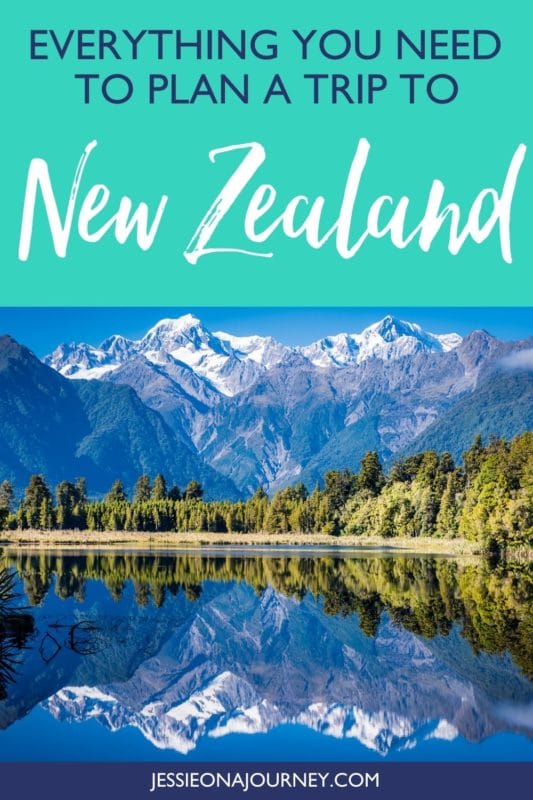
Going Awesome Places
Detailed itineraries + travel guides
The Comprehensive New Zealand Travel Guide – Read Before You Go
Last Updated April 19, 2023 William Tang
You are here: Home » Travel Guides » The Comprehensive New Zealand Travel Guide – Read Before You Go
Are you planning a trip to the land of hobbit holes, misty white-capped mountains, creaking glaciers, thunderous falls, mysterious rocks, and black sand beaches? New Zealand is a wildly gorgeous country with a kind soul, and adventurous spirit but I think you already knew that.
After completing my second trip to this land home to the Kiwi, we wanted to put together an ultimate guide for travelling New Zealand that covers the basics before diving deep with the full 3 week itinerary .
More about New Zealand on the blog
- Top 10 things to do in New Zealand’s South island
- 5 New Zealand souvenirs to pick up before you leave
- Top 5 things to do in Queenstown
- What to pack for a trip to New Zealand
- Best places to stay in New Zealand with Hilton
- How to visit the Hobbiton movie location
Looking for car rental deals?
- Make sure to read our comprehensive New Zealand travel guide which includes car rental companies to consider. We personally booked from Hitch. Also make sure to educate yourself on car rental coupon codes which’ll surely save you a ton of money.
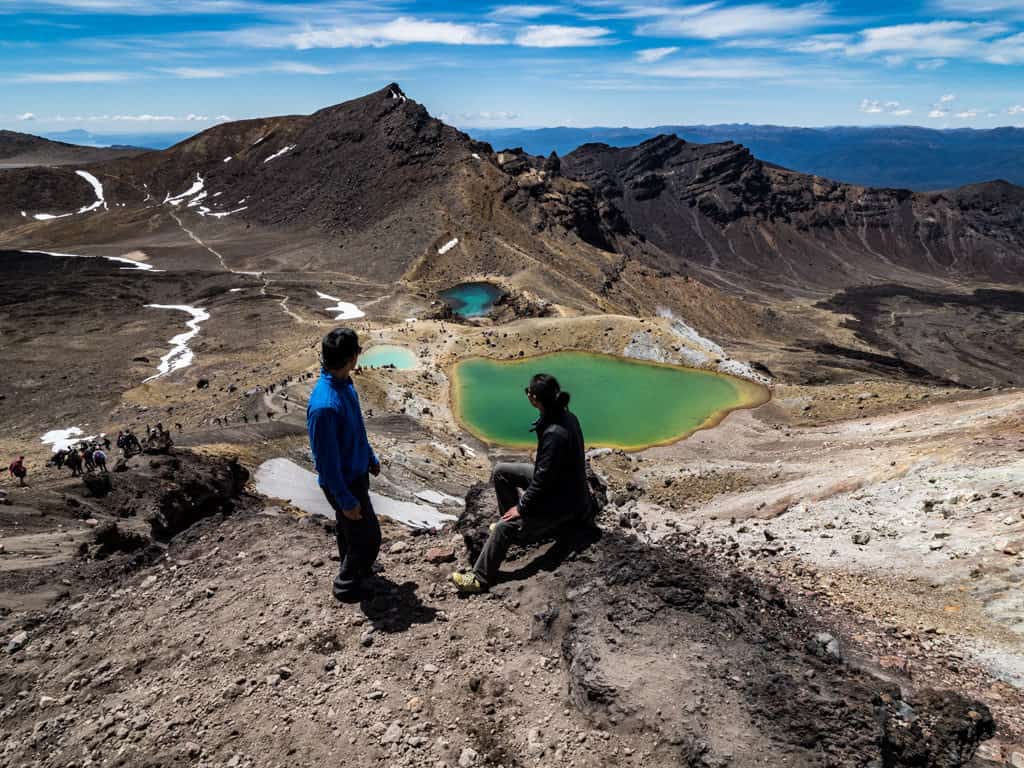
- Table of Contents
Jump to the topics that you’re most interested in.
In This Article
Getting there
New zealand biosecurity, getting around, where to stay, new zealand geography, what to pack for new zealand, best time to go to new zealand, how much does a trip to new zealand cost, what you need to know about cellular data, popular tours to consider pre-booking, 5 main take aways, the new zealand travel guide.
- $1 NZD = $0.67 USD = $0.92 CAD
- ATMs can be found all over and the credit cards are widely accepted
- SIM card – The two main companies in New Zealand are Spark and Vodafone . Both are essentially identical but with Vodafone, you can pick up SIM card packages for tourists at the airport tax-free. You get 3GB of data and 200 calls/texts for NZ$49 which is valid for 2 months.
- Alternative data options – Skyroam is what I used throughout my time in New Zealand. This is a wifi hotspot that you can share with your travel companions and I essentially strategically activated 24 hour day passes of unlimited data($9 USD) when I needed it and relied on free wifi (read my full review ).
- Unit of Measure – Meter
- Tipping – No expectation for tips
- Language – The official languages are English and Māori.
Back to the top
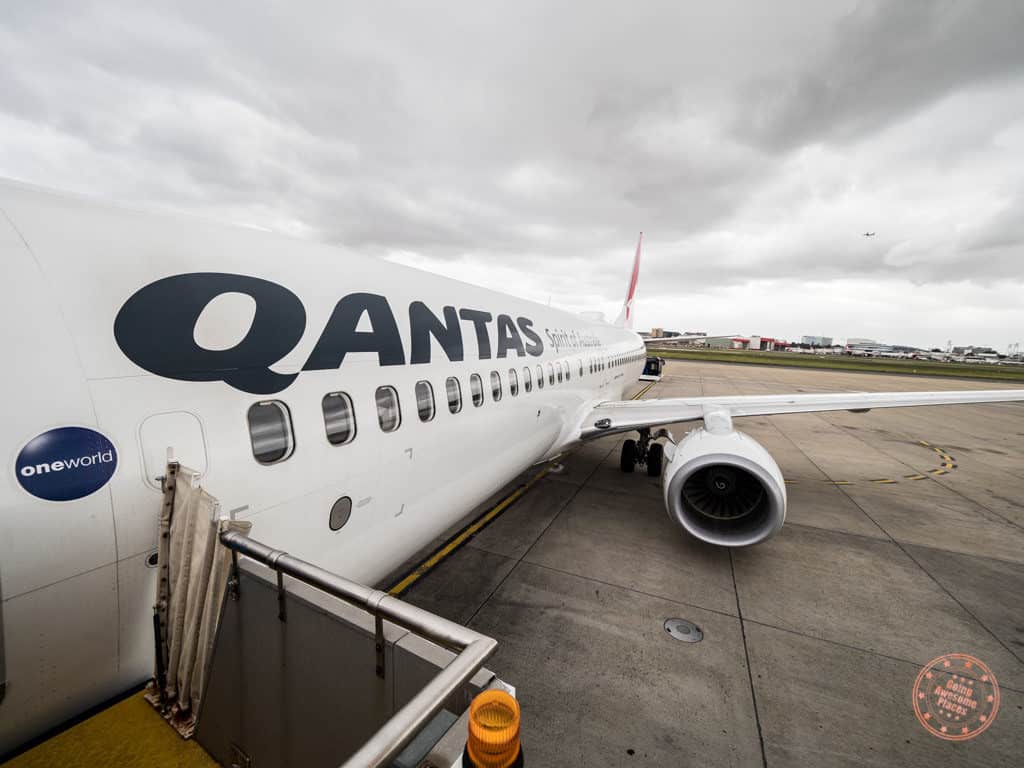
New Zealand’s primary international airport is Auckland Airport (AKL) and I’d say is the main hub of the country where you’ll find most carriers go through. This is the airport that you’ll most likely be connecting through if you want to get to other parts of the country.
Other main airports that you’ll likely want to try to fly into are Wellington (WLG), Christchurch (CHC), Dunedin (DUD), and Queenstown (ZQN). There are of course smaller regional airports but most of those are used when flying inter-country (i.e. Rotorua, Nelson, Hamilton, New Plymouth etc.)
If you’re coming from Australia, you’ll have more options available to fly into your city of choice. Sydney will be your best bet to have the most flexibility in flights.
If you’re coming from North America, almost all direct flights originate from the West Coast so you’re looking at either San Francisco, Los Angeles, or Vancouver.
Qantas and Air New Zealand are the main national carriers to look at but you also have the low cost carriers such as Virgin Australia and Jetstar. I recommend using the Skyscanner to find the best prices on flight tickets and be able to put alerts and trackers if you’re starting to plan early. The Skyscanner app is also super helpful.
Hack: Using Skyscanner, I found out that LATAM Airlines has a route that goes through Auckland enroute to Sydney. The ticket prices for this even last minute were extremely cheap and a great option.
For any other country, this is a “same as usual” but as we learned on our trip, New Zealand has taken their biosecurity to another level and I don’t blame them. As an island nation, their ecosystem is quite delicate and needs to be protected or else some of the current issues that they face including toxic pine needles, rampant growth of stoat and possums, and tree killing virus, will only be the tip of the iceberg.
As a result, New Zealand has to have the most scrutinizing screening process that I’ve seen anywhere in the world.
My recommendation to be as honest as possible even if that means checking off any of the biosecurity boxes on the passenger arrival card. When that happens, you’ll be put in a separate line to see a quarantine officer. They’ll ask questions about those items in question and they’ll either clear what you have, clean and treat them (at your own time and cost), or confiscate them.
Once you’re clear, you’ll get back to the regular line where you’ll go through another x-ray check. There’ll also most likely be beagle dogs going back and forth but they’re pretty cute.
Oh and there’s a chance that an officer might approach you near the gate with questions with random questions of things such as where you came from and your intention in the country. They even went even deeper with some questions that surprised us such as “when did you buy your plane tickets?” and “what is your occupation?”
What I’ve done is compile a list of things that you really want to be very careful with when travelling to the country that’s outside of the norm. Remember, as nice as they are, custom officials don’t mess around .
“Any food: cooked, uncooked, fresh, preserved, packaged or dried?” & “Animals or animal products: including meat, dairy products, fish, honey, bee products, eggs, feathers, shells, raw wool, skins, bones or insects?” & “Plants or plant products: fruit, flowers, seeds, bulbs, wood, bark, leaves, nuts, vegetables, parts of plants, fungi, cane, bamboo or straw, including for religious offerings or medicinal use?”
- I don’t know how you can also the card truthfully without having this checked off. Does gum count as food? Certainly granola bars and candies do right? Don’t risk it, just check it off.
- If you take a look at New Zealand’s biosecurity items-to-declare guide , you’ll see a full list of what you’re not able to bring.
- Declare all of your own medication that you have packed.
- A very Chinese thing to have is dried orange peels but in the end they let it go because it’s glazed with sugar. From their tone, it seemed like if it was prepared another way it could’ve been grounds for confiscation.
- Chinese herbal medicine for upset stomach – They x-rayed the bottles and read the ingredients (luckily there was English on them). They were good with it in the end.
- Recommendation: I’d avoid bringing any foreign language medicinal things because they were surely get flagged. If you want to be safe, just don’t bring any of Chinese herbal medicine.
- They’re very sensitive about honey as you can imagine so avoid that as well.
- Definitely don’t bring any animal products (i.e. crocodile handbags and fur hoods ) – Yes, if you have any real fur on your hoods, don’t bring it.
“Items that have been used for outdoor activities, including any footwear, tents, camping, hunting, hiking, golf or sports equipment?” & “Equipment used with animals, plants or water, including for gardening, beekeeping, fishing, water sport or diving activities?”
- The main ones that’ll apply most likely are your shoes and if you brought any camping gear.
- They’ll inspect the sole of your shoes for soil and seeds – I’d recommend that you clean your shoes thoroughly before travelling especially if you’ve gone outside of the city with them
- Your officer will also ask where the equipment has been in the last X number of months.
At the end of the day, it was a bit of a hassle but didn’t add too much additional time from the people that went into the regular line. It’s not worth risking the instant NZ$400 infringement fee. When in doubt, use the “can I bring it into New Zealand” page .

New Zealand’s transportation infrastructure is really well done and so there are a variety of ways to get from place to place. That said, with how rural most of the country is, you’ll likely be relying on some sort of vehicle to see the country. Now whether you do this on your own or with a company, that’s something you’ll have to weigh during the planning stages of your trip.
If you’re going to be doing your own road trip, the good news is that there are plenty of car rental companies available to choose from. What you may not know is that instead of looking for the usual big name suspects, you’re going to be better off booking with the local brands in New Zealand if you want the best price.
A few companies to mention are: Gorental, Lucky, Jucy, Hitch, Apex, USave, Ace, Omega .
I personally found that out of all the companies that we price compared, Hitch offered the cheapest rates for an economy hatch. The other surprising thing was that it was automatic transmission too. The only draw-back is that Hitch only operates out of Auckland, Christchurch, and Queenstown Airport locations.
If you’re more comfortable with the more well-known companies, don’t forget to head over to the page that contains all the best car rental coupon codes .
Pro: Ultimate flexibility, plenty of personal space to transport everything that you have.
Con: Energy and effort to do all the driving, parking in the cities, lots of trip planning and preparation, still need to book your own accommodations (if not camping), gas prices are expensive.
Heads up: You cannot take your car rental from North Island to South Island or vice versa through the Interislander Ferry across the Cook Strait. This means you’ll need to book a separate car rental for each island.
Campervan rental
The rise in popularity of campervans as a way to travel has to come from New Zealand because it’s the first place second to Iceland where I’ve seen them in use everywhere. Of course, I also can’t leave out the RV which is also a very popular way to get around the country.
Similar to a car rental, the full freedom of planning your route is the best part of this mode of transportation because you’re not necessarily limited to fixed hotels. New Zealand has a really good system of being able to drop into certain camp grounds and paying on the spot by putting money in a metal box. Alternatively, there are also a ton of trailer parks/holiday parks where you pay for a designated spot to park and you get access to all the facilities. It’s like camping except you’re sleeping in your car instead.
From a budget perspective, campervans are much cheaper when compared to RV’s. Still, you’re looking at roughly NZ$50 a day compared to NZ$15 a day with a car. Also, one way rentals are possible.
Pros: Ultimate flexibility, ability to park and sleep anywhere or use low cost holiday parks, save money
Cons: Additional fuel consumption, more expensive rental rates
New Zealand has a network of buses called InterCity. Simply put, it’s kind of like what Greyhound is in North America or FlixBus in Europe – long haul busses that can take you to anywhere in the country.
Without going into too much detail about all the different pricing, fare, and schedule options that are available, one of the best options is to look at something called the InterCity FlexiPass which you can think of like a hop-on-hop-off pass that’s based on time. Calculate how many hours you think you’ll need and purchase the appropriate package. With this pass, you don’t necessarily need a fixed itinerary in place. You book online on the fly and is valid for 12 months.
Note that this is also good for use with the Interislander Ferry between Picton and Wellington and day tours with GreatSights and awesomeNZ.
Pros: Price point, good for the more serious backpackers
Cons: Not door to door (how do you get to your eventual destination), more logistic planning required in terms of route booking and schedule, still need to book accommodations, limited by the network of stops
Taxis and ride share apps like Uber only apply in the big cities. While pretty self explanatory, the only thing I’d like to add here is a note about what I learned about Uber.
If you’ve read the top 5 things to do in Queenstown , you’ll know that Uber was only introduced in 2018. As a result, there are some complications in terms of being able to get direct pick ups from the airport there.
The other thing to note is that the standard booking fee in New Zealand with Uber is NZ$0.55.
Pros: Door to door service
Cons: Expensive, may not do pick ups directly from the airport
Public transit
Each of New Zealand’s larger cities will have their own public transit. For instance, in Queenstown there’s the Orbus Queenstown Bus and this is different from say Auckland’s bus/train/ferry system. By that same token, Queenstown uses a GoCard and Auckland has the HOP prepaid card .
One thing we learned when we were in Queenstown is that without one of these transit cards, the prices increase dramatically. Cash fare from the airport is NZ$10 and everywhere else is NZ$5. You can pick up a card for NZ$5 at the Queenstown airport which may be worth it if you plan on taking the bus a lot since the fares drop to NZ$2 for all routes including the airport.
Pros: Can be a cost effective option in the city where it doesn’t make sense to have car
Cons: Increased wait time, not necessarily cheaper especially if you only take it once or twice without a card
If you need to quickly get from one end of the country to the other, flying may be your best option. When you search on Skyscanner , you’ll be surprised to see how cheap the one-way fares are. They’re almost always less than $NZ100 so it can be a very cost effective way to hop around the country.
Pros: Fast, not necessarily cost prohibitive
Cons: Hassle of flying, skip the best parts of the country which aren’t in the hub cities
A note on filling up petrol in New Zealand
There’s something unique we encountered at petrol/gas stations in New Zealand. While we were told by a local that gas prices should be uniform throughout the entire country, the truth is that they’re not. What was even more bizarre to us was that it seemed like the gas stations that were by the highway were actually cheaper than the ones in the city.
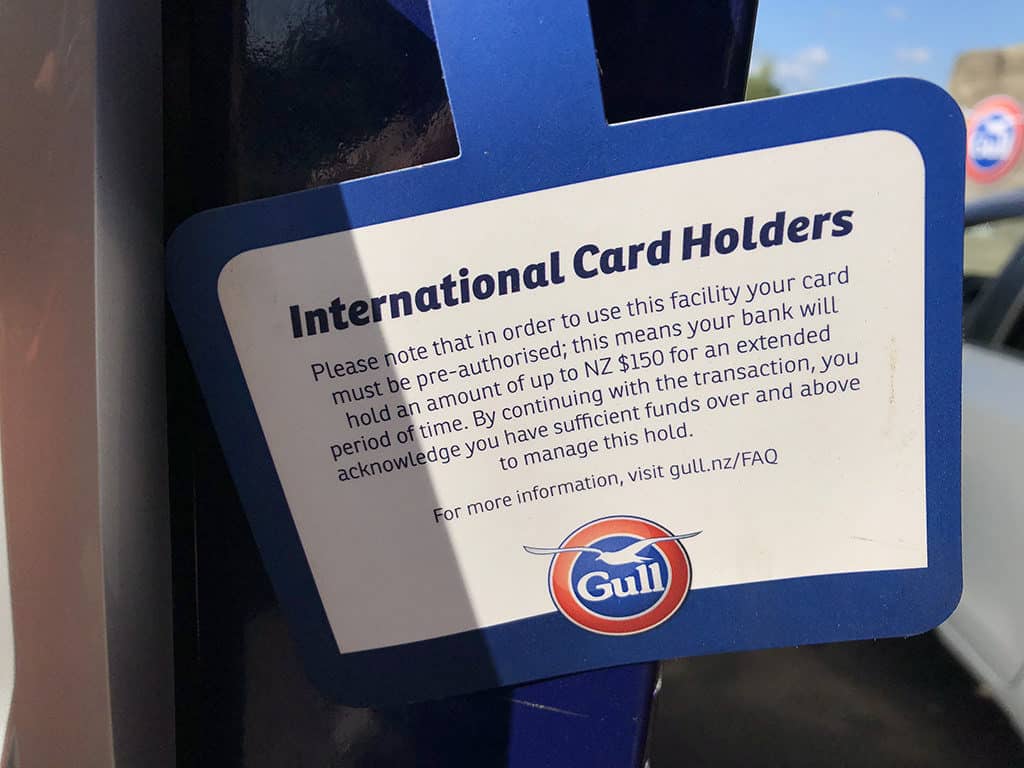
We then learned why:
- Almost none of the gas stations with super low rates by the highway are manned which means you have to use the machine.
- For international card holders, the machines automatically take a NZ$150 hold
- At first the above freaked us out because we thought that meant it would charge a full NZ$150 and then return the difference to what you actually filled back in NZD (double whammy on currency exchange) but when we checked our credit card statements I didn’t see any charges for NZ$150, just the amount that we owed for the gas we filled up.
Conclusion: Behind the scenes it they may do a full NZ$150 hold so make sure you’re not close your limit but there’s no worry in terms of dealing with currency exchange madness. With that said, there’s really no reason why you wouldn’t use these gas stations that have cheaper rates. Just know that you won’t be able to speak to anyone if your credit card is rejected by the machine or anything like that (it’s pre-pay, similar to Iceland ).

What you need to know about New Zealand is that aside from perhaps Auckland, you’d be hard-pressed to find large chained hotels. You learn pretty quickly that you’ll be spending most of your time passing through small towns and as such, you’ll be relying heavily on bed & breakfast, hostels, holiday parks, and Airbnb.
With the exception of the days in the New Zealand 3 week itinerary that you’ll be travelling with Flying Kiwi , you’ll find a set of recommended accommodations that I personally stayed at or were high on my list during my research.

New Zealand started off as a haven for backpacker and so it makes sense that the country has so many hostels. If you’re a backpacker, I don’t need to say anything more. If you’re a traveller looking for more comforts, I’d say that there’s nothing wrong with looking for a private room in a hostel. We were very impressed with most of the hostels we stayed at and for the price point, we were willing to “rough it out” whether that meant a shared bathroom, spartan rooms, or communal kitchens.
Tip: At the YHA in Te Anau , we noticed that reception closed at 7:30PM and if you arrived afterwards to check-in you’d be charged NZ$20 to call someone in as a non-emergency. Something to keep in mind.
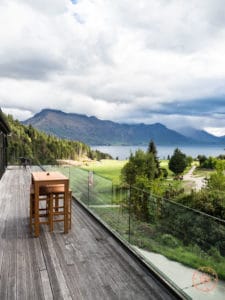
When it comes to B&B’s, and the kind of places that we associate with Airbnb, you’d be surprised with how many New Zealand guest homes that they have in their inventory.
From personal experience, I can often find better properties than I can on Airbnb on Booking.com . The other big bonus is that Airbnb isn’t that friendly when it comes to cancellation whereas with on Booking, properties with free cancellation make it easy to “hold” a room without feeling like you’ve locked yourself in.
New Zealand Guesthouses
Holiday Parks
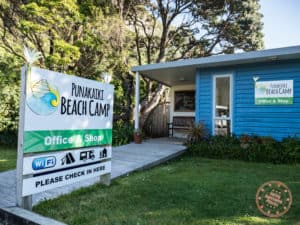
These are unique alternative accommodations that can be found all over the country. They are great for the budget traveller and often offer a variety of options that range from motel-like rooms, cottage units, cabins, and RV sites.
These were the typical type of places that we would stay at with Flying Kiwi where our bus would be able to drive in and we’d set up camp on their grounds. It’s the holiday parks that provide all the facilities that we need including kitchen, lounge, power, laundry, and bathrooms. These are typically all communal.
You’ll find that holiday parks are in prime locations (i.e. next to the beach or steps away from the Abel Tasman National Park)
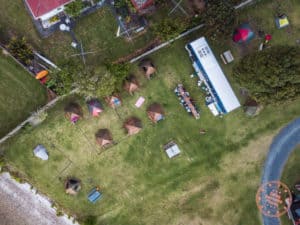
While you can go camping at holiday park sites, I’m referring to more of the national parks that offer open campsites. The Department of Conservation (DOC) manages this and there are both campsites that require reservations and others that don’t.
For campgrounds, these are the standard campsites where you’re able to drive into and pitch a tent in one of several designated spots. There are then the huts, lodges, and campsites for when you head into the backcountry for let’s say something like the Milford Track.
Campsites that don’t require reservation will usually have a box for payment and is on a first-come-first-serve basis.
These are great for those that are looking to do a lot trekking, have a campervan/RV, or plan to camp all the way throughout New Zealand.
Curious where our favourite place we stayed was? More on that below but I highly recommend Arthur Street B&B in Whitianga of the Coromandel Peninsula
New Zealand is such an amazing country to explore because of how geologically diverse it is from top to bottom and how compact it is when you compare it to my home country of Canada. That’s why it is the perfect place to drive through and be able to do it in as little as 3 weeks.
While it’s all easy to see everything you want to, having an understanding of the two islands, and how the landscape differs from one to the other can help you in your trip planning.
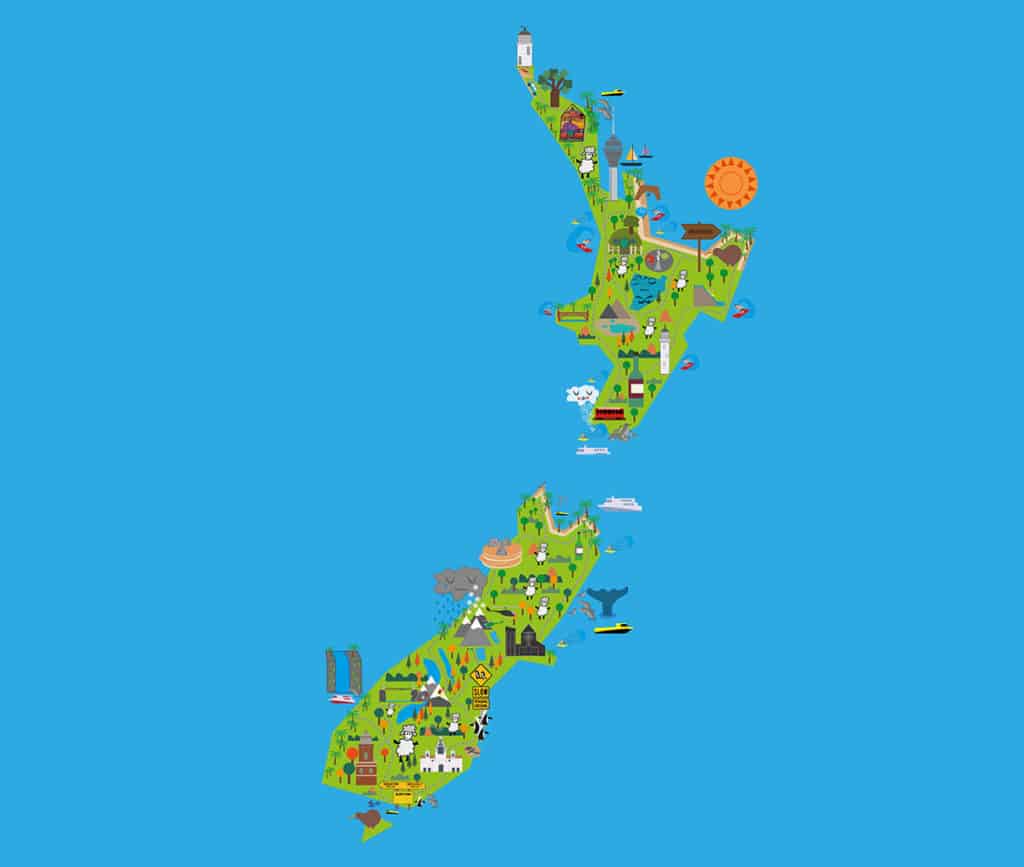
Here are what I observed as the main differences between the two islands.
North Island
- Often the less popular of the two island but as such, offers a lot of hidden gems that aren’t as well known
- Bay of Islands is a tropical paradise filled with beaches, laid back towns, and dotted with small islands which makes it perfect for sailing trips
- A majority of the land is zoned for farming and so you’ll find significantly more grazing plains and rolling hills
- You’ll notice more cows than sheep here
- A hub of geothermal activity that starts in Rotorua but can be found in places like Taupo and Hot Water Beach of Coromandel Peninsula
- Less mountainous of the two islands but you can’t forget about the dominating peaks of Mount Taranaki and twin peaks that are part of the Tongariro Crossing
- Auckland and Wellington are the two big cities of the island and are found on near opposite ends
- Noticeable warmer weather when comparing to the South Island
South Island
- Significantly more dramatic if you factor in how you’re looking at mountain ranges here instead of single mountain peaks, and you have the fjords. This is what makes the size and scope that much larger in the south
- There seemed to be more sheep in the south but I wonder if that is just because of the areas we drove through
- Adventure capital of Queenstown is a pretty big deal all season round
- The weather tends to more variable in the south and noticeably cooler
- Filled with rugged landscape
- Has the advantage of having a few of the most iconic national parks in New Zealand – Fjordland National Park (Milford Sound), and Abel Tasman National Park.
- The two major cities in the south are Queenstown and Christchurch
What joins the two islands is a ferry service called Interislander Ferry that runs between Picton in the south and Wellington in the north and through the Cook Strait.
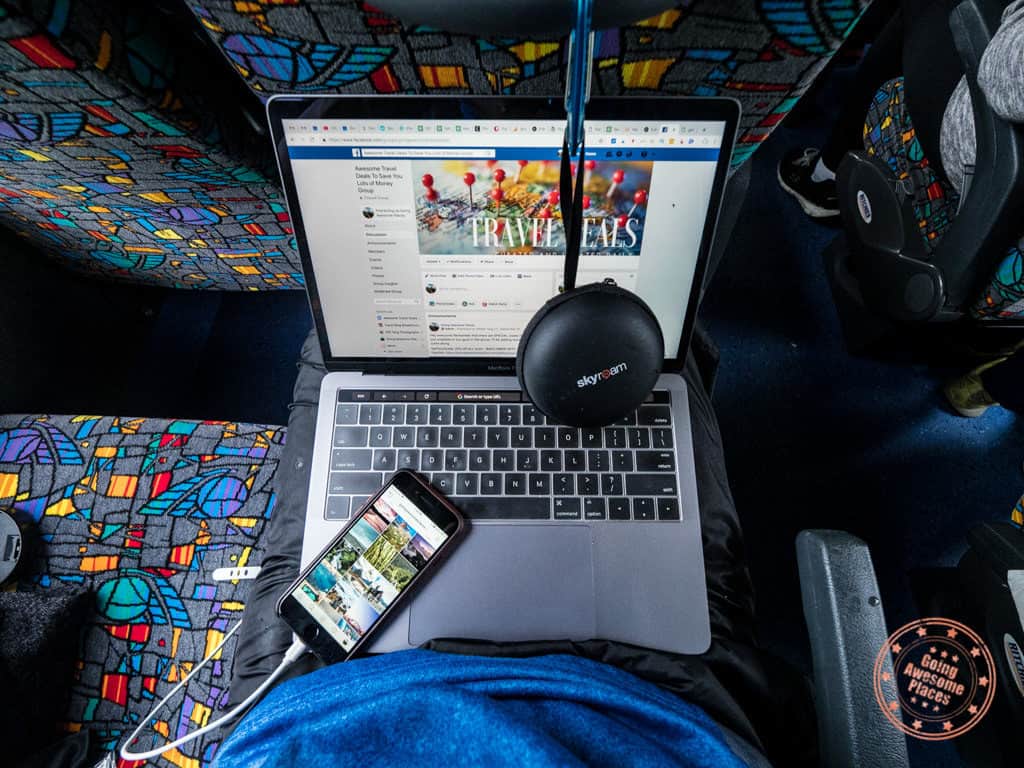
Looking for a packing list? I got you covered. Prior to leaving for our trip to New Zealand I meticulously catalogued everything that I brought and also analyzed post-trip what was a bad idea and what I wish I had brought.
Check out the full New Zealand packing list for the full details.
As always, I leave you with these top 3 recommendations:
- Pack layers and versatile clothing
- Bring lots of batteries and memory because New Zealand is so damn photogenic
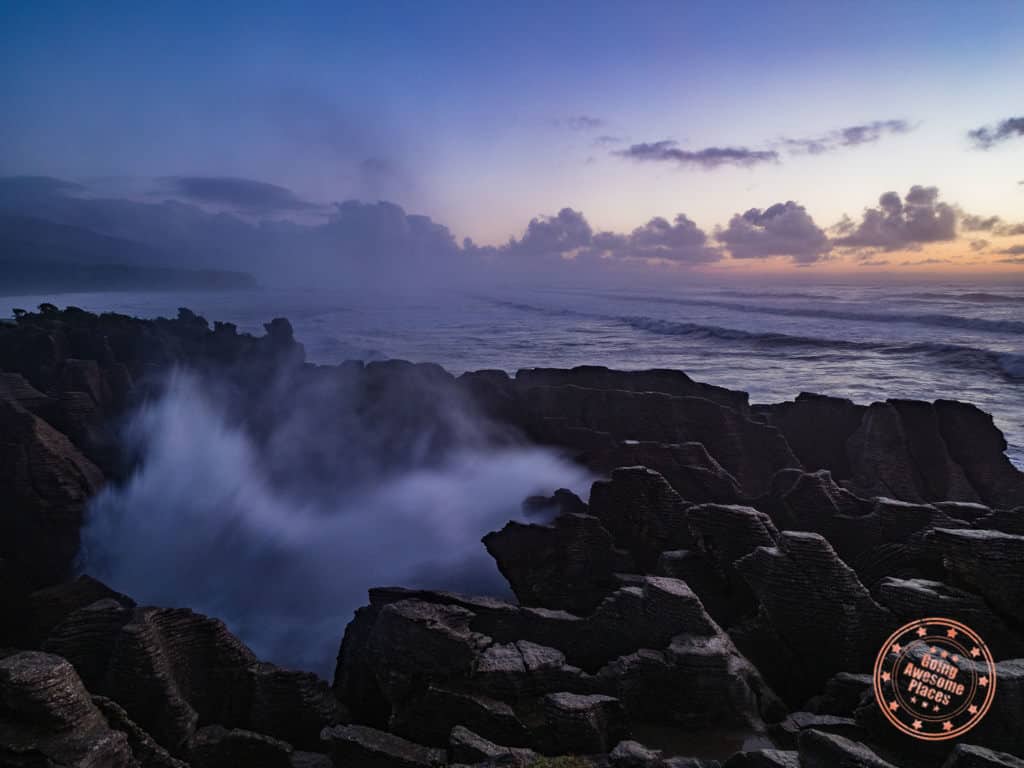
First you have to wrap your head around the fact that New Zealand is in the Southern Hemisphere and as such everything is opposite to what you’re used to if you’re coming from the Northern Hemisphere. Not only are the seasons reversed, you also have to keep in mind that further north you go, the warmer it is. Trust me, it takes awhile to get used to that fact.
Summer (December – February)
When a big part of the world is freezing, summer is on full blast during these 3 months and is of course a very popular time to go to New Zealand because the weather is very warm and you won’t see too much rain. The only thing to consider is that this is also when Kiwis take time off so you will inevitably be in the thick of high-season.
Fall (March – May)
The Fall season is a beautiful time to be in New Zealand as the temperatures start to cool off and so do the prices and crowds. Head to the south island and in Queenstown, Central Otago, and Christchurch to see the spectacular autumn colours. The best part about this season that you’ll likely still be wearing summer clothes if you find yourself in Auckland or further up north in the Bay of Islands.
When you combine lower airfare, cheaper accommodations, good weather, and smaller crowds, this is one of the best times to go. For those that hike, many of the main tracks are all open and easier to book as long as the weather holds up.
Winter (June – August)
While it may not get as cold as Canada does in the winter, Queenstown and the lower portion of the South Island become a bit of a winter wonderland. That is what makes it the perfect time to hit the slopes. There’s definitely novelty to be skiing or snowboarding in July for those that are from the Northern Hemisphere.
If you’re not interested in winter sports, this is probably the least favourable season to come to New Zealand just because of the limitations in terms of what you’ll be able to see, seasonal closures, and the cold. New Zealand homes aren’t well-insulated so staying layered and bundled is important.
Spring (September – November)
Spring blooms, warming weather, baby lambs are balanced with fickle weather but all-in-all, this is a great shoulder season to come to New Zealand. You’ll be able to enjoy the full experience without the crowds and peak prices.
It’s quite the sight to see the countryside flush with green grace and flower in abundance. Just make sure to be prepared with waterproof gear because you never know when it might start dumping on you as it did for us in November.
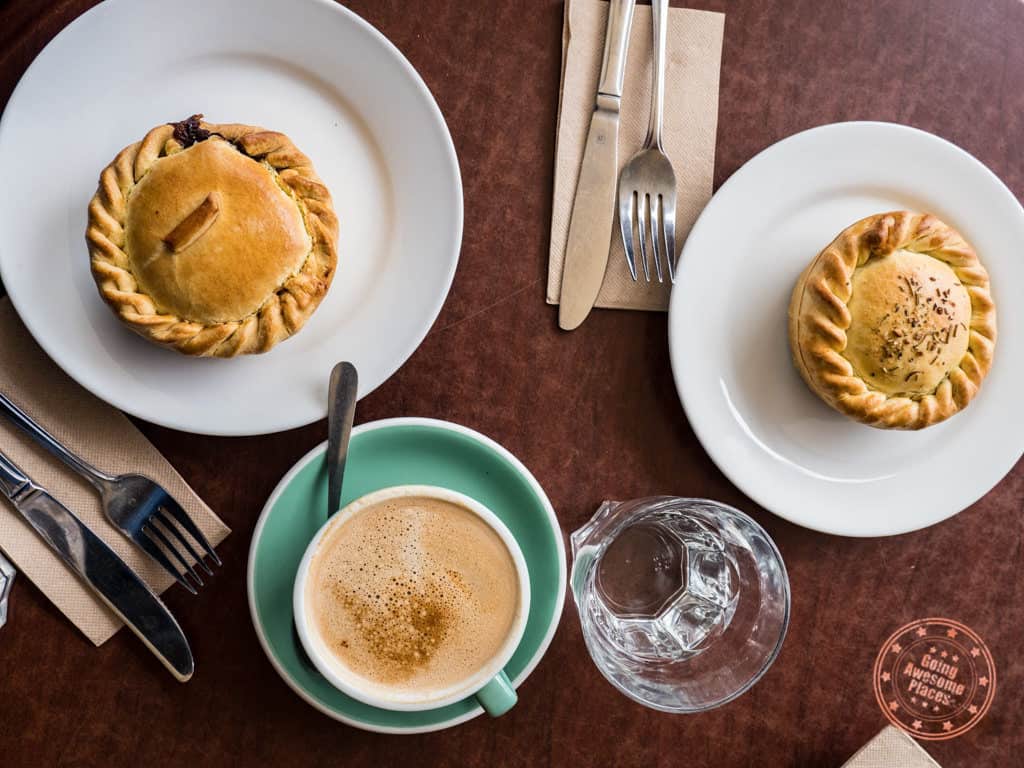
I’d be the first to tell say that out of the many places you can travel to around the world, New Zealand isn’t going to be the cheapest option. With a high standard of living, healthy influx of tourism, remote location, and vast rural landscape, prices for food, lodging, and transportation are just as high as in North America and Europe, if not more. The good news is that the country’s travel industry was built on a backpacker foundation and so there are a lot of options for the budget-minded.
On the flip side of the coin, while there are luxury options available, they are few and far between once you head out of the major hubs. Look hard enough at, you can certainly find luxury properties in New Zealand which are very unique and appropriate to the landscape. I’d say that those looking for a “finer things” experience will be able to find it but for most, New Zealand is very much of place with plenty of low to mid-tier spend opportunities, with some leaning more towards “roughing it”.
The most expensive part of your trip will most likely be the flight itself because it’s just so far away from almost every country unless you’re their neighbour, Australia. Flights can easily run you over US$1,000 and will also involve very tiring few days to get to New Zealand.
On average, actual daily spend per person based on our own trip was at least US$100 a day which includes accommodation, transportation, food, and activities. What this doesn’t include are the flights and our Flying Kiwi tour which cost just over NZ$2,500 per person.
What makes every day expensive
- Gas rates are very high
- Food at regular casual restaurants are expensive – expect to spend at least NZ$20 per person for dinner
- Excursions and activities add up and New Zealand’s the kind of place where you’ll want to do it all
- Accommodations
How to cut costs
- Find a cheap car rental
- New Zealand isn’t known for it’s cuisine (unless you opt for luxury) and so you’re better off cooking your own food
- Accommodations can be cheap if you camp or use hostels you find on Hostelworld
- Plan ahead and if you’re on a tight budget, pick and choose activities that are “must-do” and look for alternative free activities for the others
- Tours like Flying Kiwi not only make your planning easier but the nature of the type of trip it is means you’ll be staying on a path of reasonable spend

So far I’ve already talked about options for getting access to data. There’s either the traditional SIM cards you can get once you land at the airport with Vodafone or Spark, there’s the wifi hotspot option with Skyroam , or you can rely on free/paid wifi.
My recommendation is to stick with something like Skyroam especially if you’re going to be visiting additional countries to New Zealand. I love that I can just hop off the plane, activate my day pass, and be ready to hit the ground running. On top of that, I can share with my wife. They’ve also made tweaks to their unlimited data policy where there’s no throttling anymore so as long as you’re not hogging up the bandwidth, you can use as much data as you want.
Of course, all of these cellular data options rely on having solid signal strength. What is not so obvious from reading other travel guides out there is that there are still significant pockets of areas especially in the South Island that are blackout from 3G and 4G. If you take a look at coverage maps for Vodafone and Spark and filter on 4G, you’ll get a good sense of how sparse data availability is especially on the western coast.
Why is this important? This is especially important if you’re relying on your phone’s data to navigate. My recommendation is to leverage Google Map’s offline capability , and do your homework in advance by drop pins on your map app and start your navigation where you have data.
In addition, take screenshots of your digital tickets. I also find using Google Sheets helpful for trip planning since it has offline capability.
To offset this, I was pleasantly surprised with how easy it was to find free wifi in each of the towns we dropped by.
Now if I were to list all of the best activities in New Zealand, this would be a never-ending post so why don’t I focus on the activities that I highly recommend that you do your research ahead of time and book months in advance. These are incredible experiences that you don’t want to miss .
Hobbiton Film Set
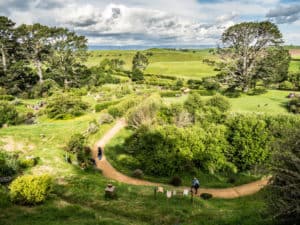
If you’re a fan of Lord of the Rings like I am, you’re going to go nuts for the actual set for Hobbiton. From seeing Bag End, opening the round door of 40 Bagshot Row, being on the grounds of the big party, having a pint at the Green Dragon, and passing by Sam’s hobbit hole, this is definitely a highlight to any trip to New Zealand.
The reason why I recommend booking well in advance is because during the high season, the time slots fill up fast despite tours running every 5 minutes. Even more important is if you want to do the tour of Hobbiton at dusk with dinner feast . You can book a variety of day tours to Hobbiton from Auckland on Viator or GetYourGuide which can include stops to even the Waitomo glowworm caves.
WANT TO KNOW MORE ABOUT HOBBITON?
Make sure to catch our full guide on the Hobbiton experience in the North Island of New Zealand
Hobbiton Movie Location
Milford Sound
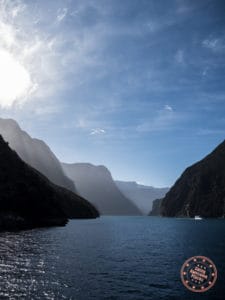
The grand scale of Milford Sound cannot be described with words. You just need to go. The best way to see the fjords including the waterfalls, seals, black coral, and Mitre Peak is by cruise boat or by kayak , or even better do both .
In order to get to Milford Sound, you can drive there yourself. It’s much more reasonable to do the drive from Te Anau in the morning but it is certainly do-able from Queenstown. Alternatively, there are day tours from Queenstown that are super convenient.
It’s recommended to book early because the cruises do fill up quickly especially with the number of large tour buses that make it up there every day. Lock it in early because it would be a shame to miss out on one of the biggest highlights of New Zealand .
Diving in the Bay of Islands
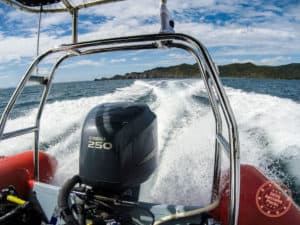
You probably didn’t even know you could dive in New Zealand. It’s a hidden secret but if you’ve got your diving certification or looking to get one, take advantage of the tropical paradise that is the Bay of Islands. The premiere dive shop to look for is in Paihia. Book a dive trip to get up and close to Greenpeace’s Rainbow Warrior or the HMNZS Canterbury .
If you’re interested in going scuba diving, send out a request to the Paihia Dive team to see if the specific trip you want is running on a specific day as they aren’t necessarily daily. In speaking with the owners, if you put a specific request in, they could tweak the schedule. Spots also fill up quickly.
Glow Worms and Black Water Rafting
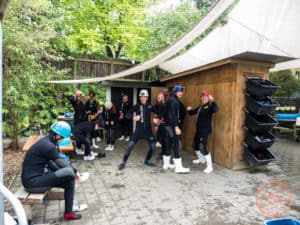
The Legendary Black Water Rafting experience is well…truly legendary. I wasn’t sure what to expect to to tell you the truth but once we were in the cave with headlamps on, and the rushing water swiftly carrying us, I began to understand how special this was. The real show was when we got to the section of the cave where the entire ceiling was lit with blue lights like stars.
The Black Labyrinth tour is the one we went on and while it isn’t the most extreme of their offerings, it was a perfect balance of adventure, physical activity, and glow worms. There’s also the 4 hour Black Abyss which is a bit more strenuous and offers the opportunity to climb waterfalls and zipline.
As you can imagine, these tours sell out quite quickly especially during peak season.
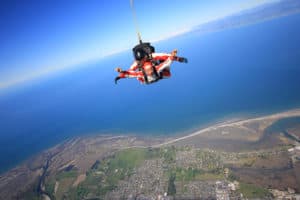
If high flying adventures is what you’re looking for, you pretty much have to jump out of a plane. Almost every place you go in New Zealand seems to have their own skydiving outfit. While the experience is more or less the same across the board, I have to argue that doing it in the north of the South Island is one of the best places to do it.
Skydive Abel Tasman was a ridiculously amazing experience and I would recommend it to anyone. You have your choice between 9,000, 13,000, and 16,500 feet. The views that you have from any of those heights are just incredible with the national park in view, the coastline, and on some clear days, being able to see the North Island as well.
It’s a good idea to book early just to make sure you are guaranteed a spot when you pass by the Abel Tasman area.
Horseback Riding in Glenorchy
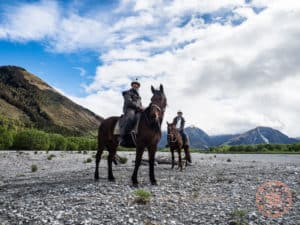
Want to do something different in New Zealand? Go on a horseback riding trip through an area that was used as the set of many blockbuster movies including Lord of the Rings, X-Men, Mission Impossible, and Prince Caspian from the Narnia Chronicles.
We previously did horseback riding with Dart River Adventures but it looks like they’re not operating these trips anymore so I’d recommend checking out High Country Horses or Lighthorse Adventures in Glenorchy.
During high seasons these will fill up really quickly so reserve ahead of time.
Flying Kiwi
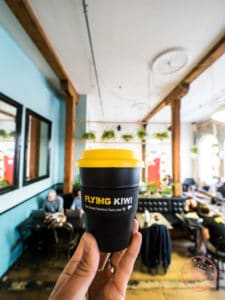
Of course how can I go through these activities and not mention our 14 day adventure through New Zealand with Flying Kiwi. Normally we’re not bus tour kind of travellers but in this case where we wanted a guided experience that had a focus on the outdoors, adventure, and camping, we couldn’t have asked for a better company whether it came to the quality of the itinerary, tour guides, food, and selection of campsites and holiday parks.
Read the full review of our Flying Kiwi Reverse Traverse to learn more about what the trip was really like.

- Stay on top of the cheapest flights to New Zealand by using something like Skyscanner to set up alerts
- Picking up your own supplies and cooking at a hostel or at camp is the biggest way to save money in New Zealand
- Don’t get disappointed when a tour fills up – book ahead of time. Check out possible activities in advance on Viator or GetYourGuide
- Shoulder seasons (Fall or Spring) are your best times to travel to New Zealand – avoid the crowds and take advantage of lower prices
- There are a ton of options in terms of getting around the country. There’s no right answer so figure out what works for you and don’t be afraid to mix and match different ones like we did (car rental and Flying Kiwi).
What you should read next
- The Ultimate 3 Week New Zealand Itinerary
- Top 10 Things To Do In New Zealand’s North Island
- Where To Stay in Queenstown – Budget to Luxury Picks
- Top 5 Things To Do from Queenstown, New Zealand
- Best Places to Stay in New Zealand with Hilton Hotels
Have specific questions about your upcoming trip to New Zealand? Drop a comment below!
About William Tang
William Tang is the Chief of Awesome behind the award-winning Going Awesome Places which is focused on outdoor adventure, and experiential travel. His true passion lies in telling stories, inspiring photography and videos, and writing detailed itineraries and travel guides. He is a member of Travel Media Association of Canada (TMAC), Society of American Travel Writers (SATW), Adventure Travel Trade Association (ATTA), and Travel Massive. He has also been featured in publications such as Reader's Digest, Entrepreneur, Men's Journal, and Haute Living. Make sure to learn more about William Tang to find out his story and how Going Awesome Places started.
Find us on social media
New Zealand Travel Guide
With its seemingly endless number of incredible experiences and wild and varied landscapes, New Zealand never fails to wow its visitors. Our New Zealand travel guide will help you plan and organise your dream vacation from start to finish. Whether you want to hike up volcanos and glaciers, lay on a beautiful black sand beach or enjoy a delicious traditional Maori dinner, New Zealand has something for you. I know you’ll love it as much as we do! You can scroll to the bottom if you want to see all the posts we have for New Zealand. There’s a lot.
This article contains affiliate links. For more information, please see our affiliate disclaimer here .
Quick navigation
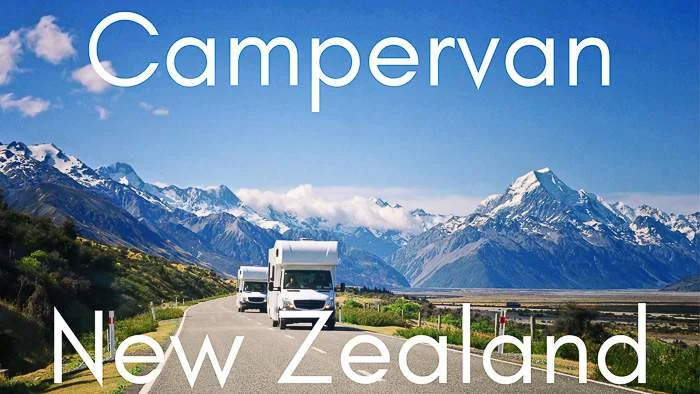
Quick Facts about New Zealand
- Currency – NZD
- ATM and cards – Automatic Teller Machines (ATMs) are widely available, and cards will be accepted in most places, so there is no need to carry large amounts of cash on you.
- Internet and wifi – As you’d expect, internet and wifi are readily available in the cities. However, if you are travelling between cities, there is often no wifi signal.
- Plugs and electricity – New Zealand have 230/240 volt 50-hertz electrical sockets. The plugs have three angled pins, the same as in Australia.
- Languages, religion and culture. The official languages of New Zealand are English and Maori. Maori is the language spoken by the indigenous Maori people. However, new Zealand is a multicultural country, and you’ll find people of all religions speaking many languages other than the official two.
- Safety – If you’re wondering how to stay safe in New Zealand, the good news is you can relax. New Zealand is known to be a remarkably safe country. Exercise usual caution when walking alone late and night, and don’t leave your belongings unattended.
Before we get to all the practical information, let’s look at the exciting things.
Top things to do in New Zealand
For a comprehensive list, read our ultimate tourist guide to NZ – the New Zealand travel bucket list .
The best experiences in New Zealand
There really is no limit to what you can do in New Zealand. These are some of our New Zealand travel recommendations for New Zealand’s most popular activities.
Cruise Milford Sound
Milford Sound is New Zealand’s number one tourist attraction and is an awe-inspiring sight. Take a boat trip or, better still, a kayak, and cruise the beautiful black waters of Milford Sound, admiring the sheer vertical cliff faces and waterfalls lining its edges. Doubtful Sound is another very popular option.
Explore New Zealand in a campervan
Travelling New Zealand by campervan is one of the most popular ways to explore the country. The beautiful, ever-changing landscape never gets boring. We have a few travel guides to campervanning New Zealand you might find helpful. There are more articles at the bottom of this page too.
- Travel Guide: Campervan travel around New Zealand
- Tips for campervanning around New Zealand
- How to choose a campervan for New Zealand
- New Zealand road trips and itineraries
See glow worms
You can see glow worms in many places in New Zealand, but one of the most popular is in the Waitomo Caves, a couple of hours south of Auckland. Take a small boat tour through the caves and look for the twinkle of thousands of glow worms.
Experience New Zealand’s Geothermal landscape
A hive of volcanic activity, there are plenty of opportunities to see and experience the geothermic side of New Zealand. Visit Waimangu Valley or Wai-O-Tapu Geothermal Park to see multicoloured volcanic hot springs and bubbling mud. There are also several hot springs where you can swim or soak in the warm water.
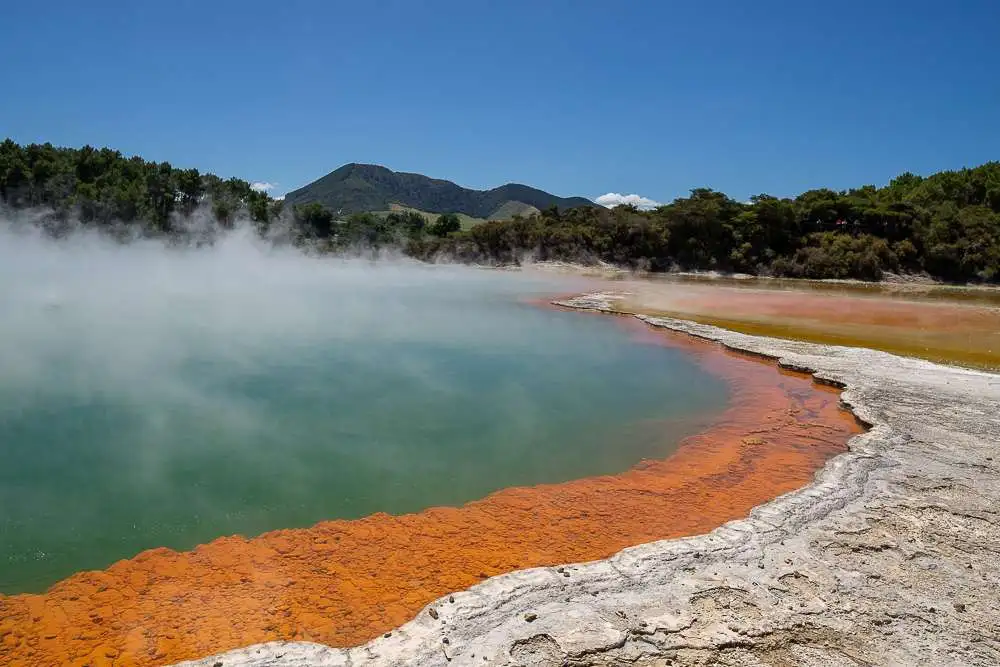
Climb a glacier
Head to Fox Glacier or Frans Joseph Glacier and walk on the ice. With the way the world is heating up, who knows how much longer you’ll be able to do this!
Hike some of New Zealand’s most beautiful Landscapes
New Zealand is known for its spectacular walks and hiking trails; from the Tongariro Crossing to multi-day ‘Great Walks’, you won’t find better scenery than in New Zealand.
Whale watch in Kaikoura
Famous for its wildlife, the South Island of New Zealand is a great place to see all kinds of marine life. Seals, penguins, dolphins and whales can be easily spotted along the coast. A whale-watching tour in Kaikoura is an unmissable experience.
Visit Hobbiton and other Lord of the rings sites.
Many famous scenes and landscapes from the LOTR movies were filmed throughout New Zealand. The most popular place to visit is Hobbiton . Walk amongst the little Hobbit Houses and visit Shires Rest. You can visit Hobbiton from Auckland, Rotorua or Tauranga.
Enjoy a delicious traditional Maori dinner.
Known as a Hangi, a traditional Maori dinner is cooked in an underground oven. The best place to enjoy a Maori Dinner is in Rotorua on the North Island. But, it’s more than just a meal. It’s a cultural experience worth having.
Explore the Bay of Islands
The beautiful Bay of Islands, with its white-sand beaches and deep blue water, is perfect for relaxing in the sun. Base yourself in Paihia and explore the local area north of Auckland.
Sample some of New Zealand’s locally produced wine
New Zealand is known for its fertile wine regions on the North and South Islands. Take a local winery tour and sample some of their delicious produce.
Most popular places to visit in New Zealand
One of New Zealand’s most popular cities, Auckland, is located in the north of the North Island. Situated around two harbours, this beautiful city has plenty of things to do and is also an excellent base for exploring further afield.
You could spend weeks exploring Rotorua city and its surrounds. There are so many things to do in Rotorua itself, including many beautiful walking trails . Day trips from Rotorua include trips to Hobbiton and the geothermal parks.
Christchurch
Christchurch is known for its beautifully landscaped parks and gardens, English heritage, and abundant coastal wild and marine life on the South Islands’ east coast. Repeatedly damaged by earthquakes, this lovely city keeps on repairing and rising.
No New Zealand travel guide would be complete without a reference to Queenstown, the adventure capital of New Zealand. Located on the South Island, Queenstown provides access to all kinds of adventure and water sports. It’s also an excellent base for exploring nearby attractions such as Milford Sound.
Best small towns to visit
If you’re campervanning or just have some spare time, we have some great articles on the best towns to visit on the North Island and South Island of New Zealand. You’ll be amazed at the variety of landscapes New Zealand has once you’re out of the cities. Visiting small towns is also a great way to learn a little more about the local culture and history of New Zealand.
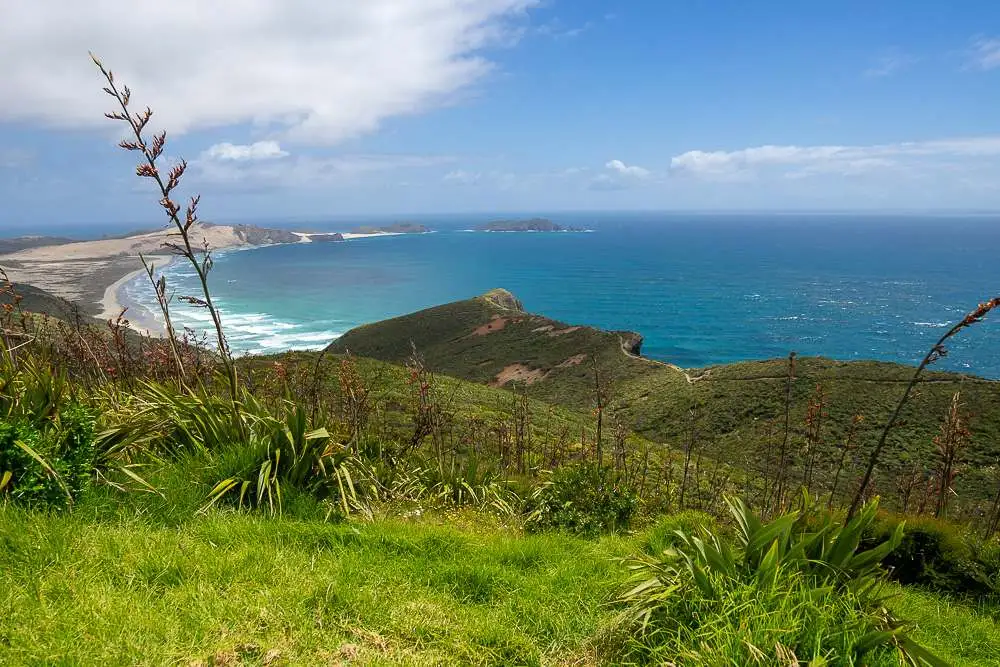
New Zealand travel budget and costs
What is a typical budget for new zealand.
In reality, there is no one typical New Zealand travel budget. It depends on how you like to travel. Do you take local transport everywhere or do you take a taxi? Would you prefer the train? Or to fly when you travel between cities? Do you stay in hotels or hostels?
Below is a table with an average amount spent per category to give you a general idea.
All prices are in New Zealand Dollars (NZD)
Tipping in New Zealand
Tipping is not common practice in New Zealand. But, of course, if you receive excellent service, it’s always a nice thing to do. If you do tip, 5-15% is considered a reasonable amount.
How to travel New Zealand – New Zealand travel planning
When will new zealand travel restrictions be lifted.
The New Zealand Government have announced that the border will be open to everybody from July 31st 2022.
New Zealand travel requirements
Please check the various New Zealand websites, such as the Customs website and the Governments Covid Advisory site, before making any plans,
Visas for New Zealand
Always check your visa requirements before travelling. Currently however
- citizens and permanent residents of New Zealand and Australia
- citizens of the UK
- and citizens of countries that have visa waiver agreements with New Zealand
do not require visas to travel to New Zealand. However, you must apply for an Electronic Travel Authority or ETA before arriving in New Zealand. You can find all the information you need at the New Zealand Immigration website .
The length of time citizens from different countries can stay in NZ varies, so make sure you check before booking your trip.
Citizens from other countries are required to pre-organise a visa for New Zealand.
Travel insurance for New Zealand
Travel Insurance is a must, especially if you’re planning on doing any adventure activities while you’re in New Zealand. Our New Zealand travel guide tip would be to use World Nomads Travel Insurance. We have always used World Nomads and highly recommend them. We once had to make an ongoing, quite difficult claim, and they were fabulous, even though we were very slow in giving them all the information.
Unfortunately, it’s easy to think that you don’t need travel insurance until you need it, and then it’s too late.
Getting to New Zealand
Flights operate from around the world in New Zealand’s international airports. For most countries, flights will land in Auckland or Christchurch. Travellers from Australia and Fiji can fly into Auckland and Christchurch, as well as Queenstown, Dunedin and Wellington airports.
Make sure you book your flights to the right Island for the start of your itinerary!
New Zealand Geography – Where is everything?
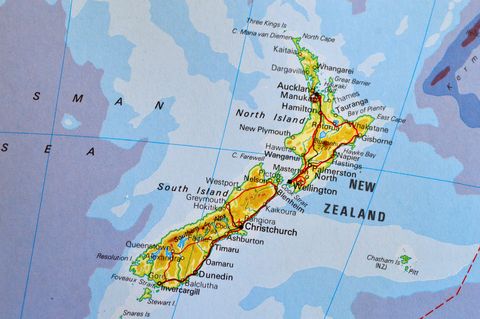
Should you visit the North or South Island?
New Zealand is divided into two main larger islands and a few smaller ones.
The main cities on the North Island are Auckland and Wellington. Highlights of the North Island include
- the Bay of Islands and the Northland region above Auckland. Try this road trip itinerary for Northland if you want to experience the best of the area.
- The Coromandel Peninsula is a beautiful area and home to Cathedral Cove and Hot water Beach.
- Waitomo Caves and glow worms
- The Tongariro Crossing
The biggest cities on the South Island are Christchurch, Queenstown, Dunedin and Invercargill. The South Island and Queenstown, in particular, are world-renowned for their adventure activities. On the South Island, you’ll find
- Glaciers such as those at Fox Glacier and Frans Joseph
- Glenorchy and other beautiful small towns
- Kaikoura and the opportunity for whale watching
- Milford and Doubtful Sound
- Lake Tekapo and the Dark Sky Reserve
Both Islands are worth visiting; however, if you only have a short period, our travel guide recommends choosing just one and exploring it more thoroughly. The South Island is generally more popular with tourists than the North Island.
Getting around in New Zealand
Although technically ‘small’, New Zealand is a surprisingly large country to travel around as it is sparsely populated. There is quite a distance between many of the larger cities and towns. Nevertheless, there are plenty of ways to get around.
Domestic flights operate between all New Zealand airports moving the cities and islands much more manageable. If you have limited time, flying is the fastest way to cover large distances. But, of course, it’s also the most expensive option.
As mentioned, travel by campervan is prevalent in New Zealand. Hiring a campervan or a car and road-tripping around the country allows you the time to experience the beauty and diversity of New Zealand. You’ll find these posts helpful if you’re considering hiring a campervan to travel to New Zealand.
- Do I need a self-contained campervan for New Zealand ?
- Where can I park my campervan ?
- How to freedom camp in New Zealand
We’ve also put together the perfect five-week South Island Itinerary !
Buses are a great way to get around most cities and towns. Intercity buses are also available. You can check the Intercity website for timetables and ticket information.
Unfortunately, New Zealand has no intercity trains for general transport purposes, although they have some incredible scenic journey trains, The Coastal Pacific, the Northern Explorer and the Tranzalpine. These are an attractive option if you have a few days and want to relax.
Inter-Island Ferries
Inter-Island Ferries run regularly between Wellington in the South of the North Island and Picton on the South Island. The ferries are comfortable, and there are drinks and food on board. The ferry will also carry your car or motorhome if you have one. Tickets start at about $55 NZD for a person.
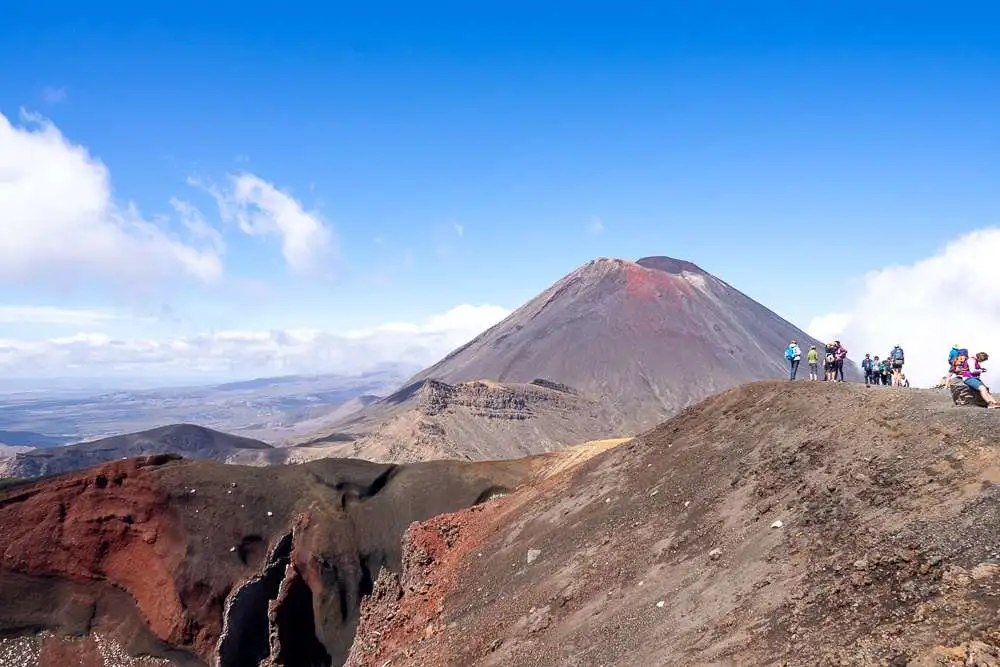
Where to stay in New Zealand
New Zealand has an unlimited number of boutique hotels, hotels and motels, bed and breakfasts, holiday parks and campgrounds. There is something for every budget and every taste.
We always use Booking.com when we book accommodation because I like how I can sort by price and review score, so I get the best-reviewed room at a great price. In addition, I’ve just found it to be the easiest to navigate.
Best foods to eat in New Zealand
A trip to any country is impossible without trying some local delicacies. So make sure you try these local treats.
- Traditional Maori Hangi dinner – cooked below ground in a dug-out oven. read this New Zealand travel guide to choosing the best Maori experience for our recommendations
- Seafood – Surrounded by coastline New Zealand has beautiful fresh seafood
- Lamb – New Zealand produces some incredible lamb
- Pavlova – Now, as an Australian, I always thought we owned ‘The Pav’ like many other things we claim; I think it’s from New Zealand. But, if you haven’t tried it, you really should!
Weather and climate in New Zealand
Generally, the North Island is warmer than the South Island no matter what time of year.
Summer is great for spending time on the beach or enjoying one of New Zealand’s great hikes. The New Zealand summer is from December until the end of February. The North Island is warmer than the South, with an average temperature of between 20 and 30 degrees Celsius.
Autumn, from March through until the end of May, is a mix of cooler temperatures and changing colours. Trees will begin to turn auburn, and whole areas look spectacular. Nevertheless, the weather can be pretty good, and if you travel in the early months, many summer activities such as swimming are still possible. Rainfall increases, however, so be prepared for wetter weather.
Winter in New Zealand is an excellent time for skiing and other cold-weather activities, with an average temperature of 12-16 degrees Celsius.
The whole country comes alive with colour in the spring as the plants and flowers flourish. Waterfalls are at their peak after the winter rains, and temperatures begin to increase to around 15 to 25 degrees Celsius.
The best time to travel to New Zealand
When is the best time to visit New Zealand? Of course, that depends on what you want! While summer is the most popular time, there are advantages to travelling to New Zealand at other times of the year.
The summers in New Zealand are often busy with lots of tourists. One disadvantage of this is that the prices for everything are also higher. Campervan fees are at a premium in the lead-up to summer, and many companies will be booked out. The same can be said for tour companies. It’s a good idea to book well in advance if you intend to travel in the summer.
Spring and Autumn, however, are a little quieter. There are fewer tourists, and prices are generally lower. The temperatures are not as warm, and it may be a little wetter, but this shouldn’t deter you. Spring and Autumn are great seasons to travel to New Zealand.
The winter can also be an excellent time to travel if you’re after winter activities. Prices during winter are at their lowest, and plenty of good deals can be had. However, some tours will not operate during the winter, and roads can be more challenging to drive on, especially around the mountains. If you’re campervanning during the winter, we have a guide to help prepare you.
Our advice would be to travel near the end of summer, or in spring or Autumn for the best all-around experience.
How long to spend in New Zealand?
I would recommend at least one week in New Zealand. That would include visiting one or two areas on one Island. Our travel guide to New Zealand recommendation would be that if you plan on travelling around and visiting both Islands, 2-3 weeks would be a minimum. Of course, the more time you have, the more you can explore.
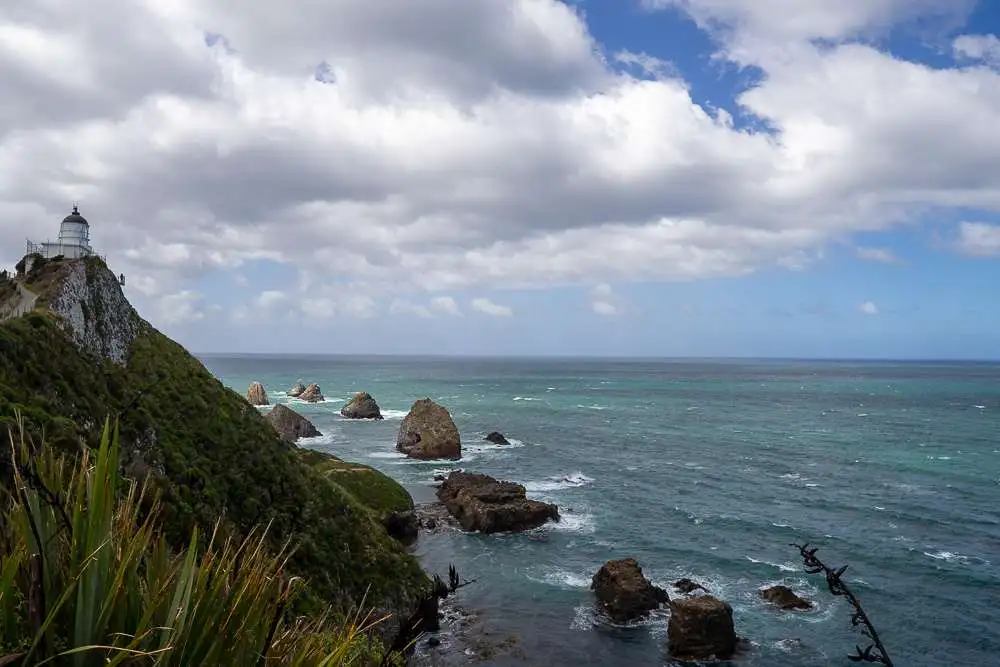
What to pack for New Zealand
You can subscribe to our mailing list for a free New Zealand packing list that will cover all seasons. Aside from clothes, the most important things to take are
- Insect repellent – those bugs can get quite annoying
- Sunscreen – for when you’re exploring the outdoors,
- a wind and waterproof jacket – New Zealand is famous for having all seasons in one day. You’ll b glad you have this with you.
- Good walking shoes – You’ll thank us for this one!
- A refillable water bottle – New Zealand’s water is safe to drink. You can just refill your bottle from a tap rather than buy plastic.
Responsible travel tips in New Zealand
- Use a refillable water bottle as mentioned above – it helps reduce waste
- Make sure you take your rubbish with you. The New Zealand government and Department of Conservation make a considerable effort to keep their pristine environment, well, just that. Pristine. Don’t little or leave your plastic products lying around.
FAQ’s
As of July 31st 2022, the borders will be completely open. Check the latest information from the New Zealand government for up-to-date information.
A New Zealand trip can cost anywhere from $1000 NZD and up, depending on the length of stay and the activities you do while you’re there.
Useful new Zealand posts
Things to do in new zealand.
- A complete New Zealand bucket list
- North Island Highlights
- The best things to do in Auckland in one day
- Things to do in Rotorua
- The best walks in Rotorua
- Which geothermal attraction in Rotorua is best?
- Where should I try Hangi in Rotorua?
- How to walk the Tongariro Crossing
- A complete travel guide to Milford Sound
- Which is better? Doubtful or Milford Sound?
- The Fox Glacier Heli Hike
How to Campervan around New Zealand
- The ultimate travel guide to travelling New Zealand by campervan
- Campervan tips
- Choosing your camper for New Zealand travel
- Do you need a self-contained campervan?
- What is freedom camping in New Zealand?
- How to find and hire the right campervan
- How to find a budget camper
- Tips for campervanning New Zealand in winter
- Where can you stay with your campervan?
- The best New Zealand road trips and itineraries
- Auckland to Cape Reinga – the best of Northland
- Explore the Coromandel Peninsula
- An extended 5 week South Island Itinerary
- The best small towns to see on the North Island
- Small towns of the South Island worth visiting
General New Zealand articles
- Things that surprised us about New Zealand
About Christine
Christine and her partner Ben have spent the last few years traveling through New Zealand and then Europe by campervan. They travel with their dog Alisa, who they adopted in Croatia. You'll find them exploring old cities, hiking through National Parks, and taking unforgettable road trips.
- Work With Us
- Blogging Bootcamp

- Van Conversion Academy
- Campervan Shop
- Campervan Rentals
- Plan a Trip
- Itineraries
- Destinations
- Responsible Travel
- Family Travel
- Budget Travel
- Scuba Diving
- Travel Credit Cards
- Digital Nomad
- Teach English Abroad
- Blogging Resources
- Income Reports
- Travel Shop
- Meet Katie & Ben
- About Two Wandering Soles
- Personal Stuff
- Portfolio & Press
New Zealand Travel Guide
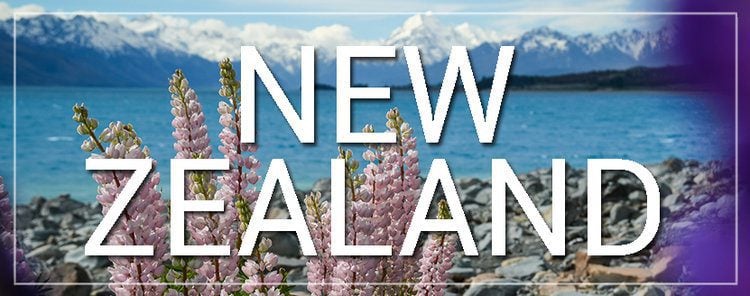
Welcome to the “Adventure Capital of the World”! In New Zealand, you can go caving, hiking, skydiving, skiing, climbing, bungy jumping, jet boating, swimming with dolphins, and camping… just to name a few of the heart-pumping activities you’ll find! Everywhere you look, there’s jaw-dropping landscapes and adventures to be had. Welcome to the real Middle Earth.
If you are planning a trip to New Zealand, this travel guide has everything you need to know. Plus, scroll all the way down to the bottom of the page, and you’ll see all of our New Zealand articles!
But first, don’t miss your chance to download our perfect 30-day New Zealand road trip itinerary !

New Zealand Travel Guide Contents
Important Info | Best Time to Visit | Things to Do | What to Eat | Typical Budget
Travel Tips | What to Pack | New Zealand Articles | Book Now
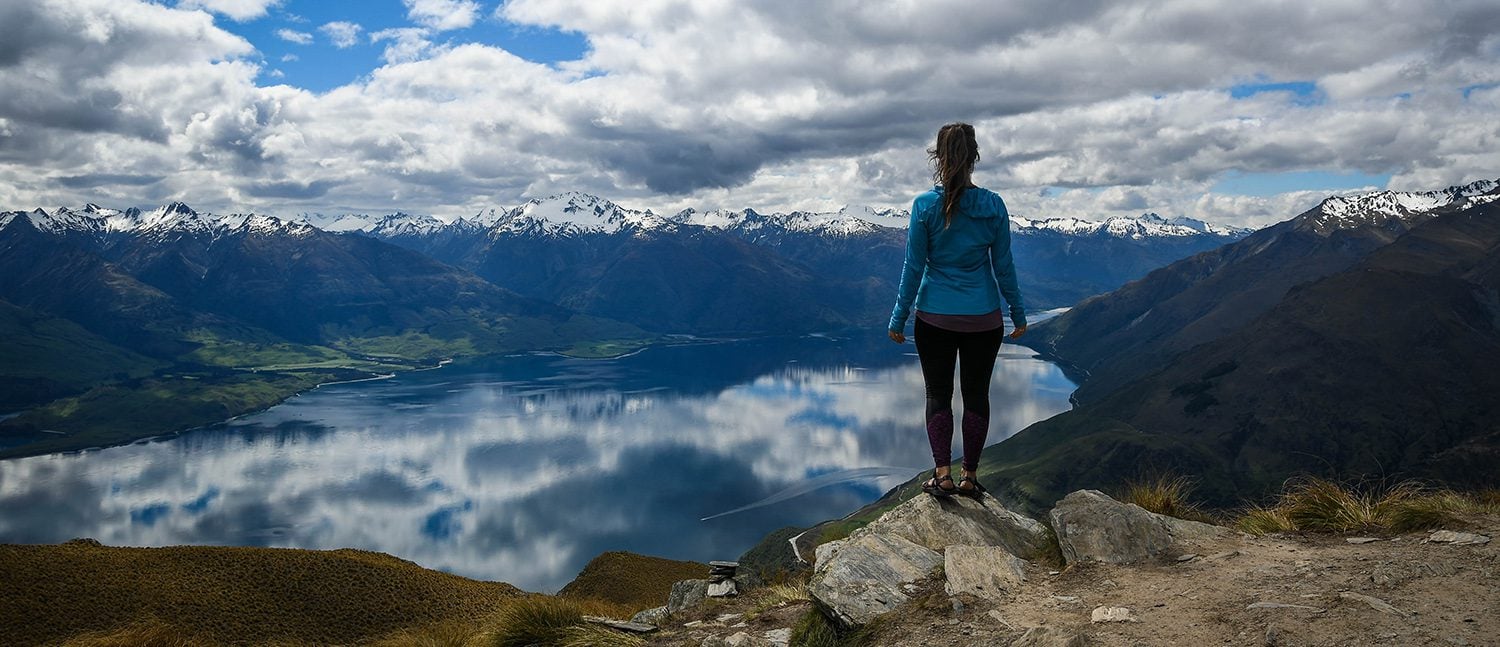
Important Information about New Zealand
Visas/Documentation Needed to Enter New Zealand: Okay, so they don’t exactly call it a “visa”, but as of October 1st, 2019 you need to pay enter New Zealand. Please apply on the New Zealand Government website or using their free mobile app . The two fees you need to pay before entering NZ are below. You can take care of both of these fees by following the link we provided.
New Zealand Electronic Travel Authority (NZeTA): cost $9 NZD on the official app or $12 NZD on a browser.
International Visitor Conservation and Tourism Levy (IVL): Costs $35 NZD for each person entering New Zealand. The fees will be put toward conservation of New Zealand’s land and nature as well as tourism infrastructure. Citizens of Australia and some South Pacific Islands are exempt.
New Zealand at a Glance: What’s not to love about New Zealand? It has white snow capped mountains, creaking glaciers, silent lakes, thunderous waves, black sandy beaches and smoking volcanoes – almost everything that makes a picturesque paradise.
Currency in New Zealand: New Zealand Dollar | 2022 Conversion Rate: 1 NZD = $0.58 USD
Tipping in New Zealand: While tipping is common in other parts of the world, it isn’t so much in New Zealand. You don’t need to leave a tip in restaurants but if you feel the service was excellent, a 10% gratuity is sufficient. For taxi drivers, you can simply leave your change as it is not common practice to tip taxi drivers. In hotels, tipping $1-$2 per bag and $1-$5 for maid/room service is seen as a nice gesture. Tipping tour guides are more common since their services are mainly for tourists. While tipping is not necessary, you can tip your guide a few dollars if you feel that they did an excellent job.
Language & Helpful Phrases: English… but Kiwi English . What do we mean? Well, here are a few Kiwi phrases that will help you get around New Zealand:
Kia ora: This is the Māori word for “welcome”, and you will hear it everywhere!
Sweet as: Pretty cool, sweet, or a nicer way to “sweet as F#@%!”
Togs: Swimsuit
Dairy: Corner store, typically serves milkshakes
Jandals: Flip flops/sandals
Tramping: Hiking (longer hikes when you plan to stay overnight)
Religion and Culture: The Maori people and different European heritages have greatly influenced the religion and culture of New Zealand. Nowadays, the country has a multicultural society with all sorts of religions: Christianity, Hinduism, Islam, Judaism, and Traditional Maori religion.
Transportation around New Zealand: The main form of public transportation in New Zealand is via bus. The main cities, Auckland and Wellington, have suburban rail systems and ferries. The best way to get around is to rent your own campervan , which gives you a ton more freedom.
Psst! Read up on the things to know before traveling to New Zealand .
Most popular places to visit in New Zealand:
Fiordland – This is one of the most scenic spots in the country. It offers incredible hikes, cruises on amazing fjords, and beautiful waterfalls. The biggest attraction here is the Milford Sound.
Tongariro National Park – Tongariro is New Zealand’s first national park and is well known for its extremes and surprises. You will find here active volcanoes, untamed forests, herb fields, tranquil lakes, desert-like plateaus, and one of the most epic hikes we’ve every been on.
Queenstown – For people looking for some adventure and adrenaline, Queenstown is paradise. With the surrounding Southern Alps and blue Lake Wakatipu, this place is a picture perfect spot.
Auckland – As the largest city in the country, Auckland has fun and quirky neighborhoods and many things to do.
Wellington – The country’s capital city has a growing craft beer scene, a lively nightlife, and lots of pretty sights. Known as being the southernmost capital city, this hipster hotspot makes a good stop on your New Zealand itinerary.
Coromandel Peninsula – For water sports, sailing, and fishing. You can also go scuba diving in this gorgeous region. And there are plenty of things to do inland too, like the Pinnacles Hut hike and incredible waterfalls to chase!
Other popular spots include:
Waiheke Island
Christchurch
Glacier Country
Te Whakarewarewa Geothermal Valley
Waitomo Glowworm Caves
Abel Tasman National Park
Franz Josef Glacier
Marlborough wine region
Wondering how to fit all this into one trip? We’ve got you covered! We’ve created the perfect customizable New Zealand Itinerary for a one-month road trip.
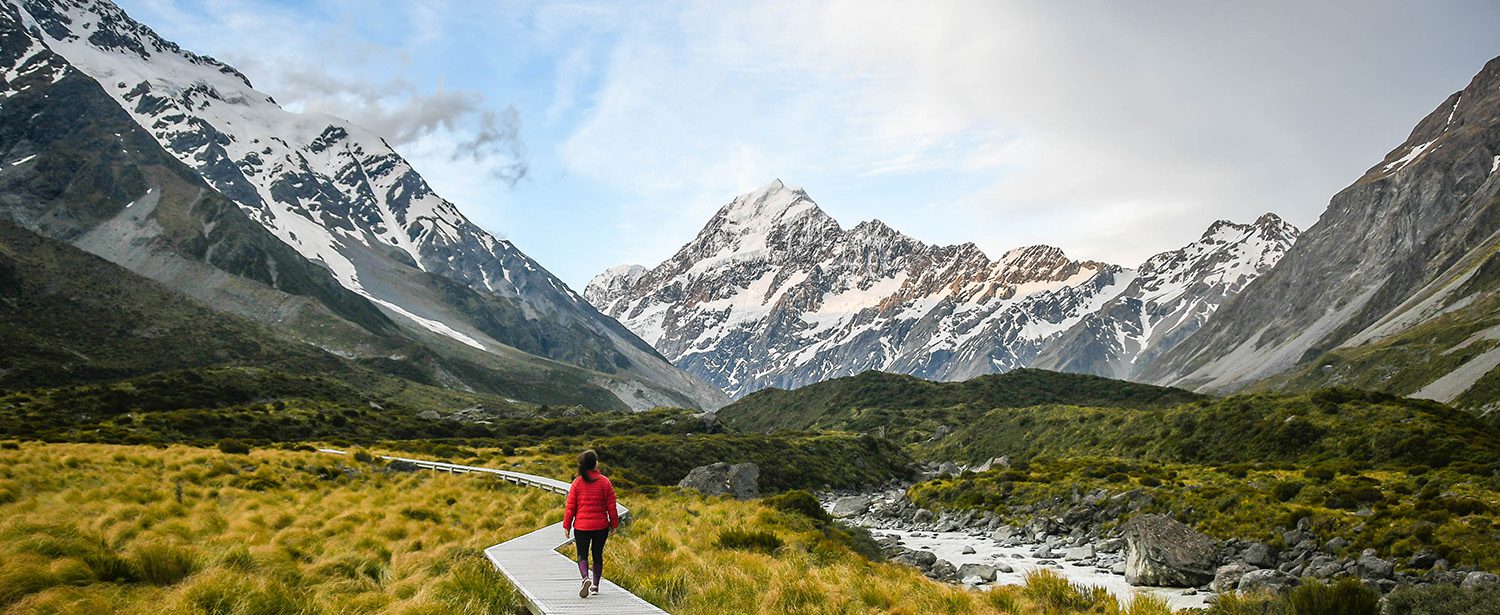
Best Time To Visit New Zealand
Climate in new zealand.
Since New Zealand is located in the Southern Hemisphere, the seasons are a bit different than what Americans and Europeans are used to. While it’s snowing in the United States, it’s summer in New Zealand.
Summer: December to February (Peak Season)
Fall: March to May
Winter: June to August
Spring: September to November
Peak season for tourists is summer. It is the busiest time of the year and the most crowded so expect that prices are a little bit higher than other months.
Times to avoid traveling in New Zealand
There’s no bad time to go to New Zealand. But if you don’t like the snow and the cold, avoid visiting in the winter. Also, try to avoid New Zealand during early January. Most of the locals go for a vacation. A lot of cafes and restaurants are shut down.
Still can’t decide when to travel? We’ve broken down the very best times to visit New Zealand so the hard work is done for you!
Major Festivals in New Zealand
Pasifika Cultural Festival, March: Have a fantastic weekend filled with dance, arts, food and music at Auckland’s Pasifika Festival.
Auckland Lantern Festival, February/March: This is a popular event where lanterns lit up the Albert Park. Don’t miss the live music, delicious Chinese cuisine, fireworks, dance, and martial arts.
Parihaka Peace Festival, January: If you want to listen to the top Kiwi Music performers, Parihaka Peace Festival is just for you. Coupled with arts, crafts, food, and a film festival, this is a must-visit festival in New Zealand.
*These festivals follow the Lunar calendar, so the exact dates vary each year
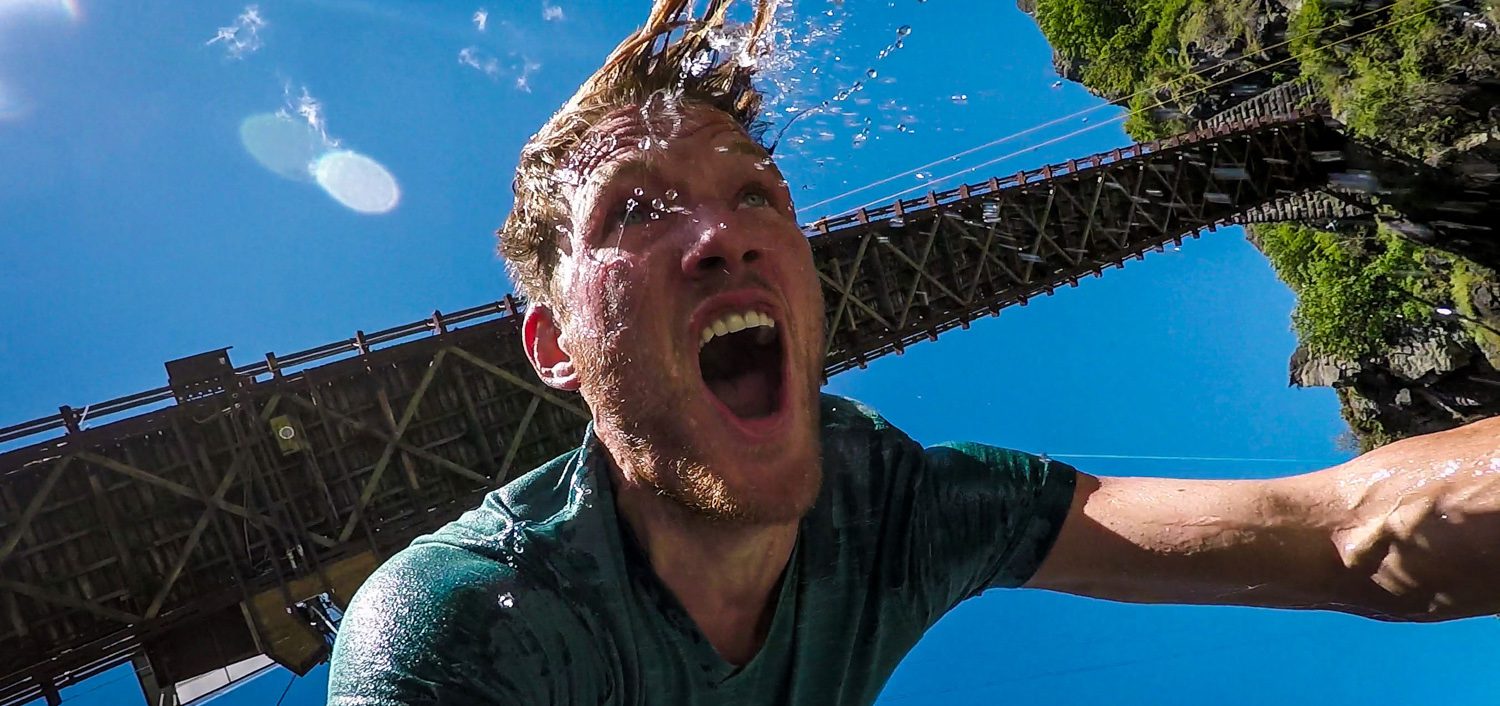
Top Things to Do in New Zealand
Learn about maori culture.
Around 700 years ago, the Māori people discovered and settled in New Zealand. The Māori culture has been a great influence on what New Zealand is today. You can find local Māori guides who will show you how their culture is surviving in modern times. In the town of Rotorua, there are living Māori villages, cultural dinners and dances you can attend.
Go Kayaking
With the amazing wildlife and stunning scenery, kayaking in New Zealand is a mind-blowing experience. You can try paddling in islands around the North Island or through the Fiordland.
Try Tramping
There’s no such thing as trekking for New Zealanders. With the snow-capped mountain peaks, lakes, craters and beautiful fjordlands, New Zealanders go tramping. You can even hike to mountain huts, spend the night and return in the morning. We rounded up the best New Zealand hikes to put our your adventure bucket list.
Explore in a Campervan
Experience the greatest sense of freedom by driving along with everything you need. There are so many hidden spots in New Zealand that can be only seen with renting a campervan . It’s definitely the best way to see the country and we have all the info you need to plan your campervan trip in New Zealand .
Visit Middle Earth
If you’re a Lord of the Rings movie fan, New Zealand is probably in your top destination for the Matamatato rolling hills. See the idyllic Hobbiton movie set and explore the 44 Hobbit holes.
Swim with dolphins
With Dolphin Encounter Kaikoura , you’ll have the opportunity to swim with these wild animals ethically, making it one of the best places to swim with dolphins in the world.
There’s so much more… There are so many more incredible things to do in New Zealand , we had to create an entire article about it. We’ve rounded up the top adventures, sights to see and culinary experiences so you can create your own New Zealand bucket list.
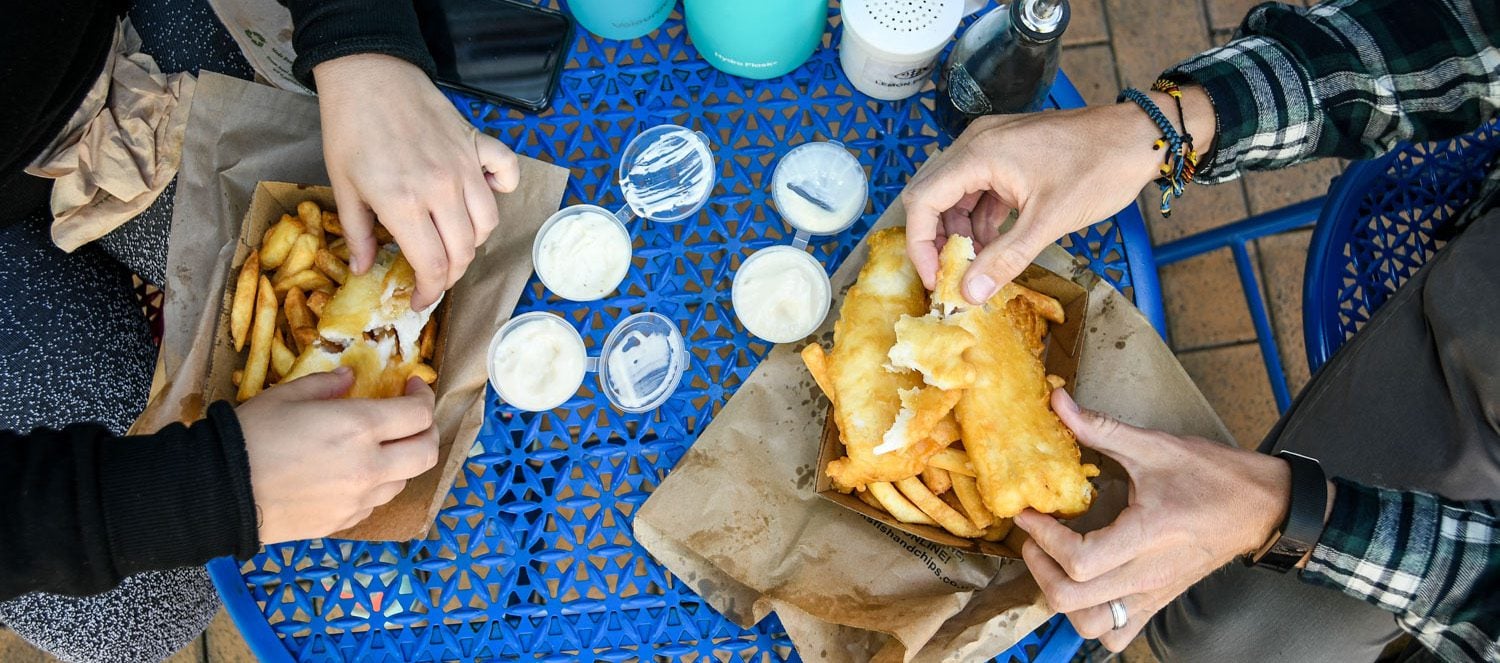
Best Food to Eat in New Zealand
New Zealand is not only famous for its stunning views but also for its delicious cuisines. As a country with thousands of kilometers of coastline, it’s not surprising that one of the most served dishes are seafood. If you’re planning a food trip in New Zealand, here are some of our favorites:
Hangi: Hangi is a traditional Maori dish that involves slow-cooked vegetables and meat in an underground oven. It is often served more often at special occasions.
Hokey Pokey Ice Cream: Who doesn’t want ice cream? New Zealand’s Hokey Pokey ice cream take the delight further with it’s caramelized honeycomb. Yum!
Crayfish: Everything seafood is delicious and Kiwi’s favorite crayfish or lobster is a must try in New Zealand!
Kina: Ever tried eating sea urchins? You should! It’s a foodie delight that New Zealanders love.
Jaffas: Here’s another sweet candy for your sweet tooths! Jaffas are chocolate balls coated with sugar. It also has an orange flavor to it. You would think the combination’s weird but its definitely heavenly!
Kiwi Burger: Burger lovers unite! The Kiwi burger is a weird and genius dish. It has fried egg and beetroot included in a typical burger. Try it once and you’ll be hooked!
Insider Tip: Happy Cow is a great resource for finding vegetarian and vegan restaurants all around the country!
Typical Budget for New Zealand
New Zealand is paradise to most travelers for its amazing sights and delicious food, but it all comes at a cost.
Good to know: Food and drinks are expensive. If you want to save some money, plan to cook your own food in your campervan . PAKn’Save and New World are good grocery stores to stock up and are in most big towns. And check out our campervan recipes for some meal ideas!
How Much to Budget in New Zealand Per Day
Budget traveler: If you are on a tight budget and watch your spending closely, $60 – $90 could be a sufficient budget. Psst! We have an entire article devoted to budget tips for traveling in New Zealand !
Mid-range traveler: If you want to have a few splurges and stay in nicer accommodation, plan to budget $100 – $150 per day per person.
Luxury traveler: It won’t be hard to blow through $200 per person each day if you’re renting a top of the line campervan and packing your itinerary with tours like bungey jumping and scenic helicopter flights.

Dorm bed = $15-$25
Camping = $0-$20
Campervan Rental = $75-450 per day
Budget room = $45-$65
Mid-range = $90-$125
Luxury hotel = $135+

Fast food = $5-$20
Mid-range restaurant = $8-$40
Fancy restaurant = $50+
Local beer = $5-$8

Skydive = $230-300
Bungy Jump = $150-200
Whitewater Rafting = $68-100
Glacier Hiking = $265-320

Bus Fare = $25-$40
Ferry from North to South Island = $55
Domestic Flights = $80-$165
Train = $68-$150
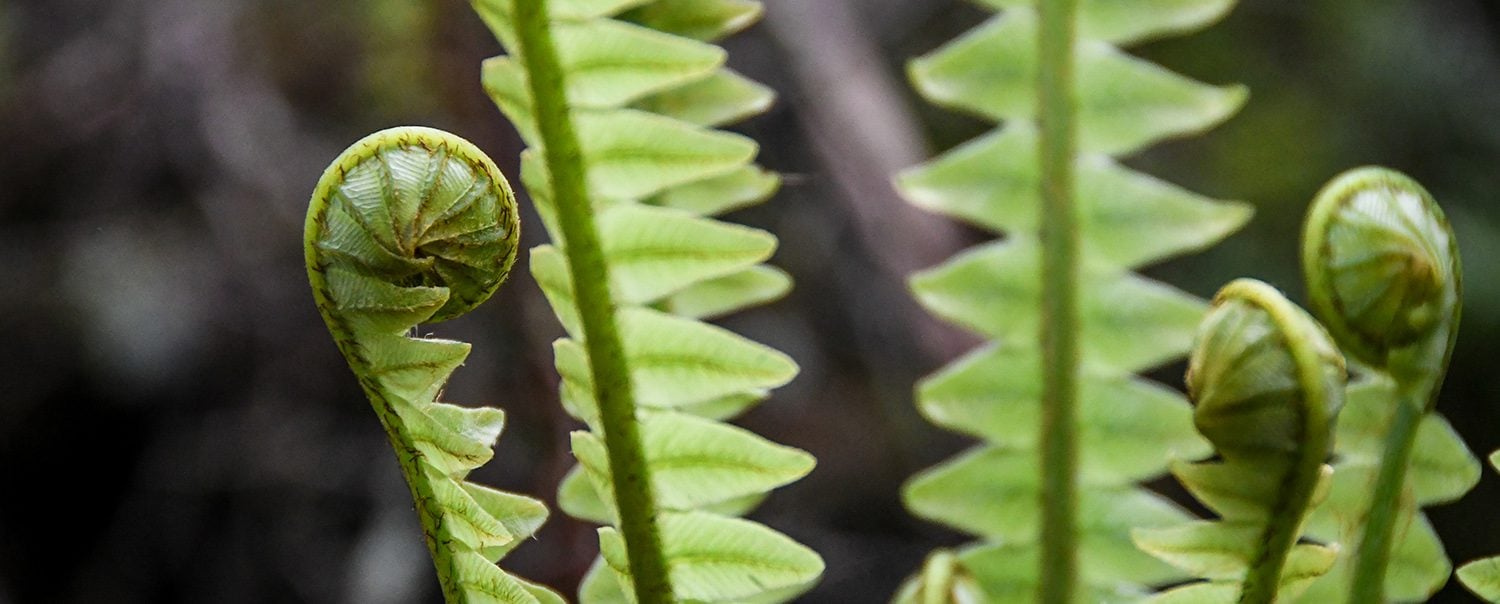
Responsible Travel Tips in New Zealand
We are passionate about sharing tips anyone can use to travel more responsibly . Here are some easy ways you can travel better in New Zealand.
1. Respect the environment
New Zealanders love recycling. If you don’t recycle properly, you can get fines! When going to beaches, read the signs with the do’s and dont’s so you’ll know what you can and can’t do. Also, avoid buying bottled water. Instead, have a reusable water bottle.
Related Article: Eco-friendly Travel Gear Packing List
2. Bring all your trash with you
If you’re going camping, make sure you tidy up after you’re all done. Have a handy trash bag where you can put all of your garbage during the trip.
3. Shop local
Support local artisans to help keep the traditional Māori crafts alive. Check out the Jade carvings in the West Coast, they are stunning!
Related Article: 36 Responsible Travel Tips for anywhere in the world.
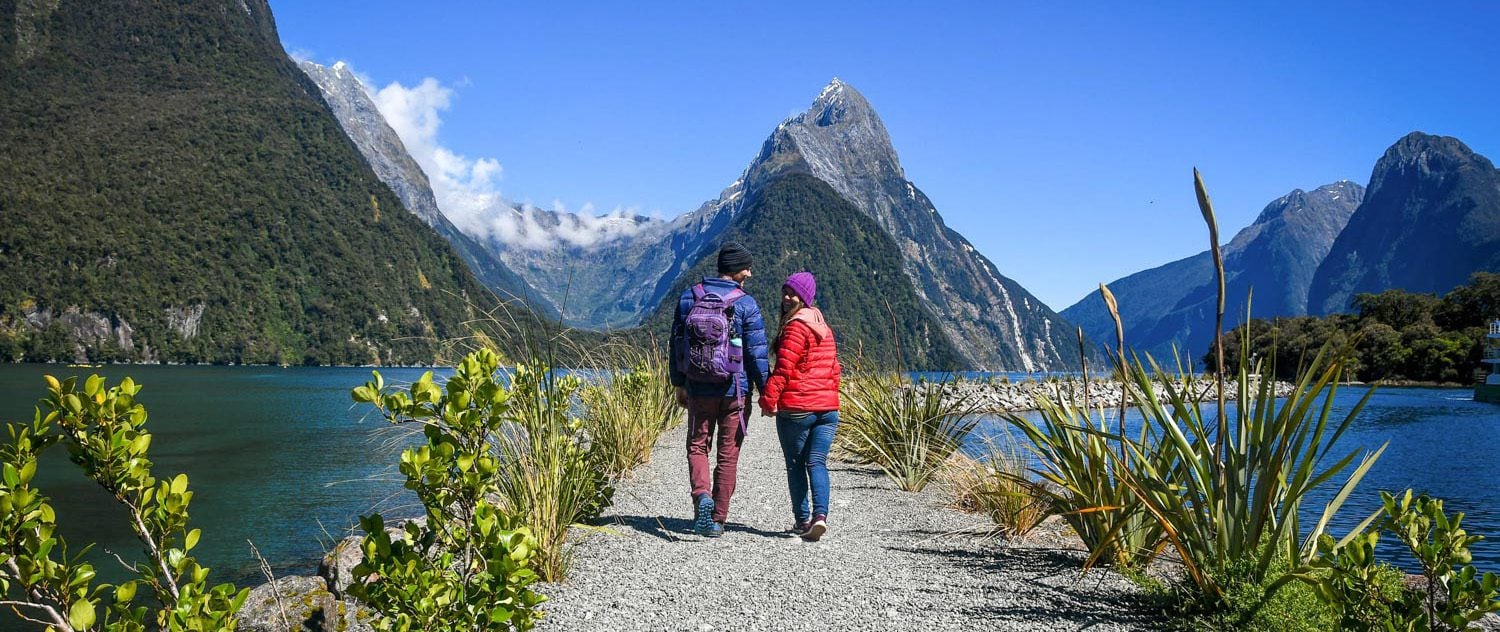
What to Pack for New Zealand
The weather in New Zealand changes drastically from season to season and from the South to the North Islands. Be sure to pack appropriately for the region, season and activities you’ll be doing. You can download this 7-page packing list for free. Just give us your email and we’ll send it straight to you inbox.
Here are some New Zealand-specific items we’d recommend packing:
bug repellant (solids are the way to go, because sandflies really suck)
reef safe sunscreen
insulated water bottle
t-shirts, a nice top, and long sleeved shirt
rain and windproof jacket
reusable straw & reusable bag ( say no to single-use plastic! )
jeans, and hiking trousers
sweater and jacket for the mountains
thermal underwear and socks
Chaco sandals (we’d recommend these instead of hiking boots as they are less bulky and are good for walking through water)
sneakers and some flats
travel towel and toiletries
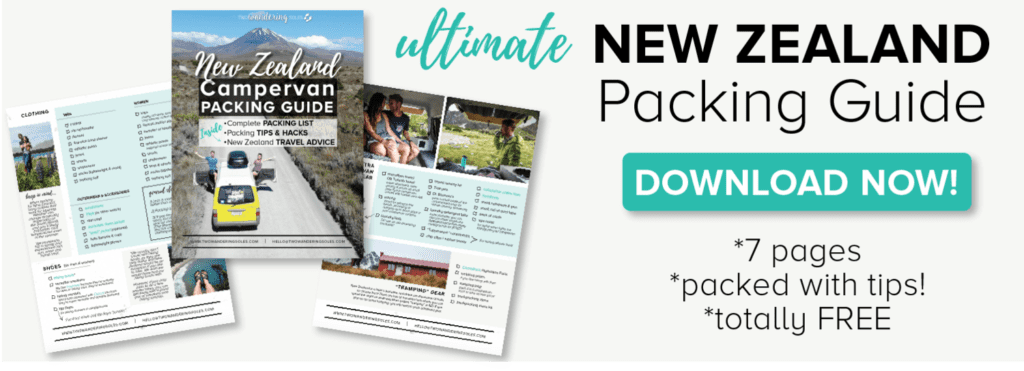
New Zealand Travel Articles
Find all sorts of information to help you plan the perfect New Zealand trip. From budget tips to things to do, we have it all!
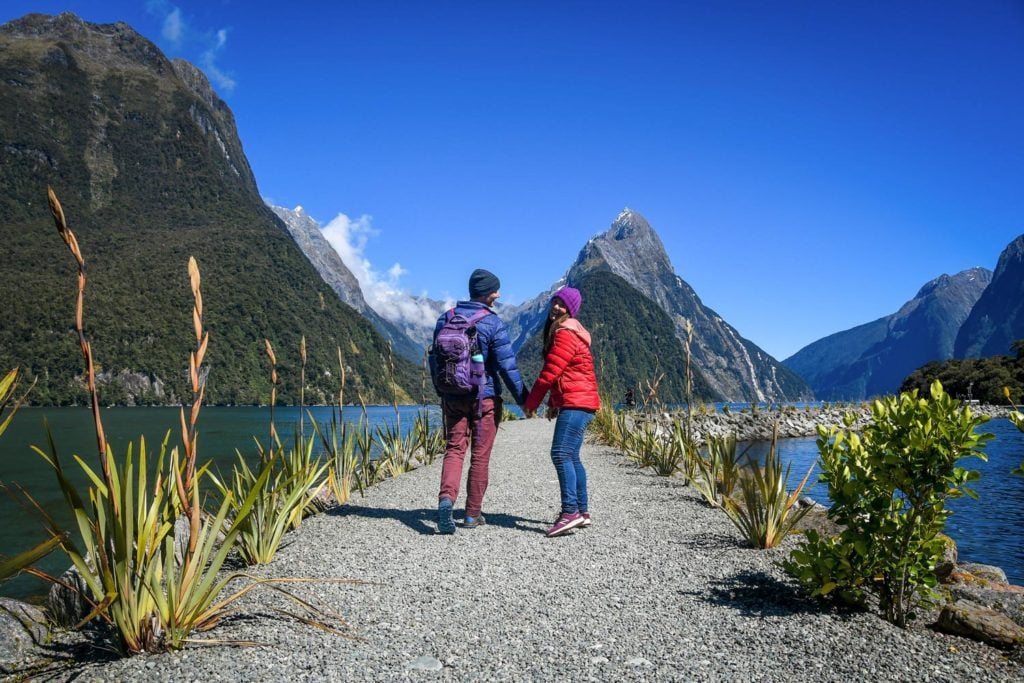
South Island New Zealand Itinerary: Epic 2-Week Road Trip
We’ve done all the trip planning for you and put together the best 2-week itinerary for South Island New Zealand you’ll find! It’s packed full of incredible sights and heart-thumping adventures, plus insider tips and advice.
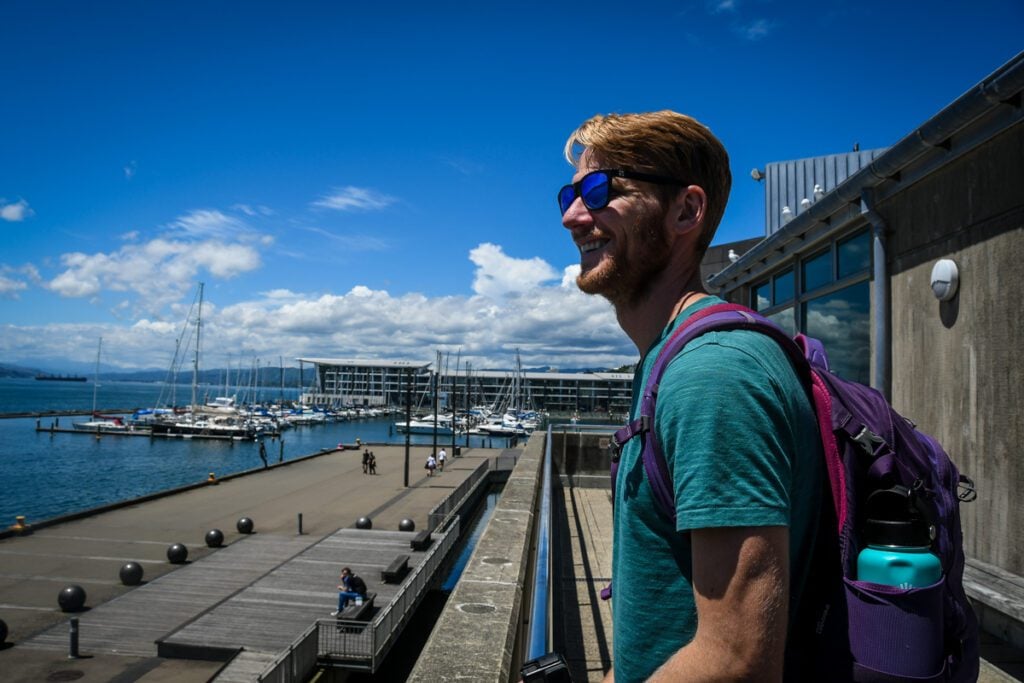
25 Things to Do in Wellington That You Can’t Miss
New Zealand’s capital city is vastly underrated and well-worth a spot on your itinerary. Whether you have a few hours or a few days to explore, we’re sharing all the fun things to do in Wellington that you won’t want to miss!
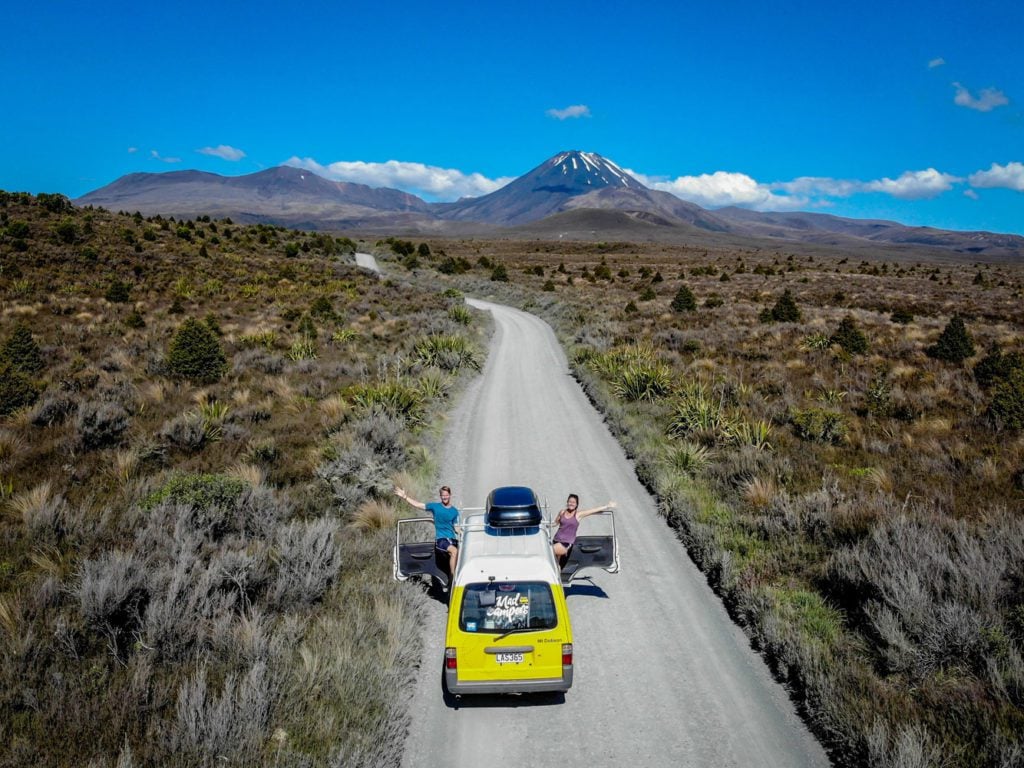
Planning a Campervan Trip in New Zealand: Ultimate Guide
This comprehensive guide has literally everything you need to know about planning a campervan trip to New Zealand; from how much it costs, to how to shower while living in a campervan, to the magic trick you need to know to find campsites. Any questions you have about renting a...
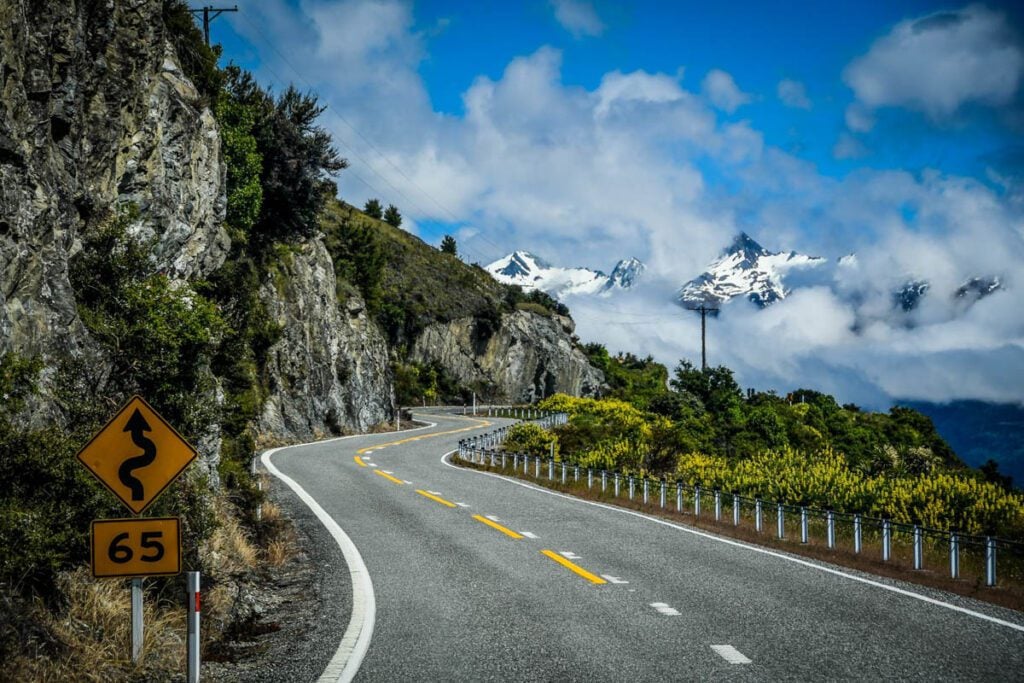
Car Rental in New Zealand: ESSENTIAL Guide + Tips
New Zealand is spectacular but incredibly remote, both in terms of getting there and getting around once there. That’s exactly why getting a rental car in New Zealand is such a good idea! This guide details everything you need to know before you hit the road.
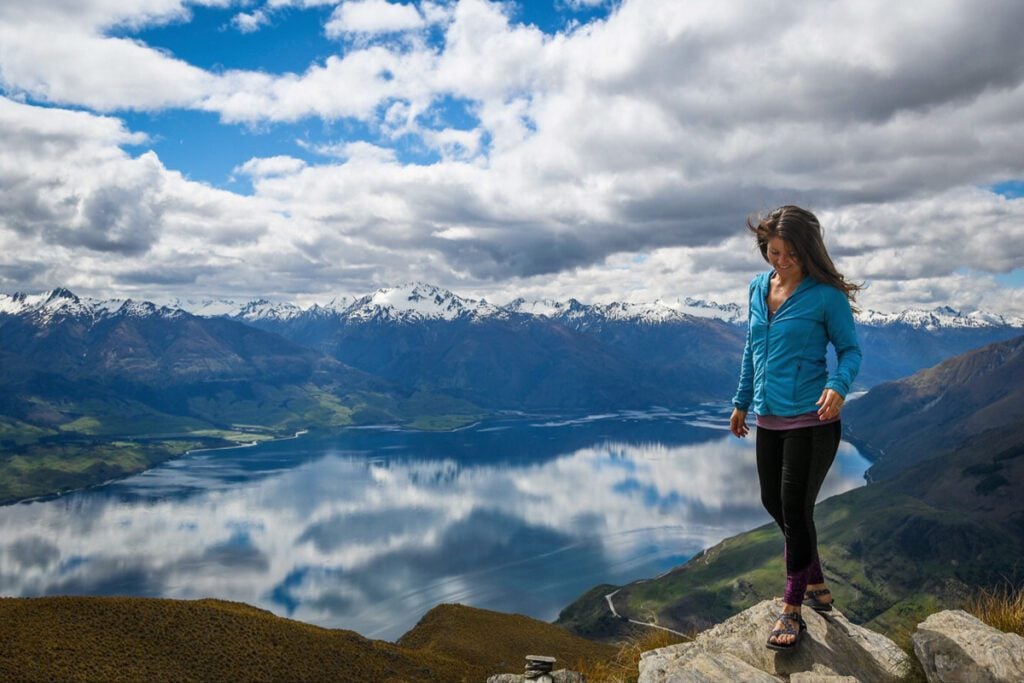
How to Plan the Perfect New Zealand Itinerary
With miles of jaw-dropping landscapes and experiences, it can be hard to decide how to plan for a trip to New Zealand. We're walking you through how to put together the perfect New Zealand itinerary based on our travels.
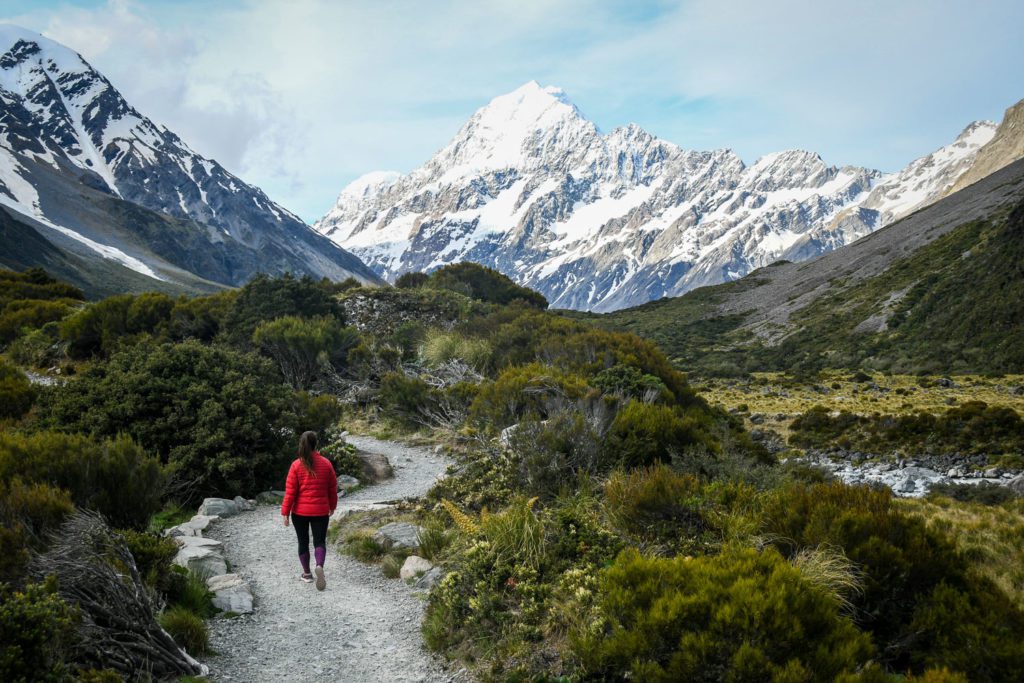
45 Exciting Things to Do in New Zealand on Your First Visit
Whether it is your first time visiting or you're a Kiwi looking to explore your own (amazing!) country, there are endless things to do in New Zealand. We’ve rounded up the top adrenaline rushes, foods to try, epic hikes and cultural experiences, so you can create your very own New...
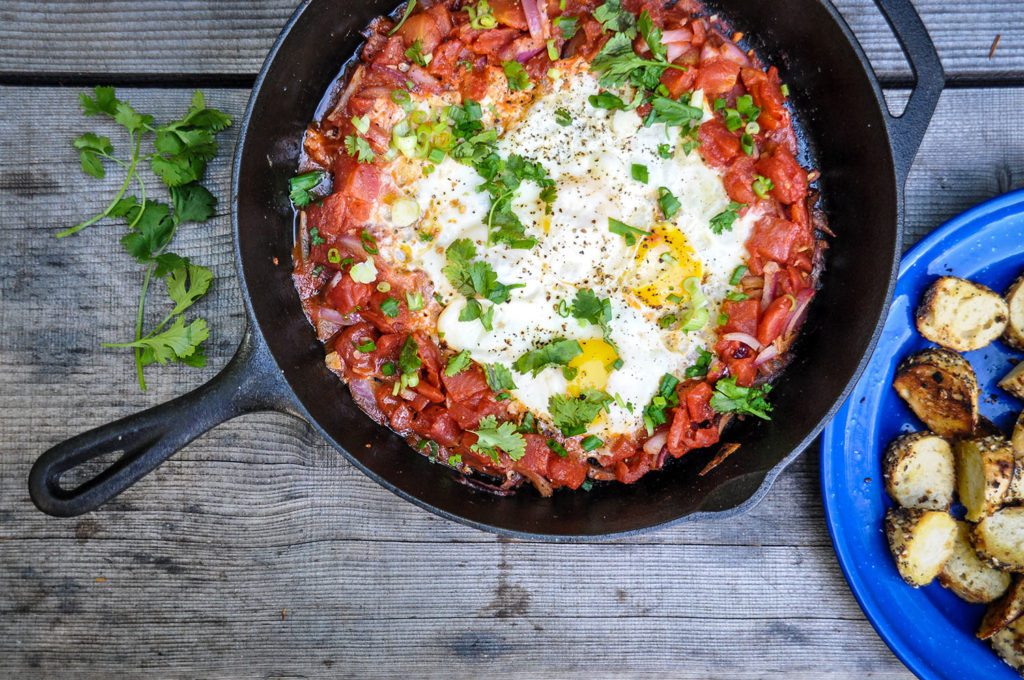
9 Easy Camping Meals (that are healthy & delicious!)
Cooking healthy and delicious meals while traveling in a campervan is easier than you think! We’ve rounded up our favorite healthy camping meals and are sharing the step-by-step recipes so you can see just how easy they are, even if you have a tiny kitchen to work with. Bonus: All...
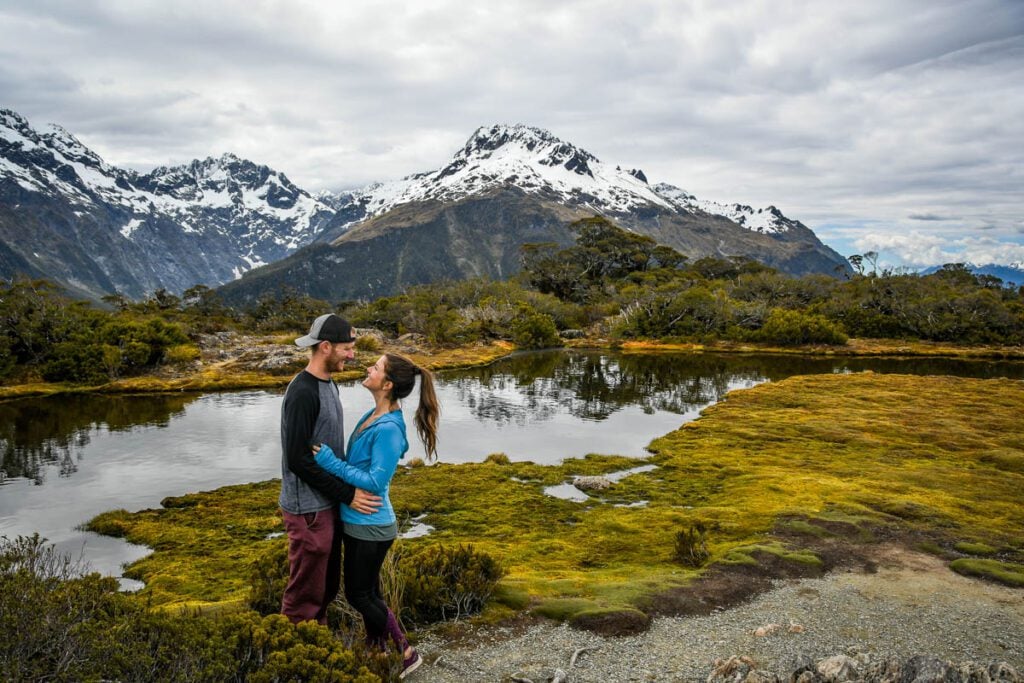
Queenstown to Milford Sound: Perfect Road Trip + Must-See Stops
A road trip from Queenstown to Milford Sound is one of the best ways to experience the rugged wilderness and stunning scenery of Fiordlands National Park in New Zealand. This guide will help you plan your route and choose the best stops to make along the way.
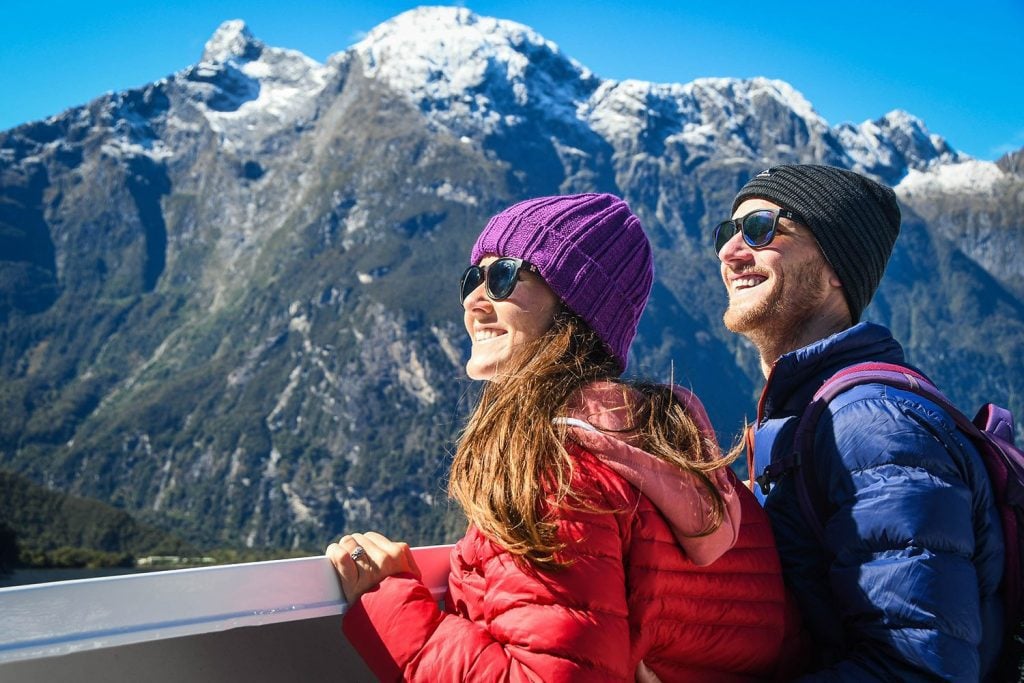
Best Milford Sound Cruise + Tips for Planning your Visit
Surrounded by the stunning scenery of Fiordland National Park, visiting Milford Sound in New Zealand is a must! Specifically, a Milford Sound cruise allows you to experience this incredible landscape in a unique way. Read on for what to expect and which cruises are best.
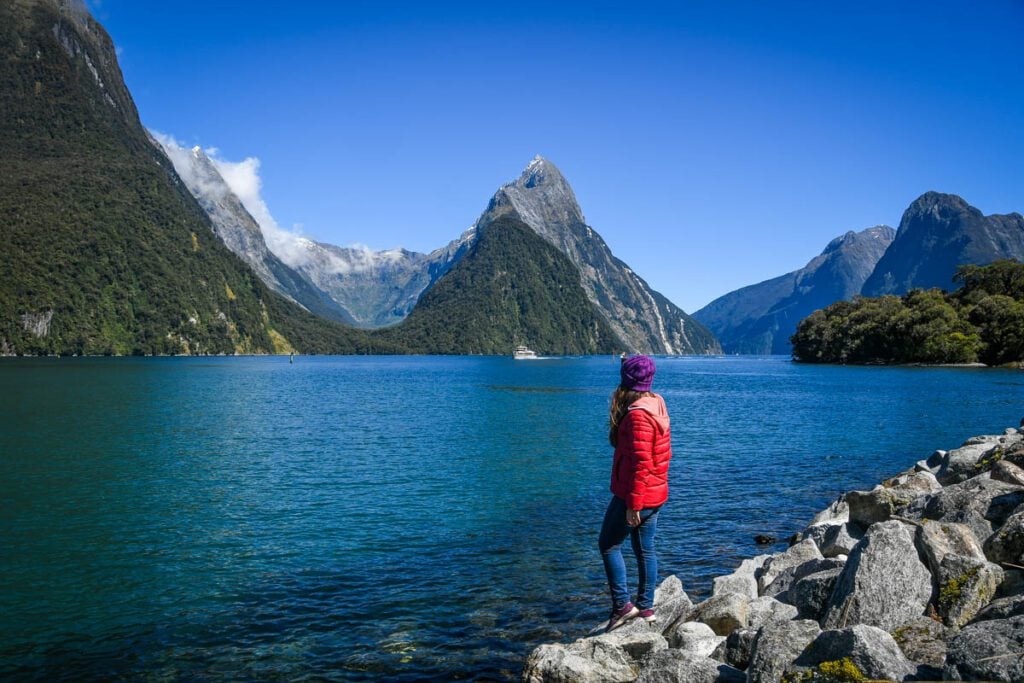
Milford Sound, New Zealand: Things to Do + Essential Tips
One of many highlights of the South Island, Milford Sound New Zealand is at the top of many bucket lists. We put together this ultimate guide with everything you’ll need to know when planning a visit including when to go, where to stay, things to do, and essential tips.
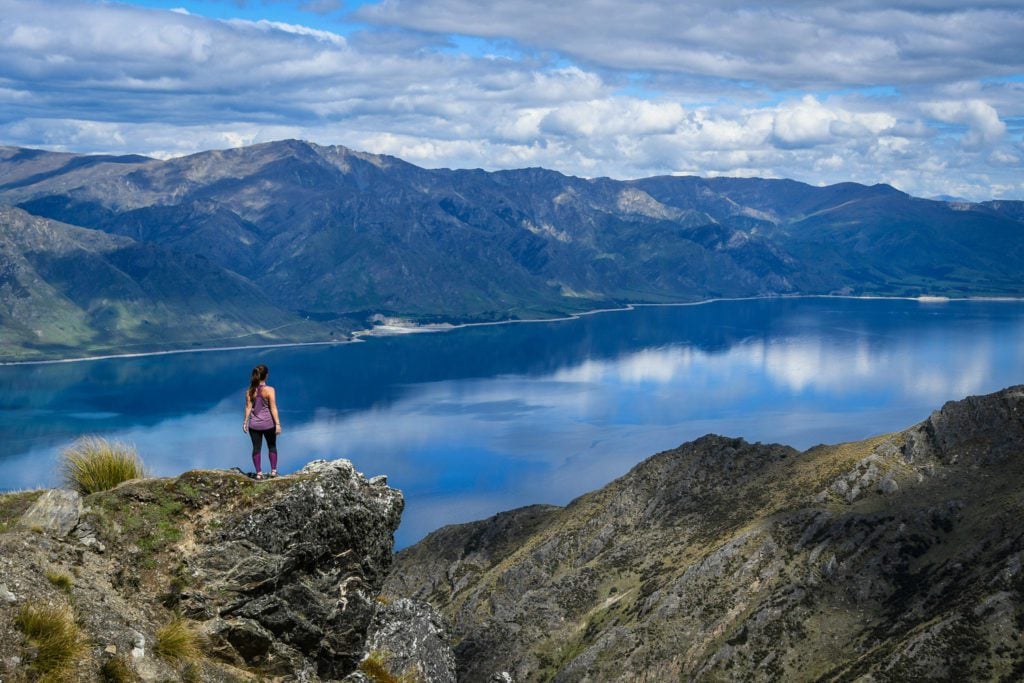
54 Things to Know Before Traveling in New Zealand
In this article we’re sharing some helpful New Zealand travel tips we wish we would have known before our trip. Plus, some fun facts about New Zealand that’ll give you a deeper understanding about its history, people and culture.
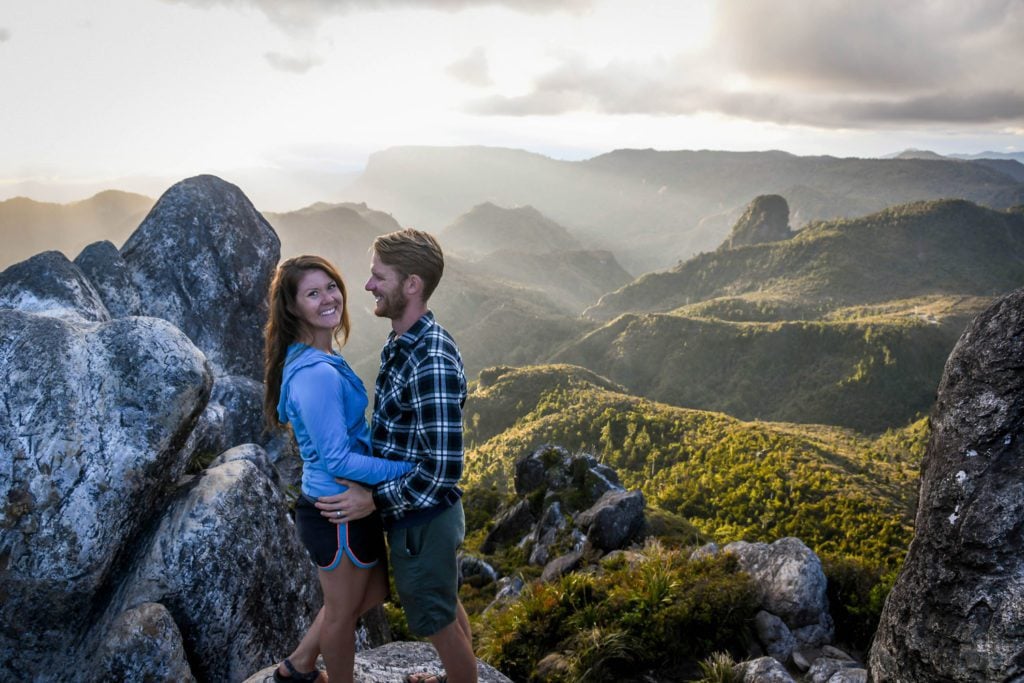
North Island New Zealand: 2-Week Itinerary
From Auckland to Wellington, and everything in between, we’ve created a perfect New Zealand North Island itinerary. Follow this route, and you’ll explore the biggest highlights, plus some off the beaten path adventures! This North Island New Zealand road trip covers everything you need to know!
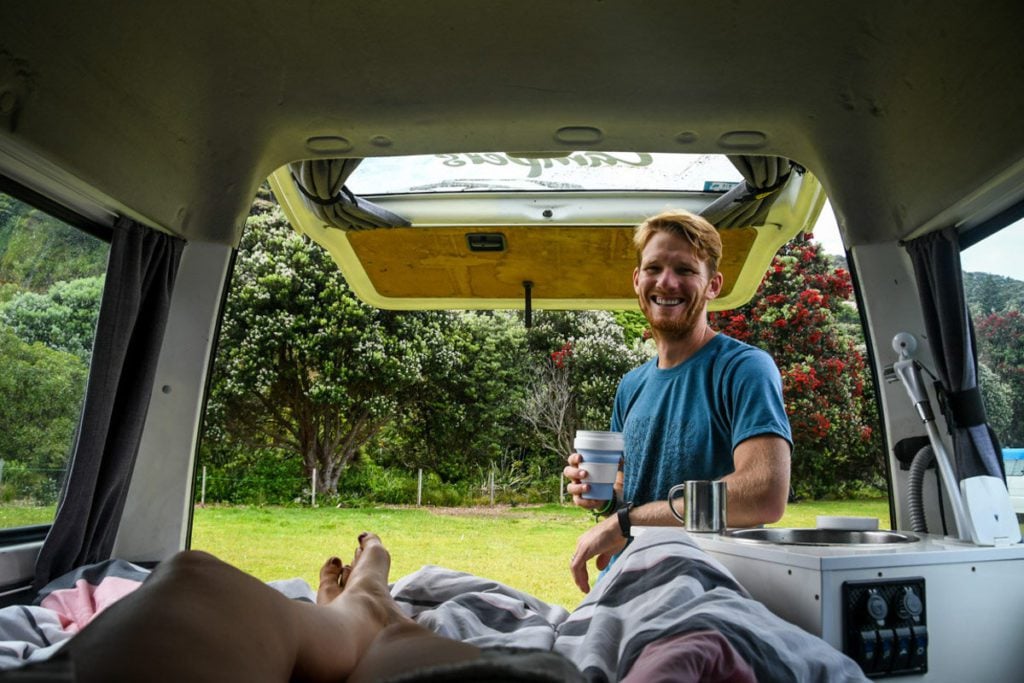
Best New Zealand Campsites: Ultimate Guide + Free Map
With so much jaw-dropping country to explore, a lot goes into planning a New Zealand camping trip. With the help of fellow travel bloggers, we rounded up the best New Zealand campsites, plus everything you need to know to plan an epic trip.
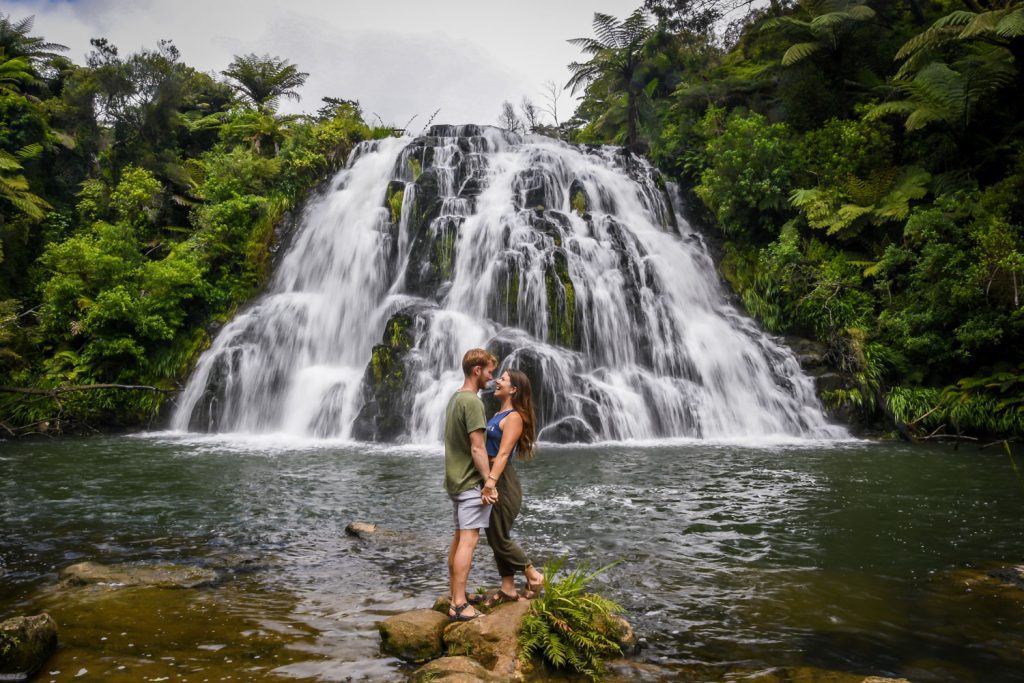
New Zealand Travel on a Budget: 19 Money-Saving Tips
Let’s be real: traveling in New Zealand is not cheap. But even though it’s notorious expensive, you can still travel to NZ on a budget. We’re breaking down common expenses like food, transportation, and accommodation, so you know exactly how much it costs to go to New Zealand. Plus we’re...
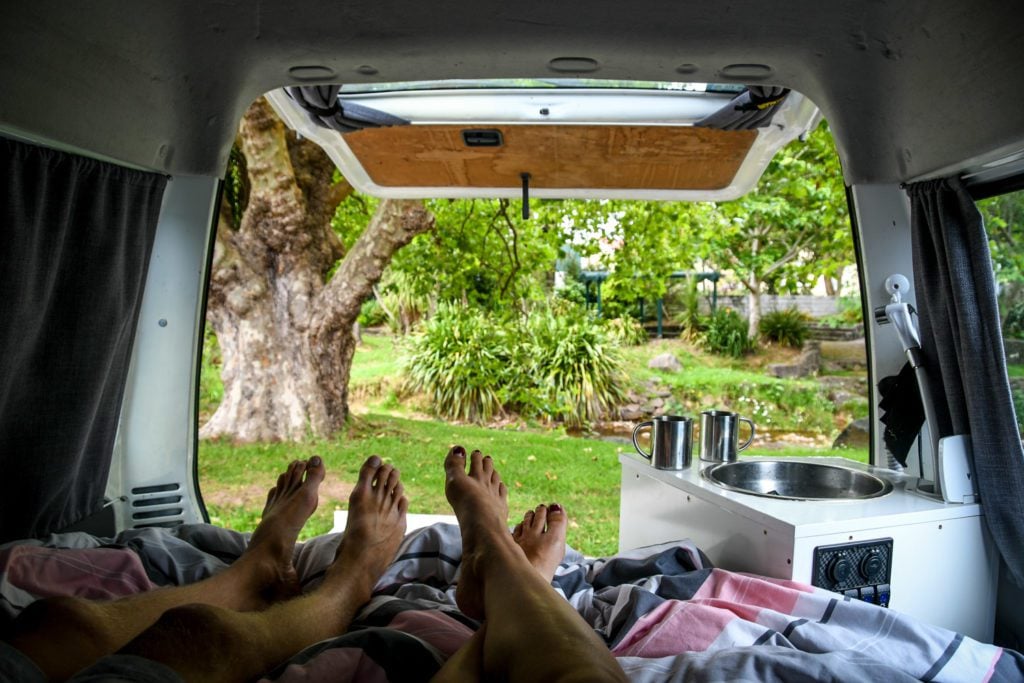
Best Campervan Rental in New Zealand: Ultimate Guide
There are so many campervan rentals in New Zealand, choosing one can feel overwhelming. We’re breaking down all the important things you need to look for to find the best campervan hire for your New Zealand road trip. We’re even sharing exactly which companies we recommend.
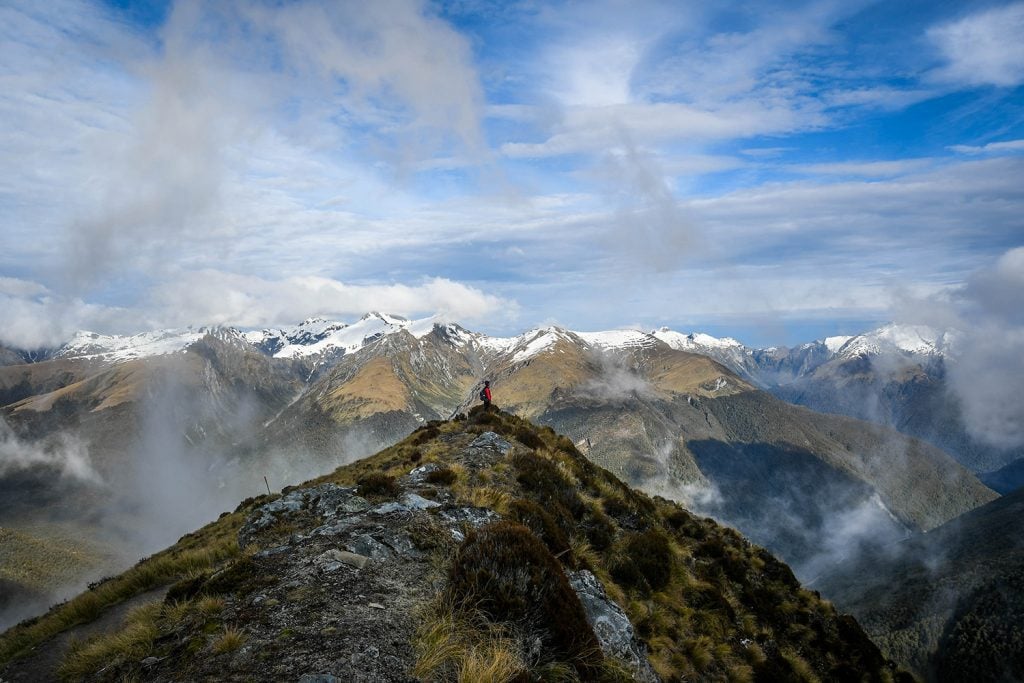
16 Wild Things To Do in West Coast New Zealand
New Zealand's West Coast is packed with adventure! From glaciers and snow snow capped mountains to rainforests and palm-lined beaches, there are so many things to do and see on the West Coast of New Zealand.
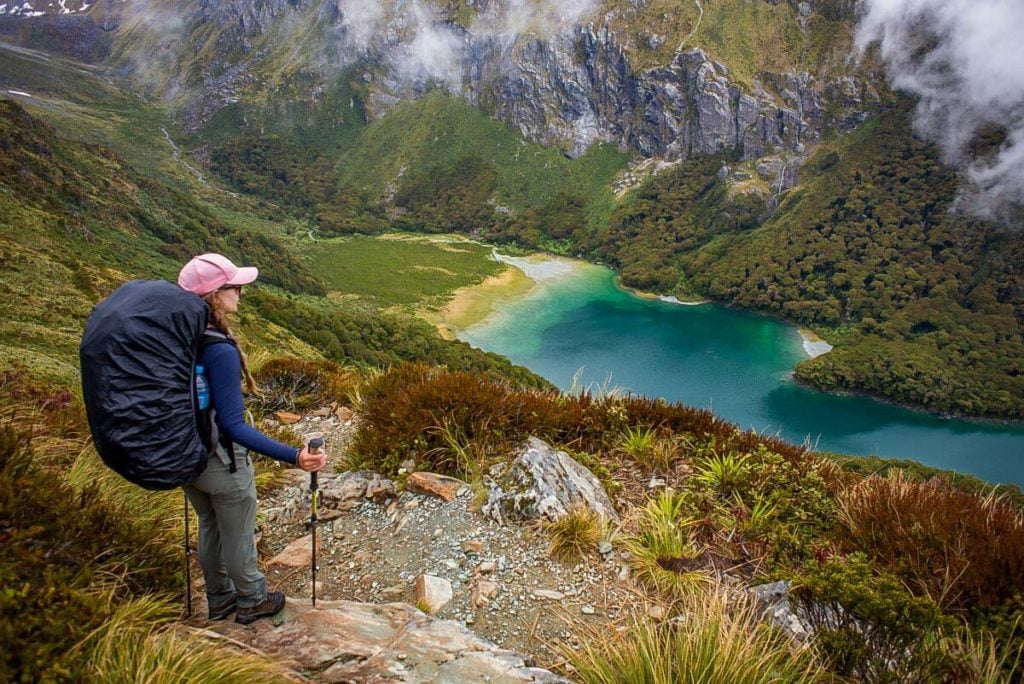
Routeburn Track: Hiking Guide + Local Tips
The Routeburn Track is one of the most diverse and beautiful hiking trails in New Zealand. As one of New Zealand’s Great Walks, it is important you are properly prepared before hitting the trail. In this article you’ll learn how to book your hike, important packing tips, and other essential...
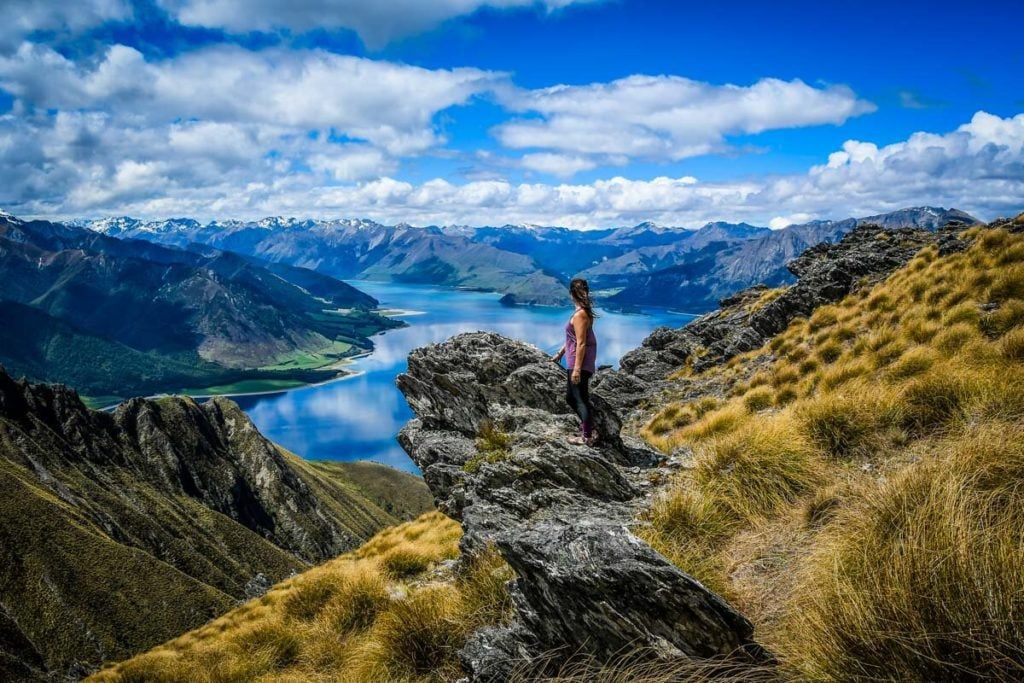
20 Incredible New Zealand Hikes + Local Tips
Hiking in New Zealand was one of the major highlights of our trip, and we think it will be one of your best memories, too. This article is packed with some of the most incredible New Zealand hikes, plus lots of tips and advice (from a local!) so you’ll be...
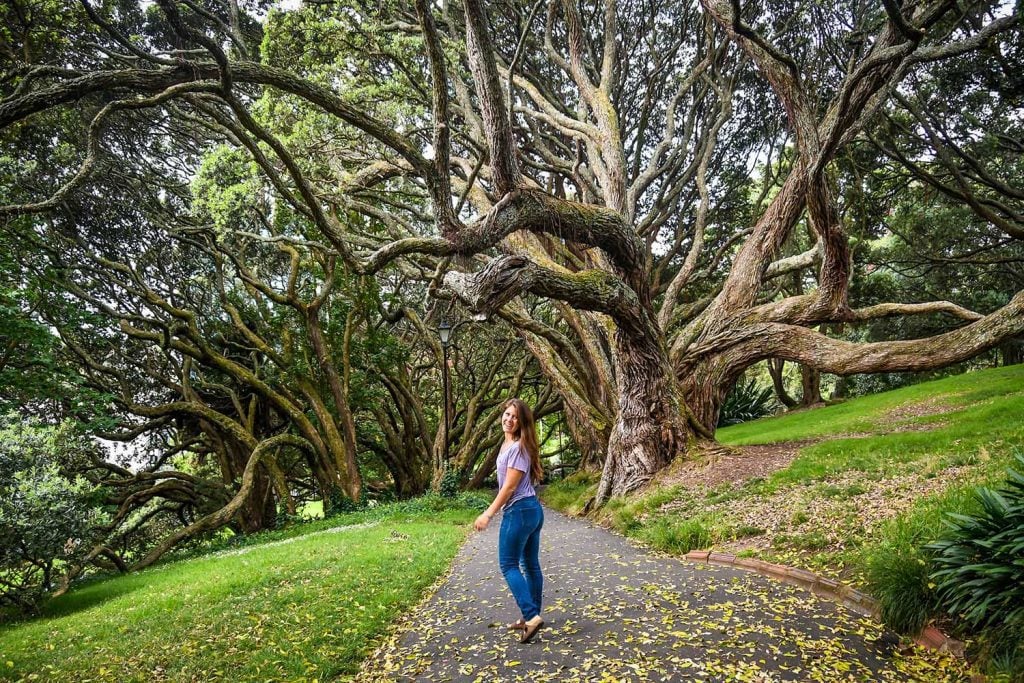
31 Fun Things to Do in Auckland, New Zealand
Seaside, multicultural, and full of greenspace, Auckland is a top destination on New Zealand’s North Island. We’ve rounded up all the fun things to do in Auckland, New Zealand, plus everything you need to know to help you plan an unforgettable trip!
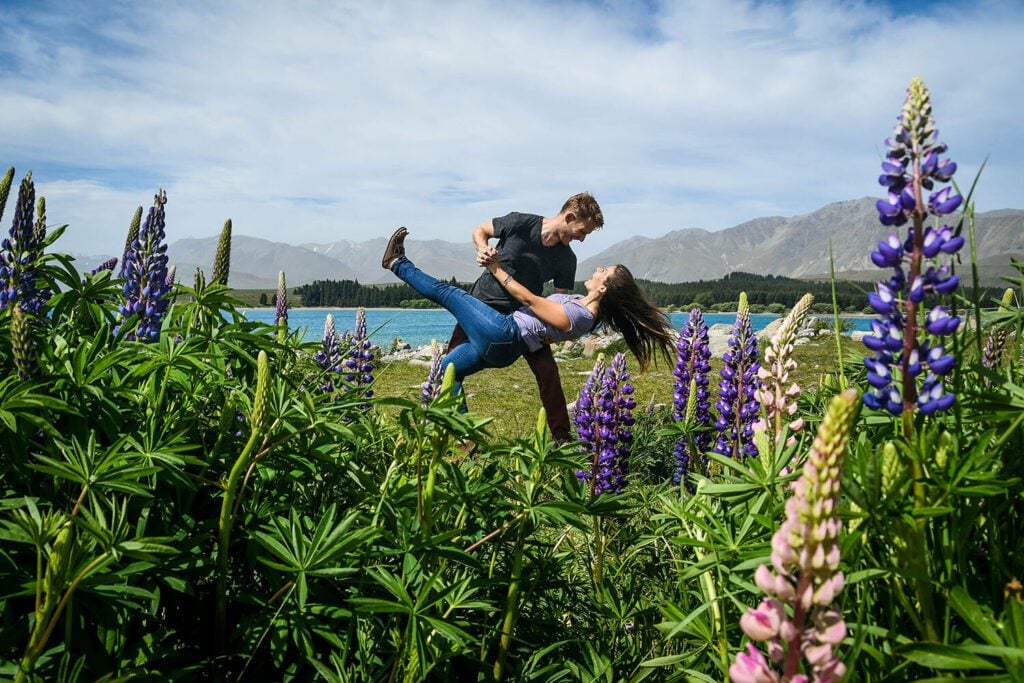
Best Time to Visit New Zealand: When to Go & When to Avoid!
Trying to figure out the best time to visit New Zealand can be a bit overwhelming. We’re going over the pros and cons of all four seasons in New Zealand to help you decide which is the best time of year to visit for your specific travel style.
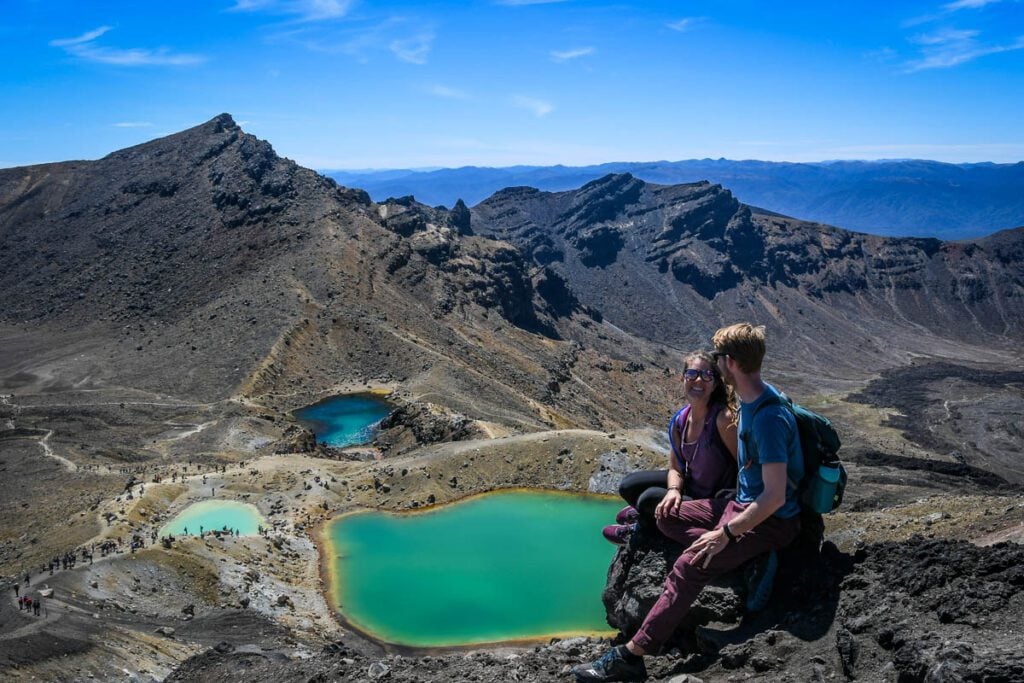
Tongariro Crossing: Guide to New Zealand’s Best Day Hike
Vivid crater lakes, dramatic valleys, and snow-capped peaks await you along the Tongariro Alpine Crossing. Known as the “World’s Greatest Day Hike”, this trail was a highlight during our trip to New Zealand, and this guide will cover everything you need to do it!
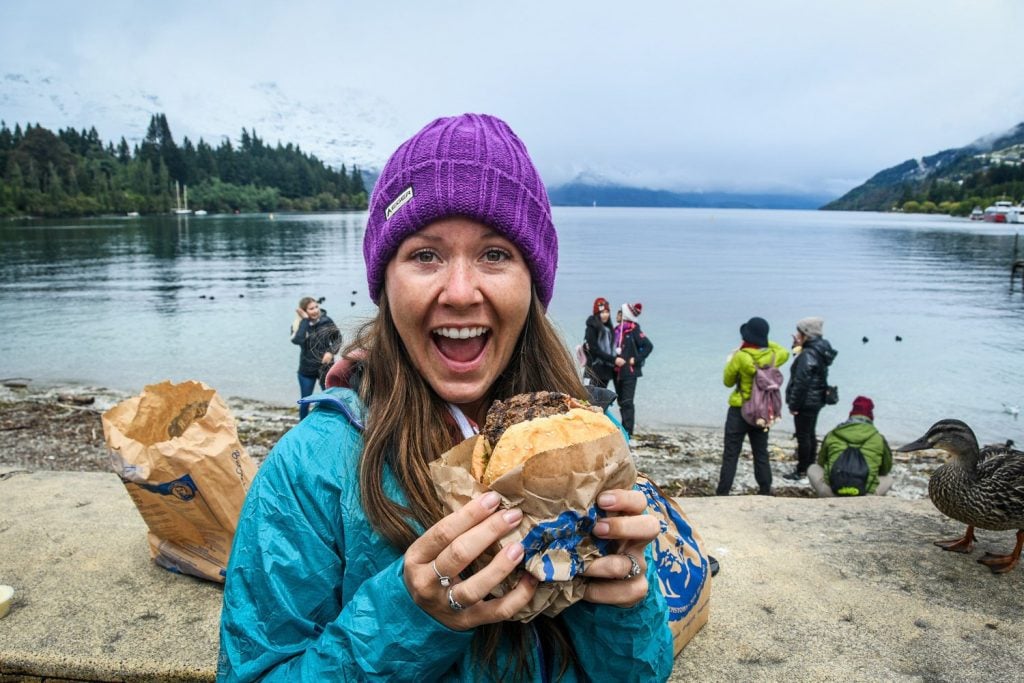
22 Best New Zealand Foods to Try (& what to skip!)
Pulling from both British and South Pacific influences, New Zealand cuisine is interesting and relies heavily on locally-sourced ingredients. From Hāngi, which is a type of cooking integral to the indigenous Māori people, to the country's famed seafood, we’ve rounded up the best New Zealand foods to try (and skip!).
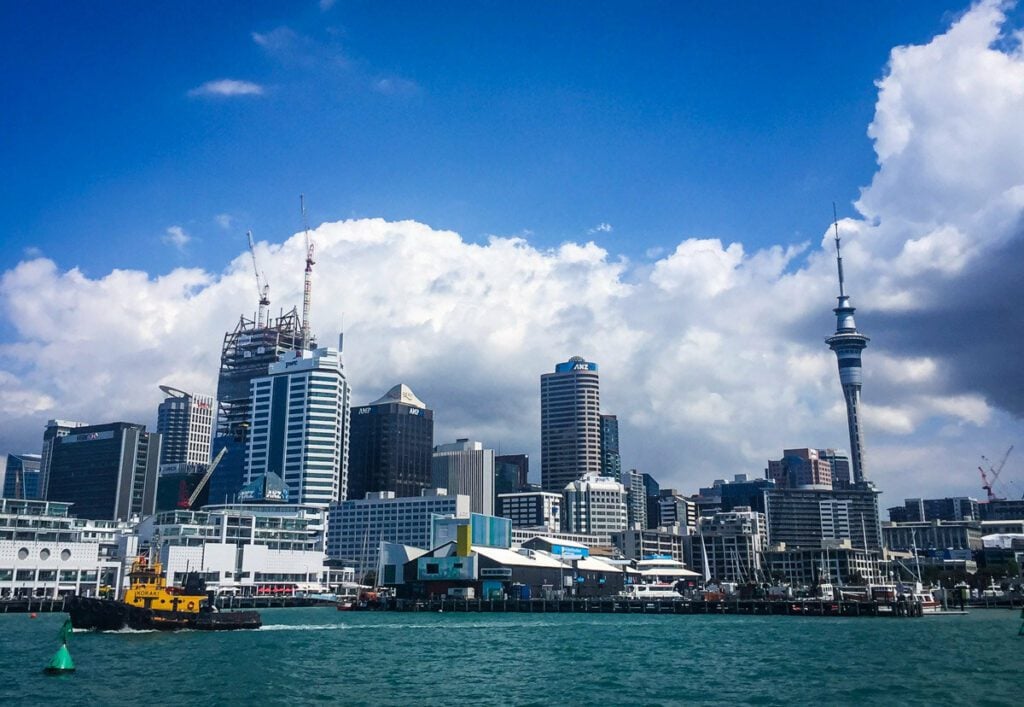
20 Coolest Airbnbs in Auckland, New Zealand
From rural retreats nestled in the jungle and sunny beach cottages to apartments in the bustling city center, there’s an impressive selection of unique Airbnbs in Auckland for every type of traveler. We gathered up the most noteworthy to help you plan your stay!
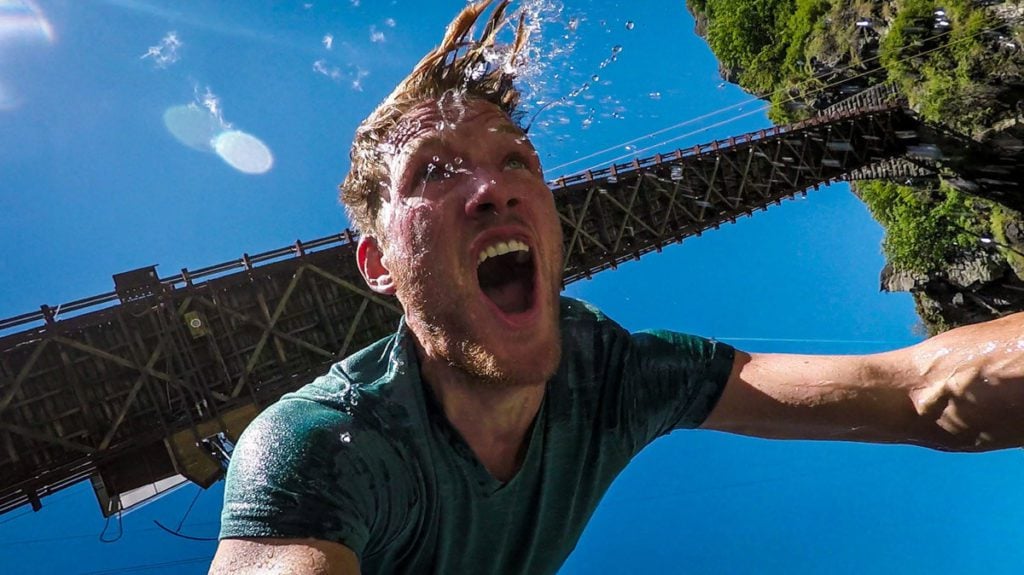
35 Adventurous Things to Do in Queenstown, New Zealand
Queenstown is often referred to as the “adventure capital of New Zealand,” and for good reason! There are so many fun things to do in Queenstown — from adrenaline-pumping activities to low-key excursions for all ages. This article is packed with activities, tips and things to know to plan an...
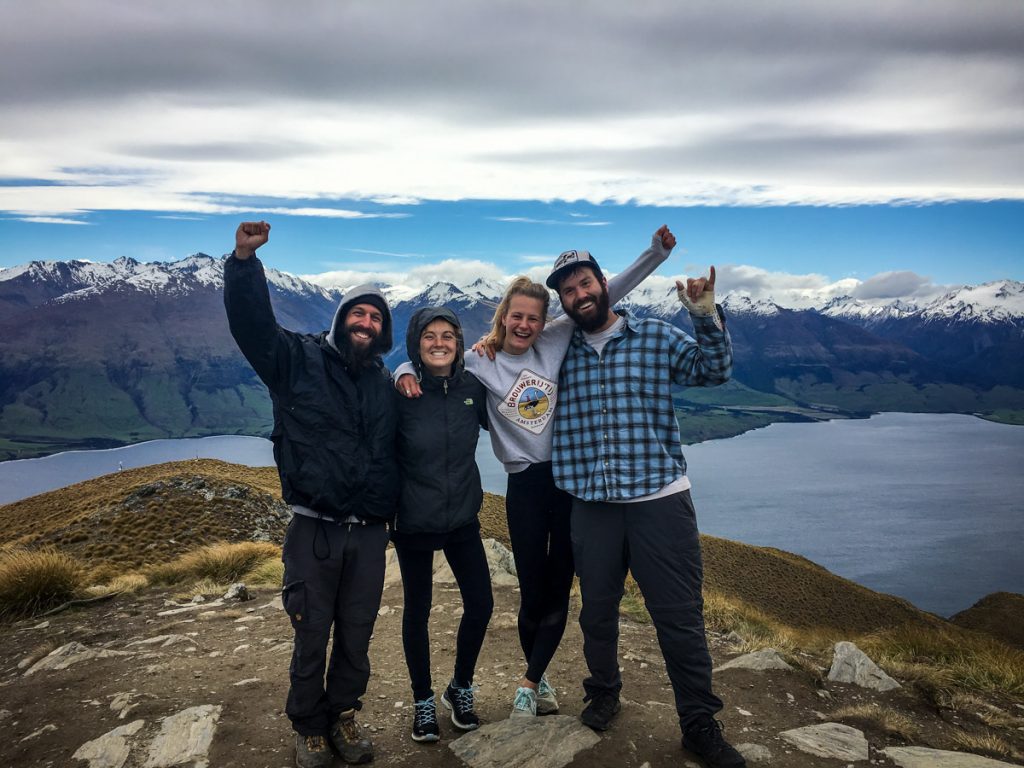
New Zealand Working Holiday Visa: Everything You Need to Know!
Considering doing a Working Holiday Visa in New Zealand? This article will answer all your questions about life in NZ, cost of living, how to find housing, and advice from someone who has been there before. This guide also walks you through the necessary steps to apply for a New...
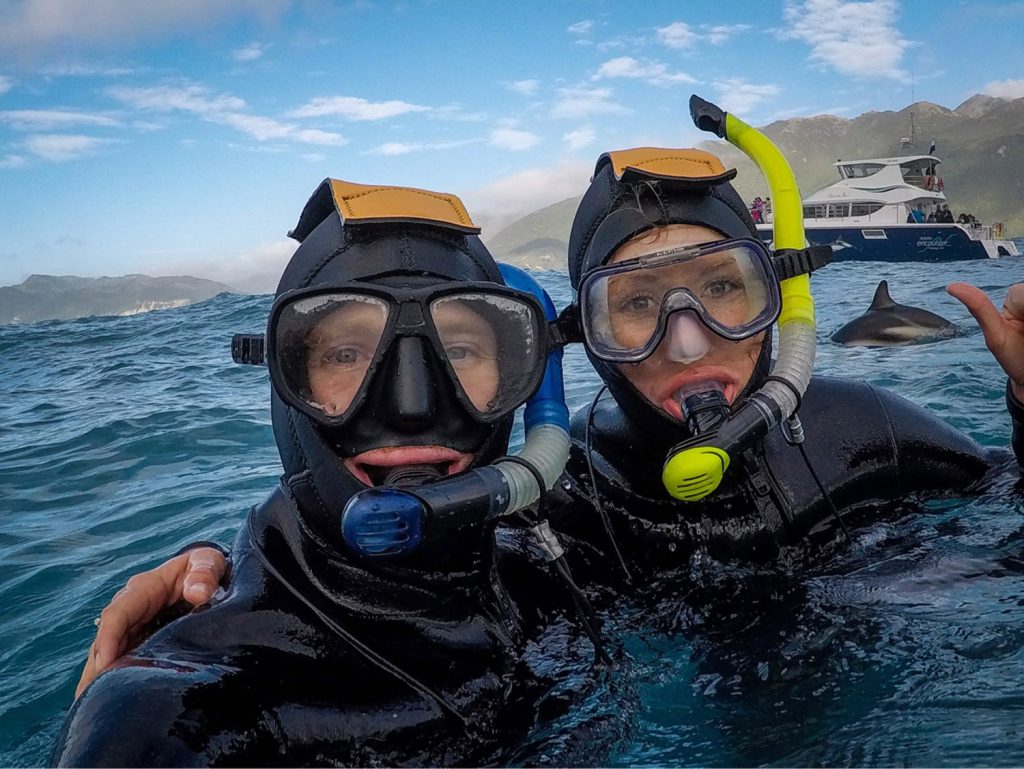
Swimming with Dolphins in New Zealand: Kaikoura Dolphin Encounter
While traveling in New Zealand, we were happy to find Dolphin Encounter Kaikoura, which is a company that gives guests the opportunity to swim with these wild animals ethically and responsibly, making it one of the best places to swim with dolphins in the world.
Save this guide on Pinterest for later!
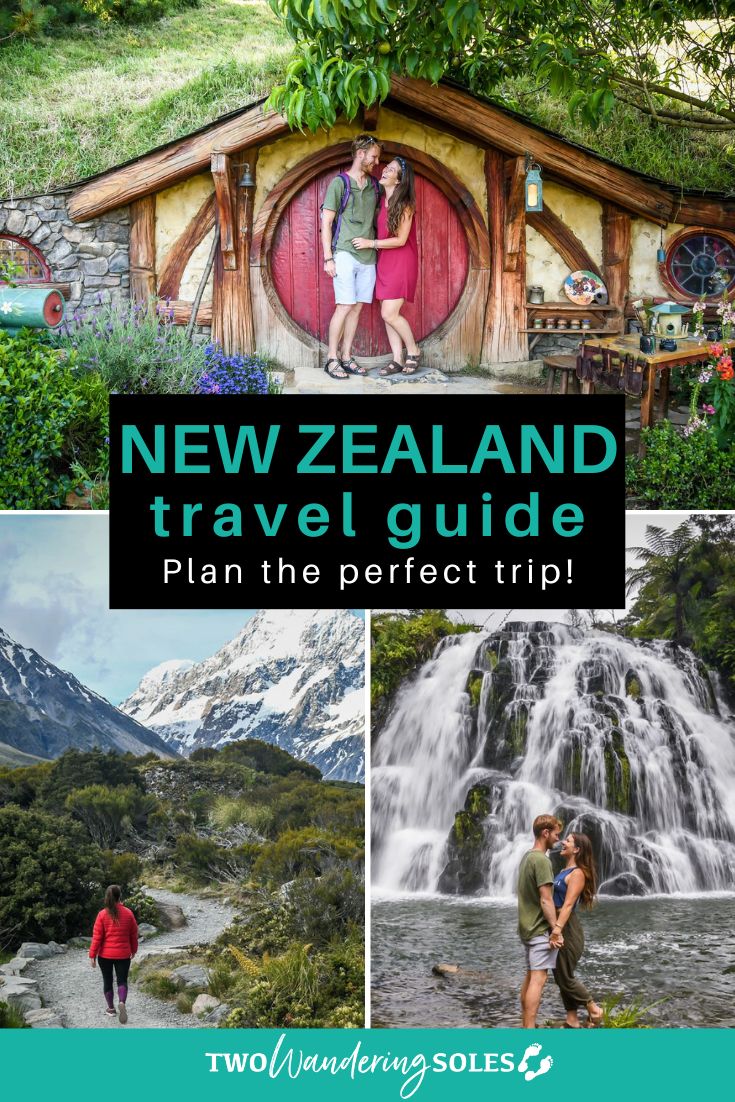

IMAGES
VIDEO
COMMENTS
Welcome to New Zealand. Get official travel information, maps, itineraries, best time to travel & things to do to help you plan your next holiday to New Zealand. ... Guide to travelling to NZ Covid-19: Guide for travellers ...
New Zealand Tourism Guide is a comprehensive online directory for NZ tourism and travel. We're proud to be the home to listings for accommodation, attractions, tours and transport businesses (over 12,000) together with extensive visitor holiday and vacation information for people travelling this beautiful country. If you're looking or where to ...
Climate: New Zealand has a diverse climate determined by the ocean, mountains and prevailing winds. The mean average temperatures are 10°C (50°F) on the South Island to 16°C (61°F) on the North Island. See The Guide to The New Zealand Climate or check out the " When to Visit " section below. Population : 5 million.
South Island. Waikato & the Coromandel Peninsula. Christchurch & Canterbury. Marlborough & Nelson. Bay of Islands & Northland. The West Coast. Queenstown & Wanaka. Explore New Zealand holidays and discover the best time and places to visit.
1. Queenstown. Best for adventure activities. New Zealand's adventure capital is a favorite with visitors and for good reason. On the shores of Lake Wakatipu and surrounded by snow-capped mountains, Queenstown 's location makes it one of the country's most sought-after places to work and play.
What To Expect. Language: New Zealand has three official languages: English, Maori, and New Zealand Sign Language.. Currency: The currency in New Zealand is called the New Zealand Dollar. 1 USD is equivalent to about 1,46 New Zealand Dollars.. Credit Cards and ATMs: You won't have a problem using your credit or debit card in New Zealand.As long as it's a Visa, MasterCard, or Maestro you ...
Northland Travel Guide. Poverty Bay, Hawke's Bay and the Wairarapa Travel Guide. Wellington and around Travel Guide. The West Coast Travel Guide. Western North Island Travel Guide. Auckland and around Travel Guide. Christchurch and south to Otago Travel Guide. Auckland. Famous movie locations in New Zealand.
Plan your holiday to New Zealand on this fast and free travel guide with just a click or tap away in your browser. We have over 2,000 articles to help inspire, plan and get on-the-ground advice for every nook and cranny of Aotearoa, written by real travel writers; not some dodgy algorithm.
Budgeting Accommodation. Budget: New Zealand has a variety of hostels for about 15.5-30 New Zealand dollars per night.These hostels come with dorms, free Wi-Fi, shared kitchens, lounge areas, and great central locations. Mid-Range: Mid-range hotels will cost around 86-150 New Zealand dollars per night.Amenities include private rooms with coffee makers and flat-screen TVs, a hotel restaurant ...
Here are the basics about travel to New Zealand. ELECTRICITY: 230/240 volt with 2 or 3 pins, the same as Australia and parts of Asia. (Be sure to get your universal travel adapter before you leave) ENTRY / VISA: Australians can enter and stay visa free. UK citizens can enter for free with a 6-month stay.
New Zealand Travel Guide-8401870 This Country Is Made Up of 2 Stunning Islands Full of Pristine Beaches and Otherworldly Landscapes This New Zealand Town Is an All-season Destination With Epic ...
New Zealand Travel Guide. Last Updated: April 1, 2024. New Zealand's name inspires pictures of mountains, glaciers, forests, pristine lands, and lots and lots of sheep. And the country is the adventure capital of the world. Hiking, skydiving, caving, bungy jumping, skiing — everything here is geared towards getting you outside and doing ...
Rental prices in New Zealand are typically around $50 a day. Caravan rental options tailoring to budget travelers can even be cheaper than cars at as low as $40 / day. Jucy is quite popular (and easily recognizable with its bright green vehicles), though many other companies exist.
For many travellers visiting New Zealand, it all starts in Auckland. New Zealand's largest city covers a vast area well beyond its famous city skyline defined with the Southern Hemisphere's tallest building, the Sky Tower. The region encompasses around 26 regional parks with lush forest, rolling farmland and sandy beaches.
For a more detailed breakdown, see our New Zealand travel guide. Where to stay around New Zealand. New Zealand is a developed country with lots of accommodation options. As with any destination, lodging will be more plentiful (but generally more expensive) in the city centers, and prices will be higher during peak tourist season (December to ...
Welcome to New Zealand. Get official travel information, maps, itineraries, activities & accommodation to help you plan your next holiday to New Zealand.
Visitors from visa waiver countries do need to obtain a NZeTA (New Zealand Electronic Travel Authority) before traveling to New Zealand, though. You can request an NZeTA online on the New Zealand Immigration website or via the NZeTA app ; the application costs NZD $12 ($8.34 USD) if you apply online or NZD $9 ($6.26 USD) if you apply on the app.
Currency - New Zealand Dollars (NZD) . $1 NZD = $0.67 USD = $0.92 CAD; ATMs can be found all over and the credit cards are widely accepted; SIM card - The two main companies in New Zealand are Spark and Vodafone.Both are essentially identical but with Vodafone, you can pick up SIM card packages for tourists at the airport tax-free.
Milford Sound is New Zealand's number one tourist attraction and is an awe-inspiring sight. Take a boat trip or, better still, a kayak, and cruise the beautiful black waters of Milford Sound, admiring the sheer vertical cliff faces and waterfalls lining its edges. Doubtful Sound is another very popular option.
It has white snow capped mountains, creaking glaciers, silent lakes, thunderous waves, black sandy beaches and smoking volcanoes - almost everything that makes a picturesque paradise. Currency in New Zealand: New Zealand Dollar | 2022 Conversion Rate: 1 NZD = $0.58 USD.